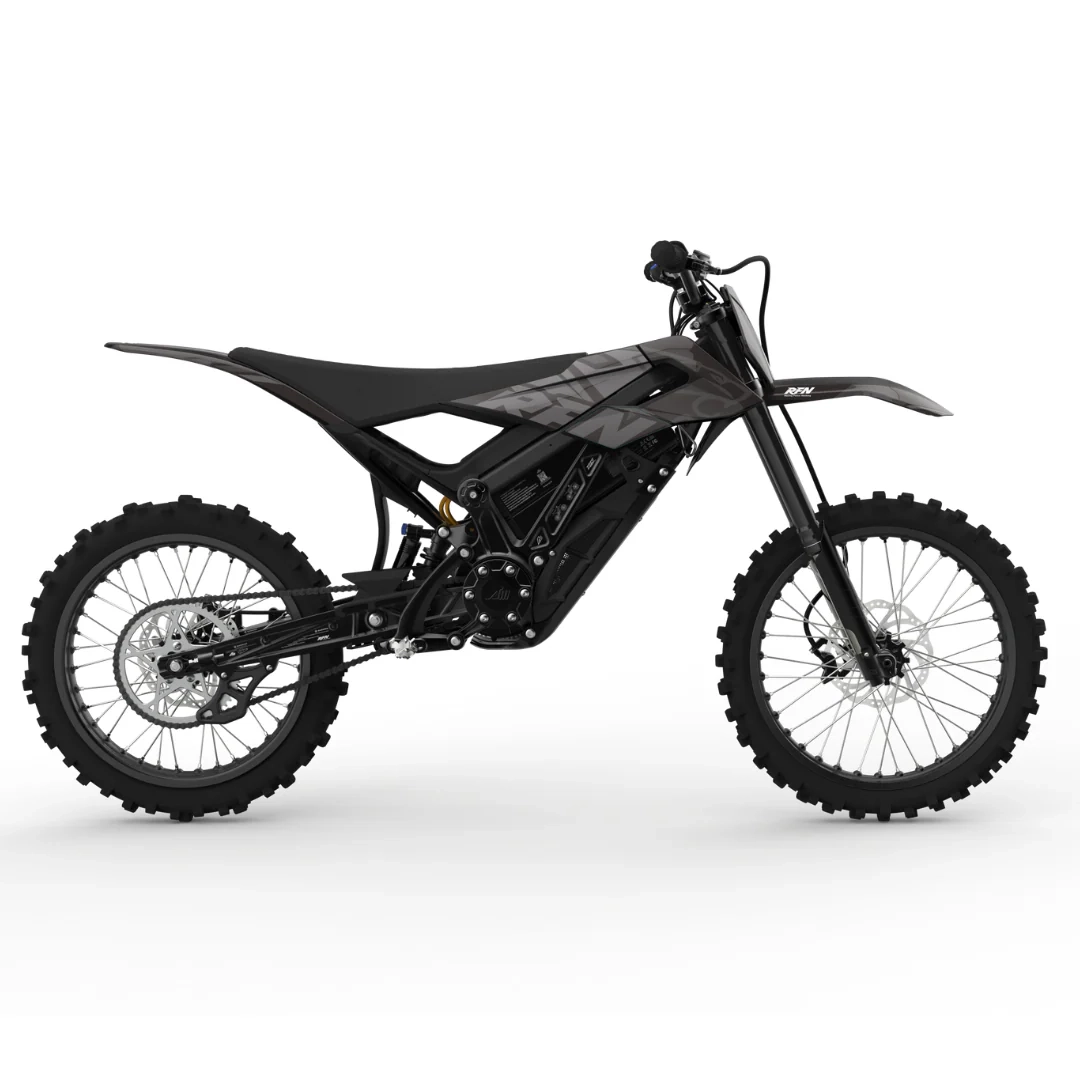eBikeRadar
eBikeRadar
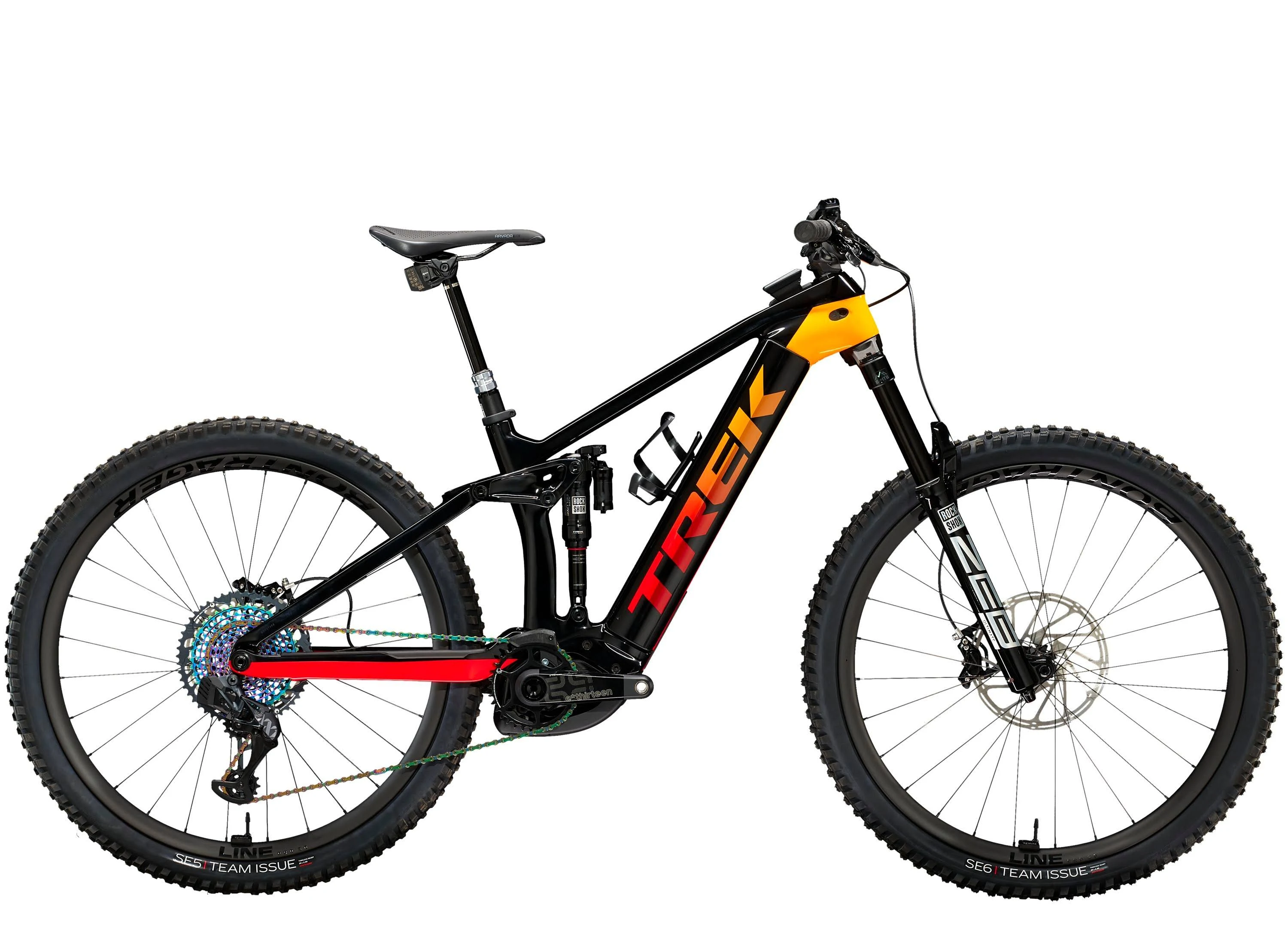
Ever tried biking up a steep hill and felt like your legs might give out? That’s where the right electric bike makes all the difference. Whether you're cruising through rolling countryside or facing daily uphill commutes, choosing the best e-bike for hilly terrain is key to a smoother, stronger ride.
Hilly areas put your bike—and your stamina—to the test. Think long, steep grades, sudden elevation changes, and battery-draining climbs. Not all e-bikes are built to handle that kind of pressure, which is why it's crucial to look for models designed specifically to conquer hills.
So, what makes an e-bike hill-worthy? It comes down to three big factors:
- High torque: This is the power that helps you climb without stalling. Look for motors rated at 70Nm or more.
- Mid-drive motors: Unlike hub motors, these are mounted in the center and work with your gears—ideal for inclines.
- Large battery capacity: Climbing takes more energy, so you'll want a battery that can go the distance (think 500Wh and up).
Pro Tip: More torque doesn’t always mean a faster bike—it means a stronger one, especially when heading uphill.
In this guide, you’ll learn exactly what to look for in an e-bike built for elevation, plus our top picks across different categories and budgets. Whether you’re a commuter, mountain adventurer, or weekend explorer, we’ll help you find the perfect match.
Ready to level up your ride? Let’s climb.
Key Features to Look for in a Hill-Climbing E-Bike
Conquering steep terrain isn’t just about brute force—it’s about choosing the right combination of power, battery life, and build. If you want to ride smarter (not harder), these are the essential features to keep in mind when shopping for the best e-bike for hills.
2.1. High Torque Output = More Climbing Power
Torque is what helps your e-bike push uphill without stalling or straining. It’s measured in Newton-meters (Nm), and higher numbers mean more hill-climbing muscle.
- Look for motors rated at 70Nm or higher for steep or sustained climbs.
- Bosch Performance Line CX: Up to 85Nm—excellent for mountain terrain.
- Shimano EP8: Delivers a smooth 85Nm with a natural feel.
- Bafang M600: Offers 120Nm for serious punch (great for off-roaders).
Pro Tip: If your daily ride includes steep grades, torque is more important than top speed.
2.2. Mid-Drive vs. Hub Motor: Know the Difference
Your e-bike’s motor placement plays a huge role in climbing ability.
- Mid-drive motors sit in the center and power the crank directly. This design allows the motor to work with your bike’s gears, giving you better performance on hills.
- Hub motors, found in the wheel, are cheaper but less efficient on inclines.
Why mid-drive is better for hills:
- Better torque transfer through your gear system
- Balanced weight improves traction and control
- More natural ride feel
Quick Comparison:
| Feature | Mid-Drive Motor | Hub Motor |
|---|---|---|
| Hill Climbing Power | ⭐⭐⭐⭐⭐ | ⭐⭐ |
| Price | $$$ | $ |
| Weight Distribution | Centered & Balanced | Rear-heavy |
2.3. Long-Lasting Battery Life for Steep Rides
Hills eat up battery faster than flat roads. That’s why battery capacity is key.
- Look for 500Wh or more if you’re riding in consistently hilly areas.
- Steep climbs can cut your range by 30–50%, especially in higher assist levels.
- Pairing the battery with an efficient motor (like Bosch or Shimano) can stretch your range.
Estimated Range:
- Flat Terrain: ~50–70 miles on a 500Wh battery
- Hilly Terrain: ~25–40 miles (depending on assist level and rider weight)
Pro Tip: Avoid letting your battery dip below 20% on big rides—it can stress the system and cut performance.
2.4. Gear Range and Drivetrain Quality Matter
Think of your drivetrain as your e-bike’s transmission. When you're climbing, a wide gear range helps your legs and motor work together efficiently.
- Choose bikes with 10–12 speed cassettes for maximum versatility.
- Brands like Shimano Deore, SRAM Eagle, or MicroSHIFT Advent X offer reliable performance for hill-heavy routes.
Key Benefits:
- Easier pedaling on steep inclines
- Better energy efficiency for both rider and battery
- Smoother gear shifts under load
2.5. Suspension & Braking for Confident Downhills
What goes up must come down—sometimes fast. That’s where good suspension and brakes come in.
- Front suspension (hardtail) is great for moderate trails and city hills.
- Full suspension (dual) is better for rugged off-road descents and comfort on bumpy terrain.
- Hydraulic disc brakes give you strong, consistent stopping power in all weather.
Look for:
- At least 100mm travel in front suspension
- Shimano or Tektro hydraulic brakes with large rotors (180mm+)
From high-torque motors to efficient drivetrains, every part of your e-bike should work in sync to power you uphill and keep you safe on the way down. Up next, we’ll break down the best electric bikes for hilly terrain by type and budget—so you can find your perfect match without the guesswork.
Ready to find your hill-climbing hero? Keep reading.
Best E-Bikes for Hilly Terrain (By Category)
From high-powered mountain beasts to budget-friendly commuters, the best e-bikes for hilly terrain come in all shapes and sizes. Below, you’ll find top picks across categories—each one tested and recommended for steep climbs, extended range, and total ride confidence.
3.1. Best Overall Climbing E-Bike
Trek Rail 9.9 XX1 AXS Gen 3
This full-suspension e-MTB blends premium trail performance with elite hill-climbing ability. With Bosch’s Performance Line CX motor, it delivers a smooth yet powerful climb, ideal for technical ascents and endurance rides.
| Feature | Details |
|---|---|
| Motor | Bosch Performance Line CX (mid-drive) |
| Torque | 85Nm |
| Battery | Bosch PowerTube 750Wh |
| Top Features | 160mm RockShox suspension, SRAM wireless shifting, super-adjustable frame |
| Price Range | $13,499 |
| Best For | Riders seeking all-day mountain power and top-tier parts |
Why it wins: It’s an all-around monster—refined, responsive, and built for elevation.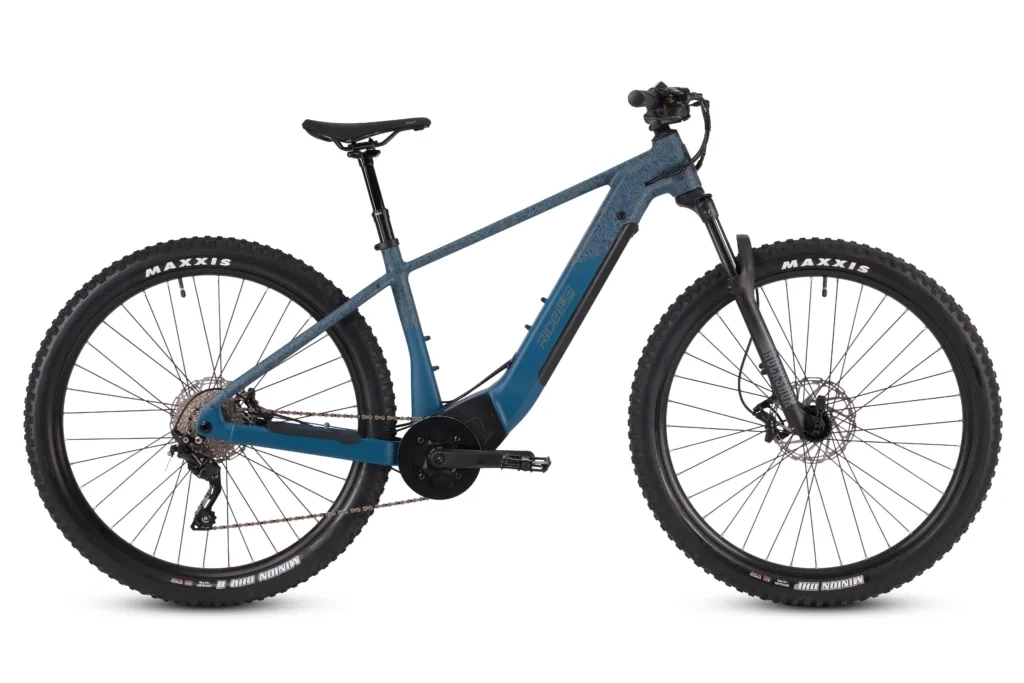
3.2. Best Mid-Drive E-Bike for Steep Hills
Rize RX Pro
For those who want sheer torque dominance, the Rize RX Pro hits hard. This beast sports a 160Nm Bafang mid-drive, making it one of the most powerful e-bikes on the market.
| Feature | Details |
|---|---|
| Motor | Bafang M620 mid-drive (1000W) |
| Torque | 160Nm |
| Battery | 52V 15Ah or 20Ah options |
| Top Features | Fat tires, advanced torque sensor, 9-speed drivetrain |
| Price Range | $2,799–$3,399 |
| Best For | Steepest hills, off-road power, heavy-duty hauling |
Pro Tip: This bike borders on Class 3/4 specs—check your local e-bike laws before ripping through city limits.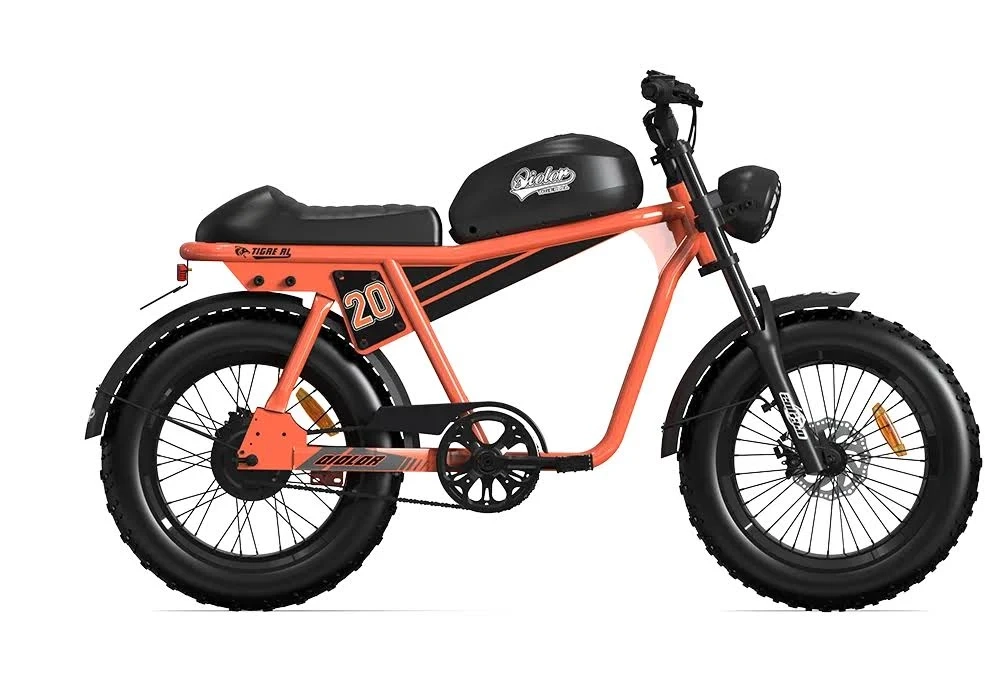
3.3. Best Budget E-Bike for Hilly Areas
Qiolor Tiger RL
Don't be fooled by the price—this retro-style e-bike has real hill-climbing chops, with 85Nm of torque and a smooth power band for urban inclines.
| Feature | Details |
|---|---|
| Motor | Rear hub motor (750W, 1100W peak) |
| Torque | 85Nm |
| Battery | 48V 13Ah (upgradeable) |
| Top Features | Fat tires, hydraulic brakes, smart lock, 60-mile range |
| Price Range | $1,399 |
| Best For | Budget riders, city hills, stylish commutes |
Other Strong Budget Picks:
- Aventon Aventure.2 – Torque sensor, 750W hub motor, fat tires (~$1,799)
- Ride1Up Vorsa – Compact, efficient hill climber with 720Wh battery (~$1,395)
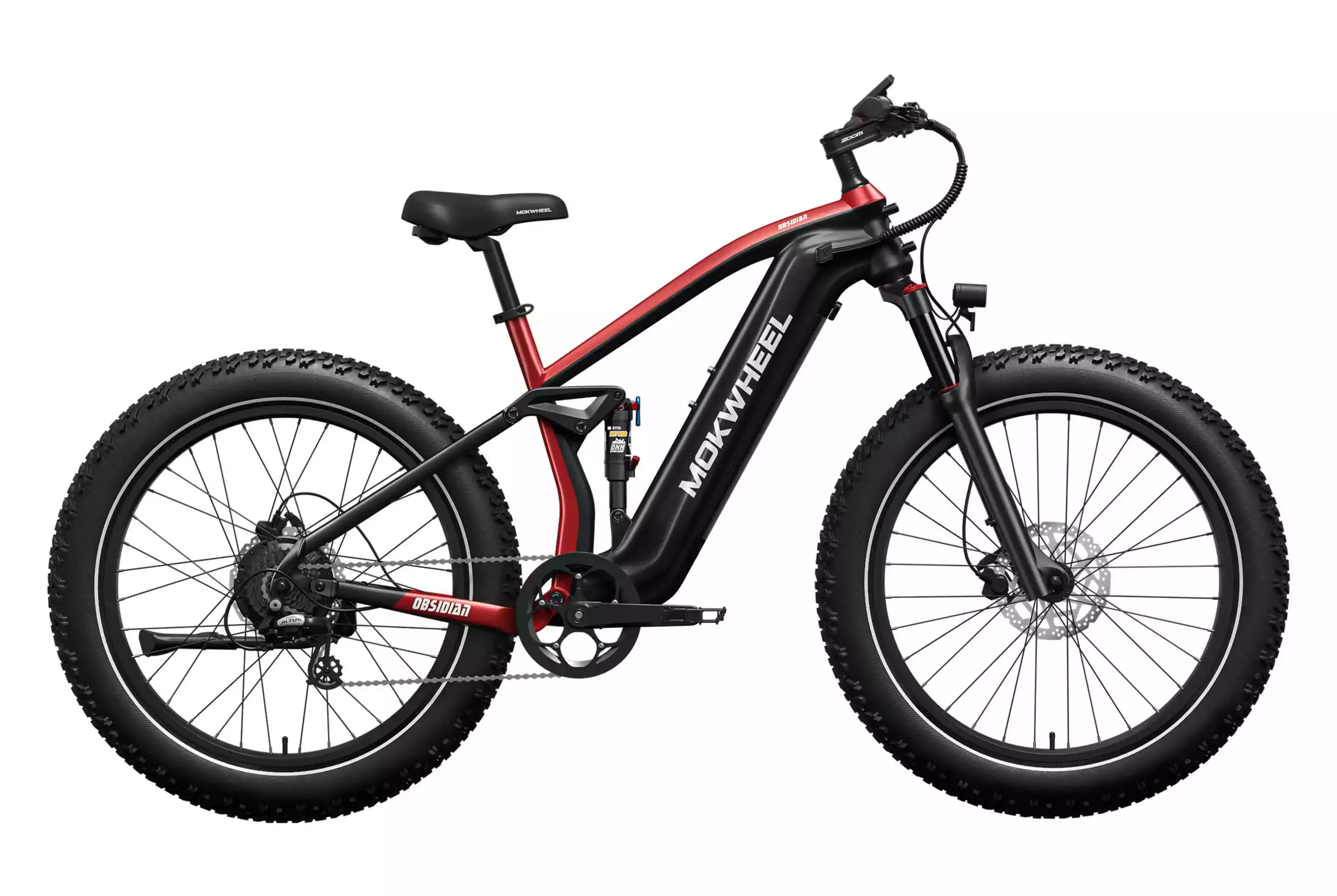
3.4. Best Full-Suspension E-MTB for Mountain Terrain
Mokwheel Obsidian Series
Designed for wild terrain and long-distance adventures, the Obsidian blends power with tech-forward features—solar charging, big suspension, and serious off-road potential.
| Feature | Details |
|---|---|
| Motor | High-power mid-drive (estimated 1300W peak) |
| Torque | Not specified (high-performing) |
| Battery | 60–80 mile range; solar charging capable |
| Top Features | Full suspension, fat tires, adventure-ready geometry |
| Price Range | $2,199.99 |
| Best For | Backcountry rides, trail hunting, all-terrain climbs |
Bonus Option: Orbea Wild – Bosch CX motor, 170mm travel, and competition-ready geometry.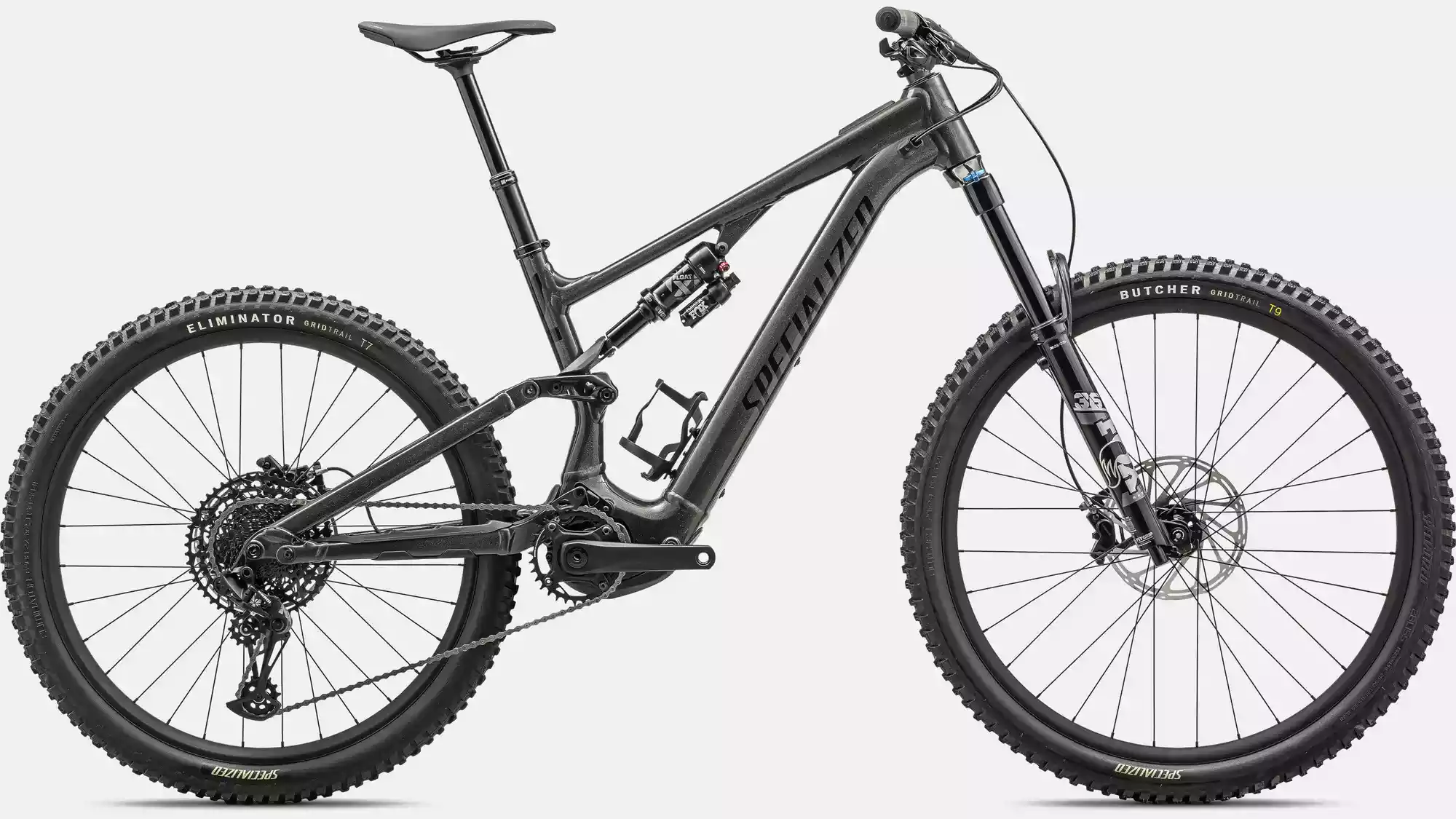
3.5. Best Lightweight E-Bike with Climbing Power
Specialized Turbo Levo SL
This sleek, featherweight e-MTB is perfect for riders who want nimble handling with just the right amount of boost. At 50Nm, it won’t win torque contests—but it climbs surprisingly well on moderate hills.
| Feature | Details |
|---|---|
| Motor | Specialized SL 1.2 mid-drive |
| Torque | 50Nm |
| Battery | 320Wh (extendable to 480Wh) |
| Top Features | 17kg frame, agile geometry, smooth power curve |
| Price Range | ~$8,000+ |
| Best For | Lighter riders, trail agility, long mixed terrain days |
Quick Reference Comparison
| Category | Best Pick | Motor Type | Torque | Battery | Price | Ideal Use |
|---|---|---|---|---|---|---|
| Best Overall Climber | Trek Rail 9.9 | Mid-drive | 85Nm | 750Wh | $13,499 | High-end climbing, all-day riding |
| Best Mid-Drive for Steep Hills | Rize RX Pro | Mid-drive | 160Nm | 52V 15–20Ah | $2,799+ | Power-heavy climbs, off-road |
| Best Budget for Hilly Areas | Qiolor Tiger RL | Hub | 85Nm | 48V 13Ah | $1,399 | Urban hill climbs, budget-friendly |
| Best Full-Suspension E-MTB | Mokwheel Obsidian Series | Mid-drive* | High | 60–80mi | $2,199.99 | Mountain trails, off-grid adventures |
| Best Lightweight Climber | Turbo Levo SL | Mid-drive | 50Nm | 320–480Wh | $8,000+ | Lightweight trail riders, agility |
These bikes prove you don’t have to suffer uphill. Whether you're scaling rugged trails, taking on long mountain commutes, or tackling a few steep blocks in your neighborhood, there’s an electric bike built for that.
Next Up: Want to make the most of your hilly ride? Let’s go over some pro tips for riding smart, staying safe, and saving battery power.
Tips for Riding an E-Bike on Hilly Terrain
Steep climbs don’t have to drain your battery—or your energy. With a few smart techniques, you can make every hill feel a little flatter and keep your ride smooth from bottom to top. Here’s how to ride more efficiently and get the most out of your hill-climbing electric bike.
Use Pedal-Assist Strategically
Pedal-assist is your best friend on climbs—but only when used right. Cranking it to the max from the start can burn through your battery faster than you think.
- Use lower assist levels on gentler grades to save power.
- Save Turbo or Boost mode for the steepest sections.
- Try riding in Eco or Tour mode to stretch your range, especially on long climbs.
Pro Tip: Think of pedal-assist like gears in a car—use more only when you really need it.
Shift Gears Before the Climb Starts
Unlike cars, e-bikes don’t love sudden gear changes under stress. Shifting too late—midway up a hill—can strain your chain and motor.
- Downshift early as you approach a hill so you’re ready to spin efficiently.
- Use lower gears to reduce resistance and help the motor assist you more smoothly.
- Listen for grinding or skipping—those are signs you waited too long to shift.
Plan Your Route with Elevation in Mind
Not all miles are created equal. A short ride with big climbs can be more demanding than a flat cruise.
- Use apps like Komoot, Ride with GPS, or Google Maps (bike mode) to preview elevation.
- Look for alternate routes that offer gentler climbs or switchbacks for longer ascents.
- Check the weather too—headwinds + hills = major battery drain.
Keep Your Battery Above 20%
Running your e-bike battery down too far can reduce performance—and may shorten the life of your battery over time.
- Start hill-heavy rides with at least 60–80% charge.
- Avoid pushing the battery below 20%, especially on multi-climb routes.
- Carry a spare charger or plan pit stops if you're going long.
Pro Tip: If your e-bike allows it, bring a range extender battery for peace of mind on big elevation rides.
With these simple habits, you’ll climb smarter, protect your gear, and ride longer with confidence. Whether you're scaling steep streets or winding up forest trails, the right approach makes every ascent more enjoyable.
Coming up next: We’ll tackle the most common questions about e-bikes and hills—so you can ride prepared and informed.
FAQs: E-Bikes and Hilly Terrain
Wondering how e-bikes really perform on hills? You’re not alone. These are some of the most common questions riders ask before taking on elevation. Let’s break them down so you can climb with confidence.
Can Hub Motors Handle Hills?
Yes—but with limitations.
Hub motors, especially rear hub types, can manage moderate hills, especially if they’re rated 750W or higher and paired with a torque sensor. But for long, steep climbs, a mid-drive motor is a better choice.
- Hub motors don’t use your bike’s gears, so they can struggle on steep terrain.
- Mid-drives work with your gearing to maintain momentum and climb more efficiently.
Pro Tip: For city riding with occasional hills, a strong hub motor will do the trick. For serious inclines or trail use, go mid-drive.
How Long Will My Battery Last on a Hilly Ride?
It depends on your battery size, terrain, assist level, and rider weight—but expect shorter range on hills.
- A 500Wh battery might get 25–40 miles in hilly conditions vs. 50–70 on flat ground.
- Using high assist modes or climbing with heavy loads will drain it faster.
- Motor efficiency also matters—Bosch and Shimano systems tend to stretch battery life better on climbs.
To extend your range:
- Use lower assist levels when possible.
- Shift early to reduce strain.
- Stay above 20% battery to keep performance consistent.
Do I Need Full Suspension for Climbing?
Not necessarily. Suspension helps more on the way down than on the way up.
- Front suspension (hardtail) is usually enough for city hills and basic trails.
- Full suspension (both front and rear) is ideal for off-road climbs, rocky terrain, or comfort on longer rides.
If you’re riding technical mountain trails, full suspension is a must. But if you’re sticking to pavement or light gravel, save the money and weight with a hardtail.
What’s More Important: Torque or Wattage?
Torque. For climbing, it’s torque—not just watts—that gets you up the hill.
- Torque is the turning force that helps move your bike uphill. It’s measured in Nm.
- Wattage shows how much power your motor can output, but high watts with low torque can still feel sluggish on climbs.
Look for motors rated at 70Nm or higher for serious hill work. Brands like Bosch, Bafang, and Shimano EP8 offer great climbing torque.
Choosing the right motor, battery, and setup makes all the difference in how your e-bike handles hills. Whether you’re still comparing options or ready to ride, the answers above should help you move forward with confidence.
Still climbing through questions? Check out our full e-bike buying guide or head straight to our top picks for hilly terrain.
6. Conclusion: Ride Higher with the Right E-Bike
When it comes to steep streets or mountainous trails, not all e-bikes are created equal. If you’re riding in hilly terrain, choosing the right combination of motor torque, battery capacity, and drivetrain is essential for a smooth, powerful climb.
A high-torque, mid-drive motor will give you the grunt you need on steep grades. A large, efficient battery keeps you moving without range anxiety. And quality components—from gears to brakes—make sure every ride is not just doable, but fun.
Pro Tip: Always test ride your e-bike on actual hills—online specs don’t always tell the full story.
Whether you’re commuting across rolling roads or heading deep into the mountains, the best e-bikes for hills turn every uphill challenge into an opportunity to ride farther, faster, and more confidently.
Ready to power up your ride? Explore our full e-bike buying guide or check out the latest 2025 reviews for top-rated climbing e-bikes. Your next great ride starts at the top.
7. Additional Resources for Hilly E-Bike Riders
Want to dive deeper into finding the perfect e-bike for hills? Whether you're comparing motors or mapping your next climb, these tools and guides will help you ride smarter and go further.
Torque Comparison Charts
Not sure how 85Nm stacks up to 60Nm? These visual guides make it easy to compare motor torque across brands like Bosch, Shimano, and Bafang.
- E-Bike Torque Comparison Chart (2025)
- Mid-Drive Motor Torque Ratings Explained
Battery Range Calculators
Estimate how far your e-bike can go on hilly terrain based on your weight, assist level, and elevation gain.
- Bosch eBike Range Calculator
- Specialized Turbo Range Tool
Pro Tip: Always add 10–15% buffer when riding routes with major elevation gains.
Local Trail & Commute Route Guides
Discover hill-friendly routes and test climbs in your area using trail-focused maps or e-bike commute planners.
- Trailforks – E-MTB Trails
- Komoot – E-Bike Climbing Routes
- Ride with GPS – Elevation Maps
Maintenance Tips for Hill Riders
Steep terrain puts more strain on your drivetrain, brakes, and battery. Keep your gear in top shape with these maintenance guides:
- How to Care for Your E-Bike Motor on Hills
- E-Bike Brake & Gear Maintenance
- Battery Health for Long Climbs
These extra tools can help you choose smarter, plan better, and keep your ride performing its best. Whether you're climbing daily or gearing up for a weekend adventure, a well-equipped rider is a confident one.
Still exploring? Head back to our top picks or check out our full 2025 e-bike buying guide for hilly terrain.
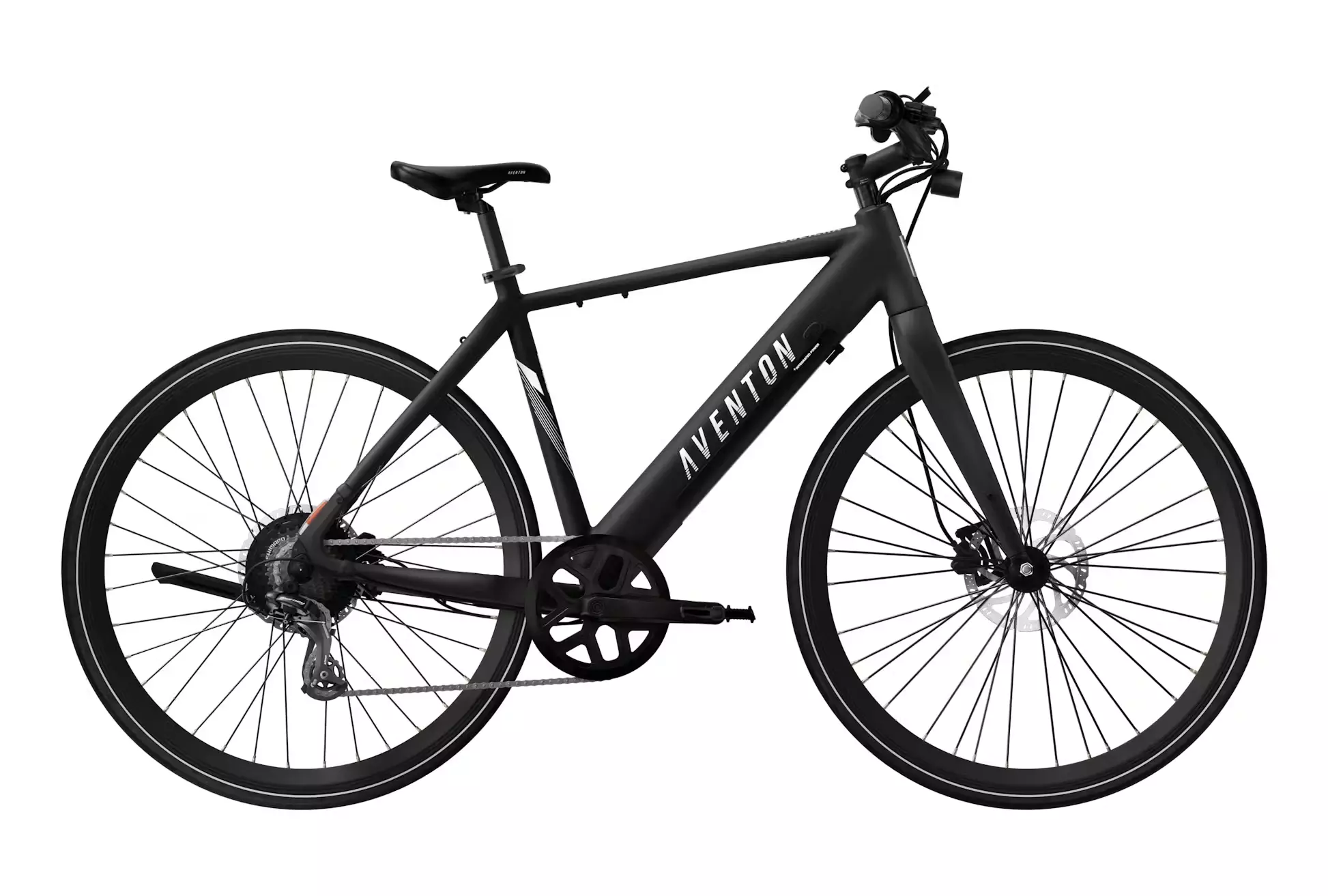
Let’s face it—teens want independence, style, and a bit of speed. And in 2025, electric bikes deliver all three. Whether it’s cruising to school, heading to practice, or just hanging with friends, e-bikes are giving young riders more freedom than ever—without needing a driver’s license.
But here’s the thing: not all e-bikes are teen-friendly. Some are too powerful. Some are too pricey. Others just don’t look cool enough to ride.
That’s why we’ve put together this e-bike buying guide specifically for teens. Whether you’re a parent looking for something safe and reliable, or a teen looking for style and speed, you’ll find exactly what you need here.
What You’ll Learn in This Guide
Choosing the right e-bike means balancing safety, cost, and style—and we break it all down for you. In this guide, you’ll find:
- Top electric bikes for teens by price and performance
- Safety tips every young rider should know
- Trendy designs that look great and ride smooth
- Pro tips for getting the best value and long-lasting use
Why It Matters
Teens are still growing, physically and emotionally. That means they need age-appropriate power, lighter frames, and smart safety features. A good e-bike isn’t just fun—it’s a tool for independence, confidence, and daily adventure.
Pro Tip:
Look for models with a top speed of 20 mph or less and adjustable seat height. These make great first e-bikes that teens can grow into safely.
The Bottom Line
The best e-bikes for teens in 2025 combine smart design with great performance—without breaking the bank. They’re fun, practical, and built to fit younger riders.
Ready to ride? Keep reading to explore the top picks for safety, affordability, and teen-approved style.
Key Things to Know Before Buying a Teen E-Bike
Shopping for the best e-bikes for teens in 2025? There’s more to it than picking the coolest-looking ride. The right electric bike balances safety, affordability, and style—and getting that balance right can make all the difference.
Here’s what to keep in mind before you buy.
Safety First: What to Look For
Teens need bikes built with their safety in mind. Here are the key features to prioritize:
- Motor Power: Look for motors in the 250W to 500W range. That’s enough for hills and speed without being too intense.
- Top Speed: Most teen-appropriate e-bikes cap out at 20 mph—fast enough for fun, slow enough for control.
- Brakes That Stop Smoothly: Choose disc brakes, either mechanical or hydraulic. Some models even offer regenerative braking, which helps recharge the battery while slowing down.
- Frame Fit: A smaller frame and lower standover height make it easier for teens to ride confidently and safely.
Pro Tip:
Skip bikes with throttles and go for pedal-assist (PAS) instead. It encourages safe riding and gives more control to new riders.
Affordability: What You’re Really Paying For
Not all e-bikes are created equal when it comes to price. Here's how to think about value:
- Entry-Level ($500–$900): Basic design, fewer features, solid for first-time riders
- Mid-Tier ($1,000–$1,500): Better batteries, smoother rides, longer warranties
- Premium ($1,600+): Longer range, higher-end components, better tech and design
Also consider long-term costs:
- Battery replacements (after ~2–4 years)
- Regular tune-ups
- Spare parts and accessories
Warranty matters too—look for at least 1-year coverage on the battery and frame, with responsive customer support.
Style, Weight & Tech: Making It Teen-Approved
Let’s be honest—if it doesn’t look cool, it won’t get ridden. Luckily, today’s e-bikes combine function with serious style.
- Design: Think sleek frames, bold or muted color options, and minimalist branding
- Weight: Go lightweight (under 55 lbs) or foldable models for easier transport
- Extras Teens Love:
- LED lights for night rides
- Phone holders and USB charging ports
- App connectivity for trip tracking and battery stats
Pro Tip:
Let teens customize with fun add-ons—colorful grips, reflective decals, or matching helmets make it feel personal and cool.
Make a Smart, Safe Choice
Choosing the right teen e-bike means thinking beyond looks. Focus on safe specs, realistic budgets, and style that fits your rider’s vibe. The perfect ride is out there—you just have to know what to look for.
Ready to narrow it down? Let’s explore the best electric bikes for teens in 2025—ranked by safety, price, and fun factor.
Top E‑Bike Models for Teens in 2025
Looking for the best e-bikes for teens in 2025? We've done the research and rounded up models that check all the right boxes—safe, stylish, and budget-smart. Whether you want a first ride under $700 or a premium folding beast with all the features, this guide has something for every young rider.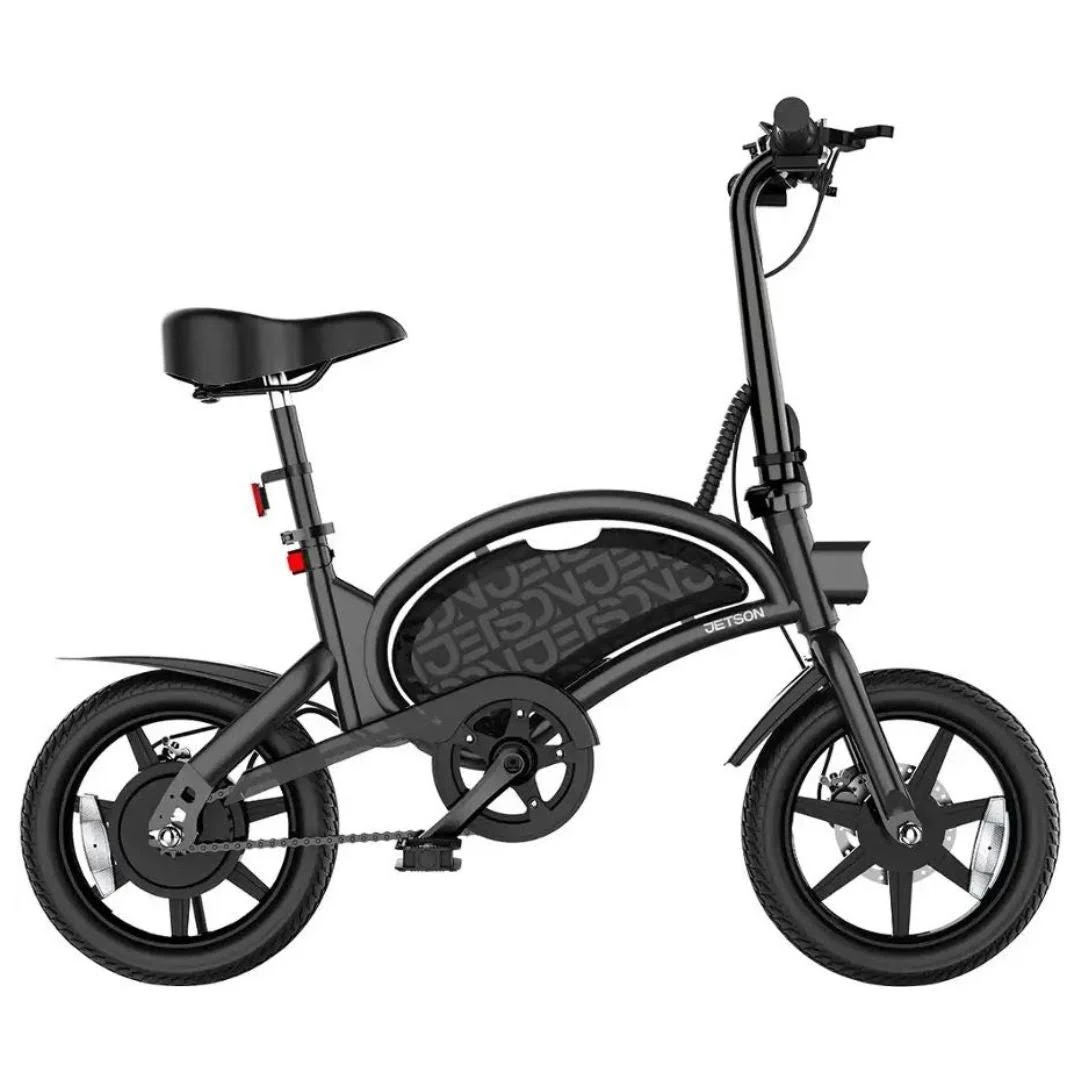
🔋 3.1 Budget-Friendly Picks
Jetson Bolt Pro
- Price: Under $600
- Motor/Battery: 250W motor, 36V battery
- Range: Up to 15 miles
- Weight: ~34 lbs
- Why Teens Love It:
- Super compact, easy to carry or stash
- Simple design, throttle-only control (no pedals)
- Great starter e-bike for short commutes or campus rides
Pros: Affordable, ultra-light, fun design
Cons: Limited range, no pedal assist
Best For: City streets and quick trips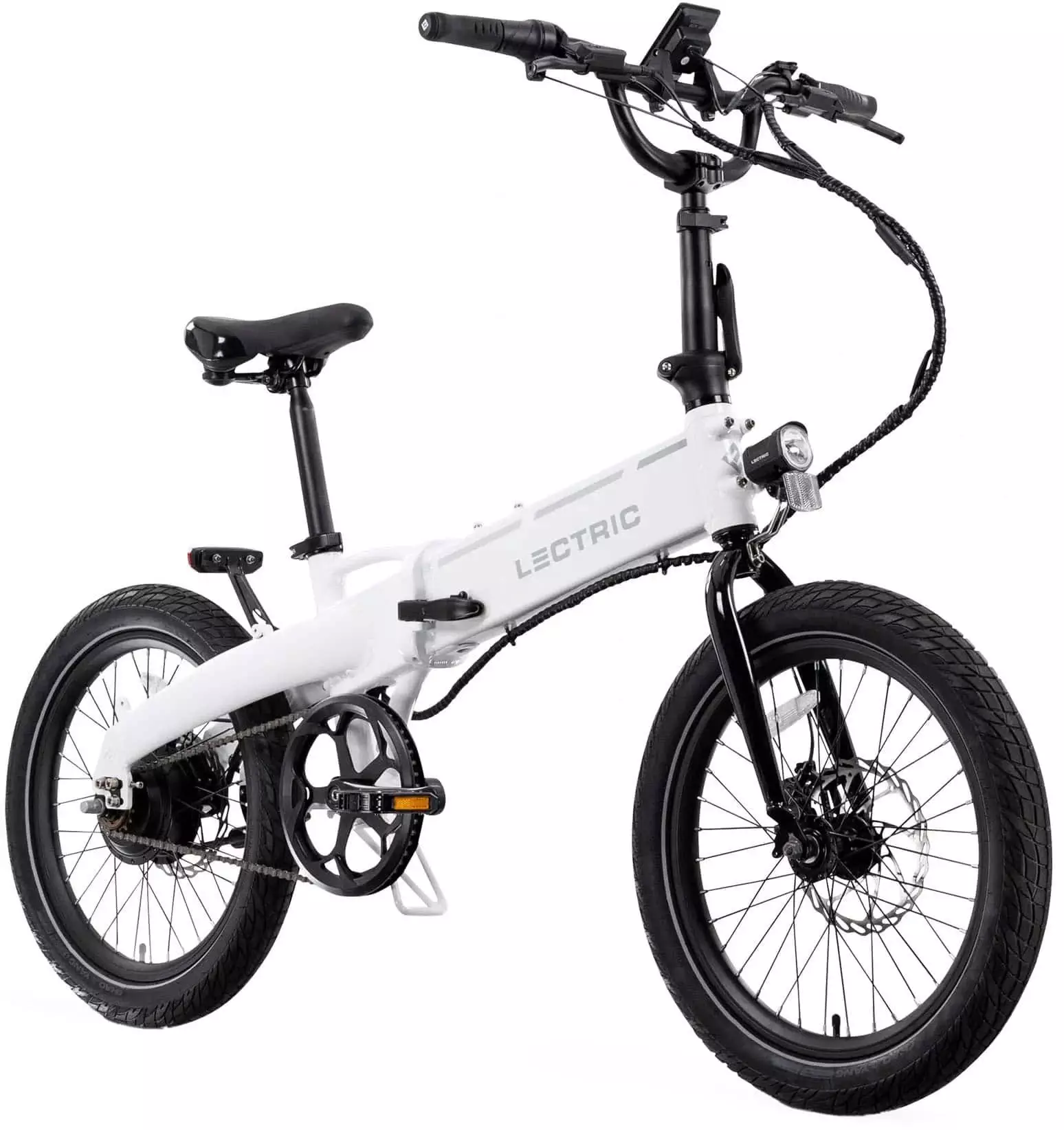
Lectric XP Lite 2.0
- Price: ~$700
- Motor/Battery: 300W motor, 48V battery
- Range: Up to 40 miles
- Weight: ~46 lbs
- Why Teens Love It:
- Foldable frame makes it great for dorms or cars
- Solid build with a minimalist vibe
- Easy to ride and store
Pros: Foldable, great battery life, durable
Cons: Single-speed, no suspension
Best For: Teens who need a reliable daily ride
Pro Tip:
Start with a simple model. Teens can upgrade later as they gain confidence and riding experience.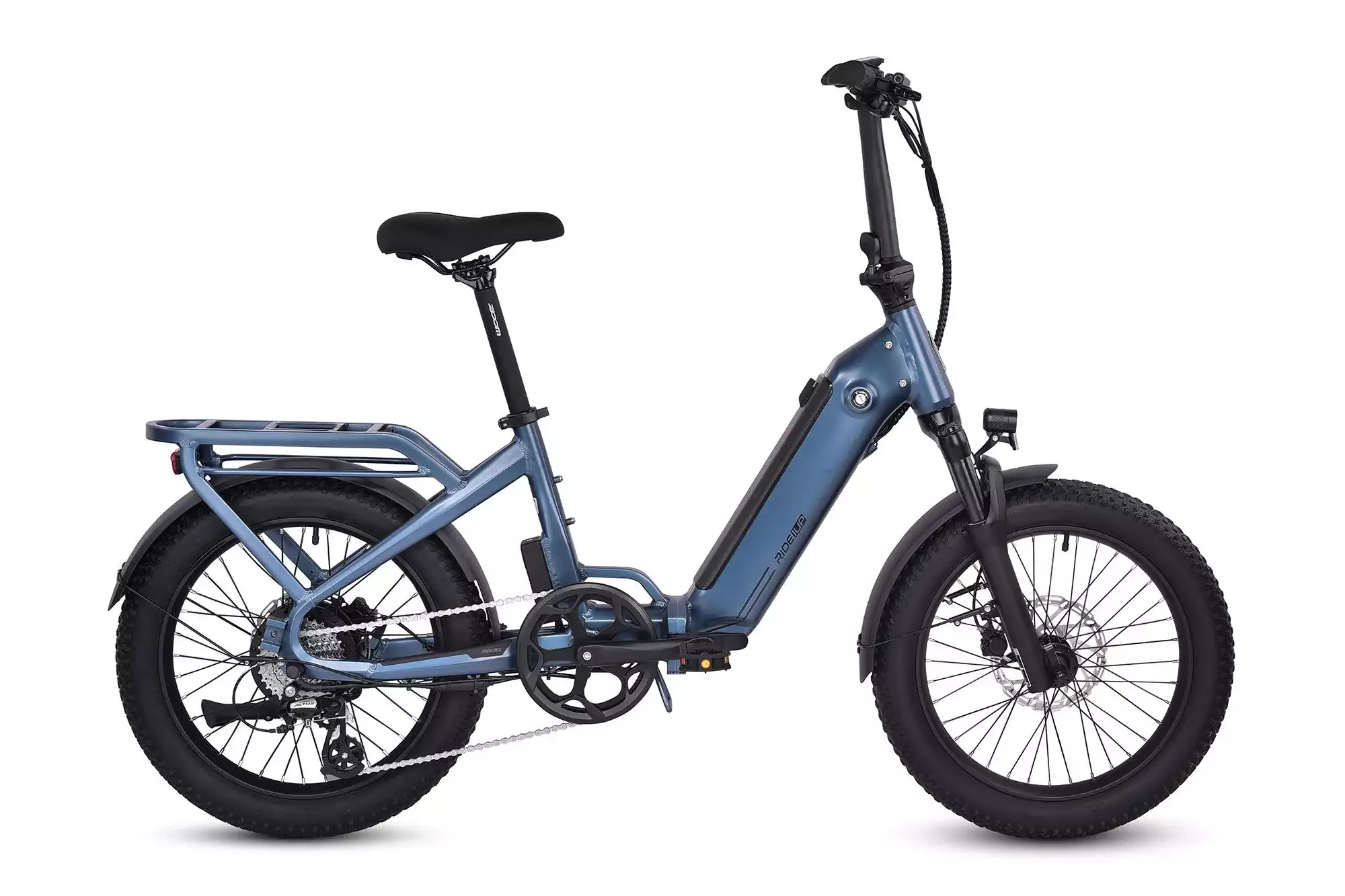
💡 3.2 Mid-Range Options
Ride1Up Portola
- Price: ~$1,000
- Motor/Battery: 750W motor, 48V 10.4Ah battery
- Range: Up to 45 miles
- Weight: ~60 lbs
- Why Teens Love It:
- Comes in cool colorways
- Folds for easy storage
- Strong motor makes uphill rides easy
Pros: High power, hydraulic disc brakes, foldable
Cons: Heavier than budget models
Best For: Teens who want more zip and style

Aventon Soltera.2
- Price: ~$1,200
- Motor/Battery: 350W motor, integrated battery
- Range: 41 miles average
- Weight: ~46 lbs
- Why Teens Love It:
- Clean urban design with integrated lights
- App connectivity for ride tracking and custom settings
- Smooth, quiet motor
Pros: Lightweight, sleek design, tech-friendly
Cons: Less power than Ride1Up
Best For: Teens who care about looks, tech, and comfort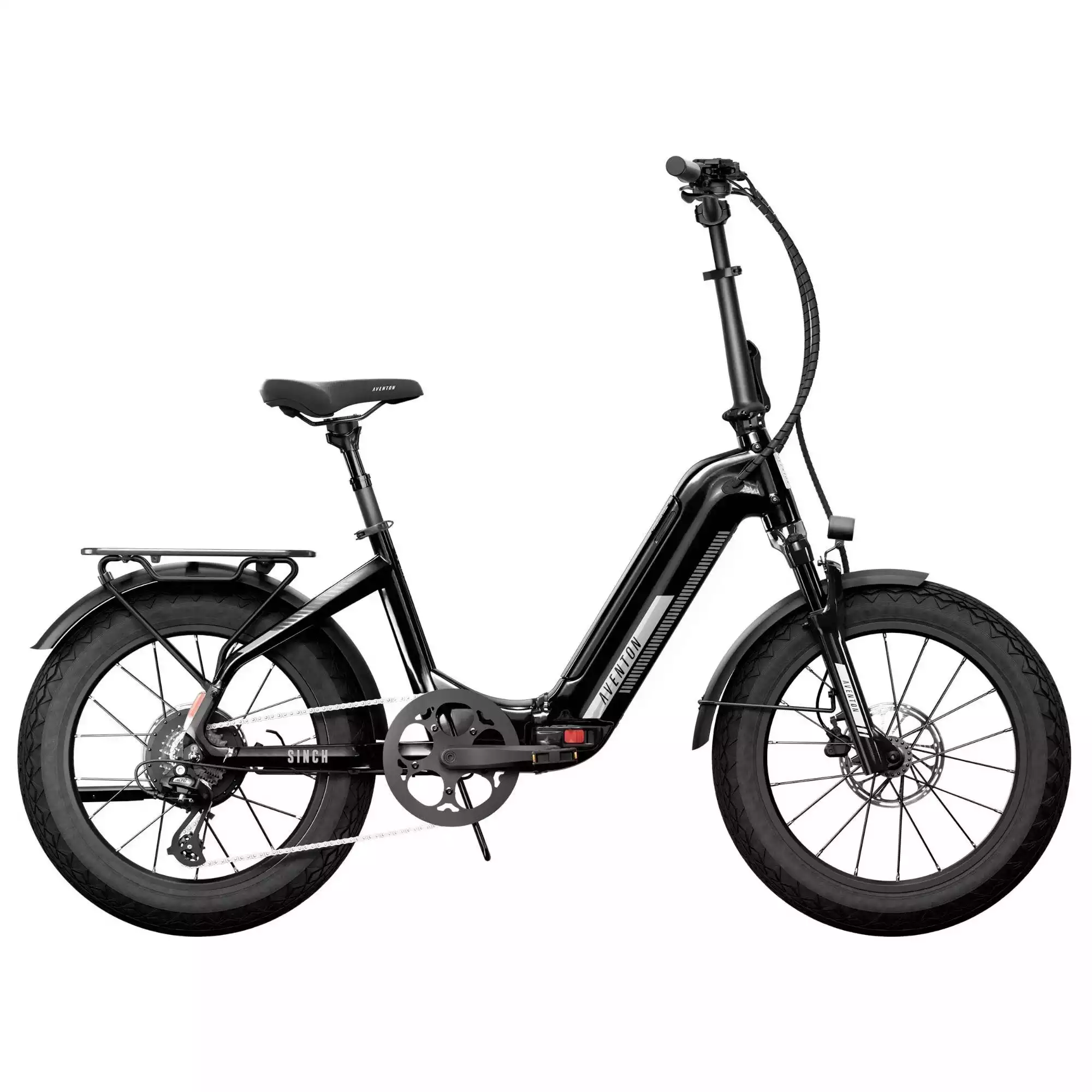
🚀 3.3 Premium / Feature-Rich Selections
Aventon Sinch 2.5
- Price: ~$1,500
- Motor/Battery: 500W motor, 48V 14Ah battery
- Range: Up to 55 miles
- Weight: ~68 lbs
- Why Teens Love It:
- Full suspension fork for smoother rides
- Folding frame with fat tires for trail or city
- App-enabled ride data and tracking
Pros: Versatile, comfortable, long range
Cons: Heavy, pricier
Best For: Teens who want adventure + commuting
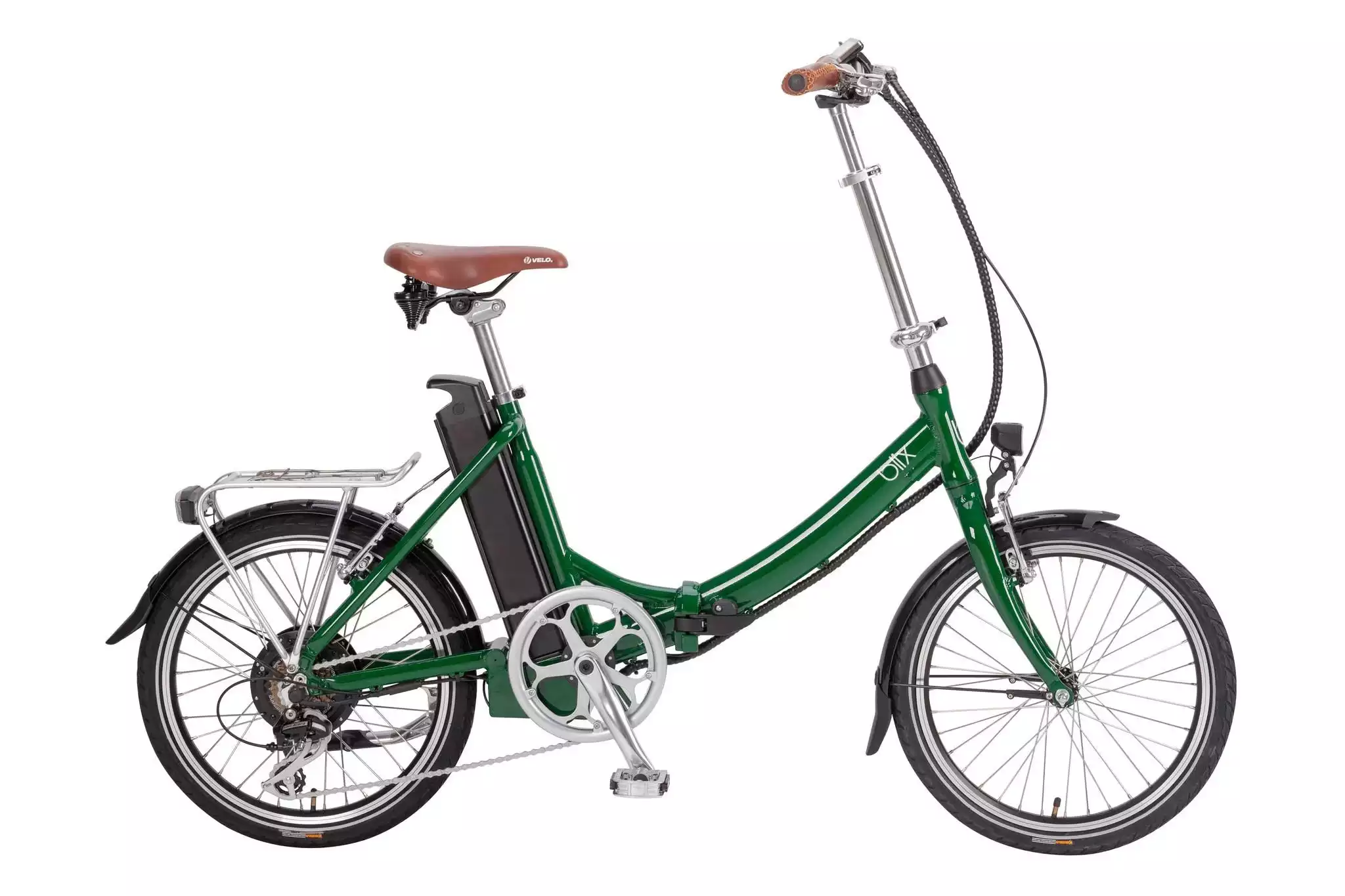
Blix Vika+ Flex
- Price: ~$1,800
- Motor/Battery: 500W motor, 48V 12.8Ah battery
- Range: Up to 45 miles
- Weight: ~55 lbs
- Why Teens Love It:
- Beautiful, retro-inspired frame
- Long battery life and premium parts
- Semi-foldable for smaller storage spaces
Pros: Stylish, high build quality, great range
Cons: Premium price, semi-folding only
Best For: Teens with big style and daily ride needs
Comparison Snapshot
| Model | Price | Range | Foldable | Top Feature |
|---|---|---|---|---|
| Jetson Bolt Pro | <$600 | 15 mi | ❌ | Ultra-light, no pedals |
| Lectric XP Lite | ~$700 | 40 mi | ✅ | Foldable, solid battery |
| Ride1Up Portola | ~$1,000 | 45 mi | ✅ | Power + hydraulic brakes |
| Aventon Soltera.2 | ~$1,200 | 41 mi | ❌ | Sleek design + app control |
| Aventon Sinch 2.5 | ~$1,500 | 55 mi | ✅ | Suspension + fat tires |
| Blix Vika+ Flex | ~$1,800 | 45 mi | Semi | Retro design + full setup |
Your Perfect Ride Awaits
Whether you want a no-fuss entry-level e-bike or a premium ride with bells and whistles, 2025 has something for every teen. Focus on what matters most—safety, range, portability, or tech—and find the e-bike that fits your lifestyle.
Ready to ride? Start comparing your favorites and lock in the best deal before they sell out.
Safety & Equipment Guide for Teens: Gear Up and Ride Smart
Are you ready to help your teen ride their new e-bike with confidence and safety? Choosing the best e-bikes for teens is just the start. Equipping them with the right gear and teaching good riding habits can make every trip safer and more fun.
Here’s your go-to e-bike buying guide for safety gear and smart riding tips.
Required & Recommended Gear: What Every Teen Rider Needs
Safety starts before the wheels start spinning. Make sure your teen has:
- DOT-Certified Helmet
A properly fitting helmet is non-negotiable. It protects the head from impact and reduces injury risk dramatically. Look for helmets made specifically for teens or youth, with adjustable straps and ventilation. - Reflective Clothing & Accessories
Bright or reflective jackets, vests, or arm bands help drivers and other riders see your teen, especially at dusk or night. - Gloves, Knee & Elbow Pads
These protect from scrapes and bruises during minor falls. Gloves also improve grip on handlebars for better control. - Secure Locks & GPS Trackers
A U-lock is usually better than a chain lock for keeping the e-bike safe from theft. Adding a small GPS tracker provides extra peace of mind by allowing you to locate the bike if it goes missing.
Teaching & Riding Best Practices: Building Good Habits Early
A safe rider is a confident rider. Here’s how to help your teen stay sharp on the road:
- Basic Maintenance Checks
- Tire pressure: Under- or over-inflated tires can affect handling. Check weekly with a simple gauge.
- Brakes: Ensure brakes respond promptly and pads aren’t worn down.
- Battery care: Charge regularly and avoid deep discharges to keep the battery healthy longer.
- Know the Rules of the Road
- Keep speeds at or below local limits (usually around 20 mph for teens).
- Share the road responsibly with pedestrians, cars, and other cyclists.
- Ride in designated bike lanes or safe zones when available.
- E-Bike Etiquette & Awareness
Teach your teen to:- Always signal turns and stops with hand gestures
- Be alert for obstacles, parked cars, and opening doors
- Use mirrors or look back before changing lanes or crossing
Pro Tip:
Practice makes perfect! Ride together at first to review safety rules and build confidence in different traffic conditions.
Why This Matters for Teens & Parents
Teen riders are still learning, so combining the right gear with good habits reduces risk and builds lifelong safe riding skills. Plus, knowing their bike is secure and ready to go makes riding more enjoyable and worry-free.
Ready to Ride with Confidence?
Buying one of the best e-bikes for teens in 2025 is only the beginning. Outfit your rider with these essentials, teach them smart riding, and watch their confidence—and fun—grow!
Find the perfect e-bike and gear now, and get your teen rolling safely this year!
Cost Comparison & Value Analysis: Find the Best Bang for Your Buck in 2025
Wondering how to get the most value when shopping for the best e-bikes for teens? Price is important, but it’s just one part of the equation. Weight, range, speed, and warranty all factor into the long-term cost and satisfaction of your purchase.
In this e-bike buying guide, we break down what you really get for your money and highlight top picks that balance cost and features perfectly.
Side-by-Side Cost Comparison Table
| Model | Price | Weight | Range (miles) | Max Speed (mph) | Warranty |
|---|---|---|---|---|---|
| Jetson Bolt Pro | Under $600 | 34 lbs | 15 | 15 | 1 year (limited) |
| Lectric XP Lite 2.0 | ~$700 | 46 lbs | 40 | 20 | 1 year |
| Ride1Up Portola | ~$1,000 | 60 lbs | 45 | 20 | 2 years |
| Aventon Soltera.2 | ~$1,200 | 46 lbs | 41 | 20 | 2 years |
| Aventon Sinch 2.5 | ~$1,500 | 68 lbs | 55 | 20 | 2 years |
| Blix Vika+ Flex | ~$1,800 | 55 lbs | 45 | 20 | 2 years |
Best Value Picks for 2025
- Top Pick Under $1,000: Lectric XP Lite 2.0
It offers a solid 40-mile range and a foldable frame at an affordable price—perfect for teens who want quality without splurging. - Longest Range for the Price: Aventon Sinch 2.5
At around $1,500, it delivers an impressive 55 miles per charge, plus comfort features like a suspension fork. - Best Lightweight Option: Jetson Bolt Pro
At just 34 lbs, this is a great choice for portability and ease of use, especially for younger or smaller teens.
Long-Term Ownership: What to Expect
Buying an e-bike is an investment, and understanding the total cost of ownership helps you make a smart choice.
- Battery Life & Replacement: Expect about 3–5 years before the battery needs replacing, which can cost $200–$600 depending on the model.
- Maintenance Costs: Regular tune-ups, brake pads, and tire replacements add up, but many entry-level bikes keep these costs low.
- Warranty & Support: Longer warranties give peace of mind and may save money if repairs are needed.
Pro Tip:
Choosing a slightly higher-priced bike with a longer warranty and better components often saves money over time.
Making the Best Choice
When comparing prices, don’t just focus on upfront cost. Look for balance—a bike that fits your teen’s riding style, has a reliable range, and offers solid support.
With this overview, you’re set to make a confident decision in your search for the best e-bikes for teens in 2025.
Ready to ride? Explore detailed reviews and shop with confidence today!
Style & Customization Tips for Teen E-Bikes in 2025
E-bikes aren’t just about getting from point A to B—they’re a form of self-expression. For teens especially, owning one of the best e-bikes in 2025 means customizing it to match their personal style while staying safe and visible on the road.
In this part of our e-bike buying guide, we’ll explore top design trends, fun accessories, and clever ways to mix function with flair.
Hottest E-Bike Style Trends Among Teens
Teens in 2025 are blending sleek looks with bold accents. Popular styles include:
- Matte finishes in colors like forest green, charcoal, and deep teal
- Pop-tone accents—think neon cables, colored valve caps, or bright decals
- Retro-inspired frames with modern tech features
- Minimalist dashboards that cleanly integrate display screens and controls
Teens want bikes that look good cruising down the street—but also stand out in a crowd.
Must-Have Accessories for Teens
These simple add-ons not only personalize a ride but improve function, comfort, and safety too.
- 🛞 Grip Tape or Custom Bar Tape – Adds control and color to the handlebars
- 🛡️ Fenders & Mudguards – Keep clothes clean and match the bike’s aesthetic
- 📦 Cargo Racks & Baskets – Practical for books, snacks, or gear
- 🌈 LED Accent Lights – Underglow or wheel lights for night visibility and serious style points
- 💠 Spoke Reflectors or Rim Stickers – A small touch that adds pop and safety
- 📱 Phone Mounts – Keeps maps, music, and tracking apps within easy view
Pro Tip:
Match reflective decals or LED accents to your teen’s helmet or backpack for a coordinated look that boosts safety.
How to Personalize for Fun & Safety
Customizing your e-bike is more than just looking cool—it can actually make riding safer and more enjoyable.
- Choose reflective or glow-in-the-dark tape for bar grips or wheels
- Add a bell or horn with a sound your teen loves (classic ding or quirky honk!)
- Look for accessories with dual purpose—like racks with built-in lights or smart helmets with turn signals
Encourage your teen to pick upgrades that highlight their personality while enhancing visibility and comfort. The goal is to make the bike feel like theirs—and to make sure it’s equipped for any type of ride.
Final Thoughts: Style Meets Safety
One of the best things about owning an e-bike in 2025 is how easy it is to personalize. With the right accessories and a little creativity, any teen can turn their ride into a mobile expression of who they are—while staying road-ready and responsible.
Ready to personalize one of the best e-bikes for teens? Dive into your favorite gear shop and start customizing today!
Real-World Testing & User Feedback: How These E-Bikes Perform for Teens
Real‑World Testing & User Feedback
When it comes to picking the best e-bikes for teens in 2025, nothing beats hands-on experience. We gathered feedback from teen riders, parents, and online communities to give you a clear view of how these bikes perform in everyday life.
Handling, Comfort & Ease-of-Use
- Jetson Bolt Pro: “Super light and easy to steer. My 14-year-old figured it out in one afternoon,” said one Reddit parent.
- Lectric XP Lite: Teens love its foldability and intuitive throttle. “Not intimidating at all,” shared a 15-year-old rider on YouTube.
- Ride1Up Portola: Parents say it's “a great commuter—quiet and smooth,” with responsive brakes that inspire confidence.
- Aventon Soltera.2: Popular for city teens. “Feels like a real bike, but faster,” according to a review on TikTok.
- Aventon Sinch 2.5: Teens report a comfortable ride even on bumpy paths, thanks to the suspension fork and sturdy frame.
Teen & Parent Feedback
🗣️ “I was worried it’d be too fast, but it’s manageable and helps her get to practice safely.” – Parent review on EBR
🗣️ “My friends all want to ride it now. I added neon wheel lights, too.” – 16-year-old owner
🗣️ “It’s become part of our daily routine. We even take it on family camping trips.” – Family post in a Facebook group
Community Reliability Insights
From Reddit, Facebook e-bike groups, and YouTube comments, riders praised:
- Easy setup and clear instructions
- Consistent performance over time
- Good brand support (especially Aventon and Lectric)
Minor drawbacks? Some users mentioned basic pedals or accessories needing upgrades, but overall satisfaction remains high.
🛠️ Pro Tip: Always check tire pressure and brake tension weekly. A little maintenance goes a long way!
—
Decision‑Making Flowchart: How to Choose the Right Teen E-Bike
Not sure where to start? This simple checklist helps you confidently choose the best e-bike for your teen based on real needs and preferences.
Step 1: Set a Budget
- Under $700? Look at value picks like the Jetson Bolt Pro or Lectric XP Lite.
- $1,000–$1,500? Go mid-range for extra safety and tech—think Aventon Soltera.2 or Ride1Up Portola.
- $1,500+? Explore premium folding bikes with long range like the Aventon Sinch 2.5.
💡 Pro Tip: Don’t forget to budget $100–$200 for must-haves like helmets, locks, and lights.
Step 2: Focus on Safety
Key teen-friendly safety features:
- 250–500W motor (keeps speed manageable)
- Max speed near 20 mph
- Hydraulic or mechanical disc brakes
- Built-in LED lighting and reflectors
If riding at night, LED spoke lights and reflective tape go a long way.
Step 3: Pick a Style & Design
Let your teen’s personality shine! Popular choices include:
- Matte finishes or pop-color accents
- Foldable frames for easy storage
- Custom bar tape, spoke lights, or phone mounts
They’ll ride more when they love the look.
Step 4: Know Local Rules
Before buying, make sure you’re compliant with local laws:
- Minimum age to ride an e-bike
- Helmet requirements
- Where e-bikes are allowed (bike paths, sidewalks, etc.)
Check with your city’s transportation site or DMV.
Step 5: Try It Out
Nothing beats a test ride:
- Visit local shops with demo units
- Look for brands with good return policies
- Watch real-user ride tests on YouTube
Let your teen get a feel for control, height, and comfort before committing.
—
Ready to choose with confidence? Use this checklist to match the perfect ride to your teen’s needs—and start shopping smarter today!
🏁 Conclusion & Final Recommendations: Best E-Bikes for Teens in 2025
Finding the best e-bike for a teen in 2025 doesn’t have to be overwhelming. With the right mix of safety, style, and smart value, you can feel confident picking a model that’s exciting to ride and built to last.
Let’s recap the top choices and key takeaways to help you decide with ease.
—
🚲 Top Picks by Budget Tier
Whether you're looking for something simple or feature-packed, these models stand out:
- 💰 Budget-Friendly:
• Jetson Bolt Pro – Compact, lightweight, ideal for younger or beginner teen riders
• Lectric XP Lite – Foldable, under $700, strong reputation for durability and value
- 💡 Mid-Range:
• Ride1Up Portola – Great performance for around $1K, folding frame and hydraulic brakes
• Aventon Soltera.2 – Sleek design, built-in lights, app control, ideal for everyday commuting
- Premium/Feature-Rich:
• Aventon Sinch 2.5 – Suspension fork, long range, ride analytics
• Blix Vika X – Long battery life, foldable, full fender + light kit
No matter the price range, each of these models offers a great mix of performance, safety, and teen-friendly design.
—
Key Things to Keep in Mind
- Always prioritize safety: look for disc brakes, LED lights, and manageable top speeds
- Make sure the size, weight, and frame are age-appropriate
- Factor in long-term value—warranty, battery life, and upgrade options
- Style matters! Teens ride more when the bike fits their personality
Pro Tip: Test rides can make all the difference. What feels “just right” to your teen might surprise you—so try before you buy when possible.
—
Encourage Safe, Responsible Riding
An awesome e-bike means nothing without smart habits behind the handlebars:
- Make a DOT-certified helmet a must
- Add bright reflectors or LED accents to boost visibility
- Teach basic maintenance—like tire pressure checks and charging routines
- Respect road rules and local regulations (especially speed limits and riding zones)
Encouraging these habits early helps your teen build confidence and ride responsibly for years to come.
—
🎉 Final Thoughts
The 2025 electric bike review for teens shows one thing clearly—there’s never been a better time to ride. With so many options balancing affordability, safety, and cool factor, finding the right fit is easier than ever.
Ready to roll? Use this e-bike buying guide to pick your perfect match—and enjoy the ride ahead.
Additional Resources for Teen E-Bike Safety, Community & Maintenance
Looking for more ways to level up your e-bike knowledge? Whether you’re a parent, teen rider, or just exploring your options, these curated links and tools offer extra confidence as you shop, ride, and maintain one of the best e-bikes for teens in 2025.
From safety standards to community forums, here’s where to click next.
—
Know the Safety Standards
Not all e-bikes are built the same—and safety certifications matter.
- UL 2849: This is the gold standard for e-bike electrical safety. Look for this label on any e-bike you’re considering. Learn more at the official UL website.
- CPSC Guidelines: The Consumer Product Safety Commission outlines national rules for speed limits, braking, labeling, and helmet use. A great go-to before buying.
• Official Link: https://www.cpsc.gov/Newsroom/News-Releases/2023/Ebike-Safety
Pro Tip: Some states are rolling out additional safety inspection rules for new e-bikes, especially for younger riders. Check with your local DMV or Department of Transportation.
—
Join Teen E-Bike Communities
Get first-hand feedback, reviews, and style inspiration from other teen riders and parents. These online groups are full of real-world insights.
- Reddit – r/ebikes: Popular forum where users post ride updates, mods, safety advice, and teen-friendly bike reviews
- YouTube Channels:
• Electrek – In-depth reviews and test rides
• Micah Toll – Great for beginner tips and budget picks
• Two Wheeling Tots – Family-focused reviews on youth bikes
- Facebook Groups:
• “Teens Who Ride” (community for safe commuting and gear sharing)
• “Parents of E-Bike Teens” (reviews + local law discussions)
—
Learn to Maintain Your Ride
Keeping your teen’s e-bike in great shape is easier than you think—especially with these friendly, step-by-step tutorials.
- Lectric Bikes YouTube Channel – Covers brake checks, battery care, and general troubleshooting
- REI Expert Advice – Basics on tire inflation, chain lube, and storage
- Aventon Support Library – Model-specific videos for setup, maintenance, and app pairing
- YouTube Search Tip: Look for “[your model name] + maintenance” or “e-bike 101” to find beginner-friendly tutorials
Pro Tip: A simple maintenance kit (multi-tool, tire pump, chain oil) goes a long way. Add one to your teen’s gear setup for quick home fixes.
—
Stay Informed & Ride Smart
The best e-bike buying guide doesn’t end after the purchase—it’s about staying connected, safe, and empowered as a rider. Bookmark these resources, share them with your teen, and use them to keep your e-bike experience smooth and fun.
Ready to explore top picks and reviews again? Jump back to our list of the best e-bikes for teens in 2025 and start comparing now!
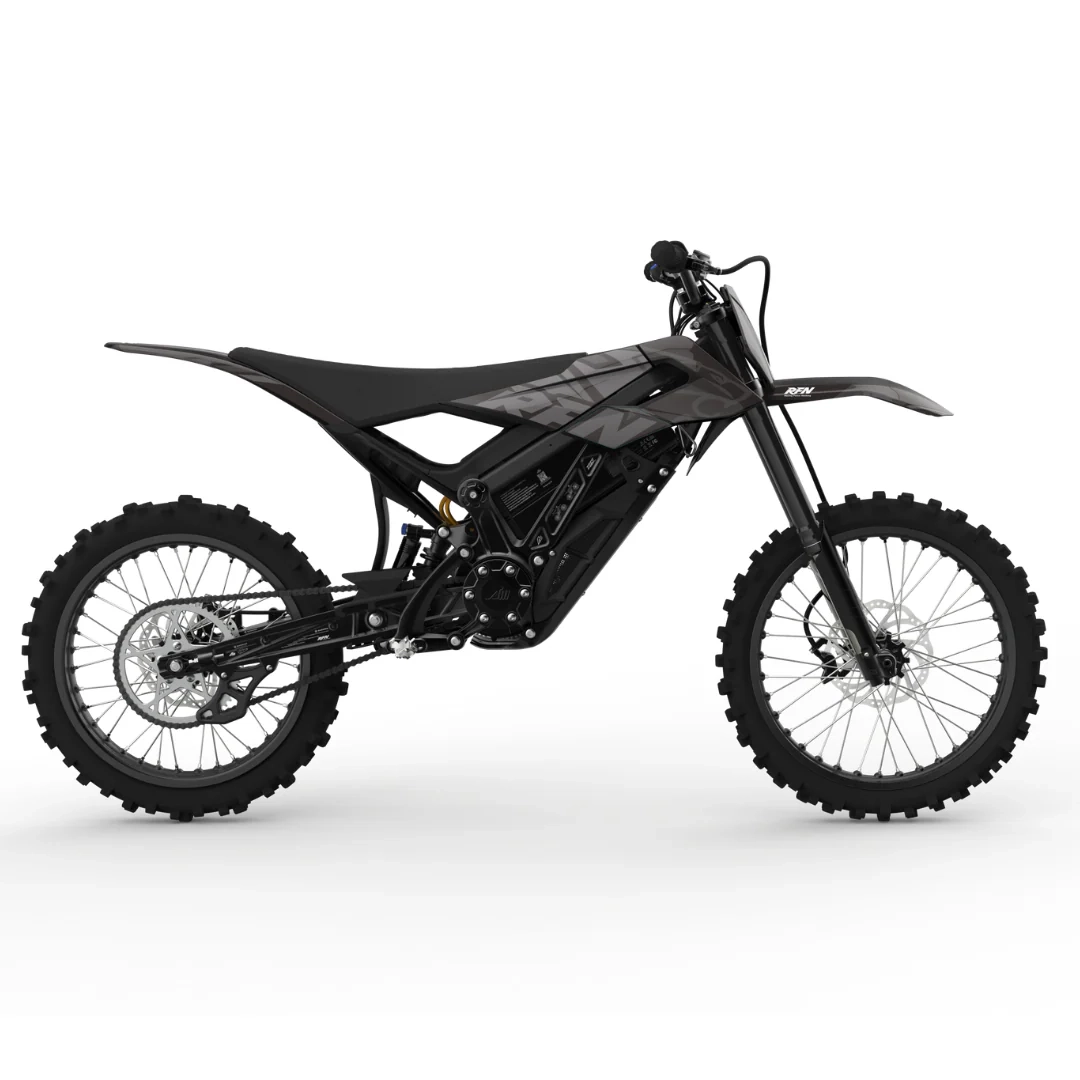
Dreaming of tearing up trails without the roar of a gas engine? Electric dirt bikes are leading a quiet revolution in off-road riding. With instant torque, zero emissions, and far less maintenance, they’re becoming the go-to choice for riders who want performance and sustainability.
This guide is built for anyone ready to hit the dirt—whether you're a total beginner, a seasoned rider looking to upgrade, or just someone who wants a fast, fun, and eco-friendly ride.
What to Look for in an Electric Dirt Bike
Before you pick your ride, it helps to know what matters most. Here are the key features to compare:
- Motor Power & Torque: Higher wattage = more speed and hill-climbing strength
- Battery Life & Range: Look for 40–70 mile range per charge, depending on ride style
- Suspension & Build: Quality suspension softens jumps and rough terrain
- Weight & Frame: Lightweight aluminum is easier to maneuver than steel
- Top Speed: Most e-dirt bikes range from 30–55 mph
- Terrain Compatibility: Choose tires and frame design that match your riding environment
Pro Tip:
If you're new to e-dirt bikes, look for models with adjustable ride modes so you can start slow and unlock full power later.
Not all electric dirt bikes are built the same—and choosing the right one can make or break your off-road experience. Whether you're bombing down trails or cruising forest paths, this e-bike buying guide breaks down the key features you actually need to understand.
Below are the essentials to compare when shopping for the best e-dirt bikes in 2025:
Motor Power & Torque
The motor is your engine—so power matters. Look for bikes with at least 2,000–5,000 watts of power for real off-road capability. Torque is what helps you climb steep hills and accelerate out of turns.
- More torque = better performance on rough trails and inclines
- Brushless motors tend to be quieter and more efficient
Pro Tip:
If you're a beginner, go for a model with multiple power modes so you can build confidence before unlocking full torque.
Battery Life & Range
Your battery controls how far you can ride. Most electric dirt bikes offer a range of 30 to 70 miles per charge, depending on terrain, rider weight, and speed.
- Swappable batteries are great for all-day adventuring
- Look for fast-charging (under 4 hours) if you're tight on time
If you plan to ride remote trails, range should be one of your top priorities.
Suspension & Handling
Unlike street e-bikes, dirt bikes need serious suspension to absorb impact from rocks, jumps, and uneven terrain.
- Go for dual suspension with at least 6–8 inches of travel
- Adjustable forks help you tune the ride for different terrain
Good suspension keeps you comfortable—and in control—when the trail gets rough.
Weight & Frame Design
Light bikes are easier to throw around, but heavier frames offer better stability at speed.
- Aluminum frames = lighter, more agile
- Steel frames = tougher, but heavier
Make sure the frame fits your size and riding style. If you’re smaller or new to off-roading, weight can affect how confident you feel on the bike.
Top Speed & Ride Modes
Speed matters—but control matters more. Most e-dirt bikes hit between 30 to 55 mph, with some racing models topping 60+.
- Look for adjustable ride modes: eco, sport, turbo
- Speed-limited modes are great for teens or cautious riders
Want to go full throttle? Just make sure your brakes and tires can handle it.
Tire Type & Terrain Compatibility
The right tires can make or break your ride. Choose based on the terrain you’ll tackle most often.
- Knobby tires = best for trails, dirt, and mud
- All-terrain tires = good balance for mixed surfaces
- Sand or snow? Look for wider tires with deep tread
Pro Tip:
If you’ll be riding in different conditions, look for bikes with easily swappable wheels or rims.
Rider Fit
E-dirt bikes come in all shapes and sizes—just like riders.
- Check recommended height and weight limits
- Look for adjustable seat height and handlebar reach
- Youth models are scaled down for safety and comfort
If you’re sharing a bike or still growing, choose a model with flexible sizing.
Quick Recap
When choosing an electric dirt bike, focus on what matches your needs:
- Speed? Look at motor wattage and top speed
- Long rides? Prioritize battery range and fast charging
- Rough trails? Suspension and tire type are key
- New rider? Keep it light and manageable with ride modes
Ready to find your perfect off-road match?
Keep reading to discover the top 10 best electric dirt bikes of 2025, handpicked for every type of rider.
Best Electric Dirt Bikes of 2025: Ranked List
Ready to meet the fastest, most capable electric dirt bikes of 2025? Whether you're looking for raw speed, trail-tuned handling, or teen-friendly designs, this list has a ride for you. Below are the top 10 e-dirt bikes ranked by performance, features, and value—so you can find your perfect off-road match.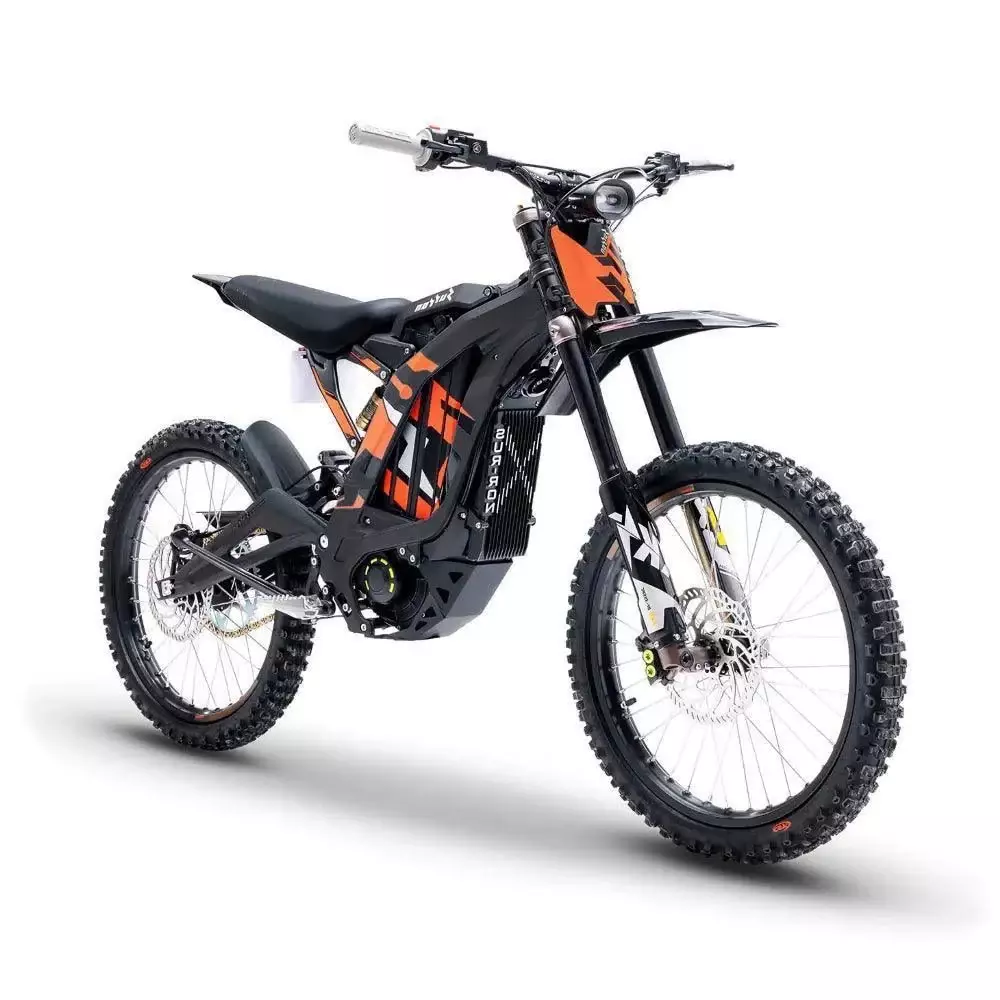
1. Sur Ron Light Bee X
Best all-around e-dirt bike for performance and value
- Motor: 8kW
- Battery: 60V 40Ah
- Top Speed: 46.6 mph
- Range: Up to 46.6 miles
- Weight: ~125.6 lbs
- Best for: Beginners, trail riders, daily use
Pros
✅ Fast charging (2 hrs)
✅ Excellent torque and handling
✅ Lightweight and beginner-friendly
✅ Regenerative braking
Cons
❌ Not ideal for long-distance trail riding
❌ Suspension may feel basic for hardcore riders
Price: ~$4,500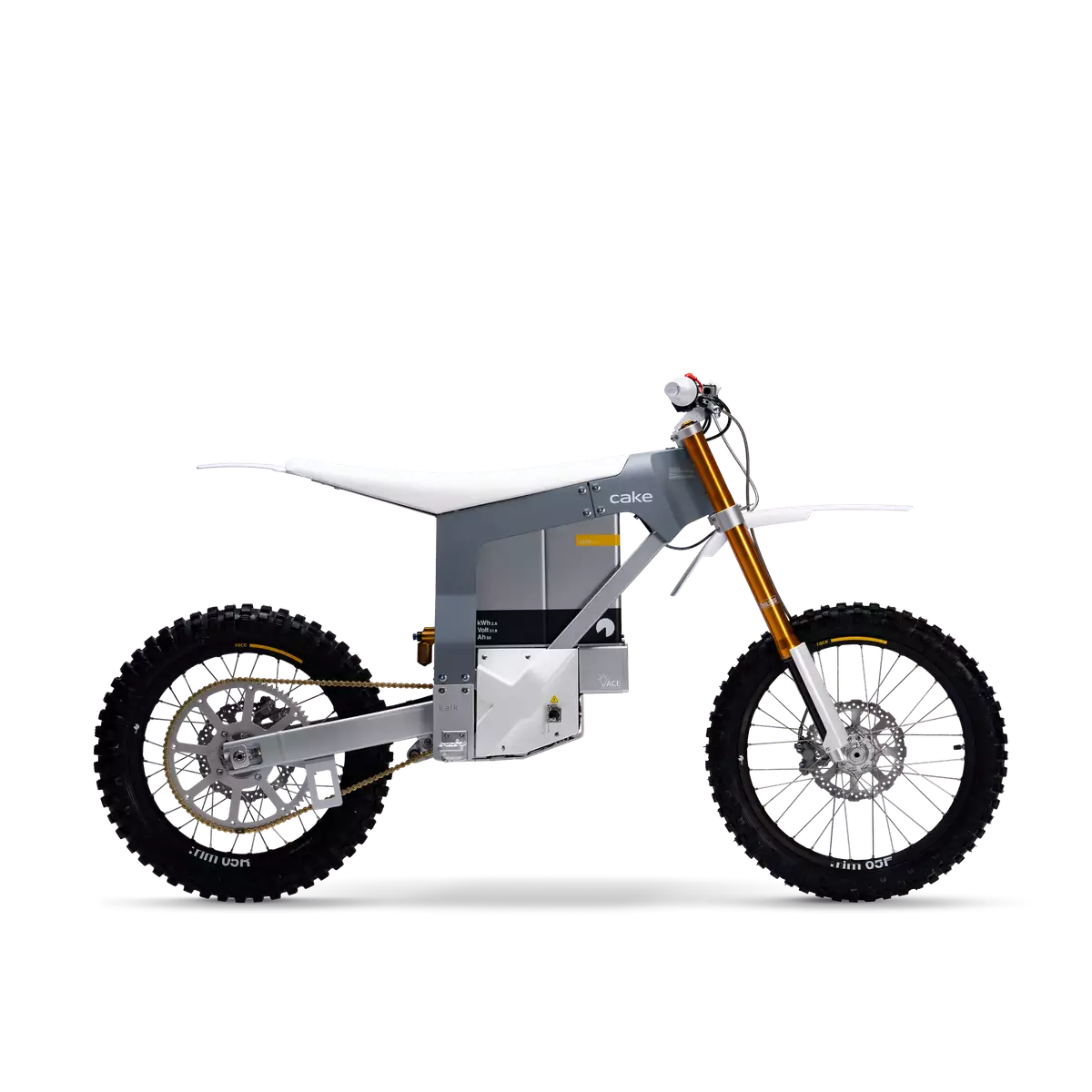
2. Cake Kalk INK
Premium pick for serious off-road riders
- Motor: 11kW
- Battery: 51.8V 50Ah
- Top Speed: 56+ mph
- Range: Up to 4 hours of ride time
- Weight: 174 lbs
- Best for: Advanced riders, performance-focused buyers
Pros
✅ Stylish, high-end build
✅ Huge torque (280Nm)
✅ Excellent for tech terrain
Cons
❌ Expensive
❌ Slightly heavier than Kalk OR
Price: ~$11,000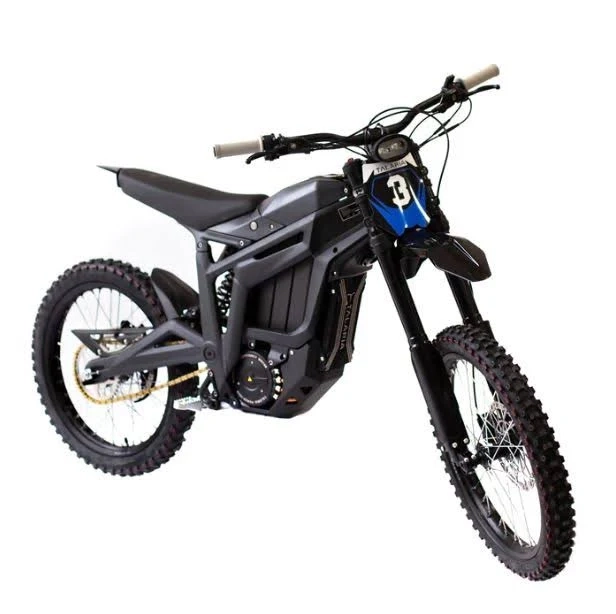
3. Talaria Sting R MX4
Great mid-range option with strong torque and battery life
- Motor: 8kW peak
- Battery: 60V 45Ah LG
- Top Speed: 53 mph
- Range: Up to 74 miles
- Weight: ~145 lbs
- Best for: Intermediate riders, trail adventurers
Pros
✅ High-capacity battery
✅ OLED dash + ride customization
✅ 4 levels of regen braking
Cons
❌ Heavier than similar models
❌ Not ideal for casual riders
Price: ~$4,800–$5,200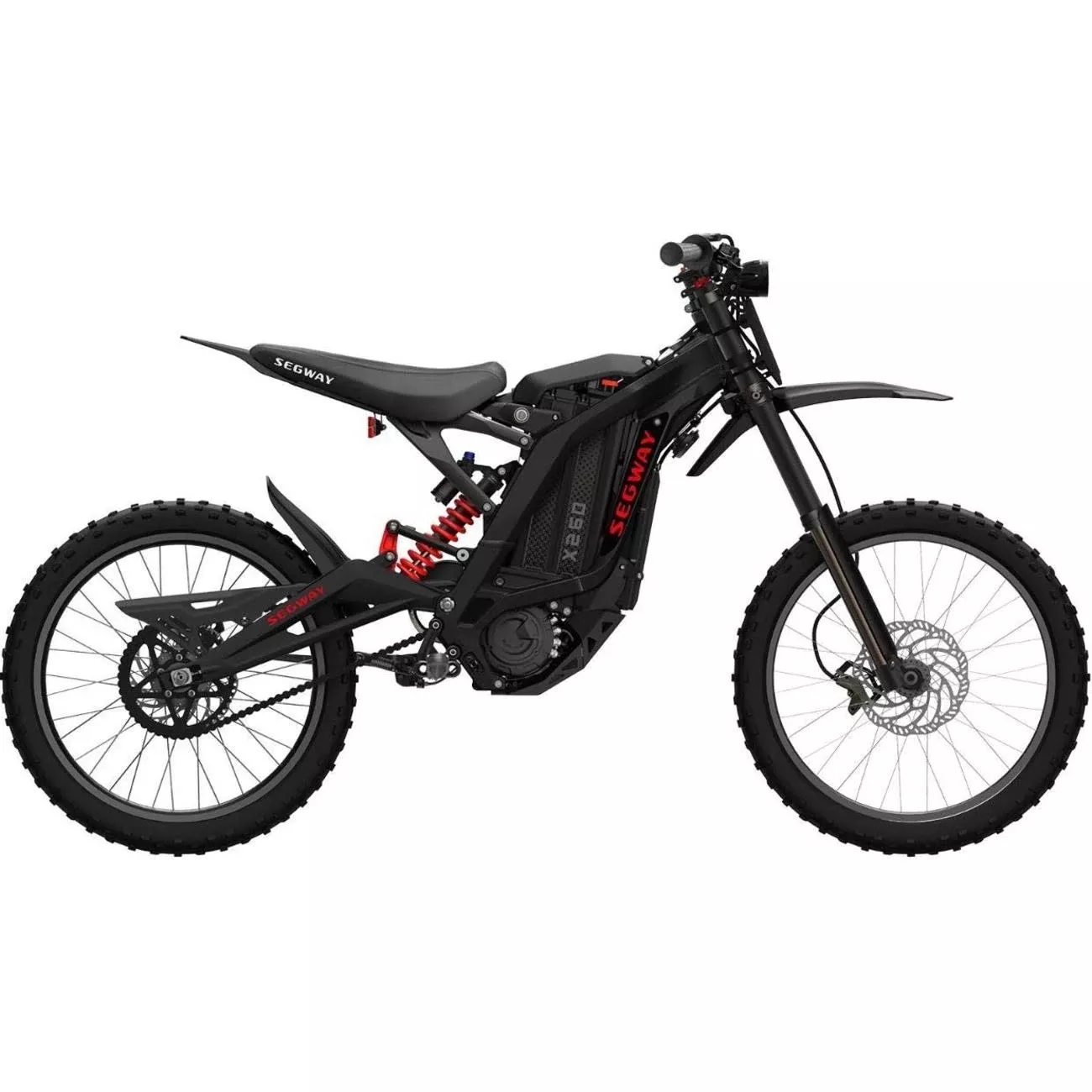
4. Segway X260 Dirt eBike
Feature-rich and highly tunable for all terrain types
- Motor: 5kW
- Battery: 60V 32Ah
- Top Speed: 46.6 mph
- Range: Up to 75 miles
- Weight: 121 lbs
- Best for: Customization lovers, tech-savvy riders
Pros
✅ App integration + ride tracking
✅ Long range
✅ Great all-terrain build
Cons
❌ Smaller frame may not fit tall riders
❌ Slightly underpowered for aggressive hill climbs
Price: ~$4,999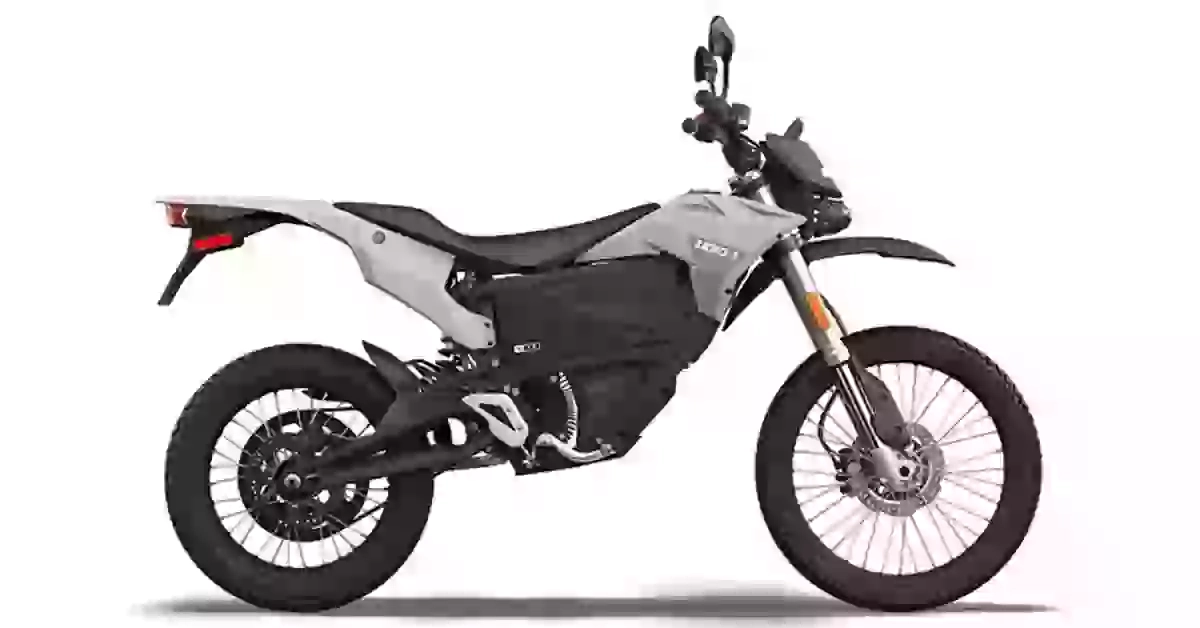
5. Zero FX ZF7.2
High-end e-moto crossover with insane power
- Motor: 34kW
- Battery: 7.2 kWh
- Top Speed: 85 mph
- Range: Up to 91 miles (city), 39 (highway)
- Weight: 289 lbs
- Best for: Dual-sport riders, serious speed enthusiasts
Pros
✅ Fully street legal
✅ Outstanding acceleration
✅ Strong off-road handling
Cons
❌ Very heavy
❌ Expensive (closer to motorcycle pricing)
Price: ~$12,000+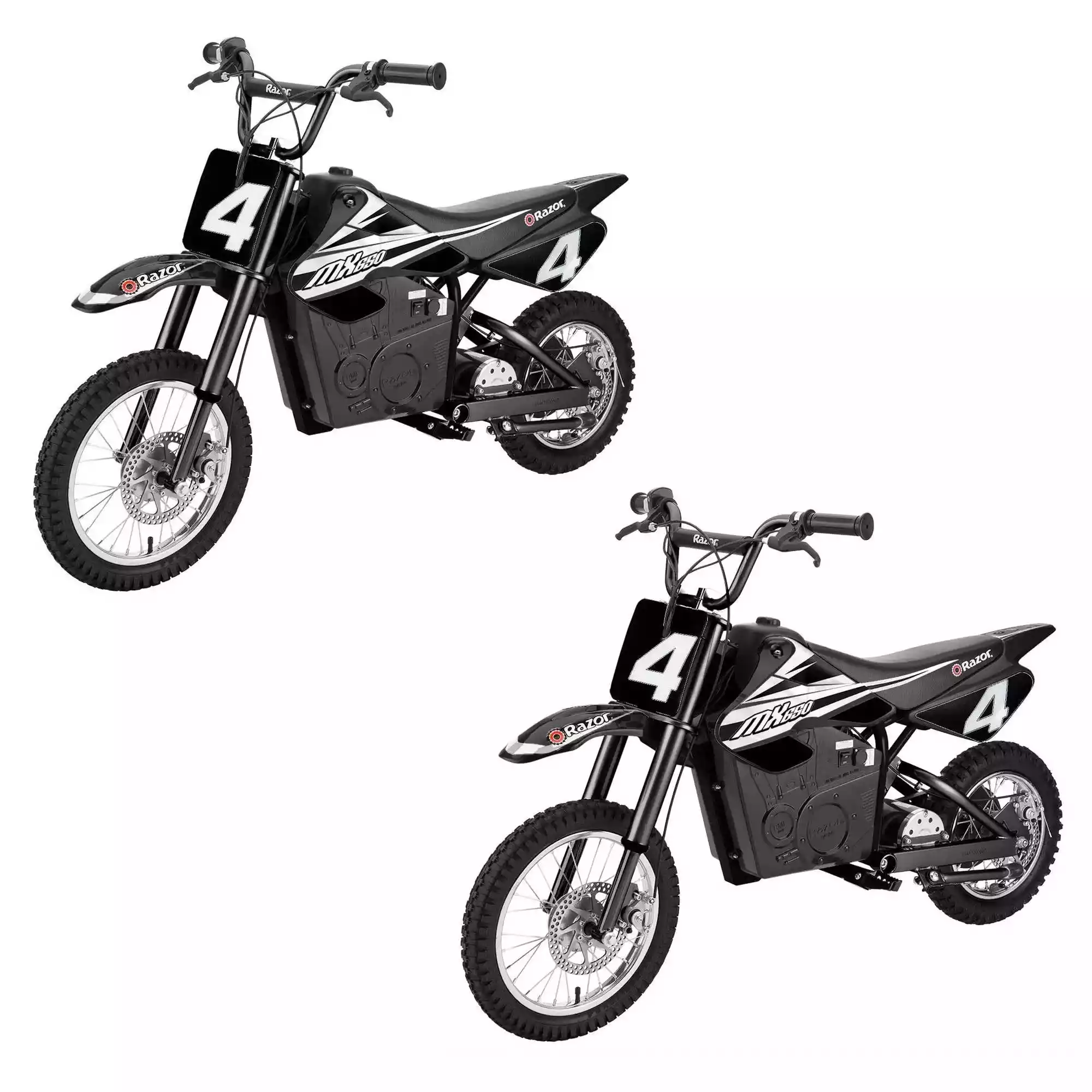
6. Razor MX650
Affordable pick for teens and light trail use
- Motor: 650W
- Battery: 36V
- Top Speed: 17 mph
- Range: 10 miles
- Weight: 98 lbs
- Best for: Kids and young teens
Pros
✅ Low price
✅ Safe for younger riders
✅ Easy to maintain
Cons
❌ Limited range and power
❌ Not suitable for adults or rough trails
Price: ~$700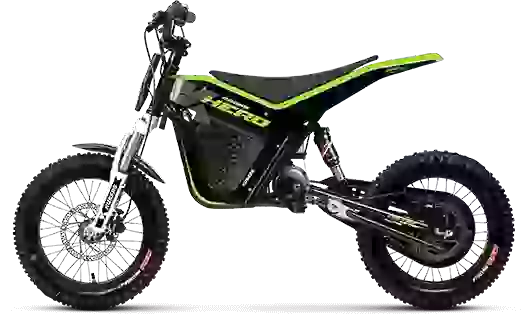
7. Kuberg Cross Hero
Lightweight and agile for youth or beginners
- Motor: 3kW
- Battery: 48V
- Top Speed: 22 mph
- Range: Up to 2 hours of ride time
- Weight: 77 lbs
- Best for: Youth riders, first-time dirt bikers
Pros
✅ Very light and maneuverable
✅ Adjustable seat height
✅ Responsive throttle
Cons
❌ Not for large riders
❌ Modest top speed
Price: ~$2,000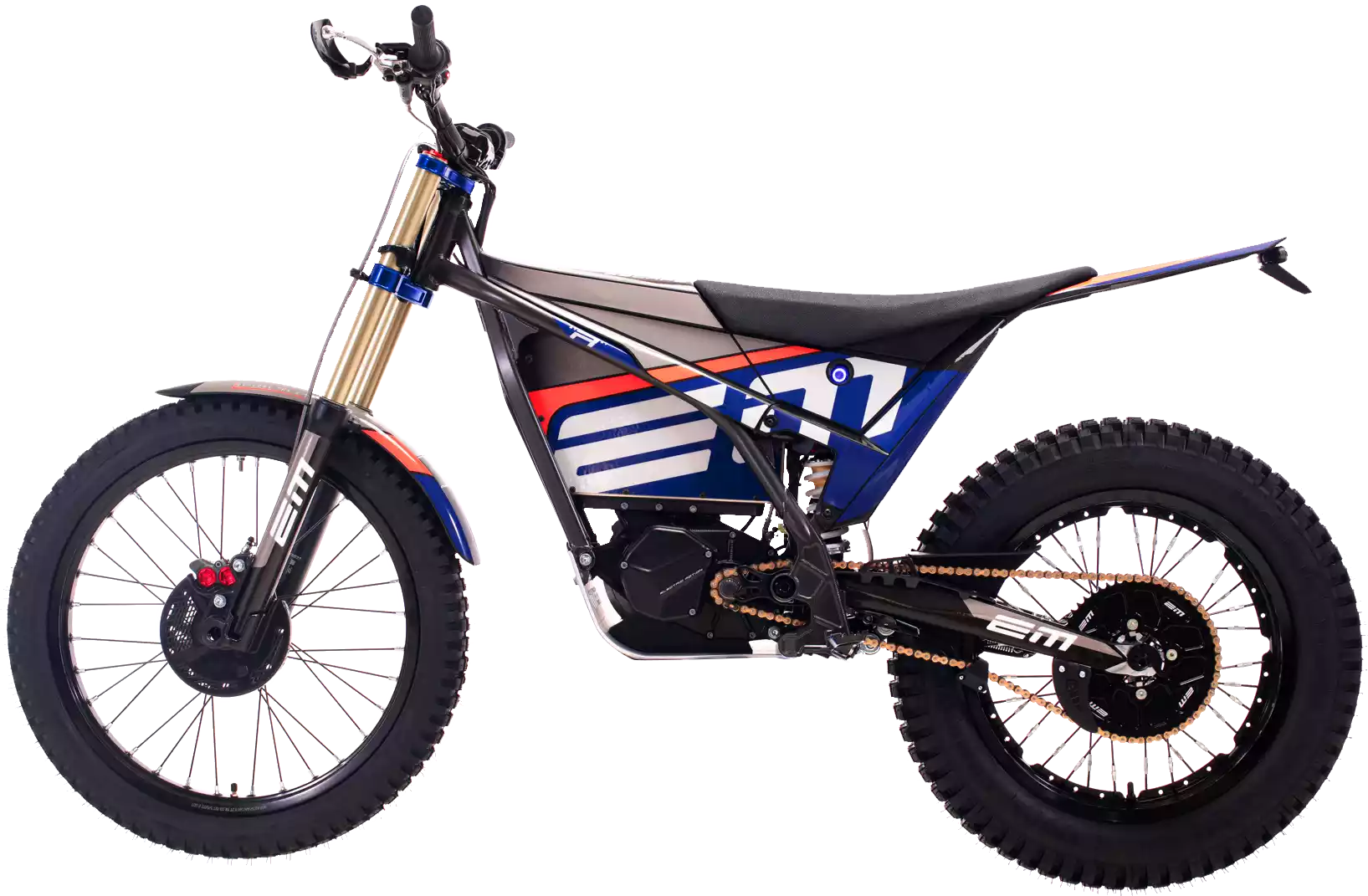
8. Electric Motion Escape R
Excellent for trials-style riding and mountain terrain
- Motor: 11kW
- Battery: 2.6 kWh
- Top Speed: 43 mph
- Range: 38 miles
- Weight: 165 lbs
- Best for: Trials, mountain paths, technical riding
Pros
✅ Built for agility and control
✅ Strong low-end torque
✅ Compact and stable on climbs
Cons
❌ Lower range than others
❌ Not built for speed
Price: ~$8,900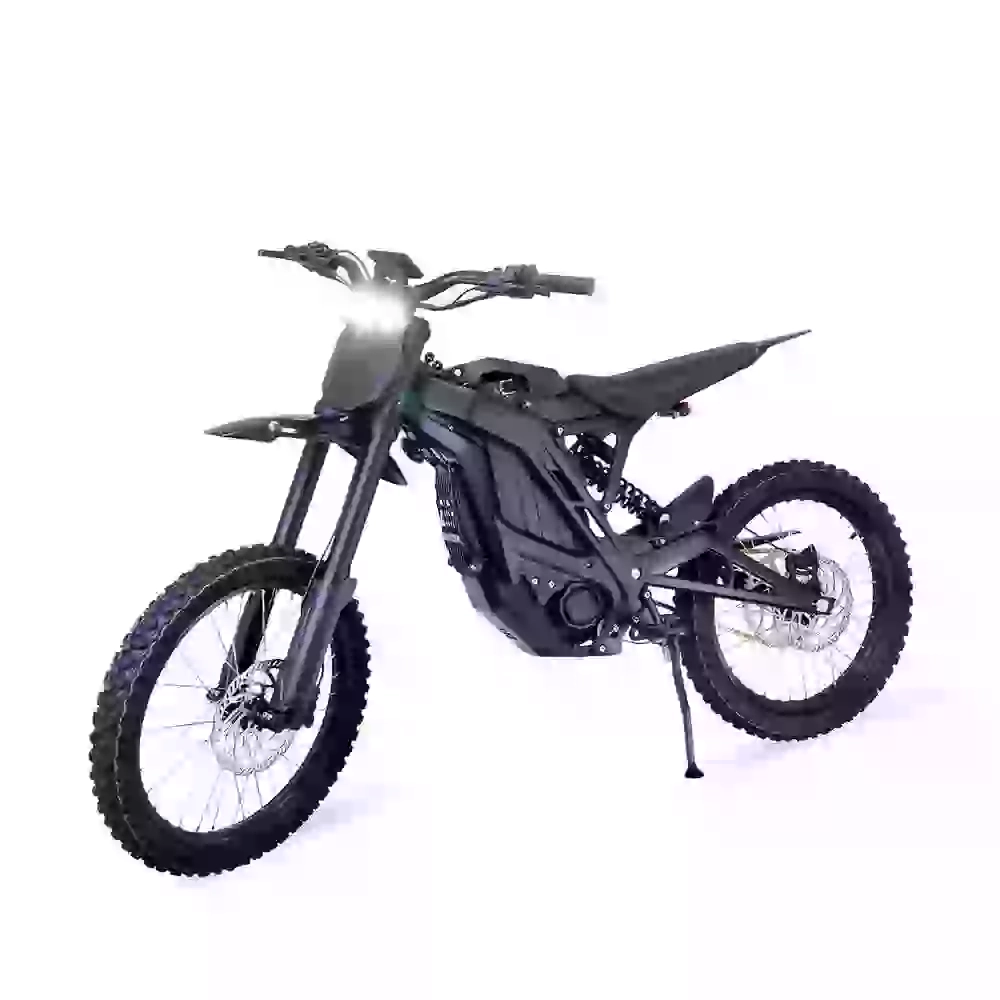
9. E-Ride Pro SS
Budget-friendly performance with trail-ready features
- Motor: 12kW
- Battery: 60V 45Ah
- Top Speed: 50+ mph
- Range: 50+ miles
- Weight: 128 lbs
- Best for: Budget riders, aggressive trail use
Pros
✅ Powerful motor for the price
✅ Modern styling + LED lighting
✅ Comfortable seat + solid suspension
Cons
❌ Limited brand recognition
❌ Smaller service network
Price: ~$3,800
10. Apollo RFN Ares
New contender with serious off-road capability
- Motor: 12kW
- Battery: 60V 43Ah
- Top Speed: 60 mph
- Range: 60 miles
- Weight: 132 lbs
- Best for: Off-road speed junkies, aggressive terrain
Pros
✅ Full-size motocross design
✅ Great performance-to-price ratio
✅ High top speed for trails
Cons
❌ Still establishing a track record
❌ Fewer upgrade/customization options
Price: ~$4,200–$4,600
Ready to ride?
Use this list to find the e-dirt bike that fits your style, speed, and skill level. From lightweight cruisers to full-power beasts, 2025 has something electric for every rider.
Best Electric Dirt Bikes by Rider Type
Not every electric dirt bike is built for the same rider. Whether you're brand new to the trail or a seasoned speed demon, choosing a bike that matches your experience and goals makes a huge difference. This section breaks down the best e-bikes for beginners, teens, pros, and commuters—so you get a ride that fits your style and your skill level.
Best E-Dirt Bikes for Beginners
New to off-road riding? Start with a bike that’s light, forgiving, and easy to handle. These picks offer smooth throttle control, moderate top speeds, and simple controls.
- 🏆 Sur Ron Light Bee X – Great all-around starter with dual ride modes
- 🥈 Talaria Sting R MX4 – A little more power, still manageable for quick learners
- 🥉 Kuberg Cross Hero – Lightweight and super easy to control
Pro Tip:
Look for bikes with Eco modes or adjustable power settings so you can grow into higher speeds over time.
Best Electric Dirt Bikes for Teens & Youth Riders
Safety, size, and speed control are top priorities for young riders. These bikes are designed to be fun without overwhelming new or smaller riders.
- 🏆 Razor MX650 – Affordable and safe with a top speed of 17 mph
- 🥈 Kuberg Cross Hero – Rugged build with adjustable fit for growing teens
- 🥉 Segway X160 (not X260) – Lighter and slightly smaller, ideal for young riders with experience
Quick Note:
Always check height and weight recommendations—many “youth” bikes are ideal for ages 13+ only.
Best Electric Dirt Bikes for Adults & Pros
If you’re looking for maximum power, speed, and serious off-road capabilities, these are the high-performance models to consider. Great for riders with motocross experience or a need for adrenaline.
- 🏆 Cake Kalk INK – Precision-built for trail racing and technical terrain
- 🥈 Zero FX ZF7.2 – Dual-sport beast with 85 mph top speed
- 🥉 Electric Motion Escape R – Trials-ready with advanced torque and traction control
Pro Tip:
Advanced bikes often require more weight control and throttle finesse. Ride modes help, but experience counts.
Best E-Dirt Bikes for Commuters & Mixed-Use Riders
Want one bike for work and the weekend? These dual-sport options are road-legal, comfortable on pavement, and still handle dirt like a champ.
- 🏆 Zero FX ZF7.2 – Built for both city and trail
- 🥈 Segway X260 – Smart tech meets versatile off-road handling
- 🥉 Apollo RFN Ares – Durable enough for commuting, fast enough for trail days
Callout:
Look for features like lights, mirrors, and street-legal status if you plan to ride on public roads.
Quick Summary
Choosing by rider type can save you money, increase safety, and help you enjoy your bike way more. Here’s your shortcut:
- Beginner? Start with the Sur Ron or Kuberg
- Teen? Razor MX650 is your safe bet
- Experienced? Go wild with the Kalk INK or Zero FX
- Mixed-use? Segway X260 gets the job done on both street and trail
Still not sure?
Keep reading for our buying tips and final checklist—or scroll back to the top 10 list to explore your favorites.
Meta Description: Keep your electric dirt bike running like a dream and stay safe while riding. Learn key maintenance steps, safety gear essentials, and legal tips in this e-bike guide.
E-Dirt Bike Maintenance & Safety Tips
So you’ve got the power and performance—now let’s make sure your electric dirt bike stays in top shape and keeps you safe on every ride. Whether you’re hitting trails or testing your limits on tough terrain, proper care and smart safety habits make all the difference.
In this quick guide, you’ll learn how to maintain your e-bike’s performance, what safety gear is non-negotiable, and a few legal basics every rider should know.
Battery Care: Power That Lasts
Your e-dirt bike’s battery is its heart—and treating it right will keep you riding longer and charging less.
- Charge after every ride but avoid leaving it plugged in overnight.
- Store your bike in a cool, dry place to protect the battery from heat damage.
- If you’re not riding for a while, keep the charge at 40–60% to prevent battery wear.
Pro Tip: Avoid draining your battery to 0%. Keeping it above 20% extends its life dramatically.
Tires, Brakes & Suspension: Trail-Ready Every Time
Before every ride, give your bike a quick check. It only takes a minute and could save you from a nasty crash or breakdown.
- Tires: Look for wear, punctures, and keep them inflated to the recommended PSI.
- Brakes: Squeeze the levers—if they feel loose or weak, check pads or get them tuned up.
- Suspension: Make sure it’s properly adjusted for your weight and riding style. Smooth travel = better control.
Essential Safety Gear: Ride Smart, Ride Protected
Electric dirt bikes are fast, fun, and powerful—which means your gear needs to match the ride.
Here’s what every rider should wear:
- Full-face helmet for maximum head and face protection
- Body armor or chest protectors to absorb impacts
- Durable gloves for grip and crash protection
- MX boots or reinforced riding boots to protect your ankles and shins
Pro Tip: Even on short rides, gear up. Most accidents happen close to home or on familiar trails.
Know the Law: Where Can You Ride?
E-dirt bikes blur the lines between pedal-powered bikes and motorcycles. Depending on where you live, rules vary.
- Off-road only models usually can’t be ridden on public roads.
- Some dual-sport electric dirt bikes are street-legal, but need mirrors, lights, and registration.
- Always check local e-bike laws before riding—especially in parks, forests, or city limits.
Staying legal isn’t just about avoiding fines—it’s about keeping trails open for everyone.
Keep Your Ride Safe & Smooth
Keeping your e-dirt bike in top shape and gearing up properly means more confidence, better rides, and fewer surprises on the trail.
Stay ahead of the curve with regular maintenance, the right safety gear, and a little legal know-how—and you’ll be set for every adventure ahead.
Ready to ride? Check out our full electric dirt bike buying guide and discover the best models for your style and skill level.
Meta Description: Discover the best electric dirt bikes by category and learn why switching to e-power is the future of off-road riding. See our top picks and tips for choosing the perfect ride.
Final Thoughts: Find the E-Dirt Bike That Fits You
Still deciding which electric dirt bike is right for you? Let’s wrap it all up with a quick recap to help you ride off with confidence.
Top Picks by Category
We’ve covered the best e-dirt bikes across every rider type—whether you’re just starting out or looking for high-performance thrills.
- Best for Beginners: Easy-to-control models with smooth power delivery
- Top Picks for Teens & Youth Riders: Lightweight, speed-limited options with strong safety features
- For Adults & Pros: Power-packed bikes with premium suspension and longer range
- Best for Commuters or Dual Use: Street-legal e-bikes that handle dirt and pavement
Looking for a more detailed breakdown? Our full e-bike buying guide walks through what to look for based on price, terrain, and riding goals.
Why Go Electric for Dirt Riding?
The benefits of switching to an electric dirt bike are hard to ignore:
- Instant torque means quicker takeoffs and better control on hills
- Low maintenance with no oil changes or engine rebuilds
- Quiet motors = no engine noise, more trail access, and less disruption
- Eco-friendly riding with zero emissions
It’s not just the future of dirt biking—it’s the smarter, more fun way to ride now.
Try Before You Buy
Every rider has a different feel for what makes a bike click. That’s why test rides are key.
- Visit local dealers or demo events
- Pay attention to fit, comfort, and how the power kicks in
- Match your bike to the terrain you’ll ride most—tight trails, open fields, or street-to-dirt transitions
Pro Tip: A bike that’s “best on paper” isn’t always the best for you. Go with what feels right when you ride.
Ride Electric, Ride Better
Choosing the best electric dirt bike for your style is easier when you know what to look for. Whether you want speed, comfort, or versatility, the e-bike world is full of exciting options—and growing fast.
Ready to ride? Dive into our latest 2025 electric bike reviews and find the perfect e-dirt bike to power your next adventure.
Meta Description: Explore bonus tools and tips to choose the best electric dirt bike for your needs. Includes comparisons, riding guides, and where to test-ride near you.
Additional Resources to Supercharge Your Search
Want to go even deeper before choosing your ride? Whether you're comparing specs or getting ready to hit the dirt, these extra tools and links will help you make the most informed—and confident—e-bike decision.
Quick Bike Comparison Chart
Skip the back-and-forth between tabs. We’ve compiled a side-by-side chart of the top 10 electric dirt bikes covered in this guide.
- See specs like motor power, top speed, range, and price
- Easily filter by rider level, terrain type, or legal use
- Great for narrowing down your shortlist
Pro Tip: Focus on torque (not just top speed) if you’re planning to ride uphill or on tight trails.
Brand Websites & Reviews
Want a second (or third) opinion? These links will help you check reviews and get direct info from the source.
- Official brand pages for detailed specs and warranty info
- Expert video reviews for real-world performance insights
- Customer reviews to learn what long-term owners love (or don’t)
Look out for review terms like throttle response, battery life under load, and handling on technical terrain—these give better insights than generic star ratings.
Beginner’s Guide to Off-Road Riding
New to dirt riding? No sweat. Our free off-road technique guide covers:
- Body positioning for stability on bumps and turns
- How to climb hills and descend safely
- Tips for managing traction on loose surfaces
It’s a quick, confidence-boosting read that’ll help you ride smarter from day one.
Where to Test-Ride or Buy Near You
Not sure if the bike fits you just right? Test rides are game-changers.
- Use our dealer locator tool to find nearby shops
- Check if brands offer demo days or trail events
- Ask dealers about return policies or try-before-you-buy options
Trying a bike out can answer more questions in 10 minutes than hours of research online.
Need help narrowing it down? Head back to our full electric dirt bike buying guide or browse the latest 2025 e-bike reviews to compare what’s best for your terrain, skill level, and budget.
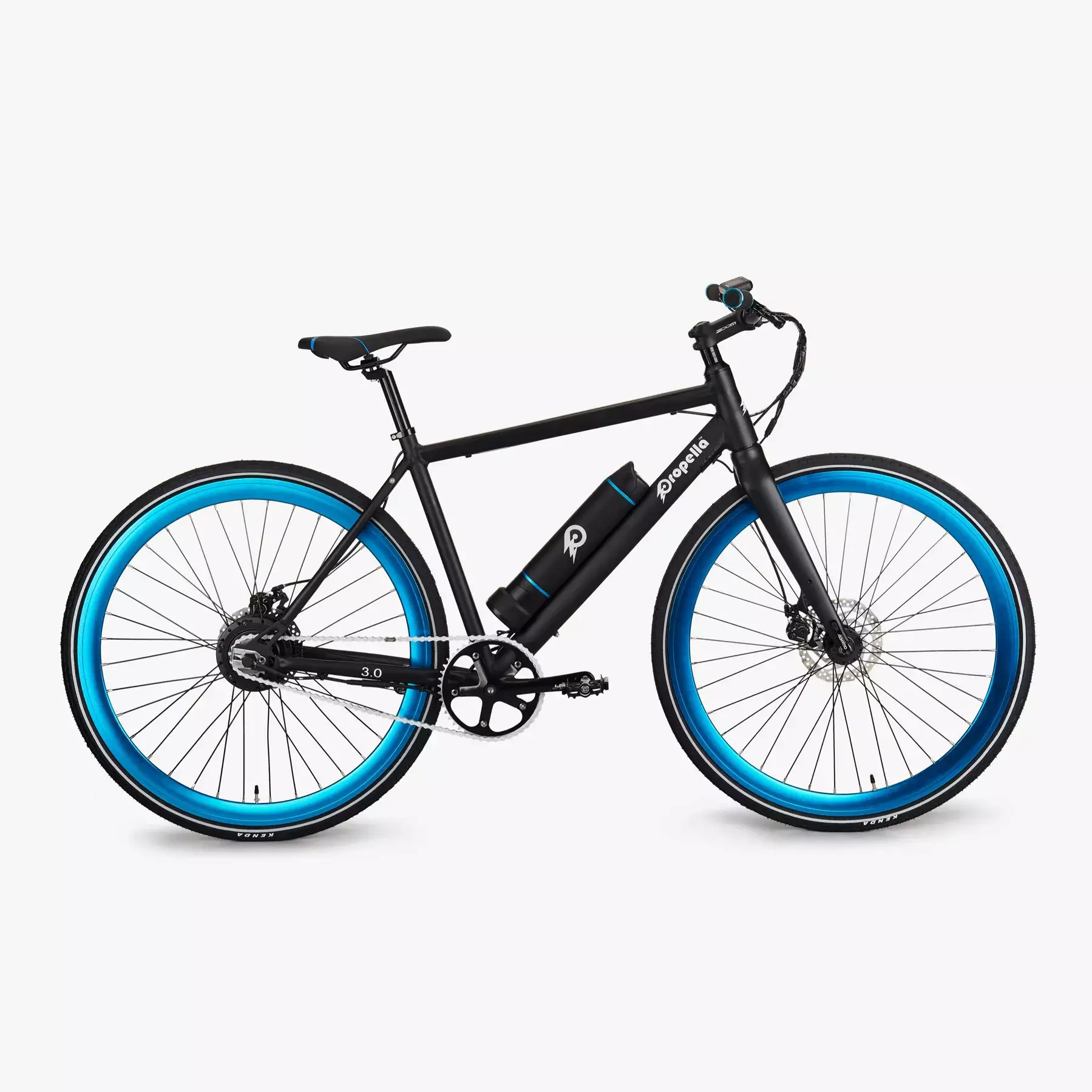
Rush hour doesn’t have to mean stress and gridlock. If you're looking for a faster, greener, and more fun way to get around the city, an e-bike might just be your new best friend.
From weaving through traffic to folding neatly under your desk, today’s commuter e-bikes are built for real-world city living—and they’ve never been better.
In this guide, you’ll learn how to choose the best e-bike for urban commuting, plus see our top picks for lightweight, foldable, and traffic-ready models in 2025.
What Makes a Great City Commuter E-Bike?
Not all electric bikes are created equal—especially when you’re riding through busy downtown streets or hopping on public transit.
Here’s what to look for in the best e-bikes for city commuters:
- Lightweight frames – Easier to carry up stairs or onto a train
- Foldable design – Ideal for small apartments and office storage
- Strong battery & range – Enough juice to cover your daily commute and then some
- Responsive brakes & handling – Crucial for stop-and-go traffic
- Built-in lights & fenders – Stay visible and clean, rain or shine
Pro Tip: Look for bikes with removable batteries if you plan to charge at the office or don’t have garage access.
Best Lightweight E-Bikes for Effortless City Travel
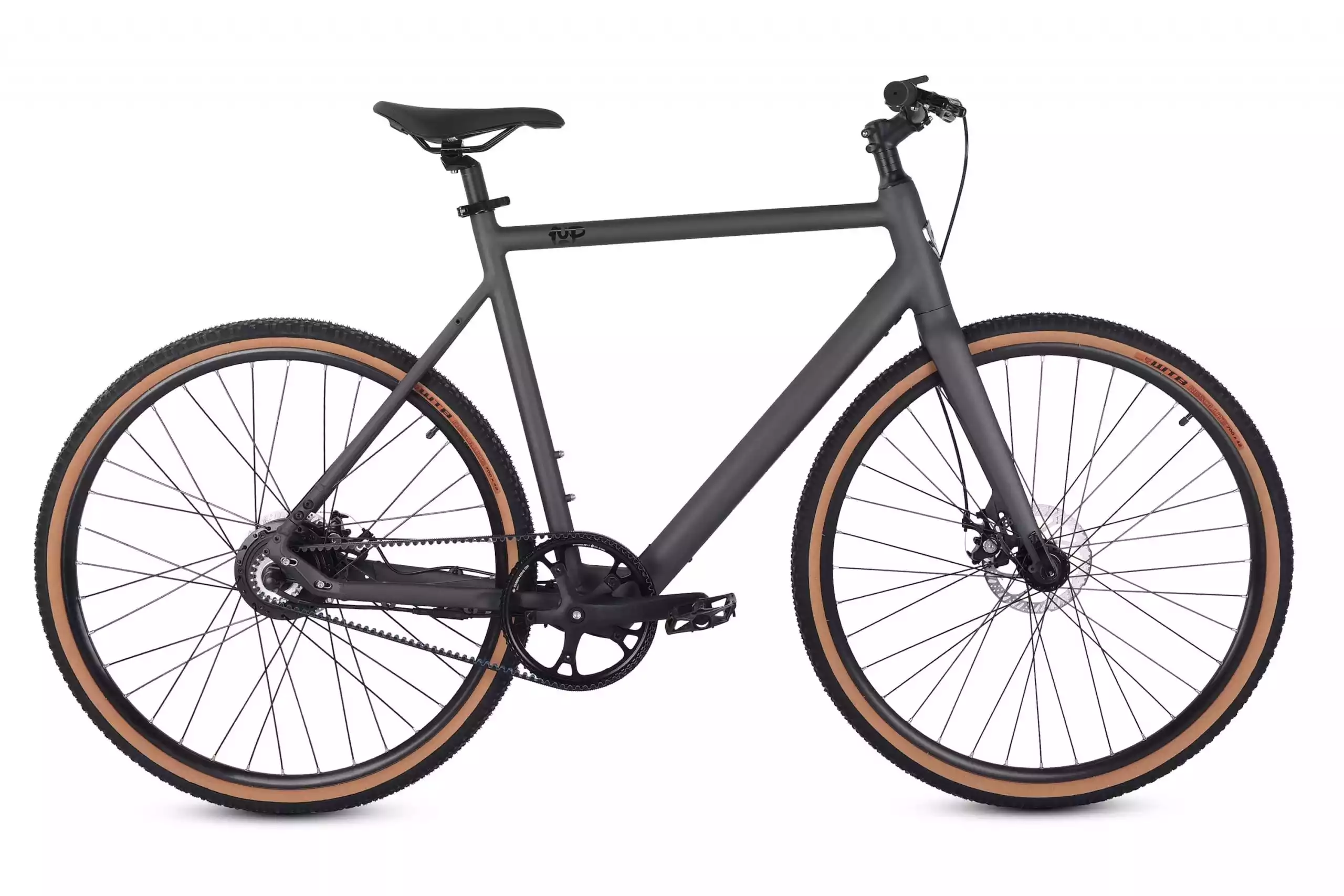
1. Ride1UP Roadster V2
- Weight: 33 lbs
- Range: Up to 30 miles
- Why it's great: Ultra-slim design and clean belt drive for a quiet, low-maintenance ride. Perfect for short daily commutes.

2. Propella 7S
- Weight: 37 lbs
- Range: 20–40 miles
- Why it's great: Sleek, minimal design with responsive pedal assist. Easy to carry and perfect for urban hills.
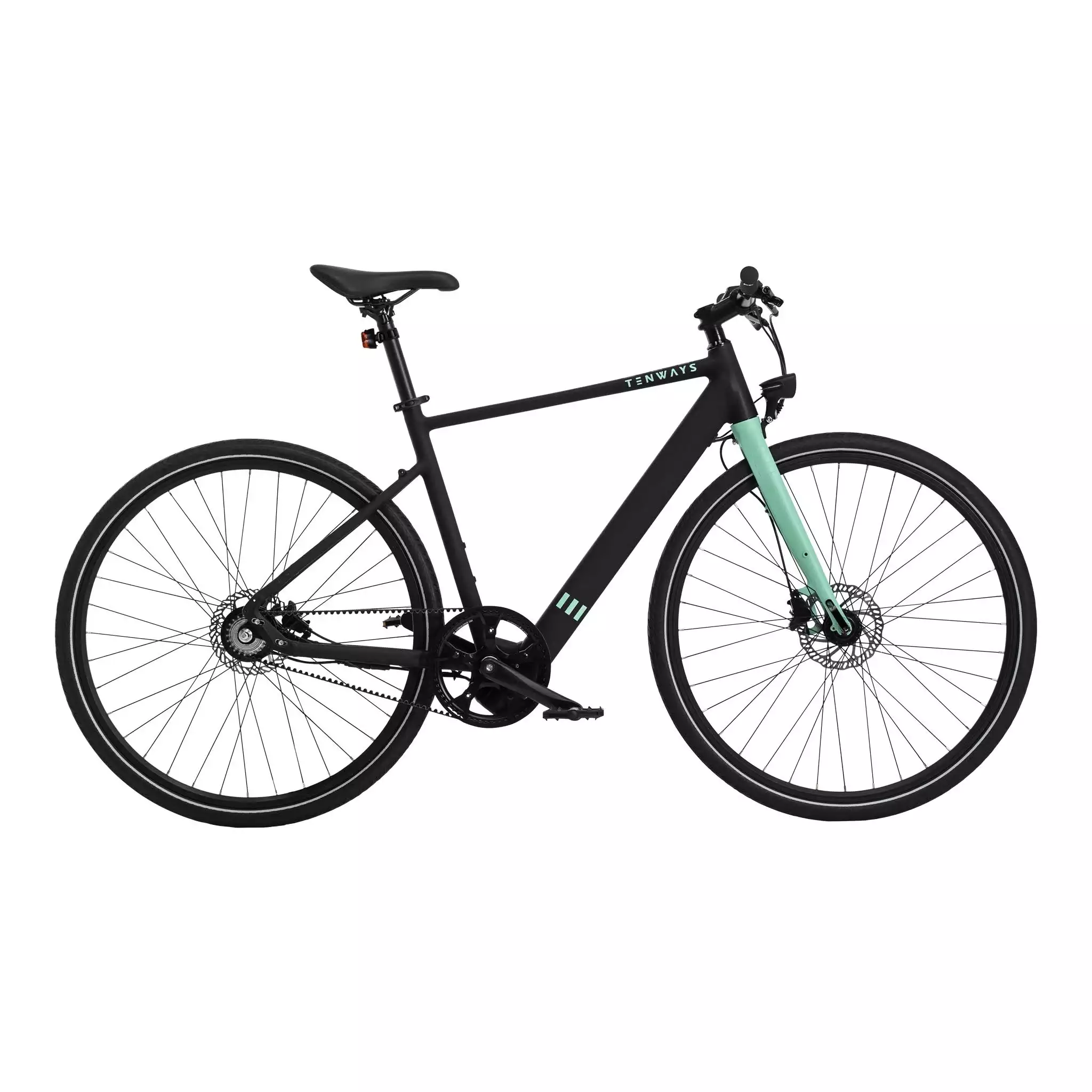
3. Tenways CGO600
- Weight: 34 lbs
- Range: Up to 45 miles
- Why it's great: Smooth torque sensor and internal cabling keep it tidy and modern for city rides.
Best Foldable E-Bikes for Urban Life on the Go
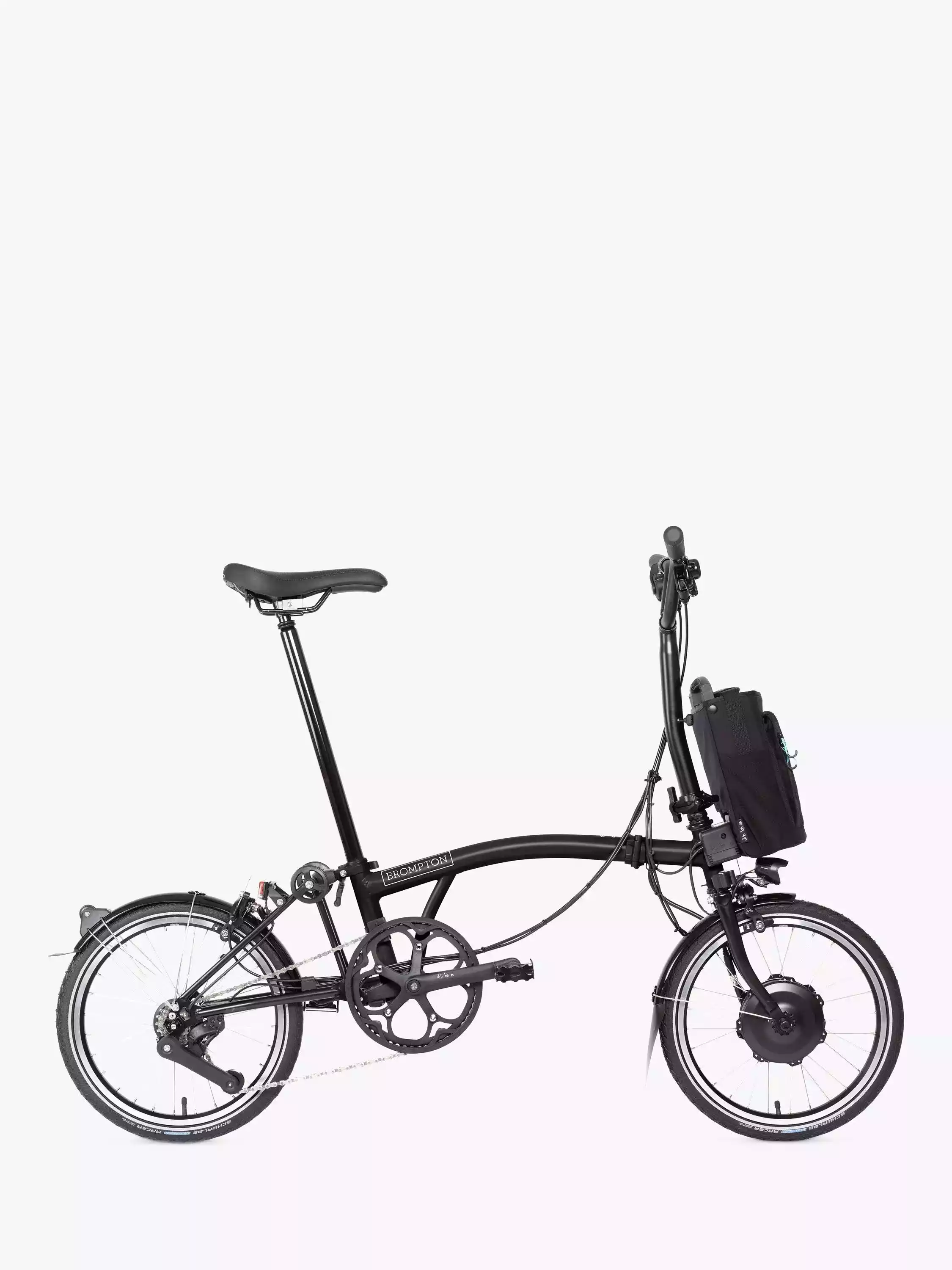
1. Brompton Electric C Line
- Fold Time: 20 seconds
- Range: 20–45 miles
- Why it's great: Legendary foldability and compact size, paired with a reliable electric boost.
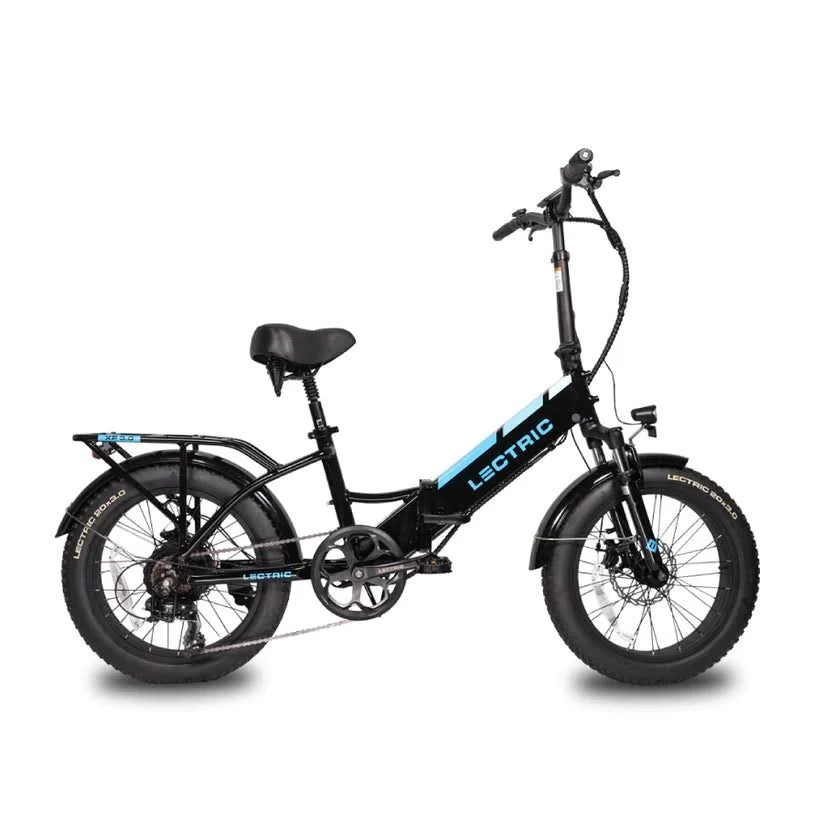
2. Lectric XP 3.0
- Fold Size: 37 x 18 x 28 inches
- Range: 45–65 miles
- Why it's great: Rugged yet compact with fat tires for stability and an unbeatable price point.
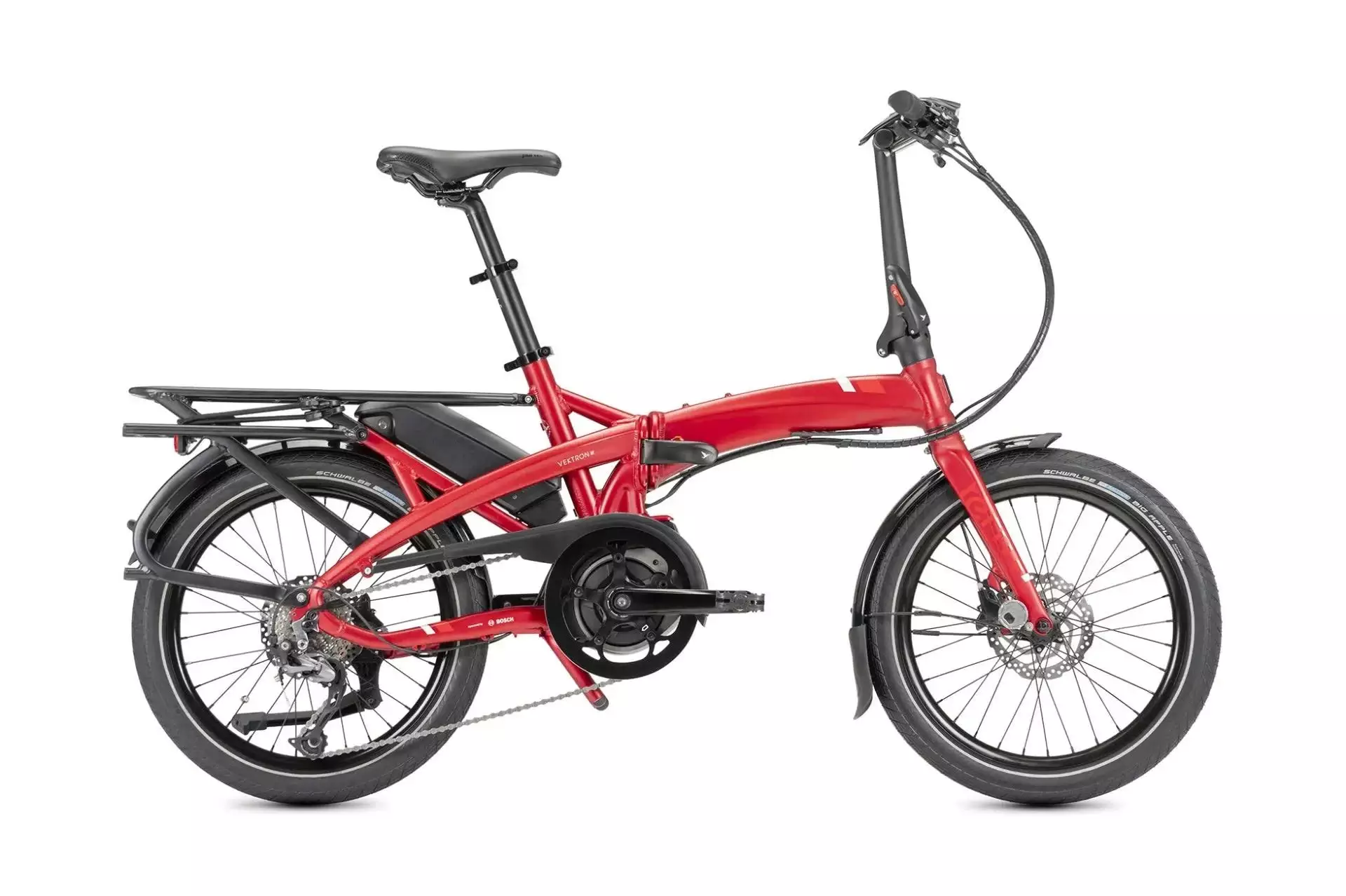
3. Tern Vektron Q9
- Fold Time: 10 seconds
- Range: 25–50 miles
- Why it's great: Premium folding bike with top-tier components and a Bosch motor for serious performance.
Pro Tip: If you plan to mix bike + train travel, check folded dimensions to make sure it fits transit rules.
Traffic-Ready Features That Matter in the City
In a city setting, safety and control are everything. Here’s what sets a true commuter e-bike apart:
- Hydraulic disc brakes – For confident stopping power
- Integrated front and rear lights – No forgetting to clip them on
- Puncture-resistant tires – Say goodbye to mid-commute flats
- Upright geometry – Keeps you visible and comfortable
Want a smooth ride on potholes and curbs? Look for bikes with suspension forks or wider tires for extra cushion.
Final Thoughts: Ready to Commute Smarter?
Whether you need something foldable for your train ride, or lightweight enough to carry into your walk
What Makes an E-Bike Perfect for City Commuting?
When you're weaving through traffic, hopping on public transit, or parking in tight spaces, not just any e-bike will do. City commuters need bikes built for real-world urban life—light, compact, and smartly equipped. Here's what to look for when choosing the best e-bike for city commuting.
Lightweight Design: Why It Matters
Nobody wants to lug a heavy bike up stairs or into a train. A lightweight e-bike makes city commuting more manageable, especially if you live in a walk-up or combine biking with other transportation.
Benefits of a lightweight build:
- Easier to carry up stairs or onto buses
- Faster acceleration and more responsive handling
- Simpler storage in apartments or office spaces
Most commuter e-bikes are made from aluminum or carbon fiber, which strike a solid balance between strength and lightness. Aim for models under 50 lbs if portability is a priority.
Pro Tip: Check the total weight including battery and accessories—not just the frame alone.
Foldability: Your Space-Saving Secret Weapon
If you’re tight on space or ride part of your commute on a train or bus, a foldable e-bike is a game changer. These bikes are designed to collapse quickly into a compact form, making them perfect for commuters in small apartments or shared workplaces.
Key folding features to consider:
- One-step or magnetic folding systems (faster and easier to use)
- Folded dimensions to ensure they fit under your desk or in a closet
- Secure locking mechanisms so they stay compact during transport
Models like the Brompton Electric or Gocycle G4 are popular examples of premium folding options in the 2025 electric bike market.
Pro Tip: Measure your trunk or entryway before buying—some “folding” e-bikes still take up more space than expected.
Traffic-Ready Features for Urban Survival
Riding in a city means dealing with cars, pedestrians, potholes, and stoplights. A great commuter e-bike should be ready for all of it—especially during rush hour.
Look for these traffic-ready features:
- Integrated front and rear lights for visibility at dawn, dusk, and in tunnels
- Reflectors and brake lights for added safety
- Full fenders to stay clean in wet conditions
- Responsive hydraulic or mechanical disc brakes for reliable stopping power
- Nimble handling to navigate tight corners and unexpected obstacles
Some models even include horns, turn signals, or automatic brake lights, which make a big difference in high-traffic zones.
Ready to Ride?
If you’re serious about stress-free commuting, choosing an e-bike with a lightweight frame, foldable design, and built-in safety features is a smart investment. These aren’t just nice-to-haves—they’re essentials for surviving (and thriving) in the city.
Next up: We’ll show you top-rated city e-bikes for 2025 that combine all these features in one sleek, ride-ready package.
Top Lightweight E-Bikes for City Commuters
If you're tired of lugging a bulky bike through stairwells or squeezing it onto public transit, you're not alone. Commuters everywhere are ditching heavy, cumbersome rides in favor of lightweight e-bikes that deliver agility, speed, and serious urban versatility. Below, we’ve rounded up five standout models in the 2025 electric bike review cycle—each with just the right mix of weight, range, and power for navigating the city with ease.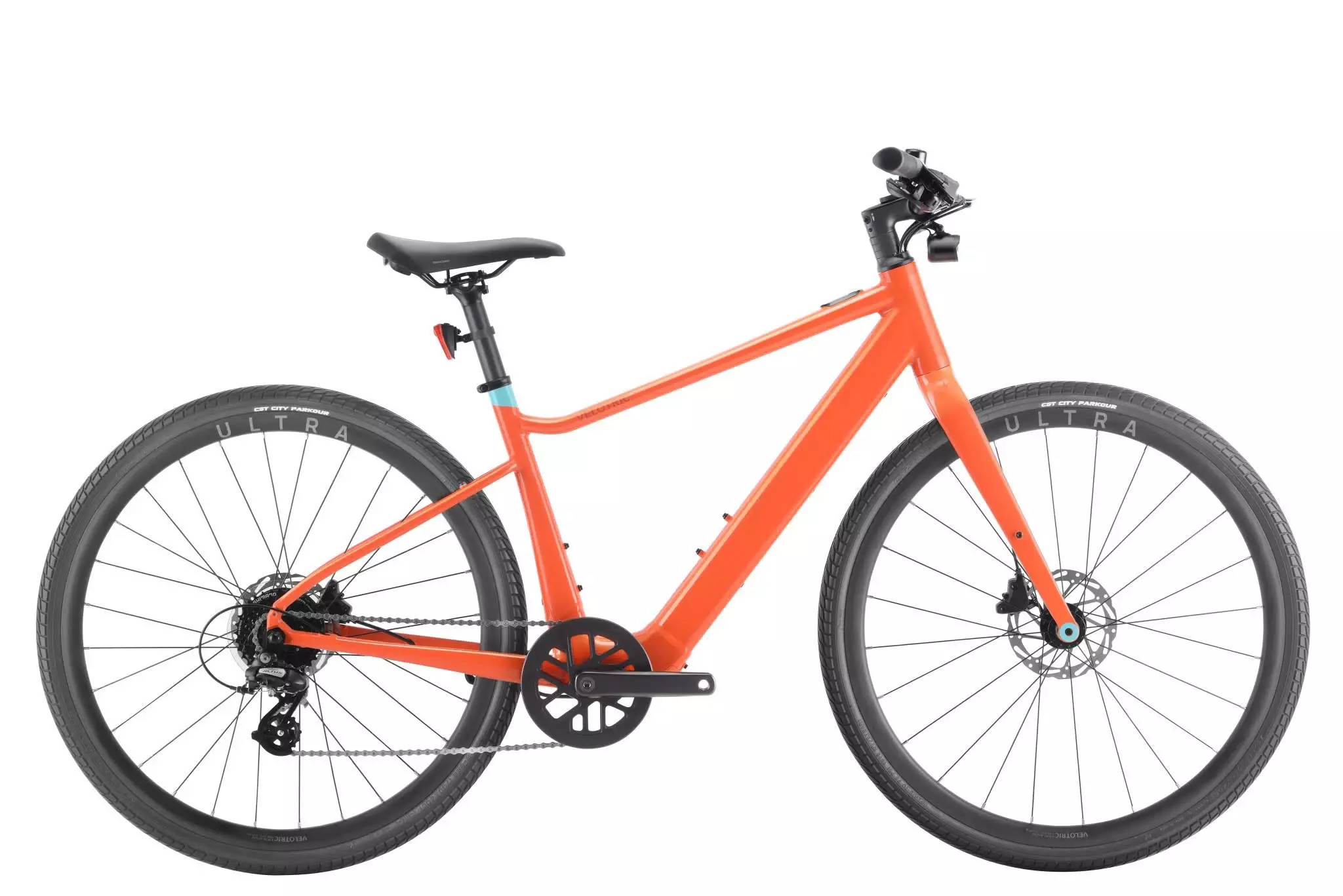
Velotric T1 ST Plus
- Weight: 39 lbs
- Motor: 350W rear hub (peaks at 600W)
- Range: Up to 70 miles (Eco Mode)
This commuter-friendly bike checks all the boxes: compact, clean design, a responsive torque sensor, and excellent real-world range. It’s light enough for stair carries, yet powerful enough to breeze through flat-to-moderate terrain.
Pros:
- Excellent battery life
- Smooth torque-sensing pedal assist
- Comfortable geometry and adjustable fit
Cons:
- Not ideal for steep hills
- Slightly heavier than carbon-frame models
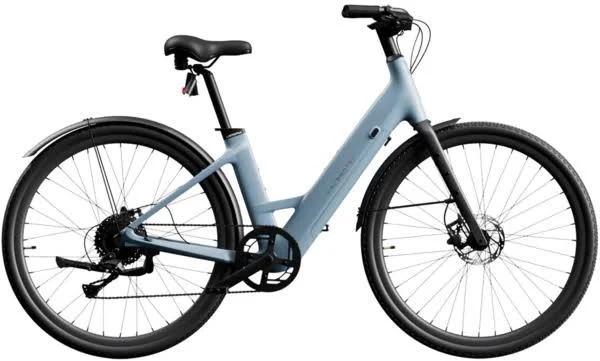
Urtopia Carbon 1 Step-Thru
- Weight: 36 lbs
- Motor: 350W rear hub (peaks at 750W)
- Range: Up to 80 miles
With a full carbon fiber frame, this is one of the lightest and sleekest e-bikes you’ll find. It’s also packed with commuter tech: turn signals, GPS tracking, and voice control. The ride is impressively smooth, especially with the four pedal assist levels.
Pros:
- Ultra-light carbon build
- Long range with fast charging
- Smart features and hydraulic brakes
Cons:
- Premium price
- Slightly lower max rider weight
Pro Tip: If you want the latest smart features and lightweight portability, this one’s hard to beat.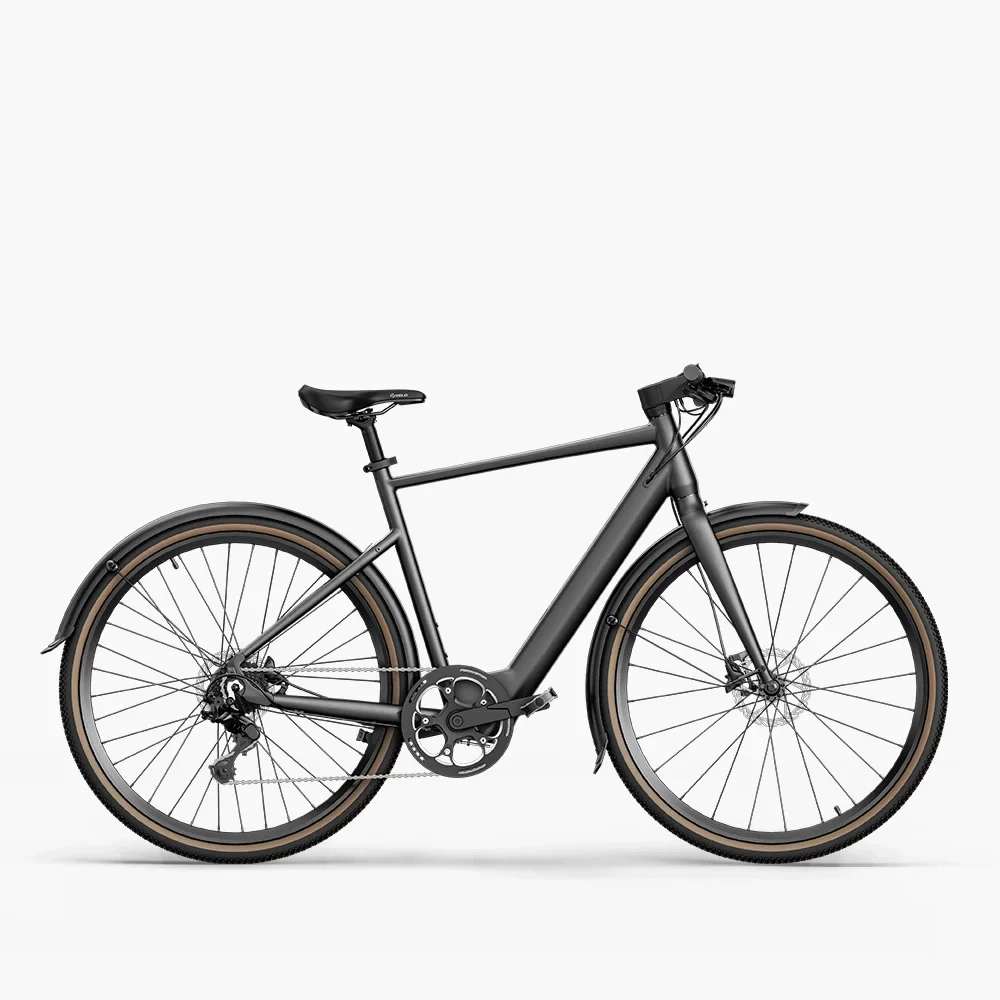
Fiido C21 Electric Road Bike
- Weight: 38.5 lbs
- Motor: Approx. 250–350W (varies by region)
- Range: ~50 miles (est.)
Sleek, sporty, and versatile—this model combines urban commuter style with gravel-friendly geometry. A built-in torque sensor and smooth LCD display make it approachable for new e-bike users, while still offering solid performance for regular city riders.
Pros:
- Stylish frame and compact battery
- Adaptable for road and light gravel
- Very commuter-friendly geometry
Cons:
- Specs vary by seller—check carefully
- Not ideal for hilly cities
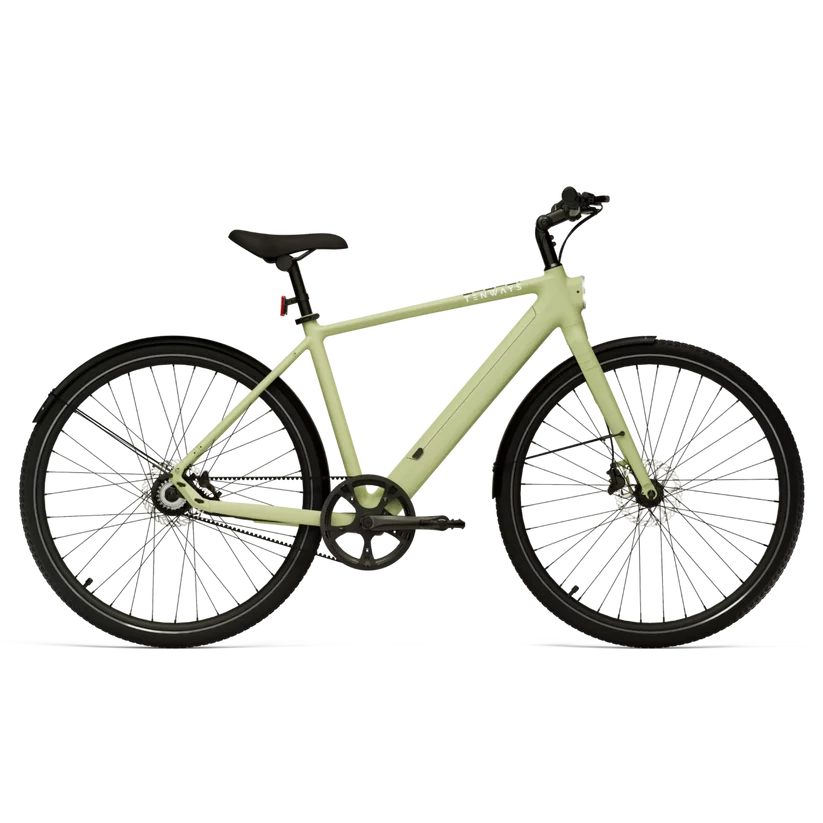
Tenways CGO600 Pro
- Weight: 37 lbs
- Motor: 350W rear hub
- Range: Up to 53 miles
This low-maintenance e-bike is beloved for its silent operation and sporty city ride feel. The belt drive, torque sensor, and clean design make it one of the best e-bikes for professionals who want something reliable, clean, and low-fuss.
Pros:
- Quiet belt drive
- Integrated lights and display
- Natural-feeling assist
Cons:
- Limited power for steeper terrain
- No throttle (Class 1 only)
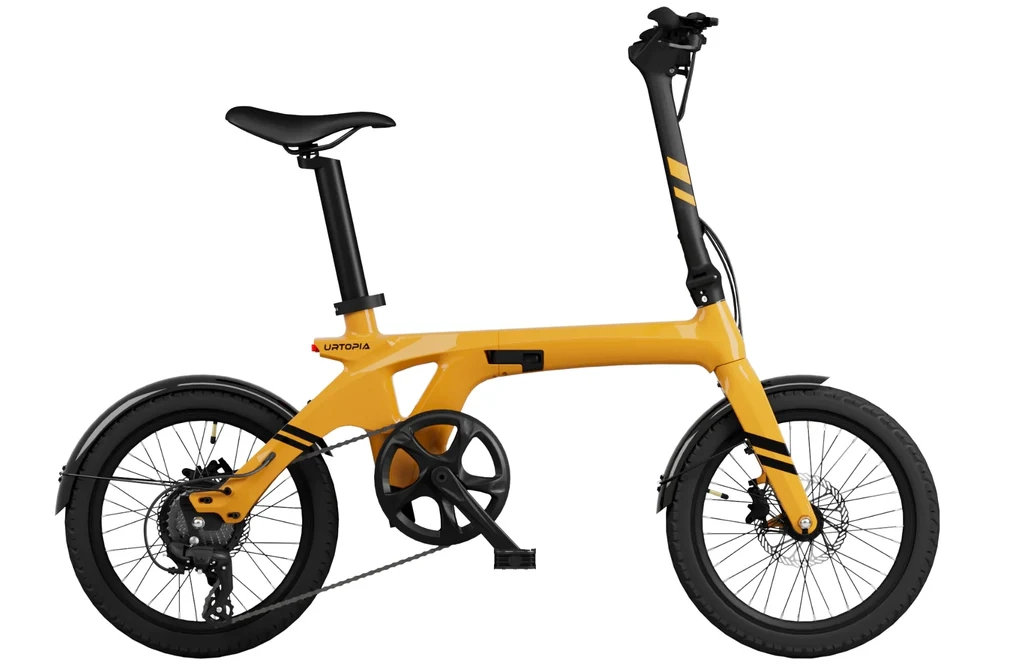
ADO Air Carbon
- Weight: 27.5 lbs
- Motor: 250W rear hub, 65Nm torque
- Range: Up to 62 miles
For ultra-portability, the ADO Air Carbon is the lightest option here. The folding carbon frame makes it a dream for apartment dwellers and transit riders. Don’t let the smaller motor fool you—it still delivers snappy acceleration in city conditions.
Pros:
- Feather-light and foldable
- Excellent torque for its size
- Ideal for last-mile and mixed-mode commuting
Cons:
- Smaller battery than others on this list
- Not ideal for larger riders or long, fast rides
✅ Summary: Which One Is Right for You?
| Model | Weight | Range | Best For |
|---|---|---|---|
| Velotric T1 ST Plus | 39 lbs | 70 miles | Long rides, smooth performance |
| Urtopia Carbon 1 | 36 lbs | 80 miles | Smart tech & high-end commuting |
| Fiido C21 | 38.5 lbs | ~50 miles | Stylish & versatile commuting |
| Tenways CGO600 Pro | 37 lbs | 53 miles | Low-maintenance city rides |
| ADO Air Carbon | 27.5 lbs | 62 miles | Ultra-light & portable commuting |
🚦 Final Thoughts
Choosing the best lightweight e-bike for city commuting depends on your daily route, whether you’ll be carrying your bike often, and how much smart tech you want onboard. Whether you're a casual rider or a dedicated commuter, there’s a model above that can make your mornings faster—and way more fun.
Ready to ride? Check out test rides at local dealers or trusted online retailers to find your perfect match.
Meta Description:
Looking for the best foldable e-bikes in 2025? Discover top picks for urban commuting with compact design, great range, and efficient motors in this foldable e-bike buying guide.
🚲 Best Foldable E-Bikes for Urban Mobility (2025)
Living in the city and short on space? Foldable e-bikes are a brilliant solution for urban commuters who need portability without sacrificing performance. Whether you're navigating tight hallways, hopping on transit, or storing your bike under a desk, these compact electric bikes bring flexibility to your everyday ride.
In this e-bike buying guide, we highlight five of the best foldable e-bikes of 2025 based on ease of folding, portability, battery range, and motor efficiency.
📊 Quick Look: Top Foldable E-Bike Comparison
| Model | Weight | Folded Size | Battery Range | Motor Power | Portability & Highlights |
|---|---|---|---|---|---|
| ADO Air Carbon | 27.5 lbs | Medium | Up to 62 mi | 250–350W | Ultra-light carbon frame, smooth torque assist |
| Engwe P20 | 41 lbs | Compact | Up to 62 mi | 250–350W | Folds in 10 sec, belt drive, torque sensor |
| Brompton Electric C Line | 36 lbs | Ultra-compact | 20–45 mi | 250W | Folds to briefcase size, ideal for transit |
| Volt Lite | 40 lbs | Compact | Up to 50 mi | 75Nm mid-drive | Mid-drive motor, carbon belt, great on hills |
| Dirwin Voyager | 59 lbs | 34 inches folded | Up to 50 mi | 500W | Suspension fork, removable battery, rugged design |
🔍 Model Spotlights
✅ ADO Air Carbon
- Why we love it: The lightest model in this roundup at just 12.5kg (27.5 lbs), thanks to a carbon fiber frame.
- Ride feel: A torque sensor delivers smooth, natural pedal assist.
- Extras: Belt drive, GPS anti-theft, and hydraulic brakes.
Pro Tip: If you carry your e-bike upstairs or into transit frequently, the ADO is worth every ounce saved.
✅ Engwe P20
- Why we love it: Compact folding (in just 10 seconds!) with great features like a carbon belt drive and torque sensor.
- Battery & motor: Delivers up to 62 miles on a single charge—perfect for long commutes.
- Comfort: Integrated turn signals and ergonomic handlebars.
✅ Brompton Electric C Line
- Why we love it: The king of compact, this bike folds smaller than nearly any e-bike on the market.
- Portability: Fits under desks, in lockers, or on trains with ease.
- Efficiency: While the range is lower (20–45 miles), the convenience is unmatched for multimodal riders.
✅ Volt Lite
- Why we love it: This one’s for the hill climbers. The 75Nm mid-drive motor handles inclines better than hub motors.
- Features: Integrated seatpost battery, carbon belt, and hydraulic disc brakes.
- Portability: Compact and easy to roll or carry.
✅ Dirwin Voyager
- Why we love it: Rugged, powerful, and still foldable enough to fit in a car trunk.
- Ride feel: 500W motor with hydraulic suspension = comfortable power.
- Practical touches: Removable battery, rear rack, and extra-thick tires.
🤔 What to Look for in a Foldable E-Bike
- Folding Ease: Look for simple latches or tool-free designs that fold in under 30 seconds.
- Battery Range: Most urban riders need 30–60 miles; choose more if you go longer or use throttle mode often.
- Motor Power: 250W is standard and legal in most cities; 350–500W adds hill-climbing power, but also weight.
- Weight: Anything under 40 lbs is very portable; over 55 lbs can be a challenge without ramps or elevators.
🧠 Pro Tips Before You Buy
- Test how it folds: Some models look compact but are awkward to carry.
- Check the dimensions: Don’t just trust “compact”—measure your car trunk, closet, or elevator to be sure.
- Mind the motor type: Mid-drive motors (like Volt Lite) are more efficient and hill-friendly than hub motors.
✅ Final Thoughts
Foldable e-bikes are the ultimate urban hack—perfect for small apartments, public transit, or car travel. Whether you value featherweight portability, smart commuting tech, or big power in a compact frame, there’s a foldable e-bike to fit your lifestyle.
Ready to ride? Explore test rides or visit local e-bike dealers to find your foldable match for 2025.
Meta Description:
Explore the best traffic-ready e-bikes for 2025, built for stop-and-go city life. Compare top models with integrated lights, powerful brakes, and agile handling for safe urban commuting.
🚦 Traffic-Ready E-Bikes Designed for City Streets
City traffic isn’t for the faint of heart—but with the right e-bike, it can actually be fun. Whether you're darting through stoplights or weaving around potholes, a traffic-ready e-bike can transform your commute into a smooth, stress-free ride.
In this guide, we’ll break down the best e-bikes for city streets—designed specifically for stop-and-go traffic, urban safety, and rider comfort in unpredictable conditions.
🔧 What Makes an E-Bike Traffic-Ready?
To confidently ride through crowded streets, your e-bike needs:
- Responsive handling for quick turns and frequent stops
- Integrated safety features like lights, brake sensors, and horns
- Comfort-forward designs that soak up bumps and reduce fatigue
Let’s take a look at some of 2025’s best picks for city-savvy riders.
🏆 Top Traffic-Optimized E-Bikes
| Model | Weight | Motor & Battery | Range | Safety Features | Comfort Highlights |
|---|---|---|---|---|---|
| Ride1Up Roadster V3 | ~34 lbs | 350W, 36V battery | Up to 33 mi | Lights, reflective accents | Lightweight, upright frame |
| Aventon Level.2 | ~54 lbs | 500W, 672Wh battery | Up to 60 mi | Turn signals, brake lights, LED lights | Suspension fork, ergonomic touchpoints |
| Tenways CGO600 Pro | ~39 lbs | 350W, 252Wh battery | Up to 53 mi | Bright lights, hydraulic brakes | Belt drive, smooth handling |
| Brompton Electric C Line | ~36 lbs | 250W, 300Wh battery | 20–45 mi | Compact design, lights, horn | Foldable, upright ride position |
| Canyon Precede:ON | 46–55 lbs | 250W mid-drive motor | Up to 75 mi | Brake sensors, horn, full lighting system | Wide tires, step-through geometry |
🔒 Safety First: Features to Look For
1. Lights & Turn Signals
Integrated LED lighting systems help you stay visible in low-light traffic. Higher-end models like the Aventon Level.2 even include brake lights and turn signals, giving drivers clear visual cues.
2. Braking Systems
- Hydraulic disc brakes (on Aventon, Tenways, Canyon) deliver stronger, smoother stops—especially in wet or high-speed conditions.
- Brake cut-off sensors instantly stop the motor when braking begins, offering more control and preventing lurching.
3. Horns or Electronic Bells
Be heard before you're seen. Compact e-bikes like the Brompton Electric C Line include handlebar-triggered horns—essential in dense intersections and pedestrian-heavy zones.
4. Reflective Materials
Many urban e-bikes have reflective tires or decals to boost visibility from all angles. It's a small touch that makes a big difference during early-morning or late-night rides.
🛞 Comfort & Handling: Built for Stop-and-Go
Upright Geometry
All models above feature upright or semi-upright designs—keeping your head up and back comfortable, ideal for seeing over traffic and reducing fatigue at lights.
Wide Tires & Suspension
- The Aventon Level.2 uses a front suspension fork to absorb cracks, bumps, and manhole covers.
- Canyon Precede:ON and others pair wide tires with solid frames for grip and balance on variable pavement.
Lightweight & Agile Frames
Models like the Ride1Up Roadster V3 and Tenways CGO600 Pro weigh under 40 lbs, making them highly maneuverable and easier to carry up stairs or onto trains.
🚴 Model Highlights
🔋 Aventon Level.2
- 500W motor with torque sensor for smooth assist
- Up to 60-mile range
- Turn signals, brake light, suspension fork
⚙️ Tenways CGO600 Pro
- 350W rear motor, hydraulic brakes, belt drive
- Super low maintenance and commuter-friendly
- Bright lighting system, agile geometry
💼 Canyon Precede:ON
- Premium city build with mid-drive motor
- Brake sensors, horn, wide tires
- Clean lines and a luxury feel
💡 Pro Tips for Urban Commuters
- Test visibility at dusk before committing—some integrated lights are better than others.
- Hydraulic brakes are worth the upgrade if you ride in unpredictable or wet conditions.
- Don’t overlook comfort—you’ll appreciate suspension forks and padded grips more than top speed.
✅ Final Thoughts
If you ride through busy streets every day, your e-bike should be as sharp and responsive as you are. These traffic-ready models offer the safety features, comfort upgrades, and city-smart handling you need to ride confidently and comfortably.
Ready to ride smart? Explore these models at your local shop or online—and find the traffic-taming e-bike that fits your urban lifestyle.
Meta Description: Discover must-have features for city commuters choosing an electric bike—from battery range and legal speed limits to smart tech and storage options.
🔌 Additional Features to Consider for City Commuters
Thinking about commuting by e-bike? You’re not alone—millions of city riders are making the switch for speed, savings, and simplicity. But beyond picking a sleek frame and motor, a few key features can make or break your day-to-day urban experience.
In this guide, we’ll highlight the essential e-bike features that city commuters should prioritize—so you can ride smarter, safer, and more comfortably in 2025.
⚡ Battery Range vs. Daily Distance
Let’s start with the big question: How far do you ride each day? If your daily commute is under 10 miles round-trip, most e-bikes will easily handle it on a single charge. But if you regularly go 15+ miles, especially with hills or heavy cargo, you’ll want a higher-capacity battery.
- Short city rides (under 15 miles/day): Look for 250–500Wh batteries (25–40 miles per charge).
- Medium to long rides (15–40 miles/day): Opt for 500–750Wh batteries (40–70+ miles per charge).
- Use eco/pedal-assist mode to stretch your range and reduce battery drain.
🔋 Pro Tip: Check the real-world range, not just the “up to” estimate. Factors like wind, weight, and terrain can shorten range significantly.
🚦 Urban Speed Limits & Legal Compliance
Before zipping through city streets, it’s important to know what’s legal in your area. Most cities follow Class 1–3 e-bike classifications:
- Class 1: Pedal-assist only, max 20 mph
- Class 2: Throttle + pedal-assist, max 20 mph
- Class 3: Pedal-assist only, max 28 mph (may be restricted in bike lanes)
Make sure your e-bike:
- Complies with local laws (especially for throttle use)
- Has a speed limiter or display so you stay legal
- Comes with a UL 2849 safety certification, especially if parking indoors or at work
📱 Connectivity & Smart Features
City riders are increasingly choosing smart e-bikes with app integrations, tracking, and real-time feedback.
Top smart features for commuters:
- GPS tracking / anti-theft alarms
- Bluetooth/app control for lock/unlock, speed limits, ride history
- Turn-by-turn navigation and range estimators
- Battery health alerts and maintenance reminders
Many popular models like the VanMoof S5, Cowboy 4, and Ride1Up Prodigy offer app-based control, while others like the Velotric Fold 1 Plus integrate with Apple Find My for added peace of mind.
🧳 Storage Options: Racks, Baskets & Panniers
City life means carrying stuff—whether it’s groceries, a laptop bag, or gym gear. A good commuter e-bike should support modular storage so you can adapt to your lifestyle.
Look for:
- Integrated rear racks or MIK-compatible mounts
- Front baskets or frame-mounted racks
- Pannier-compatible side rails
- Hidden or under-seat storage (on some folding bikes)
🧠 Pro Tip: If you plan to leave your e-bike outside, consider lockable panniers or weather-resistant covers to protect your gear.
🛠 Bonus Commuter-Friendly Features
To make your ride even smoother, consider these extras:
- Fenders: Keeps mud and water off your clothes in wet conditions
- Kickstand: A must-have for urban parking
- Chain guards or belt drives: Keeps your pants clean and requires less maintenance
- Step-through frames: Easier for frequent stops and riders in business attire
✅ Final Thoughts
When you're commuting by e-bike, it's not just about power and speed—it’s about reliability, convenience, and comfort. The best e-bikes for city riders come packed with features that make your daily journey smoother and safer.
Ready to level up your commute? Use this guide to check for the features that matter most to you—and find a traffic-savvy, feature-rich e-bike built for the way you ride.
Meta Description: Choosing the right e-bike for your city commute? Here's a practical guide to route planning, storage space, budget, and transport compatibility—so you buy smart.
Tips for Choosing the Right E-Bike for Your City Commute
Ready to ditch traffic and turn your commute into the best part of your day? With the right e-bike, your daily grind can become smoother, faster, and a whole lot more fun.
But before you click “Add to Cart,” here’s how to choose a commuter e-bike that fits your city lifestyle, route, and budget—without over- or under-buying.
📍 1. Start with Your Commute Route
Your route dictates everything—from motor power to frame style. Ask yourself:
- How far is your daily round trip?
- Under 10 miles: A light-duty motor (250–350W) and a 30–40 mile range is enough.
- 10–25 miles or more: You’ll want a higher-capacity battery (500–750Wh) with at least 45–60 miles of range.
- Are there hills?
- Opt for a mid-drive motor or higher torque (Nm) rating if your commute includes inclines.
- Any off-road or rough patches?
- Look for suspension forks or wider tires to handle bumps, cracks, or gravel with ease.
🧭 Pro Tip: Try your commute on a regular bike first. It'll give you a sense of what motor/battery combo you’ll actually need.
🚉 2. Think About Public Transport Compatibility
If you plan to combine e-biking with subways, buses, or trains, folding or compact bikes are a game-changer.
Best options for hybrid commuting:
- Foldable e-bikes (like Brompton Electric or Lectric XP Lite): Great for train rides and storage under your desk.
- Lightweight frames (under 40 lbs): Easier to carry up stairs or onto platforms.
- Quick-fold systems: Look for bikes that fold in under 15 seconds with secure locking.
Make sure your transit system allows e-bikes or batteries during rush hour—some don’t.
🏠 3. Consider Your Storage Situation
Don’t forget where your bike will sleep at night! Storage space matters.
- Small apartments: Choose a foldable or compact frame bike that fits in hallways or closets.
- Outdoor storage: Go for a model with IP-rated waterproofing and anti-theft features like GPS tracking, secure battery locks, and hardened steel frames.
- Office storage: Look for removable batteries to charge inside while leaving the frame in bike racks or garages.
🧳 Pro Tip: If you’ll be carrying your e-bike upstairs daily, anything over 45 lbs will start to feel heavy fast.
Budget, Warranty & Long-Term Support
E-bikes range from $800 to $4,000+, and it’s easy to overspend if you don’t know what you need. Budget smart:
- Under $1,500: Great entry-level commuters with basic features (Class 1 or 2)
- $1,500–$2,500: Mid-range bikes with stronger motors, better brakes, longer battery life
- $2,500+: Premium features like torque sensors, GPS, smartphone apps, and hydraulic brakes
Don’t skip the warranty—look for at least 1 year on the battery and 2 years on the frame. Also check for:
- Local service availability
- Spare parts access
- Customer support reputation
Brands like Ride1Up, Aventon, and Velotric often rank well for value and support in recent electric bike reviews (2025)[1][2].
🛠 Bonus Checklist: Questions to Ask Before You Buy
- Does this bike have the range I need on one charge?
- Is it legal for use in my city (Class 1/2/3)?
- Can I store it easily at home or work?
- Is it comfortable and adjustable for daily use?
- Is the brand known for reliability and support?
🎯 Final Thoughts
The right e-bike for your commute is the one that fits your route, your life, and your budget. Whether you need something light and nimble or powerful and long-range, thinking through these key factors will lead you to a bike you’ll love riding every day.
Ready to ride? Explore commuter-friendly models, read user reviews, and take a few for a test spin if possible. Your future self—cruising past traffic—will thank you.
Meta Description: Keep your electric bike safe, smooth, and city-ready with these urban e-bike maintenance and safety tips. Learn how to avoid theft, stay visible, and ride smart in traffic.
🔧 Maintenance and Safety Tips for Urban E-Bike Riders
Cruising through the city on an e-bike feels like freedom—until a flat tire, loose brake, or stolen ride brings everything to a halt. Whether you’re commuting daily or riding casually, routine maintenance and urban safety habits are key to staying secure and stress-free.
Here’s your no-nonsense guide to keeping your e-bike running smoothly and riding safely through busy streets.
🛠️ 1. Routine Maintenance for Daily Reliability
Urban riding means frequent stops, potholes, and unpredictable road conditions—your e-bike needs regular check-ins to stay reliable.
Weekly Quick Checks:
- Tires: Make sure tires are inflated to the recommended PSI and inspect for cracks or embedded glass.
- Brakes: Squeeze the levers—if the brakes feel squishy or slow, adjust or replace pads.
- Chain/Belt: Look for rust, dirt, or slack. Lube the chain every 1–2 weeks, or check belt tension if you have a carbon drive.
Monthly Tune-Ups:
- Battery & Electrical Connections: Wipe battery contacts clean and inspect wires for frays or wear.
- Bolts & Screws: Check that all frame, stem, and wheel bolts are tight—urban vibrations can loosen them over time.
- Display/Controls: Make sure your pedal assist, throttle, and display are functioning properly.
⚙️ Pro Tip: Keep a mini tool kit and tire patch kit in your bag or pannier—you’ll thank yourself on your next flat.
🔒 2. Urban Security & Anti-Theft Advice
E-bikes are an investment, and unfortunately, a target. Protect your ride with the right gear and habits.
Must-Have Security Gear:
- Heavy-duty U-lock or chain lock (preferably with a Sold Secure rating)
- Secondary cable lock for securing wheels or accessories
- GPS tracker (some batteries or frames have this built-in!)
- Battery lock or quick removal to deter battery theft
Smart Locking Tips:
- Lock your frame and rear wheel to a solid, immovable object.
- Always lock in well-lit, high-traffic areas.
- Remove accessories like displays, lights, and panniers when parking long-term.
🔐 Pro Tip: Register your e-bike’s serial number with local police or online bike registries—it helps in recovery if stolen.
🚦 3. How to Stay Safe in City Traffic
Urban riding requires focus and visibility. Use these techniques to ride smart and stay protected.
Visibility Is Everything:
- Use bright front and rear lights, even during the day.
- Wear reflective gear, especially if riding near dawn/dusk.
- Add reflective tape to your helmet or fenders for added visibility from side angles.
Ride Like a Pro:
- Signal clearly with hand gestures before turning or stopping.
- Don’t ride too close to parked cars—avoid the door zone.
- Obey traffic signals and flow with cars—don’t weave unpredictably.
Defensive Riding 101:
- Always assume drivers don’t see you.
- Keep two fingers on the brakes in high-traffic areas.
- Give space to pedestrians and other cyclists, especially at intersections.
🧰 Final Thoughts
Your e-bike should be as dependable as it is fun. With just a bit of regular upkeep and a sharp eye for safety, you’ll extend your bike’s lifespan, avoid costly repairs, and enjoy smoother, safer rides.
Ready to roll? Take five minutes today to check your tires, test your brakes, and charge your lights. Your future commute will thank you. 🛴💡
Meta Description: Discover why the right e-bike makes commuting easier, safer, and more fun. Here's how to choose your perfect city companion—and why a test ride can make all the difference.
Conclusion: Find the Right E-Bike for City Commuting
Choosing the right e-bike isn’t just about getting from A to B—it’s about transforming your commute into something smoother, greener, and a lot more enjoyable. With the right urban-friendly model, you’ll dodge traffic, cut down on transportation costs, and show up to work feeling energized—not exhausted.
Why the Right E-Bike Matters
A city-ready electric bike offers:
- Quick, reliable transportation without parking hassles
- Comfort and control in stop-and-go traffic
- Built-in safety features like lights, reflective details, and responsive brakes
- Smart tech that keeps your ride smooth, connected, and secure
Pair that with low-cost maintenance and a dramatically reduced carbon footprint, and it’s clear: e-bikes are one of the smartest upgrades a city commuter can make.
⚡ Pro Tip: Think about your daily ride—distance, terrain, storage needs—before you shop. That way, your new e-bike will fit seamlessly into your routine.
Next Step? Try Before You Buy
Reading specs and reviews is important, but nothing beats a test ride. Whether it’s at a local shop or a demo event, riding a few models will help you:
- Get a feel for weight, comfort, and control
- Compare motor power and assist styles
- Test folding mechanisms or mounting height
- Understand how it fits your body and riding style
Every rider’s needs are different—and the best e-bike for city commuting is the one that fits you.
Ready to Ride?
Now that you’ve explored models, features, safety tips, and more, you’re equipped to make a confident choice. Urban commuting doesn’t have to be a hassle. With the right e-bike, it’s faster, safer, and way more fun.
So go ahead—find your perfect electric bike and take the city on your own terms.
Need help picking a model? Check out our latest 2025 e-bike buying guide or visit a local shop today!
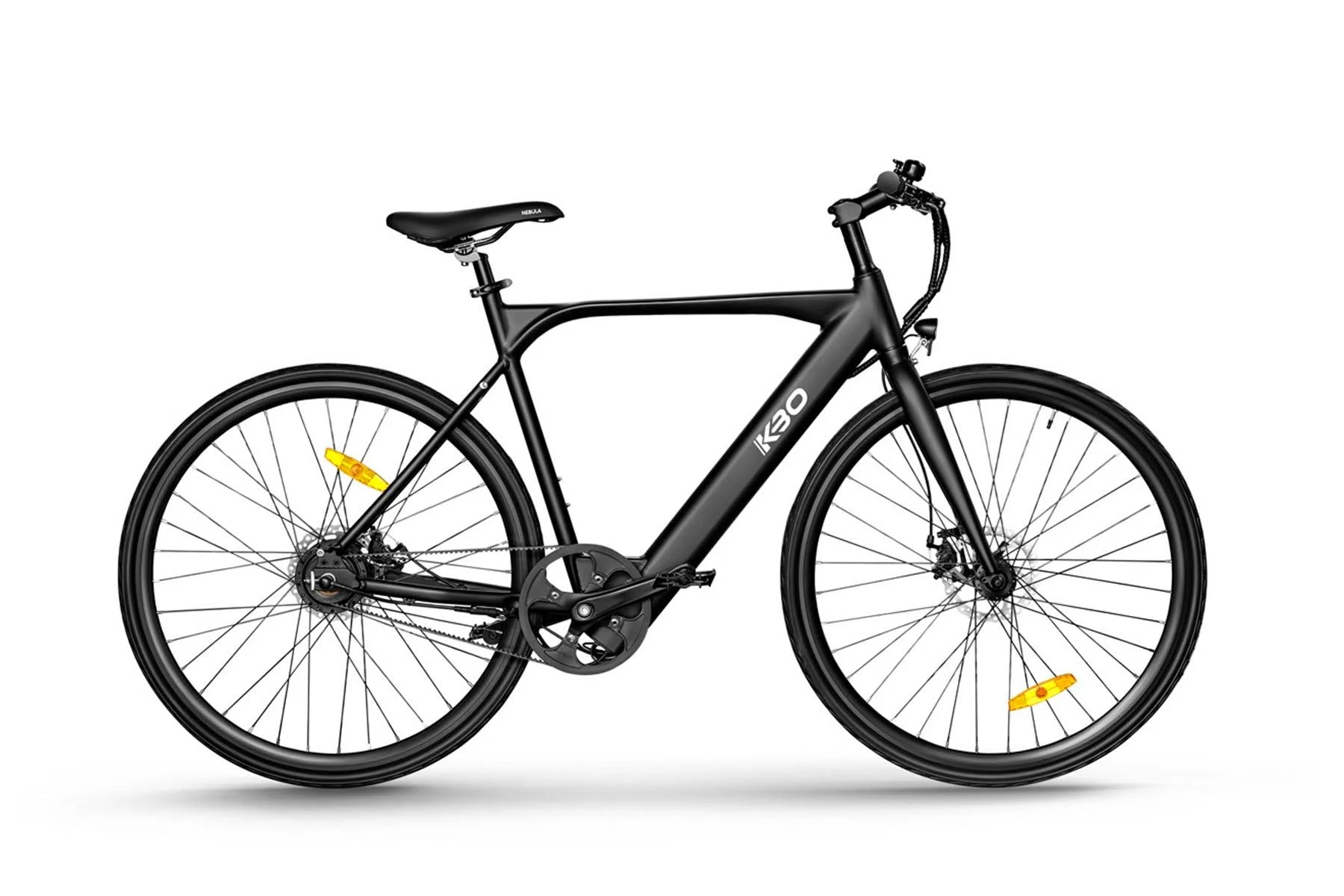
Are you curious about electric bikes but worried about breaking the bank? You’re not alone! E-bikes have exploded in popularity because they’re fun, eco-friendly, and perfect for everything from daily commutes to weekend adventures. But with so many options out there, finding a reliable e-bike under $1,000 can feel overwhelming.
That’s where this guide comes in. We’ve rounded up the top 10 budget-friendly electric bikes that deliver solid performance without emptying your wallet. Whether you’re a commuter, casual rider, or just starting out, you’ll find smart choices that prove you don’t need to spend a fortune to enjoy the perks of e-biking.
In this article, you’ll get clear info on each model’s specs, pros, and cons—plus expert tips to help you pick the best e-bike for your needs. Ready to find your perfect ride? Let’s dive in!
How We Selected These E-Bikes
Choosing the best e-bikes under $1,000 isn’t just about price — it’s about finding reliable rides that give you real value. So, how did we pick the top models for this list?
We focused on three main factors to make sure you get a solid, budget-friendly e-bike that won’t let you down:
- Price: Each e-bike had to be priced at or below $1,000.
- Reliability: We checked user reviews and expert opinions to find models known for durability and consistent performance.
- Features: Essential features like motor power, battery life, and build quality were key to ensure a smooth riding experience.
Key Specs We Evaluated
To help you ride with confidence, we looked closely at specs that matter most:
- Motor Power: Usually measured in watts, this determines how much help the bike gives when you pedal. More power means easier hills and faster speeds.
- Battery Life: How far you can go on a single charge is crucial. We looked for e-bikes offering a good balance of range and charging time.
- Weight: Lighter bikes are easier to handle and carry, especially if you need to bring your e-bike indoors or on public transport.
- Durability: Frame quality, brakes, and tires all play a role in safety and long-term use.
Who Are These E-Bikes For?
Our list includes e-bikes suited to a variety of riders:
- Daily commuters who want to cut down on car trips and beat traffic.
- Casual riders looking for a fun, eco-friendly way to explore neighborhoods and parks.
- Budget-conscious beginners eager to try electric biking without a big investment.
Pro Tip: If you plan on tackling hills or longer rides, prioritize e-bikes with higher motor power and longer battery range.
With these guidelines, you can trust that every e-bike on our list is a smart buy for 2025. Ready to discover your perfect match? Keep reading!
Top 10 E-Bikes Under $1,000 (2025): Affordable, Reliable, and Ready to Ride
Looking for the best e-bikes under $1,000 in 2025? You’re in the right place! Whether you want to cruise through the city, tackle weekend trails, or just enjoy an eco-friendly ride, we’ve rounded up the top budget-friendly electric bikes that deliver great value without breaking the bank.
In this e-bike buying guide, you’ll find detailed specs, pros and cons, and the ideal rider for each model — helping you make a confident choice. Ready? Let’s dive in!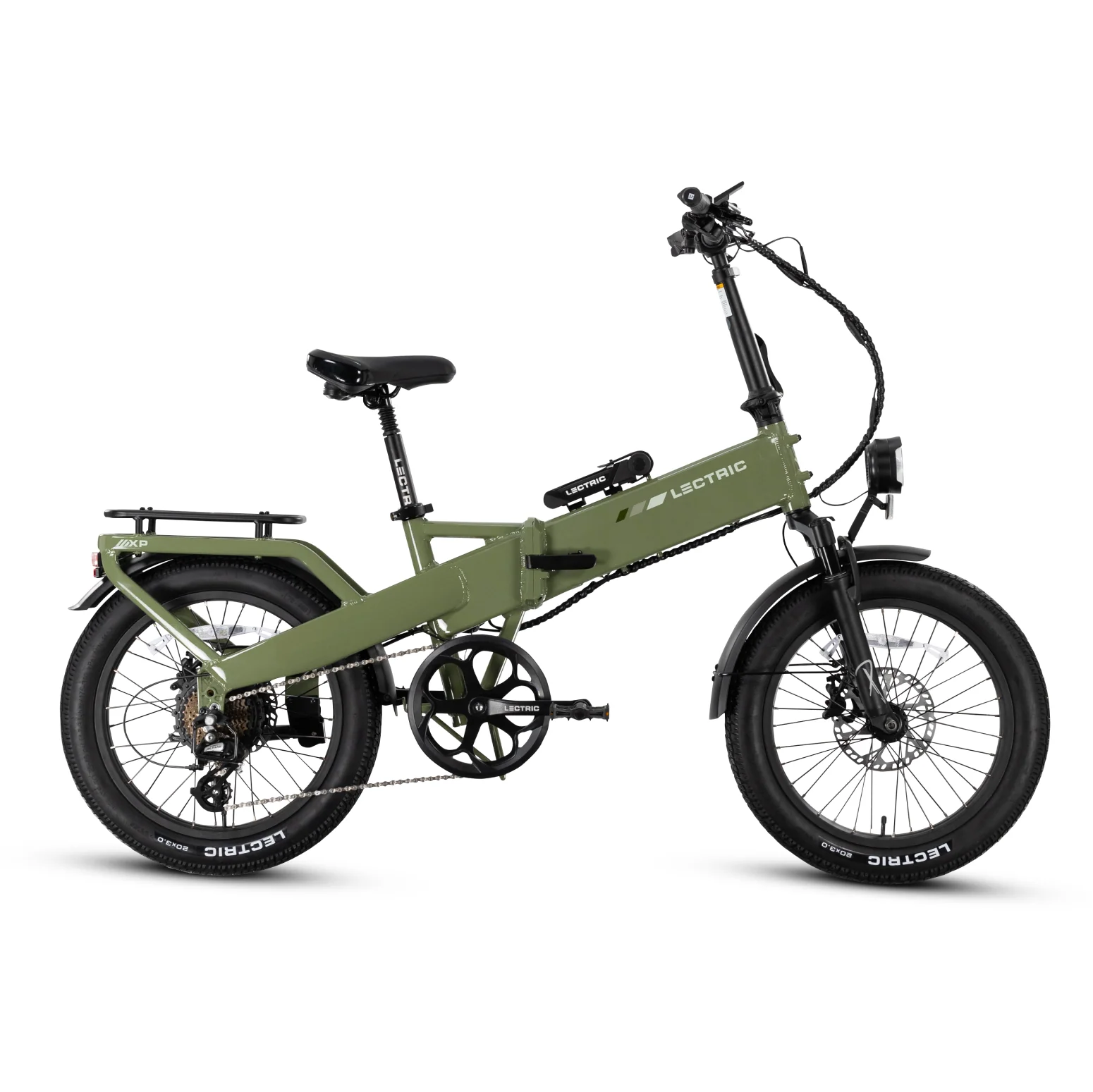
1. Lectric XP4
Price: $999
Key Specs:
- Motor: 500W (1,092W peak) rear hub
- Battery: 48V 10.4Ah
- Range: Up to 45 miles
- Top Speed: 20 mph (can be unlocked higher)
- Weight: ~60 lbs
- Frame: Foldable, step-thru aluminum with all-terrain tires
Pros:
- Excellent value for the price
- Powerful motor and solid battery
- Hydraulic disc brakes and front suspension
- Integrated lights, fenders, and rear rack
- Supports up to 330 lbs
Cons:
- Slightly heavy for a folding bike
- Limited color options
Ideal Use Case:
Perfect for first-time e-bike buyers, urban commuters, and weekend adventurers who want a versatile, foldable ride.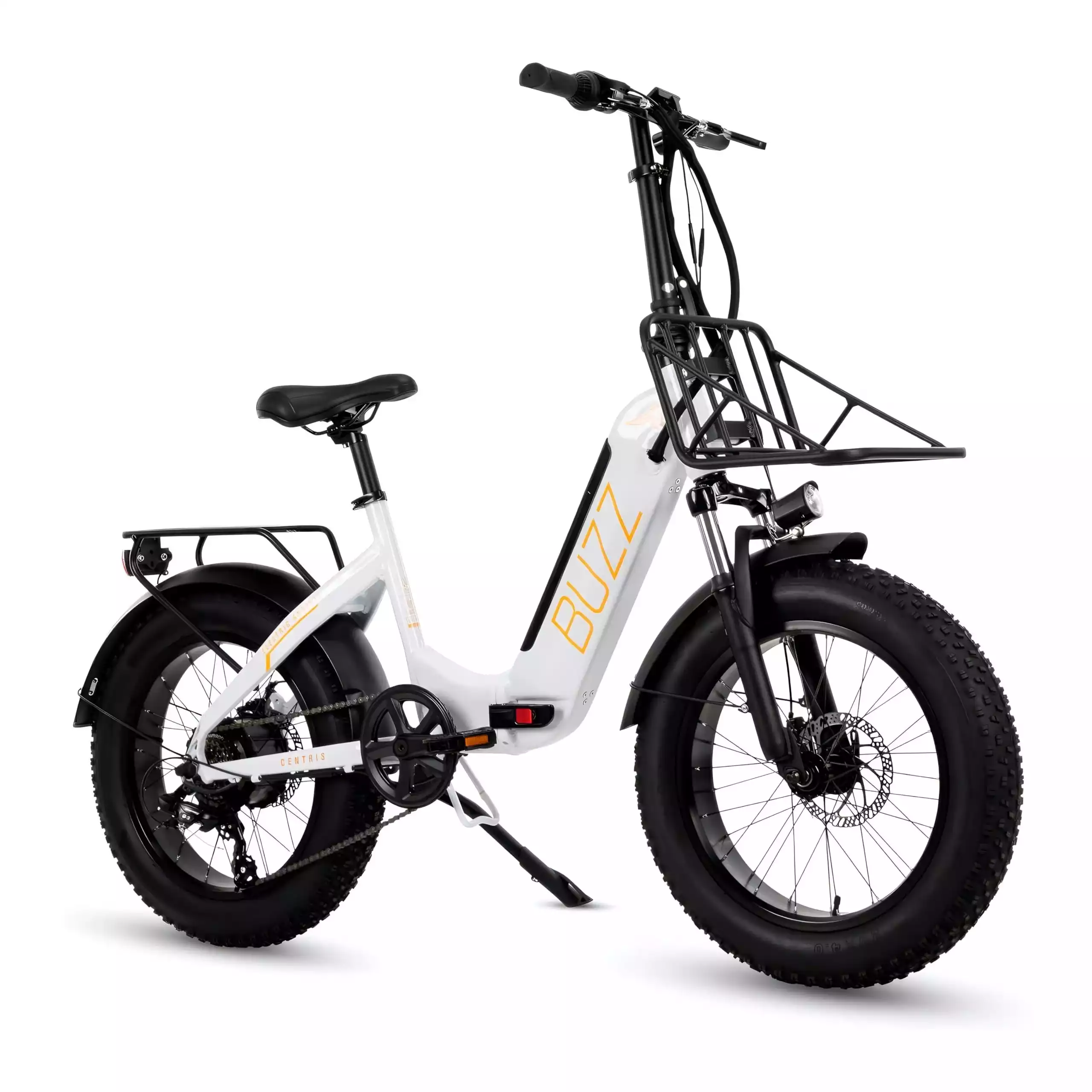
2. Buzz Centris Folding E-Bike
Price: $899
Key Specs:
- Motor: 500W rear hub
- Battery: 48V 10.4Ah
- Range: Up to 40 miles
- Top Speed: 20 mph
- Frame: Compact folding with magnesium wheels
Pros:
- Durable magnesium wheels
- Integrated rear rack for cargo
- Compact for easy storage
Cons:
- Basic mechanical disc brakes
- Not suitable for heavy hauling
Ideal Use Case:
Ideal for riders with limited storage space and light urban commuters.
3. Lectric XP Lite 2.0
Price: $799
Key Specs:
- Motor: 300W nominal (800W peak)
- Battery: 48V 7.8Ah
- Range: Up to 40 miles
- Top Speed: 20 mph
- Weight: 41 lbs
- Frame: Lightweight, foldable aluminum
Pros:
- Very lightweight and portable
- Affordable entry-level option
- Comes with integrated lights and display
Cons:
- Lower motor power than pricier models
- Shorter range if throttle is used often
Ideal Use Case:
Great for students and urban dwellers who prioritize portability and budget.
4. Ride1Up Portola
Price: $995 (on sale)
Key Specs:
- Motor: 750W rear hub
- Battery: 48V 14Ah
- Range: 30–45 miles
- Top Speed: 20 mph
- Weight: 59 lbs
- Frame: Foldable aluminum with fat-ish tires and suspension
Pros:
- Powerful motor with hydraulic brakes
- 8-speed drivetrain for varied terrain
- Compact folding design
Cons:
- Slightly heavy
- MSRP a bit over budget but often discounted
Ideal Use Case:
For riders wanting a quality folding bike with good ride comfort and power.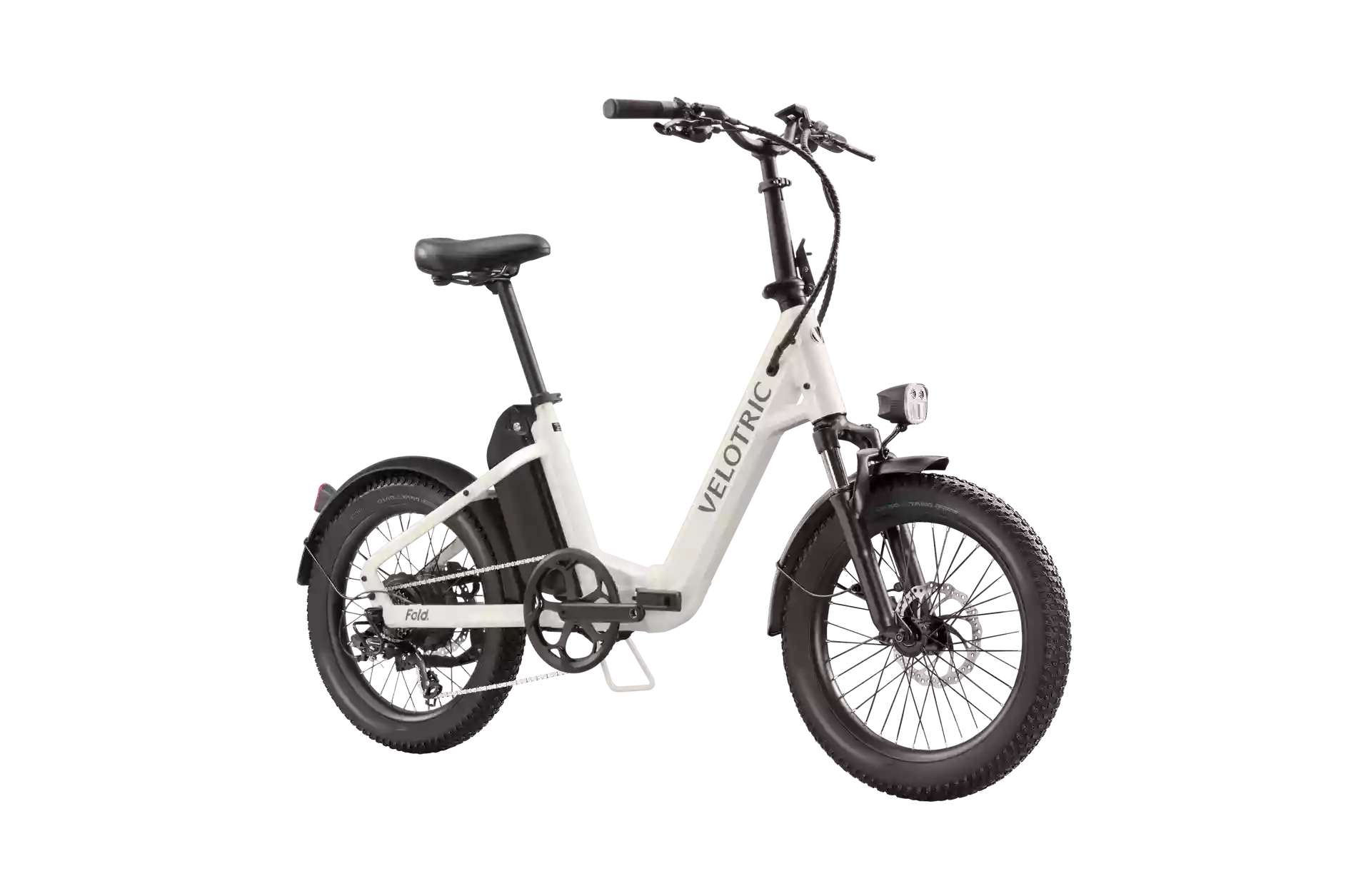
5. Velotric Fold 1 Lite
Price: $999
Key Specs:
- Motor: 500W rear hub (55Nm torque)
- Battery: 48V 486Wh
- Range: Up to 48 miles
- Top Speed: 20 mph (can unlock 28 mph)
- Frame: Foldable aluminum with 20x3” all-terrain tires
Pros:
- Stylish design with solid folding mechanism
- Hydraulic disc brakes
Cons:
- No rear rack included
- Limited color choices
Ideal Use Case:
Style-conscious commuters who want compactness without sacrificing performance.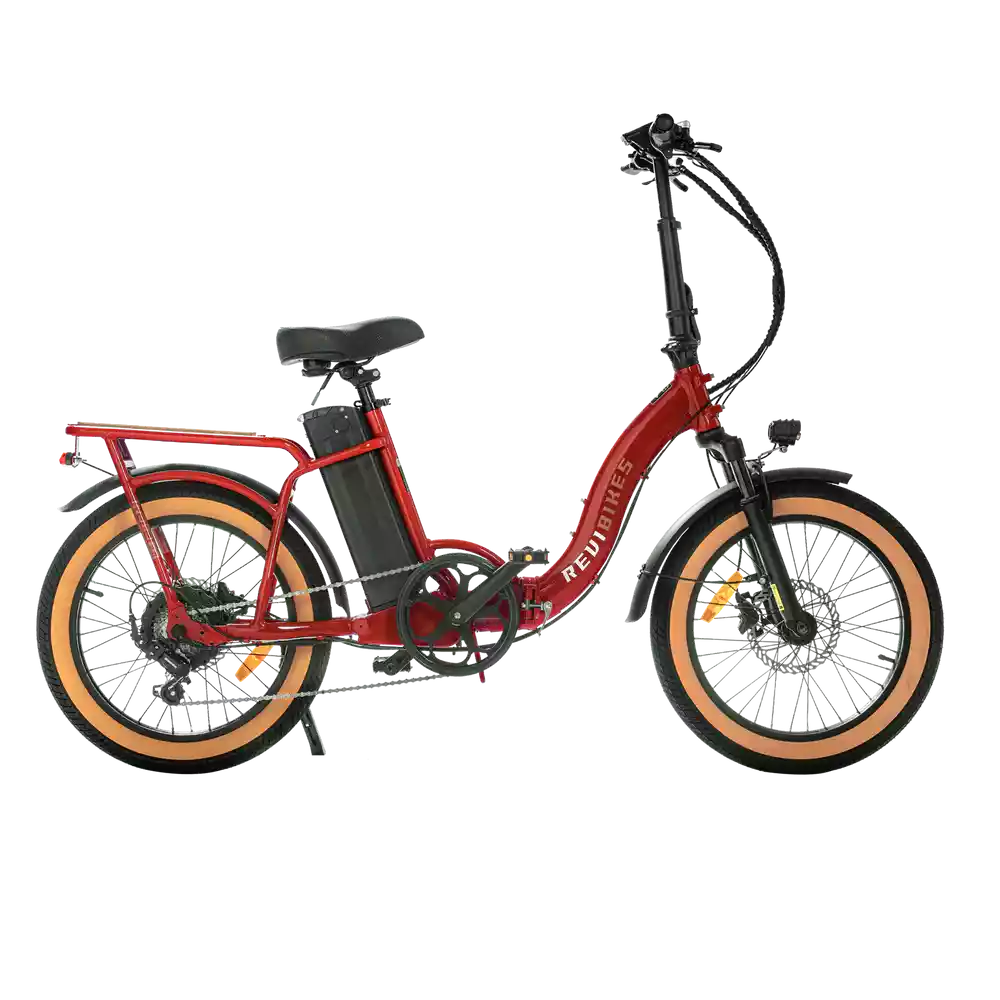
6. REVI Rebel 2 Step-Thru Folding
Price: $849
Key Specs:
- Motor: 750W (1,000W peak)
- Battery: 48V 15Ah Samsung
- Range: Up to 60 miles
- Top Speed: 28 mph
- Weight: 65 lbs
- Frame: Folding, step-thru with fat tires
Pros:
- High power and long range
- Hydraulic disc brakes
Cons:
- Heavier than typical folding bikes
Ideal Use Case:
Heavier riders or urban commuters wanting portability and power.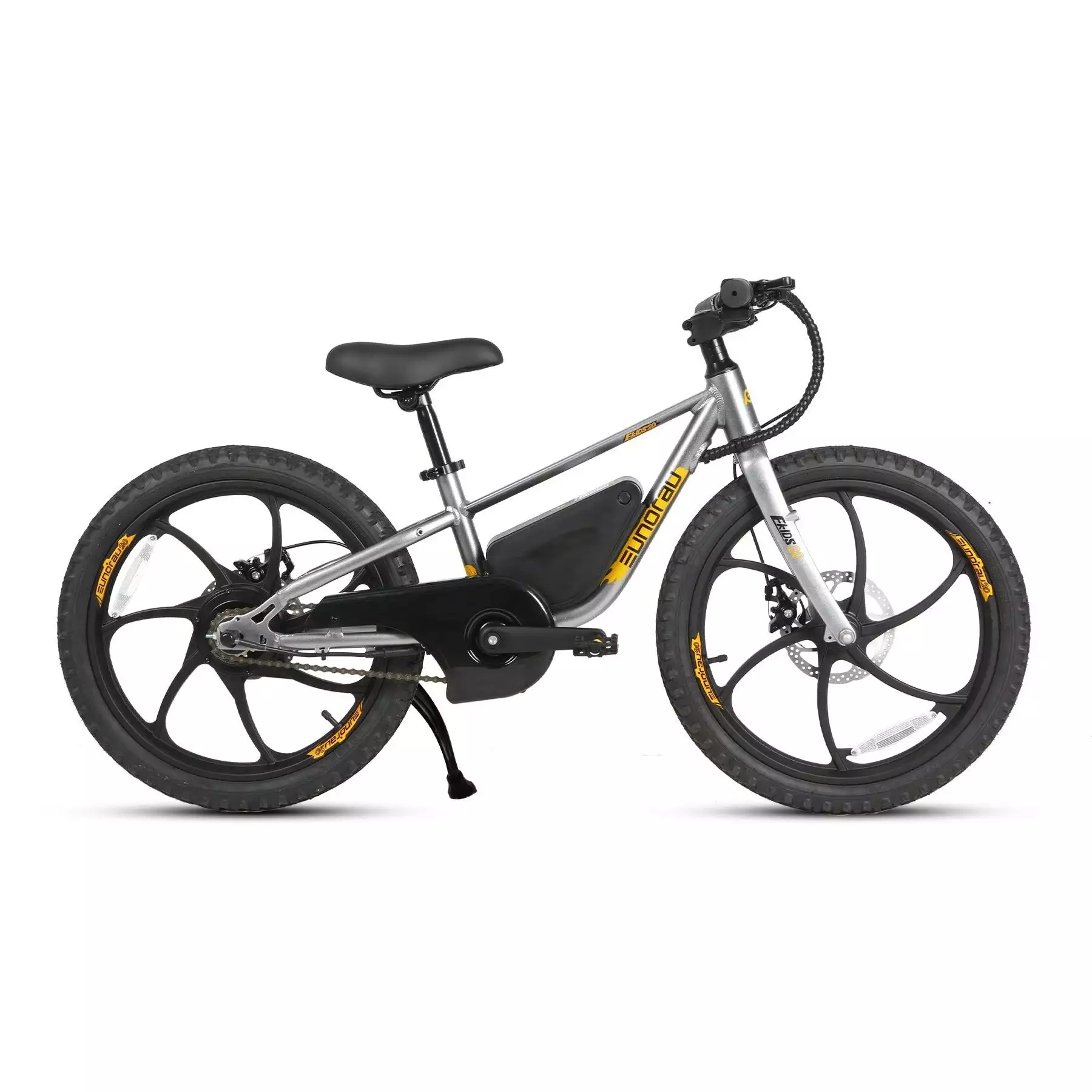
7. EUNORAU EKIDS 20
Price: $849
Key Specs:
- Motor: 250W
- Battery: 24V 10Ah
- Range: Up to 20 miles
- Top Speed: 20 mph
- Weight: 37.4 lbs
- Frame: Compact, lightweight, step-thru
Pros:
- Very light and easy for kids
- Simple controls
Cons:
- Limited power and range
Ideal Use Case:
Perfect for kids, teens, or short city trips.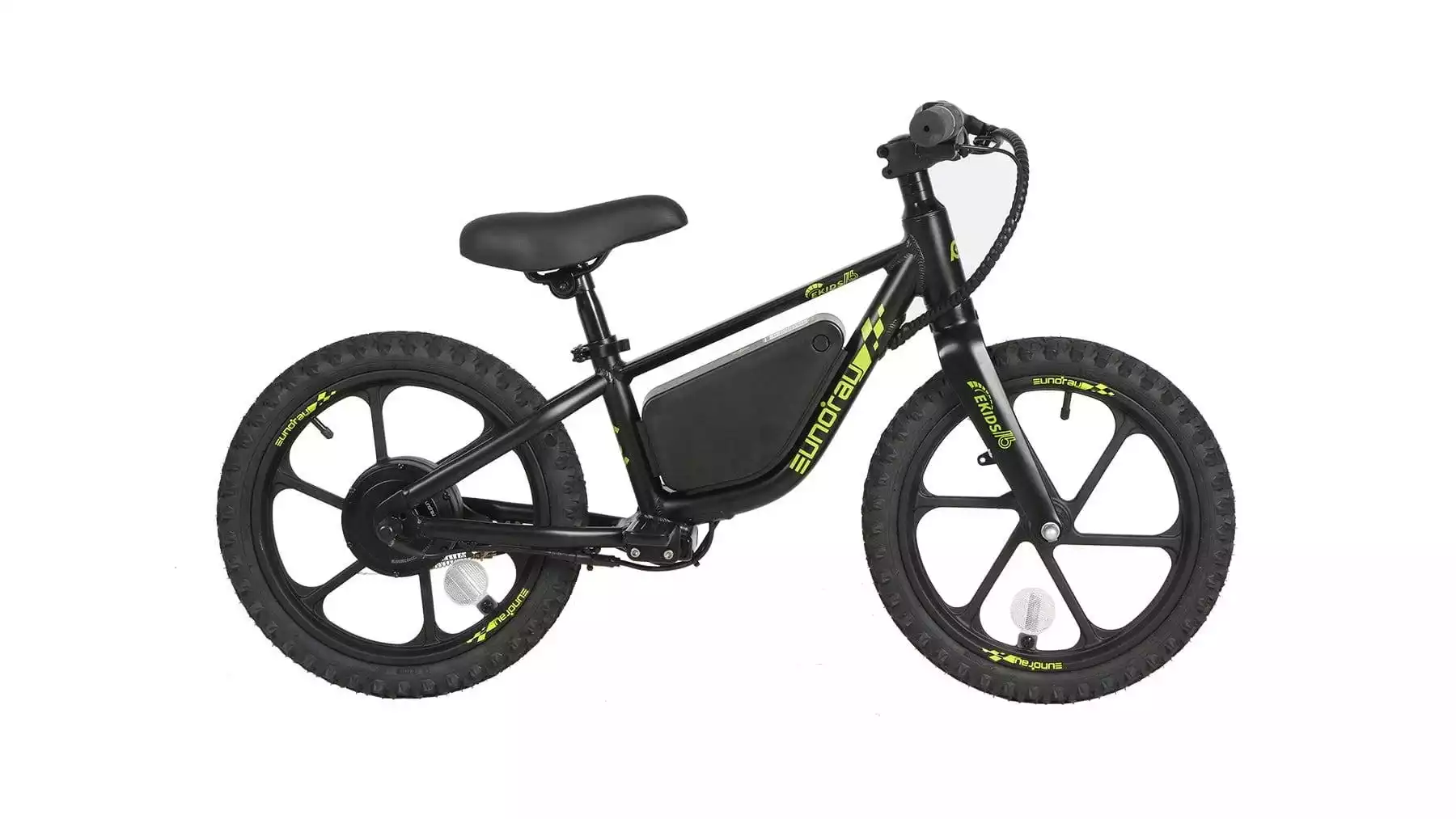
8. EUNORAU EKIDS 16
Price: $749
Key Specs:
- Motor: 180W
- Battery: 24V 10Ah
- Range: Up to 25 miles
- Top Speed: 13 mph
- Weight: 28.6 lbs
- Frame: Extra compact kids model
Pros:
- Extremely lightweight
- Safe top speed for young riders
Cons:
- Only suitable for young children
- Not for hills or adults
Ideal Use Case:
Young children learning to ride electric bikes.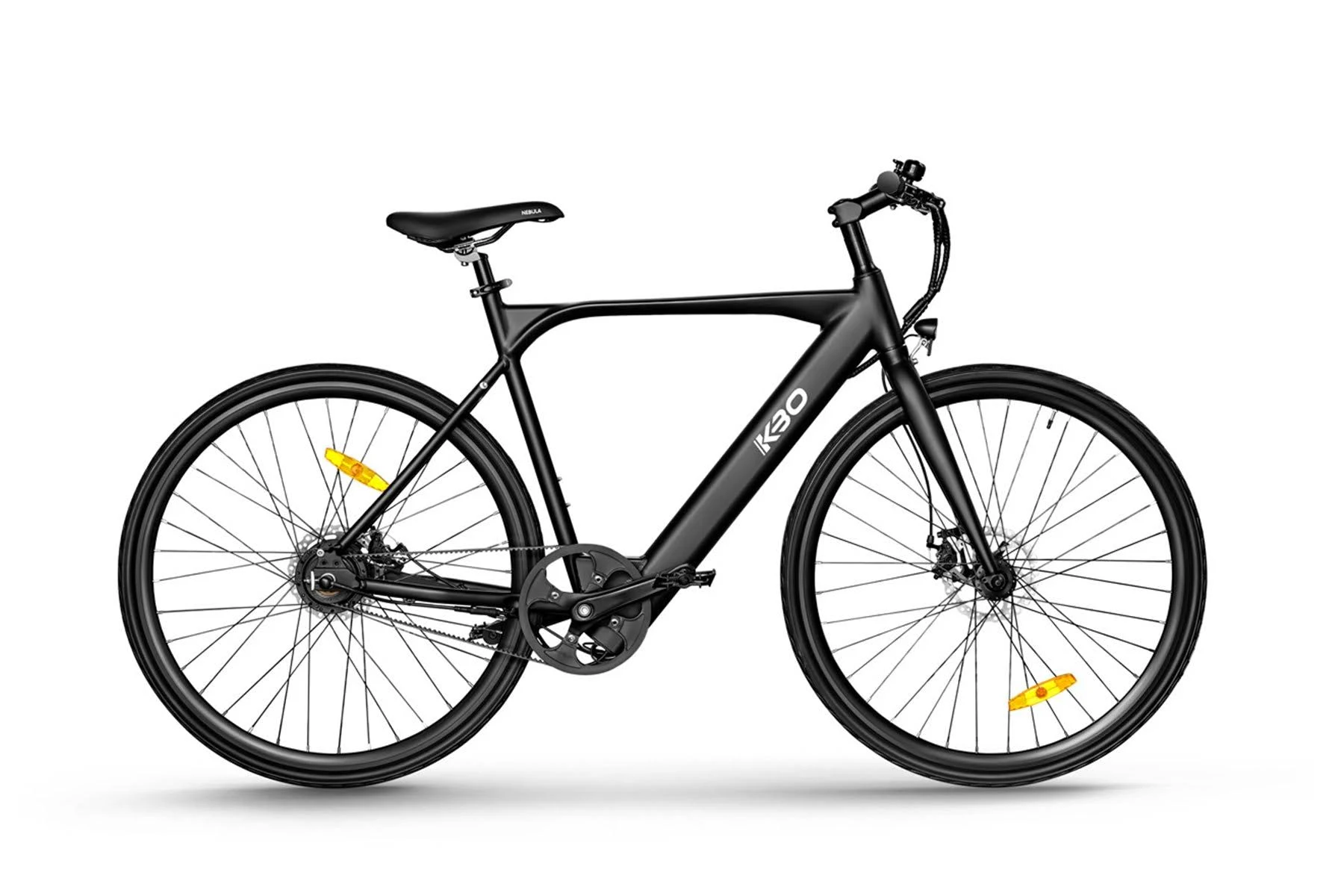
9. KBO Hurricane 2.0
Price: $899 (sale)
Key Specs:
- Motor: 500W peak
- Battery: 36V 378Wh Panasonic
- Range: Up to 45 miles
- Top Speed: 20 mph
- Weight: 36 lbs
- Frame: Sleek urban aluminum with road tires
Pros:
- Lightweight and discreet
- Great for city commuting
Cons:
- Modest battery capacity
- Limited off-road use
Ideal Use Case:
Urban riders wanting a stealthy, light e-bike.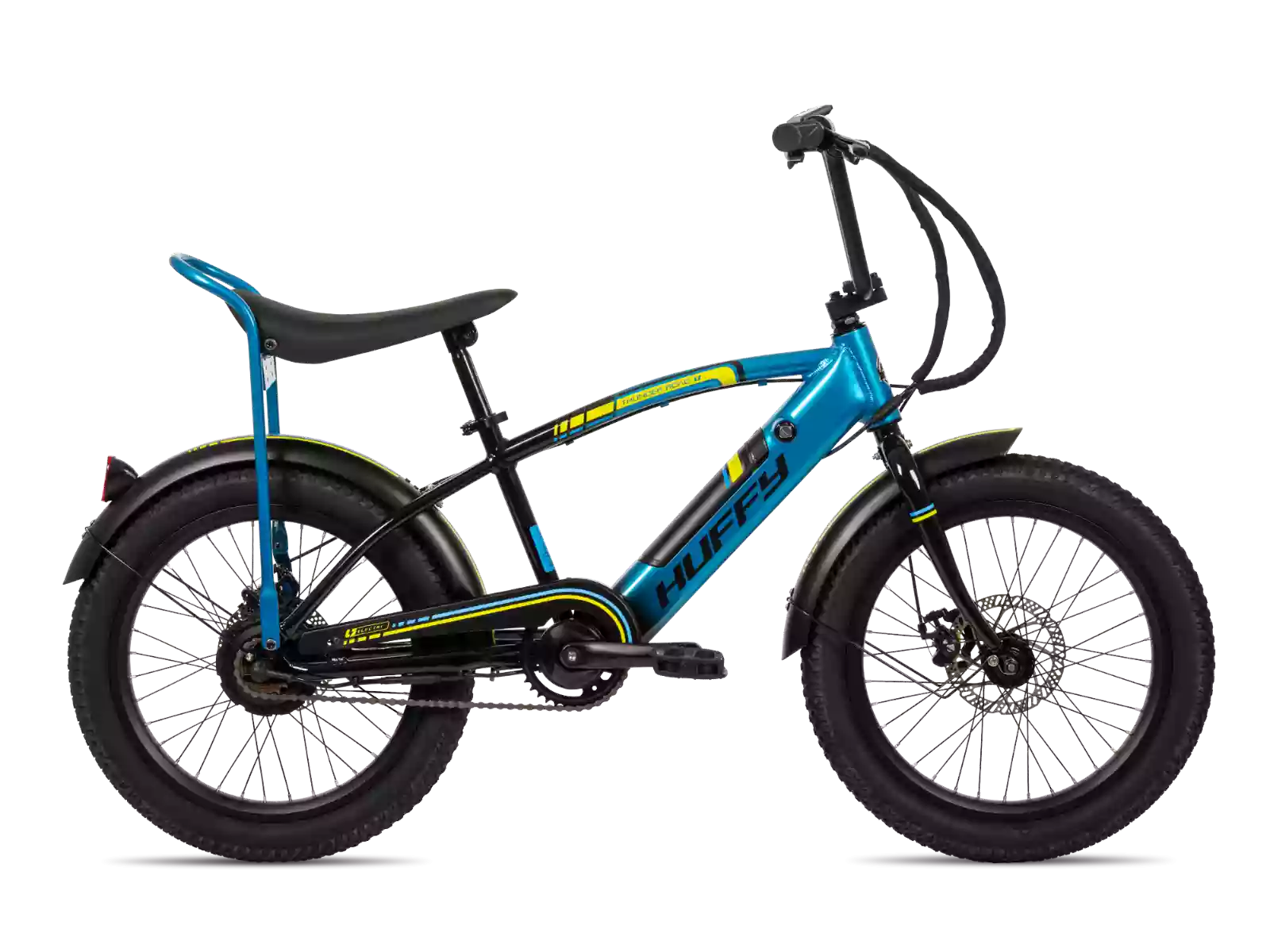
10. Huffy eThunder Road Kids E-Bike
Price: $729
Key Specs:
- Motor: 250W
- Battery: 24V 6Ah
- Range: Short range (not stated)
- Top Speed: 15 mph
- Weight: ~35 lbs (kid-sized)
- Frame: Steel mini-moto style
Pros:
- Fun motorcycle look
- Safe for young riders
- Durable construction
Cons:
- Only for kids and teens
- Shorter range
Ideal Use Case:
Great for kids transitioning from toys to real e-bikes.
Pro Tip:
Consider your daily ride needs. Lightweight, foldable bikes work great for city commutes, while powerful motors and suspension help on longer or rougher rides.
Ready to ride? These best e-bikes under $1,000 for 2025 offer options for every rider and budget. Find your perfect match and start enjoying the electric ride today!
Key Features to Consider in Budget E-Bikes: Your 2025 Buying Guide
Thinking about buying one of the best e-bikes under $1,000 but not sure what really matters? Picking the right electric bike isn’t just about price—it’s about finding the features that fit your riding style and needs.
In this quick guide, we’ll break down the key features to consider in budget e-bikes so you can shop smart and ride happy.
Motor Types and Power: What Moves You?
The motor is the heart of your e-bike. Budget models usually offer hub motors (located in the front or rear wheel) that provide smooth, quiet power.
- Motor wattage typically ranges from 250W to 750W in affordable e-bikes. More watts mean more speed and hill-climbing ability.
- For city commuting, 250W to 500W motors are usually enough.
- If you want extra boost for hills or rough terrain, look for 750W options.
Pro Tip: Don’t just focus on motor power—consider how the bike feels when you pedal. Some bikes have better pedal assist systems that make rides easier without draining the battery too fast.
Battery Range and Charging Time: How Far Can You Go?
Battery life impacts how far you can ride before needing a recharge. Most budget e-bikes offer ranges between 20 to 50 miles, depending on battery capacity and riding conditions.
- Battery capacity is measured in volts (V) and amp-hours (Ah) — a higher number generally means longer rides.
- Charging times typically range from 3 to 6 hours. Faster chargers might be available but can increase the bike’s cost.
- Keep in mind: Using pedal assist conserves battery, while relying heavily on throttle drains it faster.
Frame Quality and Materials: Built to Last
Your e-bike’s frame affects durability, weight, and comfort.
- Aluminum frames are common in budget e-bikes — they’re light, rust-resistant, and strong.
- Some models use steel frames, which add weight but offer durability and a smooth ride.
- Look for a foldable frame if storage or portability is a priority.
Weight and Portability: Easy to Handle
E-bikes can be heavy, especially those with bigger batteries or sturdy frames. Consider:
- Lightweight bikes (around 30-40 lbs) are easier to carry and store.
- Folding e-bikes add convenience if you need to bring your bike on public transit or store it in small spaces.
- Heavier bikes may offer better stability but can be tough to lug upstairs or lift into a car.
Extra Features: Pedal Assist, Throttle, Suspension, and Brakes
Modern e-bikes pack in helpful extras that boost comfort and control.
- Pedal assist helps you pedal with motor power proportional to your effort—great for smooth rides and better battery life.
- Throttle mode lets you ride without pedaling, like a scooter—handy for quick boosts or tired legs.
- Suspension forks absorb bumps for a smoother ride, especially on rough roads or trails.
- Brakes: Hydraulic disc brakes are more effective and responsive than mechanical brakes, especially in wet conditions.
Pro Tip: Consider what features matter most for your rides. If you mostly stick to paved roads, suspension might be less critical than good brakes and battery life.
Ready to Ride?
Understanding these key features helps you zero in on the best e-bikes for your needs in 2025. Whether it’s city commuting, weekend cruising, or getting started with e-bikes, the right combination of motor power, battery range, frame, and extras will make your ride fun, reliable, and practical.
Find the perfect budget e-bike today and start enjoying the freedom of electric riding!
Tips for Buying an E-Bike Under $1,000: Your 2025 Buying Guide
Thinking about snagging one of the best e-bikes under $1,000 but want to make sure you get the right deal? Buying an electric bike is exciting—but a few smart tips can help you avoid surprises and ride off happy.
Here’s what you need to know to shop confidently and get the most value for your budget.
Best Purchasing Channels: Online vs. Local Stores
Both online retailers and local bike shops have their perks:
- Online shopping often offers better prices, wider selection, and customer reviews.
- Local stores let you test ride bikes, get expert advice, and easier in-person support.
Pro Tip: If buying online, check for a clear return policy and assembly support. Some brands offer free shipping and assembly videos to make setup easier.
Warranty and Support Considerations
A solid warranty can save you headaches down the road.
- Look for at least a 1-year warranty on the frame and electrical components.
- Check if the brand offers customer support via phone, chat, or email.
- Some budget e-bikes include free tune-ups or service clinics through local dealers.
Test Riding and Fit: Don’t Skip This Step
How a bike fits and feels can make or break your experience.
- Visit local stores or events to test ride different models.
- Make sure the bike is comfortable to sit on and easy to reach the handlebars and pedals.
- Folding bikes should feel sturdy and fold/unfold smoothly.
Pro Tip: If you can’t test ride in person, watch online reviews and unboxing videos to get a sense of handling and setup.
Maintenance Basics: Keep Your E-Bike Running Smoothly
Even budget e-bikes need regular care to stay reliable.
- Keep tires inflated to the recommended pressure for a smooth ride.
- Check brakes and adjust or replace brake pads when needed.
- Clean the chain regularly and lubricate it to avoid rust.
- Charge the battery after each ride and store it in a cool, dry place.
Ready to Ride?
Buying an e-bike under $1,000 can be simple and fun when you know where to shop, what to expect in warranty, and how to ensure a good fit. Follow these tips to find your perfect ride and enjoy all the perks of electric biking in 2025.
Find the best e-bikes for your lifestyle today and start pedaling smarter!
Conclusion: Why Affordable E-Bikes Are a Smart Ride in 2025
Looking for the best e-bikes under $1,000 means you don’t have to sacrifice quality or fun just to stay on budget. Affordable electric bikes offer impressive power, good battery life, and features that fit a variety of riders—from city commuters to weekend explorers.
Remember, the key is to balance specs and your personal needs. Whether it’s motor strength, battery range, or portability, choosing what matters most to you ensures a satisfying ride without overspending.
Pro Tip:
Focus on your daily riding habits and terrain to pick the best e-bike for you. The perfect budget e-bike combines performance, comfort, and value.
Ready to explore the top affordable e-bike options and find your perfect match? Dive into our detailed reviews and start your electric adventure today!
Additional Resources for E-Bike Riders: Learn, Ride, and Maintain with Confidence
Ready to dive deeper into the world of electric bikes? Whether you’re a beginner or looking to upgrade your knowledge, these extra resources will help you get the most out of your e-bike experience.
Detailed Reviews and Buying Guides
Want to explore the best e-bikes for commuters, beginners, or outdoor adventurers? Check out trusted sites that offer in-depth 2025 electric bike reviews, user testimonials, and comparisons to help you find the perfect fit.
- Look for e-bike buying guides that explain features in plain English.
- Video reviews can show you real-world performance and unboxing experiences.
Safety Tips for E-Bike Riders
Riding smart keeps your adventures fun and injury-free.
- Always wear a helmet and visible clothing.
- Use lights and reflectors for night riding.
- Follow local traffic laws and ride predictably.
- Learn how pedal assist and throttle modes affect your control.
Maintenance Tutorials: Keep Your E-Bike Running Smoothly
Regular care boosts performance and extends your bike’s life.
- Simple tasks like tire inflation and chain lubrication make a big difference.
- Watch step-by-step videos on brake adjustments, battery care, and cleaning.
- Many brands offer maintenance guides tailored to their models.
Pro Tip: Bookmark a few reliable e-bike blogs and YouTube channels to stay updated on tips, trends, and troubleshooting advice.
Feeling ready to start your e-bike journey? Explore these resources, gear up safely, and enjoy the thrill of electric riding!
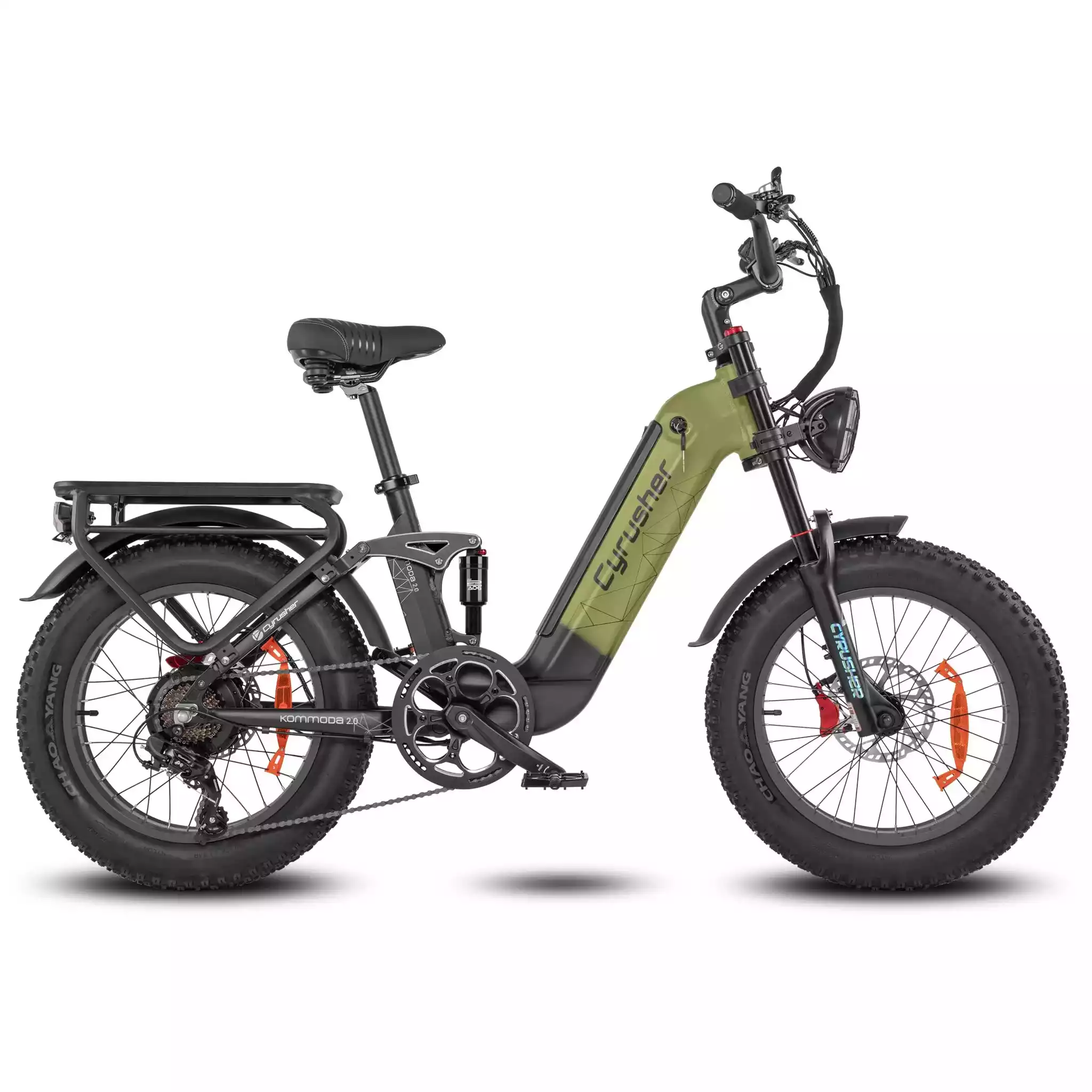
Ever wondered if an e-bike could be your new favorite way to get around? Whether you're commuting, cruising the neighborhood, or just getting back into cycling, an entry-level e-bike is a fun, low-stress way to ride more often—with a lot less effort.
Entry-level e-bikes are electric bikes designed specifically for new riders. They’re simple to use, easy to maintain, and often much more affordable than high-end models. Think: no complicated settings, no steep learning curve—just hop on and ride.
Why E-Bikes Are Perfect for Beginners
Electric bikes give you a boost while pedaling, making hills feel flatter and long rides feel shorter. For beginners, this means:
- Less physical strain, more enjoyment
- More confidence to ride in traffic or on trails
- Fewer excuses to skip a ride
And thanks to improvements in battery and motor technology, even entry-level models in 2025 offer impressive range and reliability.
What Makes a Great Beginner E-Bike?
When you're just starting out, the best e-bike is one that feels easy and comfortable—without breaking the bank. Here’s what to look for:
- Simplicity: A clean interface, minimal buttons, and pedal-assist you can trust
- Affordability: Great models now start as low as $800–$1,500
- Comfort: Upright seating, cushy seats, and easy step-through frames
- Ease of Maintenance: Look for hub motors, sealed batteries, and sturdy components
- Range & Power: 20–40 miles is more than enough for most beginner riders
✅ Pro Tip: If it looks intimidating or too high-tech, skip it. Your first e-bike should feel as friendly as a cruiser bike—with a little extra magic under the hood.
Ready to find out which models are best for new riders? In the next section, we’ll break down the top beginner e-bikes of 2025, from budget-friendly cruisers to foldable city bikes and everything in between.
Key Features to Look for in a Beginner E-Bike
Not all e-bikes are created equal—especially if you’re a first-time buyer. Choosing the right entry-level model means focusing on what truly matters: comfort, simplicity, and reliability. Here’s a quick breakdown of the most important features in any good beginner e-bike.
Affordability: Spend Smart, Ride More
For most new riders, there's no need to spend $3,000+ on a high-end model. Some of the best e-bikes for beginners in 2025 sit comfortably in the $800 to $1,800 range. These bikes offer solid build quality, good battery life, and just the right amount of motor power—without the premium price tag.
✅ Pro Tip: Brands like Aventon, Ride1Up, and Lectric offer excellent beginner models under $1,500.
Ease of Use: Simple, Stress-Free Riding
You don’t need a tech degree to ride an e-bike—and your first one shouldn’t make you feel that way.
Look for:
- Step-through frames (easier to mount and dismount)
- Minimal controls (basic display, clear buttons)
- Pedal-assist systems that kick in naturally
- Optional thumb throttle for boost-on-demand (great for hills or takeoff)
A beginner-friendly e-bike should feel just like a regular bike—but with superpowers.
Low Maintenance: Ride More, Worry Less
As a first-time rider, the last thing you want is constant trips to the repair shop. Low-maintenance e-bikes keep things simple and smooth.
Here’s what helps:
- Hub motors (sealed and durable—fewer moving parts)
- Integrated batteries (easier to charge and less exposed to weather)
- Mechanical or hydraulic disc brakes (reliable stopping power in all weather)
⚙️ Did You Know? Hub motors are usually quieter and need less upkeep than mid-drive motors, making them perfect for beginners.
Comfort: Because Happy Riders Ride More
An e-bike should feel good from the moment you sit on it. For beginners, comfort is key—and can make the difference between a fun ride and a sore back.
Look for:
- Upright riding position to reduce strain on your back and wrists
- Front suspension forks to smooth out bumps and cracks
- Cushioned or wide saddles for extra padding
If your ride feels natural and relaxed, you're way more likely to use your bike daily.
Battery Range: How Far Is “Enough”?
When you’re just starting out, you don’t need a 100-mile range. Most new riders stick to short commutes, weekend rides, or casual errands. A range of 20–40 miles per charge is more than enough.
What affects range:
- Rider weight and terrain
- Level of pedal assist
- Battery size (measured in watt-hours or Wh)
And don’t worry—charging is as easy as plugging in a laptop.
With these key features in mind, you’ll be able to shop confidently—and avoid common first-time mistakes. Up next: we’ll walk through the top-rated beginner e-bikes of 2025 for every budget and lifestyle. Ready to find your match?
Best Entry-Level E-Bikes for 2025
Explore the top beginner e-bikes of 2025, organized by lifestyle and riding needs—from all-around champs to budget buys, foldable models, and light trail cruisers.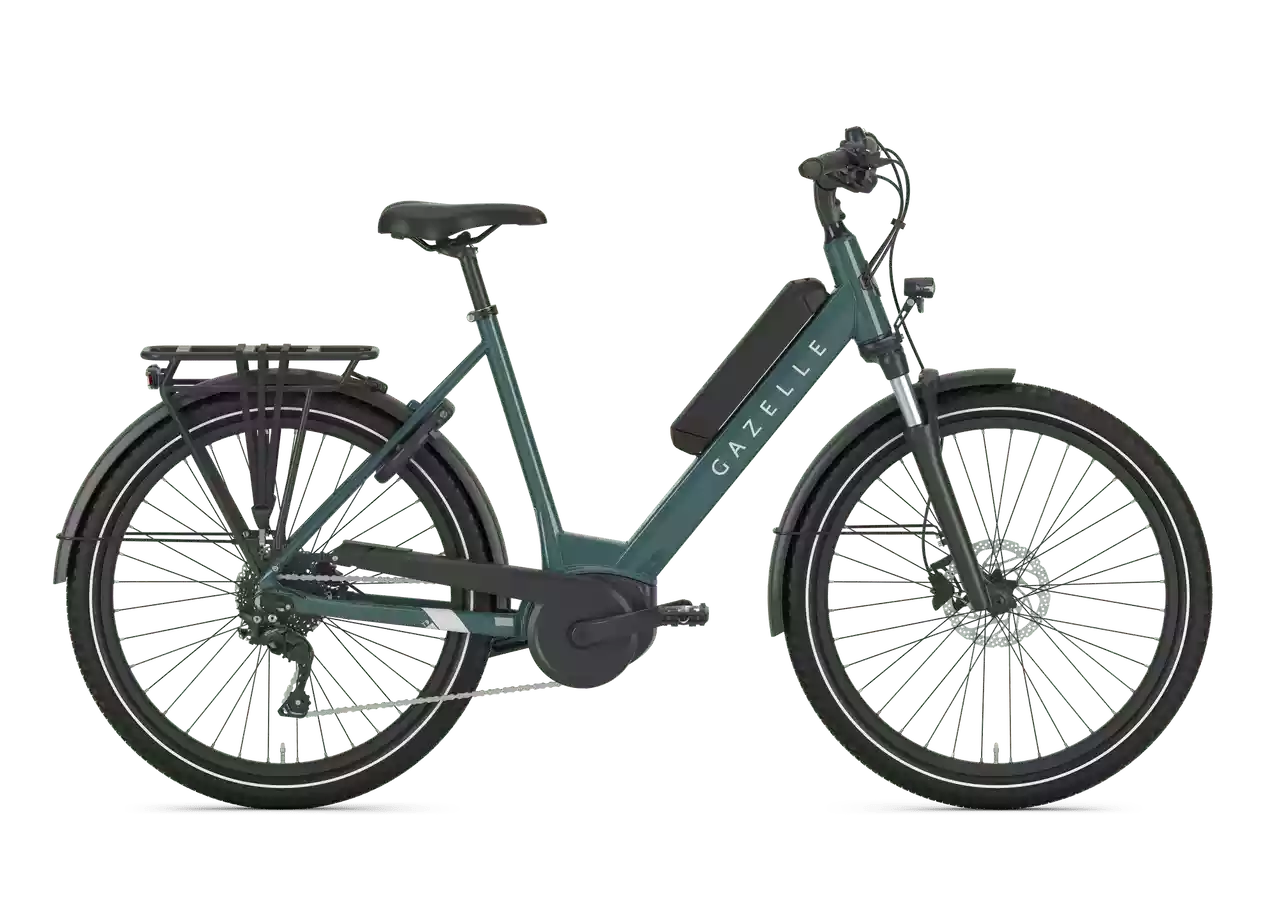
A. Best Overall Beginner E-Bike
Gazelle Medeo City T9
- Price Range: ~$2,299–$2,600
- Motor/Battery: Bosch Active Line mid-drive, 400Wh battery
- Top Speed: 20 mph
- Weight: 48.1 lbs
Why It’s Great for Beginners:
The Medeo City T9 nails the sweet spot between comfort, performance, and ease of use. Its smooth, quiet motor and stable frame make it approachable even if you haven’t biked in years. Upright posture and integrated features (rack, lights, fenders) make it ready for city life or weekend cruises.
✅ Pro Tip: Mid-drive motors like Bosch offer a more natural, balanced ride—perfect for longer commutes or mild hills.
B. Best Budget E-Bike Under $1,000
Lectric XP Lite 2.0
- Price: $799
- Motor: 300W rear hub (peak 720W)
- Range: Up to 45 miles (80 with extender)
- Weight: 49 lbs
Why It’s a Top Pick for Budget Riders:
Affordable without feeling “cheap,” the XP Lite is ideal for students, new commuters, or anyone e-curious. Despite the price, it delivers real range and power, plus hydraulic disc brakes—a rare find under $1,000.
Watch Out For:
Single-speed gearing means it's best for flat areas. No suspension, but the ride remains smooth thanks to wide tires and stable geometry.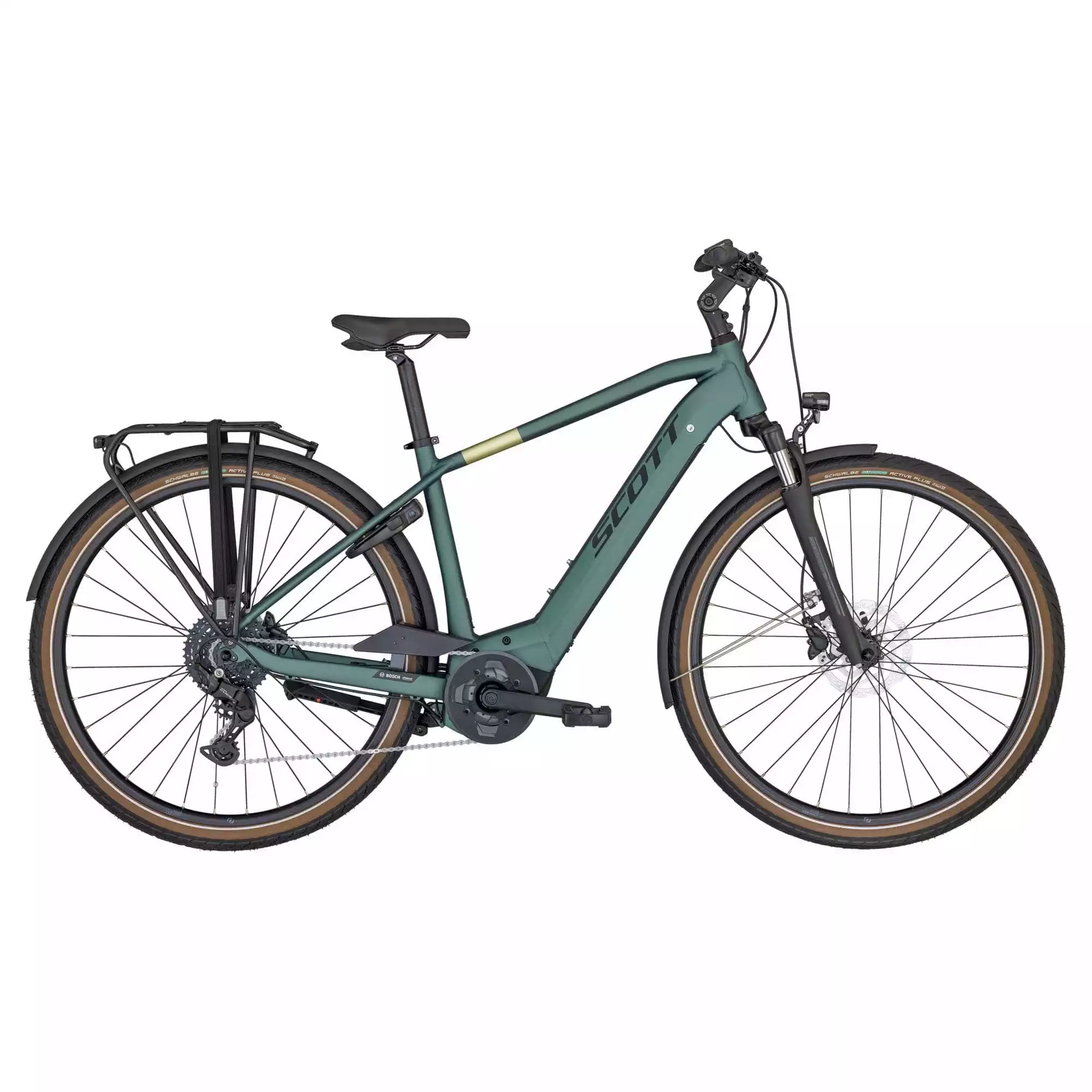
C. Best Step-Through E-Bike for Easy Mounting
Scott Sub Active eRide
- Motor/Battery: Bosch Active Line mid-drive, 400Wh
- Comfort Features: Suspension fork, wide tires, upright handlebars
- Extras: Built-in lock, lights, fenders, rear rack
Best For:
Seniors, shorter riders, or anyone who wants a stress-free, easy-on-and-off design. The frame is ultra-low and intuitive to mount, making it a favorite for comfort-first beginners.
⚙️ Pro Tip: Step-through bikes are especially helpful if you’ll be stopping frequently (errands, city riding, etc.).
D. Best Folding E-Bike for Portability
Lectric XP 3.0 Step-Thru
- Folded Size: 37" x 18" x 28"
- Motor: 500W rear hub, ~500Wh battery
- Range: 20–45 miles
- Weight: 64 lbs
Perfect For:
Apartment dwellers, RV travelers, or anyone who wants to stash a bike in a closet or car trunk. It arrives fully assembled, folds quickly, and is easy to transport.
Why It’s Beginner-Friendly:
Great power-to-weight ratio, adjustable seating, and a very approachable price make this a top folding choice.
E. Best E-Bike for Urban Commuting
Cyrusher Kommoda 2.0
- Motor: 750W rear hub
- Battery: ~768Wh (varies by build)
- Range: Up to 68 miles
- Top Speed: 28 mph (Class 3)
- Commuter Perks: Integrated lights, fenders, suspension, cargo rack
Why Urban Riders Love It:
From stoplights to potholes, the Kommoda handles urban terrain with ease. It’s powerful yet easy to control, and its included accessories make daily commuting smoother—and safer.
🚲 Note: If you're new to higher speeds (28 mph), try starting with a lower assist level while getting comfortable.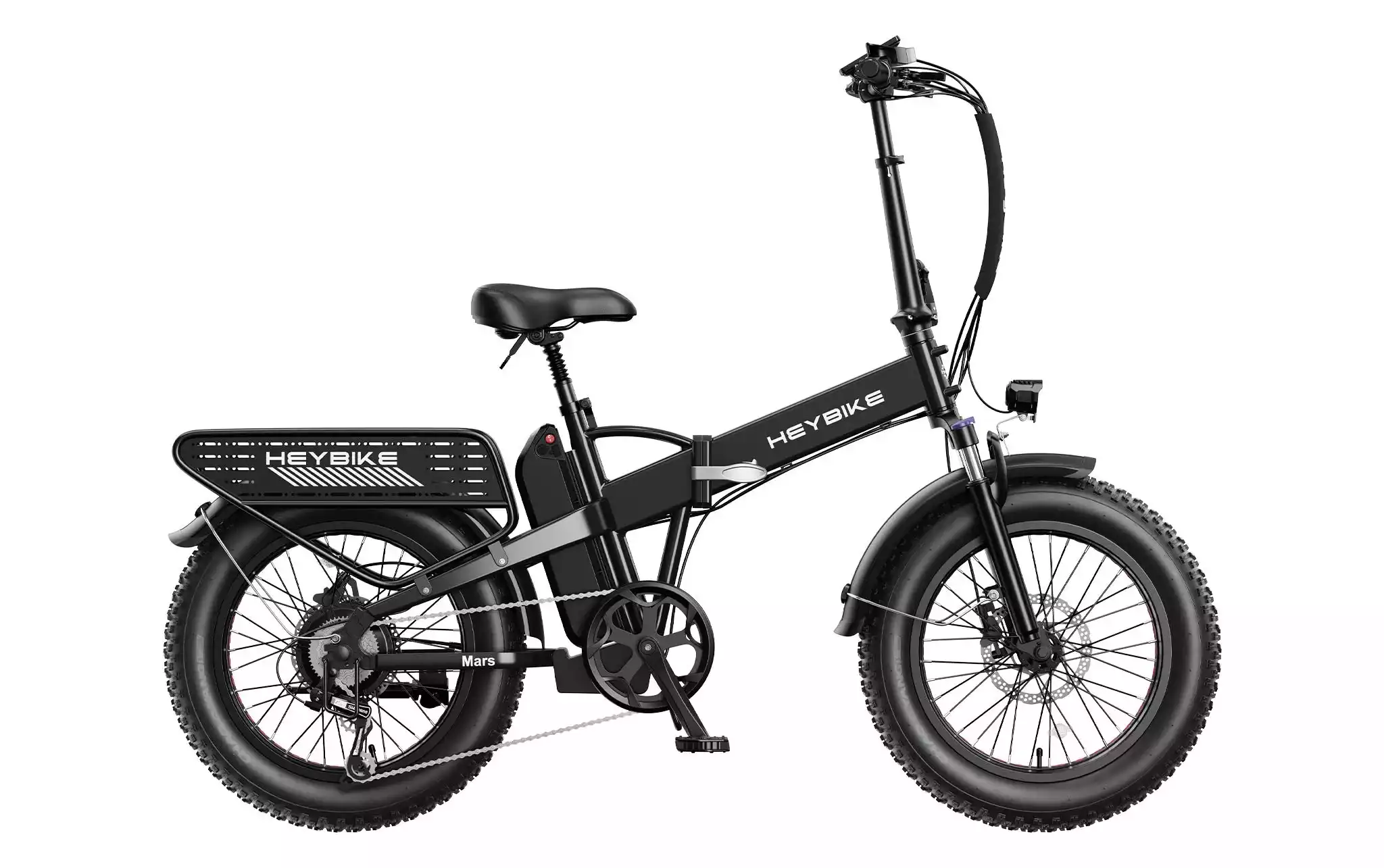
F. Best Trail-Ready Beginner E-Bike
Heybike Mars 2.0
- Price: $999
- Motor/Battery: 500W hub motor, 624Wh battery
- Range: ~45 miles
- Build: Front suspension, 4” fat tires, folding frame
Beginner-Friendly Dirt Riding:
Not quite a mountain bike, not just a city cruiser—the Mars 2.0 is perfect for gravel trails, park paths, and mild off-road exploring. The fat tires add grip and confidence while the build stays accessible and compact.
Good to Know:
No technical gear systems or advanced shocks—just the right mix of toughness and simplicity for your first trail adventure.
Quick Reference Table: Best Beginner E-Bikes 2025
| Category | Model | Price | Motor/Battery | Range | Highlights |
|---|---|---|---|---|---|
| Overall Pick | Gazelle Medeo City T9 | $2,299+ | Bosch mid / 400Wh | 35–50 miles | Comfort, mid-drive, premium feel |
| Budget Choice | Lectric XP Lite 2.0 | $799 | 300W rear / 48V | Up to 45 mi | Light, foldable, great value |
| Step-Through | Scott Sub Active eRide | $2,000+ | Bosch mid / 400Wh | 40+ miles | Low frame, comfort, city-ready |
| Folding | Lectric XP 3.0 Step-Thru | $999 | 500W rear / 500Wh | 20–45 mi | Fully assembled, compact, adjustable |
| Urban Commuter | Cyrusher Kommoda 2.0 | $1,699 | 750W rear / 768Wh | Up to 68 mi | Fast, loaded with commuter features |
| Trail Explorer | Heybike Mars 2.0 | $999 | 500W rear / 624Wh | ~45 mi | Fat tires, trail-friendly, affordable |
Whether you're commuting to work, hitting the park on weekends, or just getting back into biking, these entry-level e-bikes offer serious value, comfort, and fun. Each one is beginner-approved and built to make your first rides safe, smooth, and exciting.
Ready to ride? Let the right e-bike take you further—without the stress or the sweat.
Comparison Table of Recommended Models
Not sure which beginner e-bike is right for you? Let’s make it easy. Below is a quick side-by-side comparison of the best entry-level e-bikes of 2025, so you can find the perfect match for your budget, lifestyle, and riding goals.
This chart breaks down key features like price, motor type, range, weight, and frame style, helping you narrow your choices fast.
✅ Pro Tip: Don’t just look at speed or power—frame style, weight, and comfort features often matter more for day-to-day use, especially for new riders.
| Model | Price | Motor Type | Battery Range | Weight | Frame Style | Best For |
|---|---|---|---|---|---|---|
| Gazelle Medeo T9 City | $2,299+ | Bosch mid-drive | 35–50 miles | 48.1 lbs | Step-through | All-around beginner comfort |
| Lectric XP Lite 2.0 | $799 | 300W rear hub | Up to 45 miles* | 49 lbs | Low-step/folding | Budget commuting, students |
| Scott Sub Active eRide | ~$2,000+ | Bosch mid-drive | 40+ miles | 51 lbs | Extra-low step | Seniors or accessibility-focused riders |
| Lectric XP 3.0 ST | $999 | 500W rear hub | 20–45 miles | 64 lbs | Folding step-thru | Compact storage, mixed transit |
| Cyrusher Kommoda 2.0 | $1,699 | 750W rear hub | Up to 68 miles | 73 lbs | Step-through | Urban riders, long-range commutes |
| Heybike Mars 2.0 | $999 | 500W rear hub | ~45 miles | 66 lbs | Folding fat-tire | Beginner-friendly trail or gravel use |
*With optional range extender, where available.
This table is your at-a-glance e-bike buying guide for 2025. Whether you want the best value, the easiest ride, or something trail-ready, you’ll find a solid match in this lineup.
Next up: Let’s walk through some buying tips to make sure your first e-bike is a smooth, smart investment.
Buying Tips for First-Time E-Bike Riders
Buying your first e-bike is exciting—but it can also feel overwhelming. With so many brands, styles, and features, how do you choose the right one? This section breaks down practical tips to help you shop smart and confidently.
Whether you’re browsing online or heading to a local bike shop, this beginner e-bike buying guide will help you avoid regrets and get rolling faster.
Test Ride Before You Commit (If You Can)
Nothing beats actually sitting on a bike and taking it for a spin. A test ride lets you feel the fit, check how the motor kicks in, and see if the ride matches your comfort level.
Where to test ride:
- Local e-bike shops or outdoor retailers like REI
- E-bike demo events hosted by brands or city cycling groups
- Friends or neighbors who already own a model you’re eyeing
✅ Pro Tip: Ask to try different assist levels and braking systems during your ride—it’ll help you figure out what feels most natural.
Online vs In-Store Shopping
Both options have pros and cons, especially for first-time buyers.
Buying in-store:
- Pro: Test rides, in-person service, and easy returns
- Con: Higher prices or smaller selection
Buying online:
- Pro: Better deals, more variety, direct-to-door delivery
- Con: Must assemble yourself or take to a shop; no hands-on help
If you go the online route, choose brands known for solid support and clear return policies—like Aventon, Lectric, or Ride1Up.
Check the Warranty & Return Policy
Before clicking “buy,” double-check the fine print. Reliable brands will back their bikes with clear warranties—often 1 to 2 years on the frame, battery, and motor.
Look for:
- At least 30 days for returns or exchanges
- U.S.-based customer service or live chat support
- Easy access to replacement parts or repair partners
This is your safety net if something feels off after your first few rides.
Don’t Forget the Essentials: Accessories to Budget For
Your e-bike is just the beginning—there are a few key accessories you’ll need to ride safely and comfortably:
- Helmet (a must-have!)
- Bike lock (U-locks or folding locks are best)
- Bike pump and basic multi-tool
- Front and rear lights (if not already built-in)
- Mirror for urban riders
- Optional: Rear rack bags, water bottle cage, phone mount
🛠️ Pro Tip: Some direct-to-consumer bikes come with a basic tool kit. Check the box before buying extra gear.
Buying your first e-bike doesn’t have to be complicated. With the right mindset, a short checklist, and a few test rides, you’ll be ready to ride with confidence.
Next up: Let’s cover a few beginner mistakes to avoid—so you can skip the learning curve and hit the road smoothly.
Common Mistakes First-Time Buyers Should Avoid
Buying your first e-bike should be exciting—not stressful. But with so many options, it’s easy to fall into a few common traps. This quick checklist will help you steer clear of rookie mistakes and feel more confident in your decision.
Think of it as your no-regrets e-bike buying guide for 2025.
1. Buying Too Much Bike
It’s tempting to go big on your first e-bike—super high speeds, advanced motor systems, top-shelf components. But more isn’t always better.
Why it’s a mistake:
- You’ll likely overpay for features you don’t need
- A powerful bike can feel intimidating or hard to control
- Heavier bikes are harder to store and transport
✅ Pro Tip: Start with a Class 1 or 2 e-bike with pedal assist and/or throttle. These are simpler, safer, and more beginner-friendly.
2. Ignoring Comfort and Frame Fit
The best e-bike in the world is useless if it doesn’t feel good to ride. Fit and comfort should be at the top of your list—especially if you plan to ride daily.
Don’t forget:
- Step-through frames are great for casual, urban, or senior riders
- Adjustable handlebars and seat posts let you dial in your riding position
- Always check weight capacity and frame size guidelines before buying
If a bike doesn’t match your body, it can cause discomfort, fatigue, or even safety issues over time.
3. Underestimating Battery Range or Charging Needs
Many new riders misjudge how far they’ll ride—or how often they’ll need to recharge.
Avoid this by:
- Choosing a bike with a minimum 20–40 mile range
- Factoring in hills, rider weight, and assist level
- Understanding charge time (some batteries take 4–6 hours or more)
Also, make sure your riding habits fit your battery. If you plan to ride daily or on longer routes, consider a removable battery you can charge at work or indoors.
4. Overlooking After-Sales Support and Spare Parts
It’s easy to focus on price and specs, but don’t forget what happens after you buy.
Important support features:
- Clear warranty terms (especially on battery and motor)
- U.S.-based customer service or tech support
- Availability of replacement parts or authorized repair centers
Stick with reputable e-bike brands that offer solid post-purchase service—not just flashy specs.
🛠️ Pro Tip: Check online reviews for mentions of real-life customer service experiences—not just ride quality.
Final Thought
Buying your first e-bike doesn’t have to be perfect—but avoiding these common mistakes can make the ride smoother, safer, and a lot more fun. Focus on comfort, practicality, and your actual riding needs—and you’ll be rolling with confidence in no time.
Next: Let’s wrap up with a few bonus resources and tools to help you compare, test, and ride smarter.
Maintenance Tips for New Riders
Keeping your e-bike in great shape doesn’t have to be complicated or expensive. In fact, a few simple habits can keep your bike running smoothly for years—without any technical skills needed.
This quick guide walks you through basic e-bike maintenance for beginners, including monthly checks, battery care, and when it’s time to call in a pro.
Easy Monthly Maintenance Checks
You don’t need a mechanic’s toolkit to stay on top of your e-bike’s health. These quick inspections take just minutes and can prevent bigger issues down the road:
- Tires: Check air pressure (usually 40–60 PSI) and inspect for cracks or embedded debris
- Brakes: Test levers for firmness; make sure pads aren’t worn down
- Chain: Keep it lightly lubricated and free of rust or gunk
- Lights & Display: Confirm everything powers on and all buttons respond properly
✅ Pro Tip: Set a calendar reminder for a monthly check-up. It’s quick, and your bike will thank you for it.
DIY vs. Bike Shop: Know When to Call the Pros
Some fixes are simple. Others? Best left to trained hands—especially when electronics are involved.
DIY-friendly tasks:
- Inflating tires
- Adjusting your seat or handlebars
- Cleaning the frame and drivetrain
- Installing lights or accessories
Time to visit a shop:
- Brake system replacements or hydraulic bleeds
- Wheel truing (fixing wobbly wheels)
- Motor or electrical issues
- Firmware updates for mid-drive systems
Many e-bike shops offer first-service tune-ups within 30–60 days of purchase—take advantage of them!
Battery Care 101
Your battery is the heart of your e-bike. Treat it well, and it’ll last for years. Most modern batteries are lithium-ion and can handle hundreds of charge cycles—but a few best practices go a long way.
Battery basics:
- Don’t let it drain to zero—recharge around 20–30% remaining
- Store indoors when not in use, especially in extreme heat or cold
- Avoid full charges overnight—unplug once it hits 100%
- Use the charger provided by the manufacturer to avoid damage
⚡ Pro Tip: If you’re not riding for a while, store the battery at about 60% charge and check it monthly.
Regular maintenance helps your e-bike stay safe, ride better, and avoid costly repairs. A little time each month goes a long way—so treat your ride right and it’ll return the favor mile after mile.
Up next: Let’s explore some additional tools, guides, and resources that’ll make your e-bike journey even smoother.
A Smart, Fun Start to E-Bike Riding
Entry-level e-bikes are one of the easiest—and most fun—ways to dive into the world of electric cycling. Whether you're commuting, cruising trails, or just looking for a fresh way to move, there’s a beginner-friendly model built for your lifestyle.
Remember: the best e-bike for beginners isn’t the flashiest—it’s the one that fits your needs, feels good to ride, and keeps things simple.
Quick recap:
- Start with comfort, ease of use, and battery range in mind
- Don’t overpay for speed or features you won’t use yet
- Test ride when you can—and buy from brands with solid support
- Take care of your bike with basic maintenance and battery tips
✅ Pro Tip: You don’t need the “perfect” bike—just the right one to get started. You can always upgrade later as your riding style evolves.
Ready to ride?
Explore our comparison guide above or check out your local e-bike shop to find your ideal beginner model. With the right entry-level e-bike, your next adventure is just a pedal away.
Additional Resources for New E-Bike Riders
Still doing your homework? Smart move. The more you know before you buy, the better your first e-bike experience will be. Below are some helpful resources to guide you—from choosing the right size to tracking battery range and finding local test rides.
Use these tools to shop with confidence and hit the road fully prepared.
Helpful Tools & Guides
- 🔧 Beginner E-Bike Sizing Guide
Find the right frame size based on your height and inseam—comfort starts with a good fit. - 🔋 E-Bike Battery Range Calculator
Estimate how far you’ll go on a single charge based on your weight, terrain, and assist level. - 📍 Find a Local E-Bike Test Ride Near You
REI, Aventon, Rad Power Bikes, and local bike shops often offer free test rides for beginners.
✅ Pro Tip: Bookmark a few trusted e-bike blogs or Reddit communities like r/ebikes to ask questions, compare bikes, and get real-world advice from other new riders.
Whether you're still comparing the best e-bikes for beginners or you're ready to buy, these tools can make your journey smoother, safer, and way more fun.
Need a next step? Head back to the comparison chart in section 4 or explore your favorite model's website to schedule a test ride today.
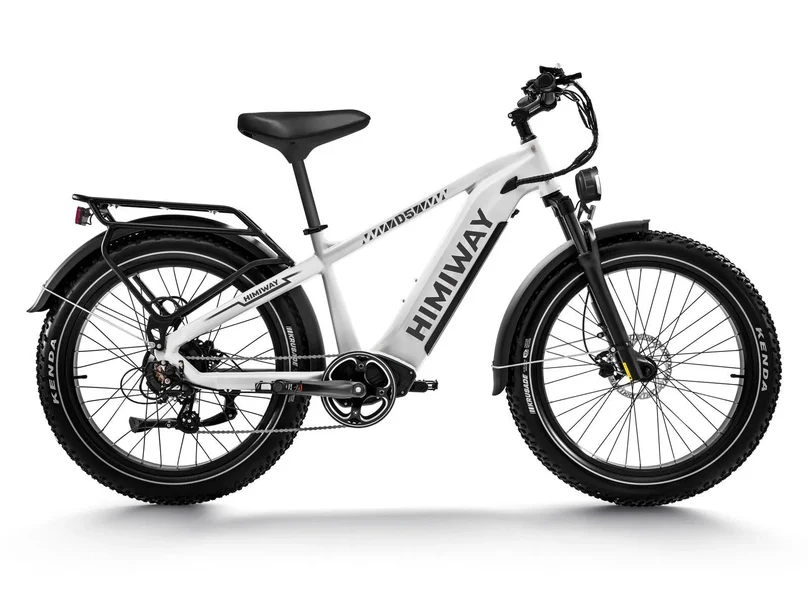
Are you a heavier rider looking for an electric bike that can keep up with your needs? Finding an e-bike that supports higher weight limits without sacrificing power or comfort can feel like a challenge. But don’t worry — the right e-bike is out there, and we’re here to help you find it.
Heavy riders face unique challenges when choosing an e-bike, from frame durability and motor strength to battery life and rider comfort. A bike that can safely carry your weight while delivering smooth, reliable power is essential to enjoy every ride — whether it’s a quick commute or a weekend adventure.
In this guide, you’ll discover the top e-bikes designed specifically for heavier riders, what features to look for, and expert tips to get the most from your electric bike. Ready to find your perfect ride? Let’s dive in.
What to Look for in an E-Bike for Heavy Riders
Choosing the right e-bike as a heavier rider means focusing on key features that ensure safety, power, and comfort. Let’s break down what really matters when shopping for the best e-bikes for heavy riders.
Weight Capacity
First and foremost, weight capacity is critical. Look for e-bikes with a minimum load limit of 300 pounds or more to ensure the frame and components can safely handle your weight.
The frame material plays a big role in durability:
- Aluminum frames are lightweight yet strong and common in most e-bikes.
- Steel frames offer extra toughness and flexibility but tend to weigh more.
- Carbon fiber is lighter and strong but usually reserved for premium bikes and may not always be ideal for heavier riders due to stiffness.
Motor Power
For heavier riders, a powerful motor makes all the difference — especially on hills or rough terrain. That’s where torque, or twisting force, comes into play. Higher torque means easier climbing and smoother acceleration.
You’ll usually find two types of motors:
- Mid-drive motors sit near the pedals and provide better balance and hill climbing power.
- Hub motors are located in the wheel and offer straightforward power, often at a lower cost.
For heavy riders, aim for at least a 750-watt motor. This power range offers enough strength to handle extra weight without slowing down.
Frame and Fork Strength
A strong frame is your bike’s backbone. Look for reinforced frames and wider forks designed to handle stress and weight over time.
Suspension also plays a role in comfort and control:
- Front suspension (forks) helps absorb bumps on rough roads.
- Full suspension (front and rear) offers extra comfort but can add weight and cost.
If you plan on riding off-road or on uneven paths, suspension can be a game-changer.
Braking System
With added weight, stopping power is crucial. Hydraulic disc brakes provide stronger, more consistent braking compared to mechanical brakes or rim brakes.
Also, consider rotor size — larger rotors (180mm or more) offer better heat dissipation and stopping power, which is important for heavy riders.
Battery and Range
More weight means your motor works harder, draining the battery faster. For this reason, prioritize e-bikes with larger battery capacities — ideally 600 watt-hours (Wh) or more.
Some e-bikes offer dual battery setups for riders who want to go the extra mile without worrying about running out of power.
Wheels and Tires
Wider tires help distribute weight more evenly and absorb shocks better. Consider fat tires (3.8 inches or wider) for extra stability and comfort.
Wheel sizes matter too:
- 26-inch wheels are sturdy and responsive.
- 27.5-inch wheels offer a nice balance of speed and control.
- 29-inch wheels roll over obstacles smoothly and are great for long rides.
Pro Tip:
Always check the bike’s official weight limit before buying — exceeding it can void warranties and risk damage. Also, consider upgrading to puncture-resistant tires for peace of mind on longer rides.
Ready to explore e-bikes that combine strength and style? In the next section, we’ll review some of the top models perfect for heavier riders in 2025.
Top E-Bikes for Heavy Riders (2025 Edition)
Looking for a strong, reliable e-bike that can comfortably support your weight and deliver smooth power? Here are the top models for heavy riders in 2025, featuring high weight limits, powerful motors, and rider-friendly features.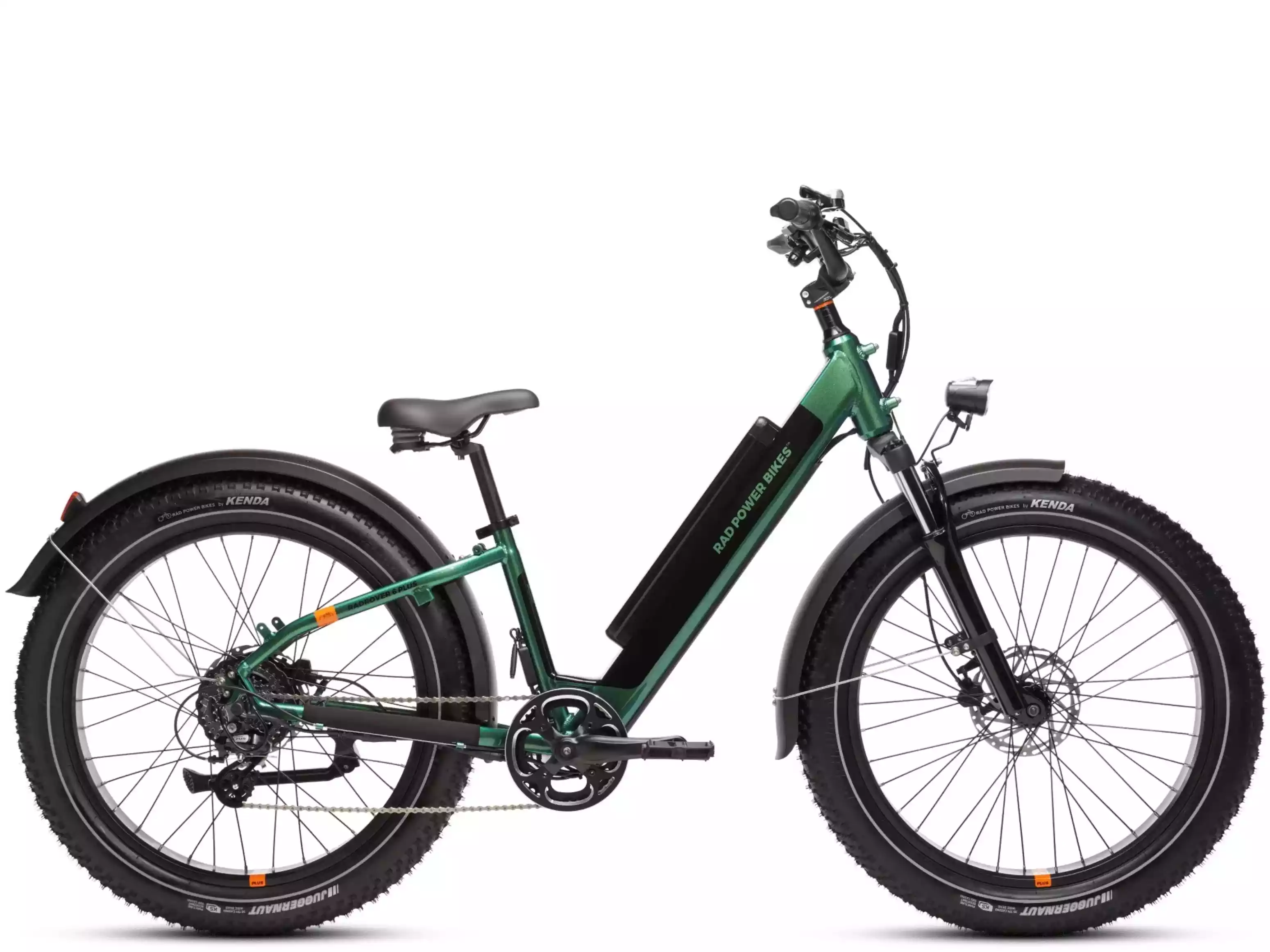
1. Rad Power Bikes RadRover 6 Plus
- Weight Limit: 275–300 lbs
- Motor: 750W geared hub motor
- Highlights: Fat tires for stability, optional step-through frame for easy mounting, integrated lights and fenders
- Why It’s Great: Offers a balanced mix of power and comfort at a solid price point, making it a favorite for city and trail riders alike
- Considerations: Heavier bike (74 lbs) and no included rear rack
- Price: Around $1,300
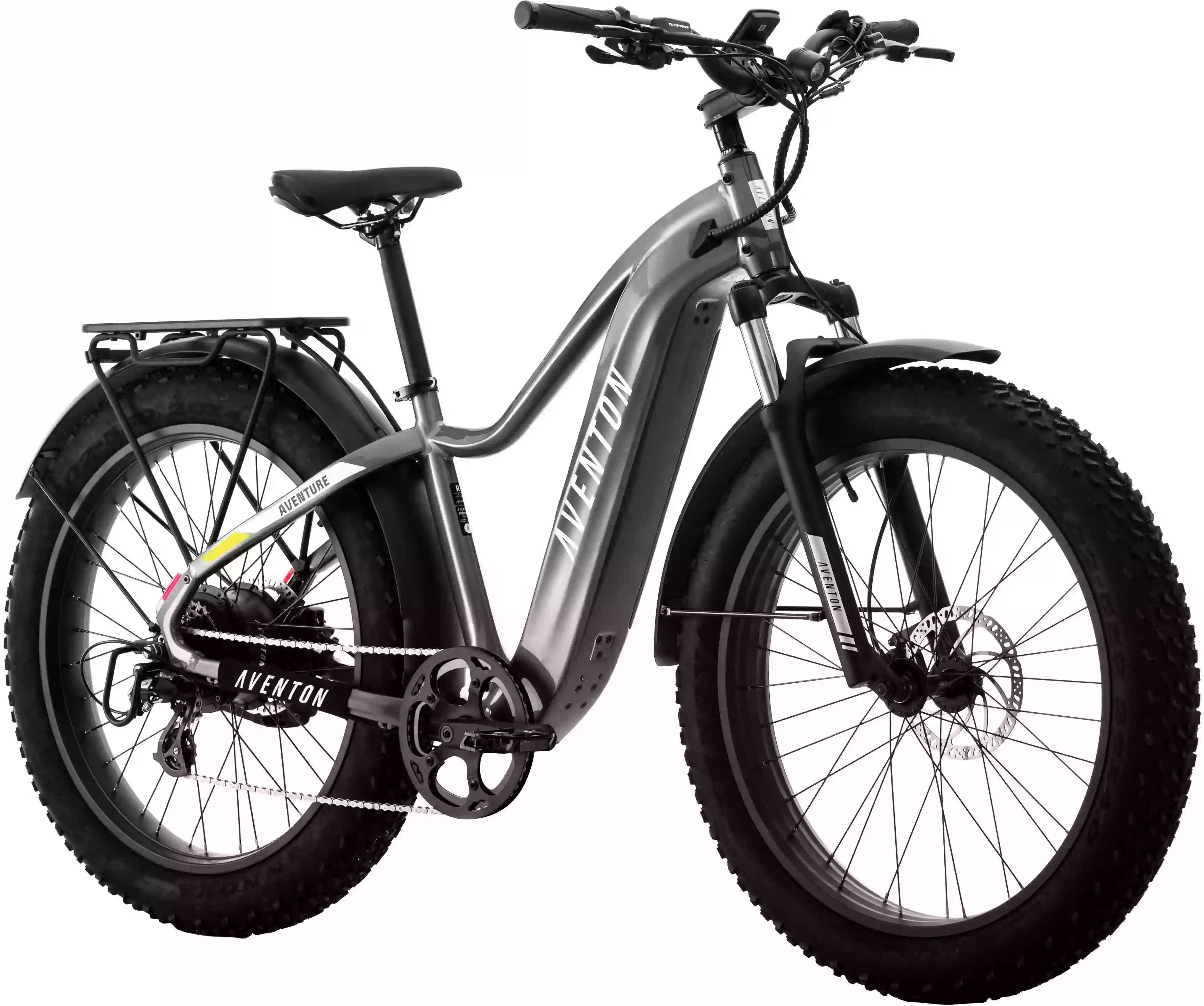
2. Aventon Aventure.2
- Weight Limit: 400 lbs
- Motor: 750W with torque sensor for smooth power delivery
- Highlights: Fully integrated battery, fat tires, turn signals, and front rack/fender options
- Why It’s Great: Combines rugged design with commuter-friendly features; excellent for heavier riders who want versatility
- Considerations: Slightly heavy (~77 lbs), not ideal for aggressive off-road trails
- Price: About $1,999

3. Himiway Zebra
- Weight Limit: 400 lbs
- Motor: 750W motor paired with a large 960Wh battery
- Highlights: Long range, stable fat tires, integrated lighting
- Why It’s Great: A budget-friendly powerhouse that doesn’t compromise on performance or load capacity
- Considerations: Finish and details not as refined as premium models; overall weight is on the heavier side
- Price: Approximately $1,699
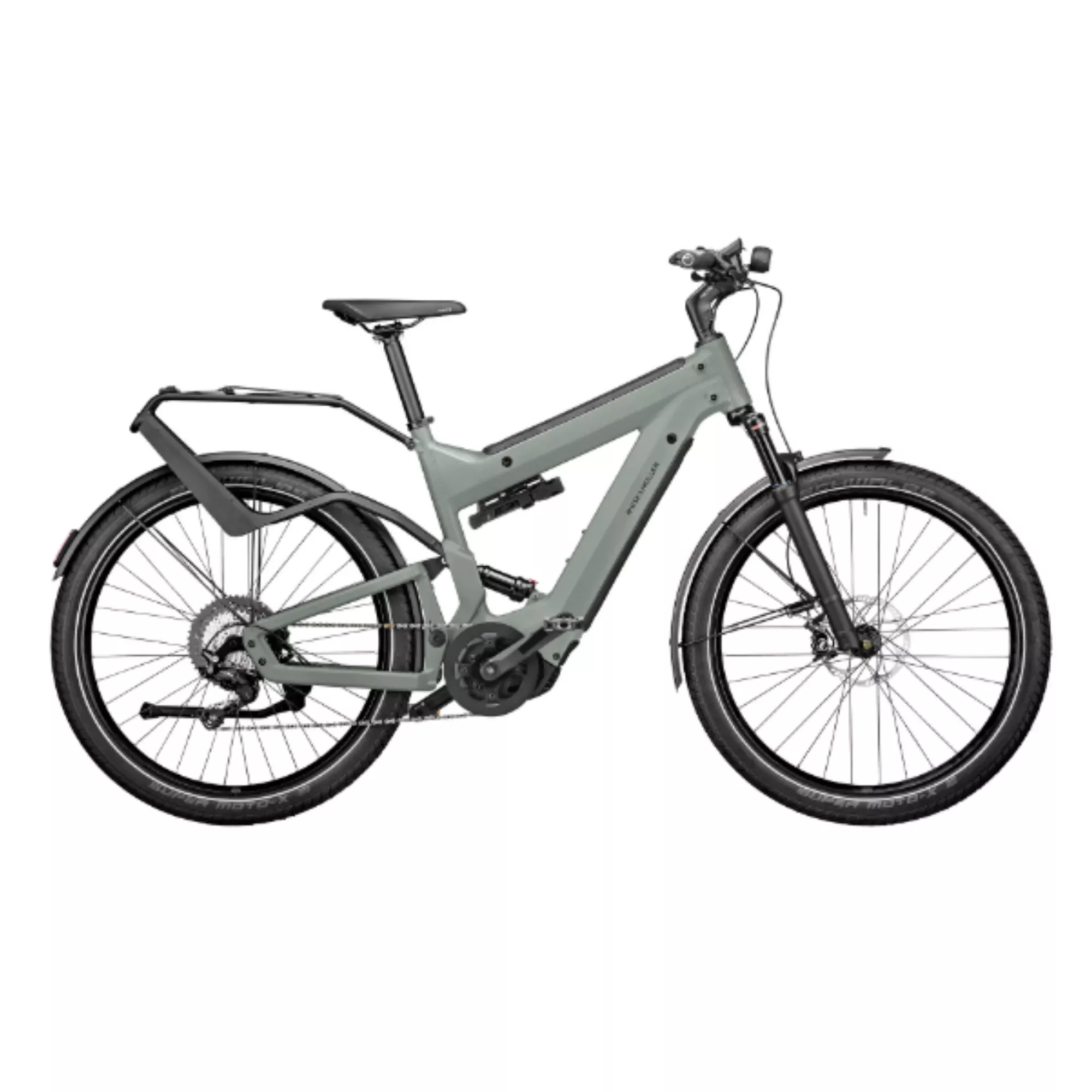
4. Riese & Müller Superdelite
- Weight Limit: About 350 lbs (customizable)
- Motor: Bosch high-end mid-drive motor with dual battery options up to 1,125Wh
- Highlights: Premium components, full suspension options, advanced electronics
- Why It’s Great: Top-tier durability and range for riders who want the best performance and comfort
- Considerations: Premium pricing ($8,000+), may be more bike than some need for daily use
- Price: $8,000–$12,000 depending on options

5. Cyrusher Kommoda
- Weight Limit: 330 lbs
- Motor: 750W motor with full suspension
- Highlights: Fat tires, adjustable seat height, step-through frame design
- Why It’s Great: Comfort-focused design ideal for taller or heavier riders looking for versatility on city streets and light trails
- Considerations: Brand is less known, heavier frame, styling may be polarizing
- Price: Around $1,799
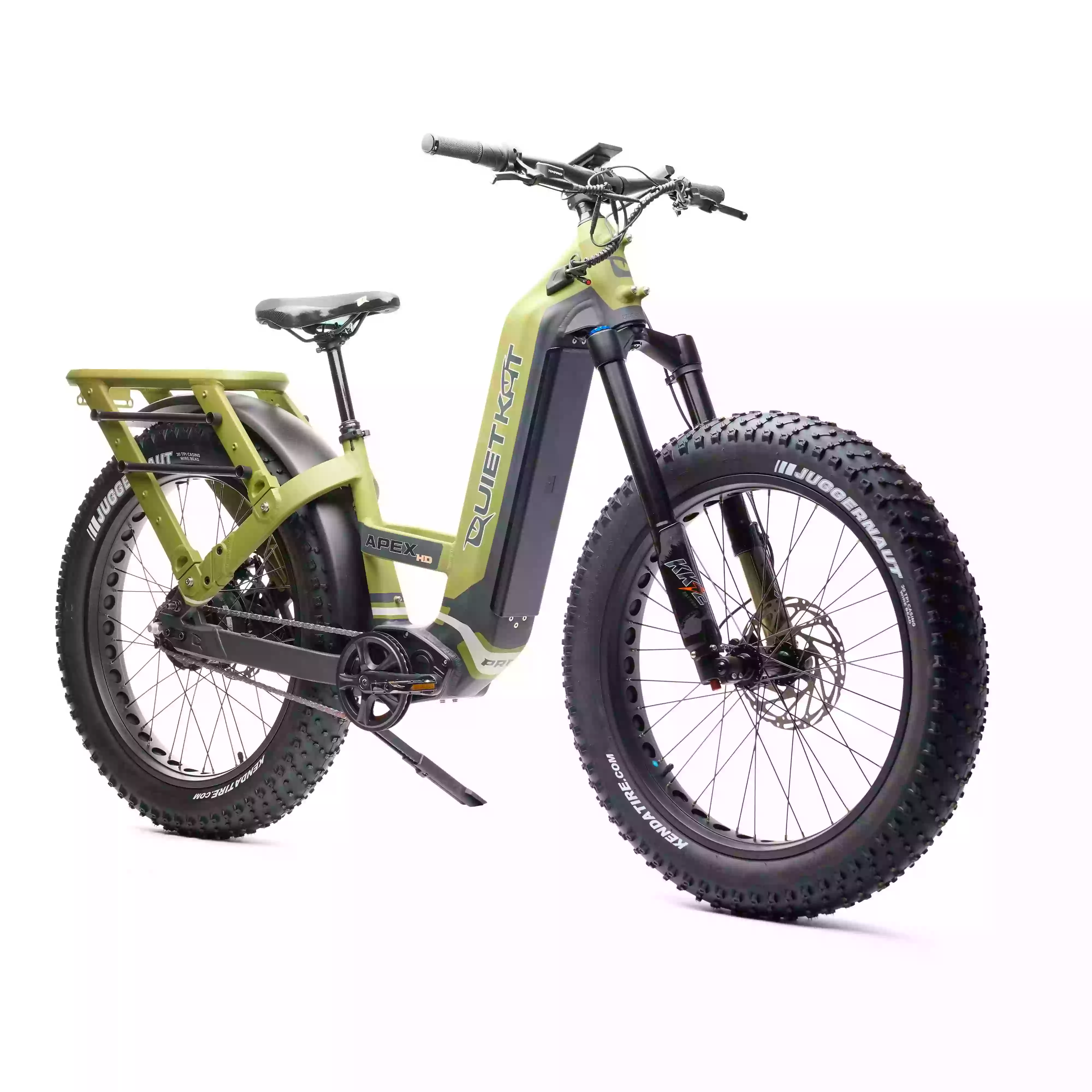
6. QuietKat Apex
- Weight Limit: 325 lbs
- Motor: Mid-drive motor with ultra-fat tires
- Highlights: Designed for off-road, hunting, and trail riding with rugged construction
- Why It’s Great: Excellent choice for adventure seekers who need a powerful, durable bike for tough terrain
- Considerations: Heavy and pricey, not ideal for city-only use
- Price: Roughly $5,000–$6,000
Pro Tip:
Look for fat tires and hydraulic disc brakes when shopping for heavy rider e-bikes—they improve stability and stopping power under load. Also, check if the bike includes integrated lights and racks if you plan on commuting.
With these solid options, heavy riders can find an e-bike that fits their lifestyle and weight needs without compromising on performance or comfort. Ready to ride? Check out detailed reviews and find your perfect fit today!
Honorable Mentions
Looking for even more options that pack a punch? These honorable mentions didn’t make the main list but are still fantastic choices for heavy riders. Whether you need extra power, customization, or value, these e-bikes are worth a serious look.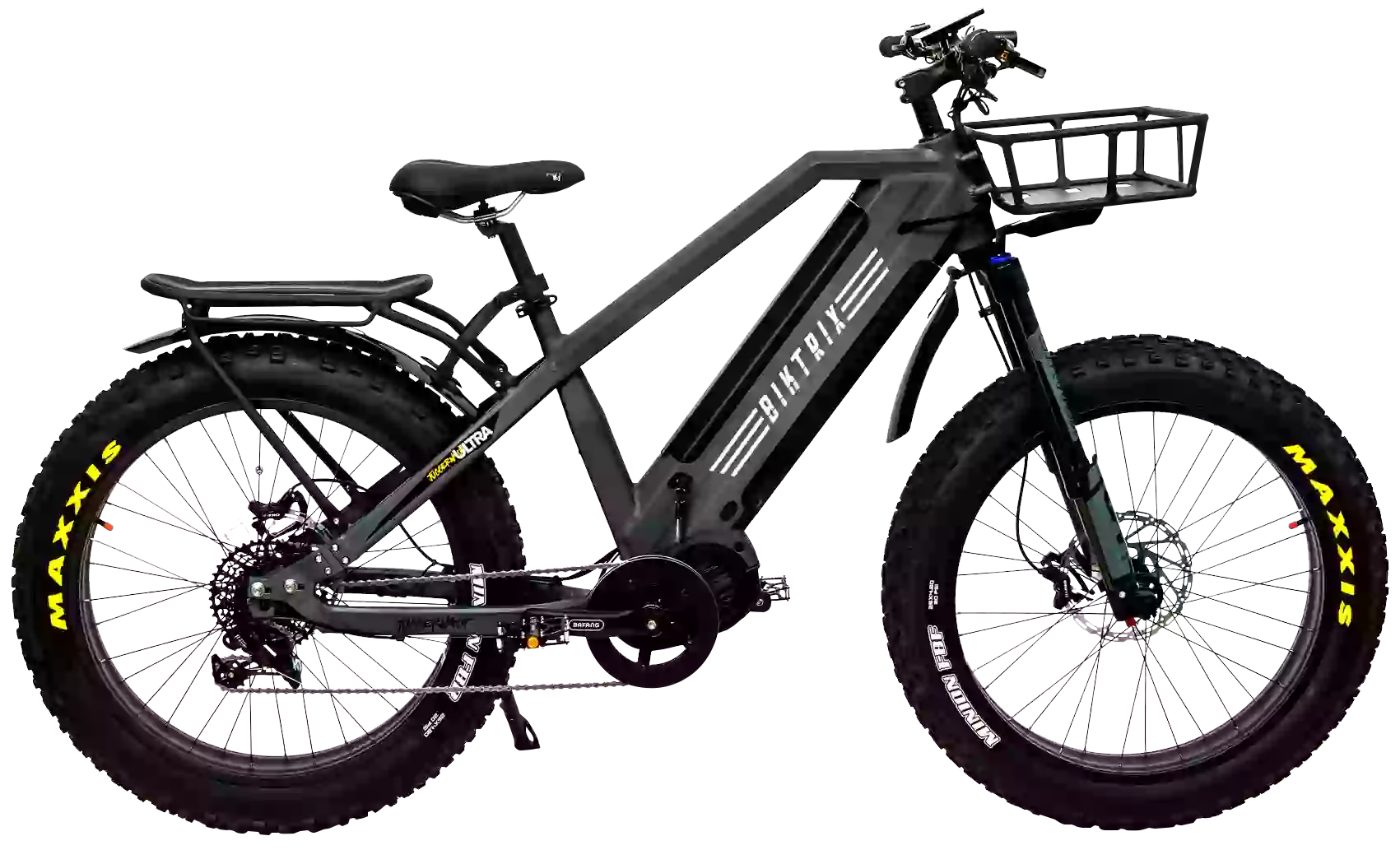
1. Biktrix Juggernaut Ultra Beast 2
- Motor: 750W or 1000W mid-drive
- Battery: Dual battery setup for extended range
- Weight Limit: 380–400 lbs (depending on configuration)
- Why It Stands Out: With powerful motor options and extreme range, this beast is built for serious riders who want all-day performance and torque to conquer hills with ease.
- Pro Tip: Ideal for riders over 300 lbs who also need long-distance range or plan to tow gear or a trailer.
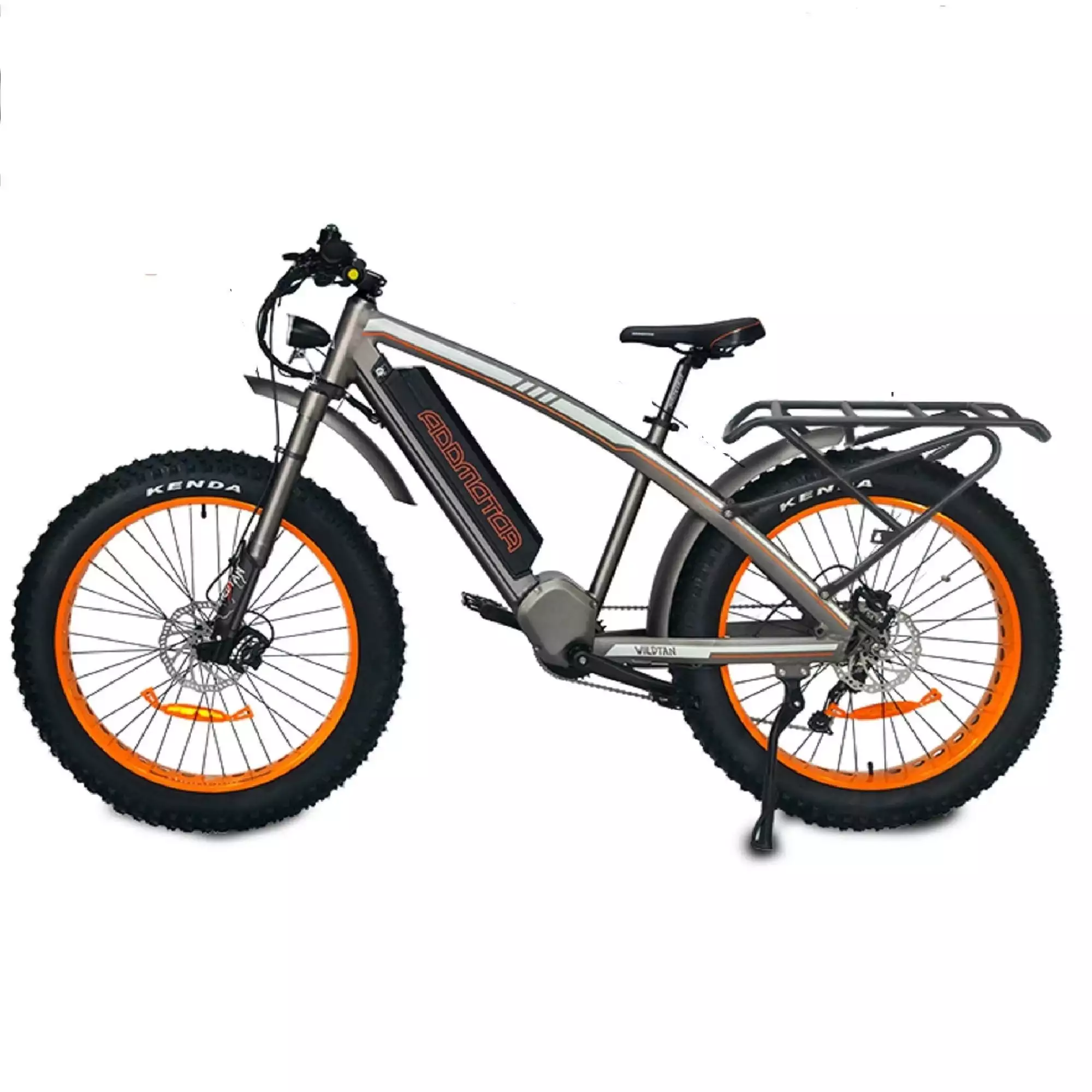
2. Addmotor M-5600
- Motor: 1000W Bafang mid-drive
- Features: Rugged frame, large fat tires, and integrated lighting
- Weight Limit: ~350 lbs
- Why It Stands Out: One of the best fat-tire e-bikes for heavy-duty use at a competitive price point. Its strong motor and solid build are perfect for off-road enthusiasts or riders in hilly areas.
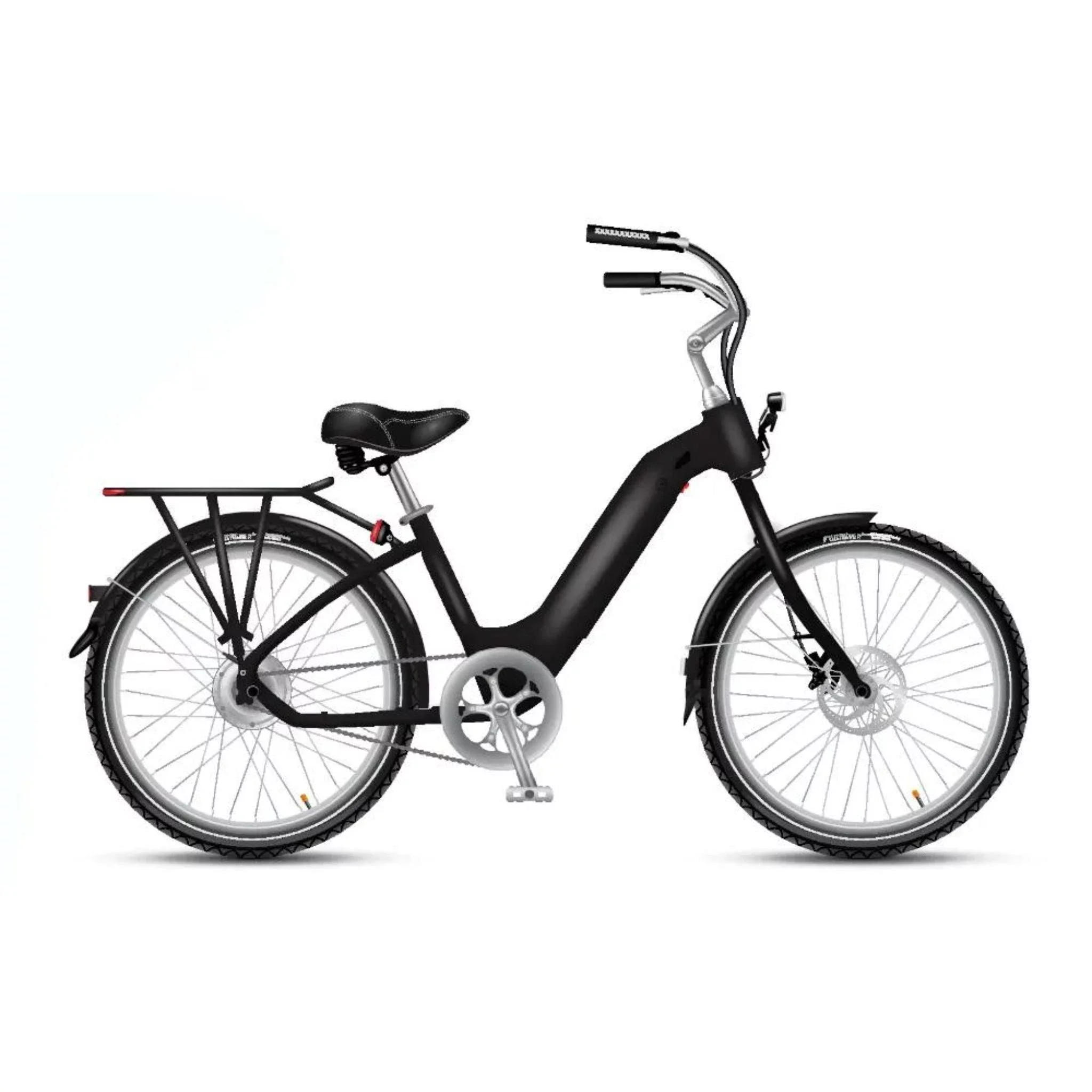
3. Electric Bike Company Model R
- Motor: Up to 750W rear hub
- Customization: Built-to-order in the USA with color, accessories, and frame style options
- Weight Limit: 350+ lbs depending on setup
- Why It Stands Out: If you want an e-bike tailored to your lifestyle, the Model R offers top-notch customization, comfort, and quality. Great for commuting, cruising, or cargo hauling.
Pro Tip:
If you’re on the higher end of the weight spectrum or plan to carry cargo, consider brands that offer custom builds or upgrade options — these often include stronger wheels, higher torque motors, and reinforced frames.
These honorable mentions round out our list of the best e-bikes for heavy riders in 2025. Whether you're after raw power, personalization, or unbeatable range, there’s something here to match your riding goals and body type.
Want help comparing features or finding the right fit? Check out our buyer’s guide or contact a local e-bike dealer for a test ride. You're just one ride away from feeling the freedom an e-bike brings.
Let me know if you'd like a downloadable version or if you'd like to keep going with the rest of the article!
Tips for Heavy Riders
Whether you're new to e-biking or upgrading to a more powerful ride, these quick tips can help heavier riders stay safe, comfortable, and confident on every trip.
1. Keep an Eye on Tire Pressure and Brake Wear
Your tires and brakes work harder when carrying more weight. Check tire pressure weekly and keep it within the recommended PSI to avoid flats and improve efficiency. Also, inspect brake pads regularly, especially if you’re using the bike for daily commutes or hilly terrain.
Pro Tip: Use puncture-resistant or thicker tires if you often ride on rough or gravel paths.
2. Upgrade for Comfort
Factory saddles don’t always cut it. Consider replacing your seat with a wider, cushioned saddle designed for heavy riders. A suspension seatpost also helps absorb bumps and reduce fatigue on longer rides.
3. Be Ready on the Road
Always carry a mini pump, multitool, and patch kit—just in case. Heavier loads can put extra stress on components, and a quick fix can keep your ride going.
4. Look for Throttle Options
Many of the best e-bikes for heavy riders include a throttle assist, which helps you start from a complete stop without having to pedal hard. This is especially helpful at traffic lights, on hills, or when starting with added cargo.
Pro Tip: Throttle can also give your knees a break—great for joint protection on longer rides.
By following these tips, you’ll extend the life of your e-bike and improve every ride’s comfort and safety. Combine the right gear with smart habits, and you’ll be cruising with confidence.
Ready to explore your options? Up next, we’ll tackle some of the most frequently asked questions from heavier riders just like you.
6. FAQs
Still have questions about choosing the best e-bike for heavy riders? You’re not alone. Here are some quick answers to common questions to help you ride with confidence.
Q1: Can a 250W motor support a heavy rider?
Not really. While a 250-watt motor might technically move a heavier rider, it will struggle on hills, wear out faster, and feel sluggish. For better performance and longevity, we recommend at least a 500W–750W motor, especially if you're riding on inclines or carrying gear.
Pro Tip: More torque equals better hill-climbing power. If you live in a hilly area, prioritize mid-drive motors with high torque.
Q2: Are fat tires better for heavier riders?
Yes—fat tires offer better weight distribution, traction, and comfort. They help smooth out the ride, especially on rough roads or gravel trails, and can handle higher PSI ranges to support heavier loads.
Look for tires 3 inches or wider and consider puncture-resistant liners or slime-filled tubes for extra protection.
Q3: What if I weigh over the bike’s stated limit?
It’s not recommended. Exceeding the weight limit can lead to frame damage, poor handling, brake failure, and it often voids the warranty. Always look for bikes with a published weight capacity higher than your body weight—ideally with room to spare for cargo or gear.
Have more questions? Drop them in the comments or connect with your local e-bike dealer for a personalized test ride. Finding the right e-bike is all about matching your body, your needs, and your ride style—and you’re already on the right path.
Up next: Let’s wrap it all up and get you ready to roll.
Wrap Up:
Choosing the best e-bike for heavy riders isn’t just about weight limits—it’s about unlocking a smoother, more comfortable, and more confident ride. When you match your body type with the right frame, motor, and features, every ride becomes easier, safer, and more enjoyable.
Don’t settle for “good enough.” Test ride a few models, explore suspension and seating upgrades, and consider how the bike fits into your daily life—whether that means commuting, weekend adventures, or just cruising for fun.
Pro Tip: A strong frame and a powerful motor aren’t just about performance—they give you the confidence to ride farther, faster, and more often.
Remember:
- Strong frame = durability and safety
- Powerful motor = smoother rides and easier hills
- Right fit = long-term comfort and fun
With so many exciting options in the 2025 electric bike market, there’s never been a better time to ride. Whether you're 260 lbs or 400+, your perfect e-bike is out there—and it's ready to roll.
Ready to ride? Explore our top picks and e-bike buying guides to find your ideal match today.
Additional Resources for Teen E-Bike Riders
Just getting started or looking to level up your e-bike setup? Here are some extra tools, guides, and tips to help teens ride smarter, safer, and more confidently.
Find the Right Fit: Sizing Guides
One of the most common mistakes in buying an e-bike—especially for teens—is choosing the wrong size. A proper fit makes all the difference in comfort, control, and safety.
Here are some helpful links:
- REI’s Electric Bike Sizing Chart
- Lectric eBike Frame Fit Guide
- Two Wheeling Tots: Kid & Teen Bike Size Reference
🛠️ Pro Tip:
Most teen e-bikes fall between 24" and 27.5" wheels. If you're in between, size down for control or up for room to grow.
Gear Up: Safety Essentials Teens Actually Want to Wear
Riding safe doesn’t have to mean looking lame. These accessories blend protection and style:
- Helmet: Look for MIPS-certified helmets with ventilation and cool color options
- Reflective gear: Add reflective ankle straps, backpack decals, or tire spoke lights
- Padded shorts or gloves: For longer rides, these make a big difference in comfort
- Lock & light combo sets: Easy add-ons for daily commuting or school rides
📦 Pro Tip:
Bundle up gear at the time of bike purchase—many retailers offer a discount if you buy safety gear with a bike.
Maintenance Made Easy: Teen-Friendly Checklists
Keep your e-bike in top shape with simple monthly checks:
- ✅ Tire pressure (aim for what’s printed on the sidewall)
- ✅ Brake test before every ride
- ✅ Wipe the chain and lube it once a month
- ✅ Charge the battery before it dips below 30%
Some apps even remind you when it's time for a tune-up!
Stay Curious, Stay Safe
Want to learn more? Explore teen e-bike forums, YouTube maintenance tutorials, or your local bike shop’s event calendar for free classes.
🎯 Find your fit. Gear up. Ride smart.
Looking for the best e-bike for your teen? Check out our full review section and start comparing top models today.

Tired of running out of juice mid-ride? Whether you’re commuting across town, tackling cross-country trails, or delivering all day, long-range e-bikes are here to change the game. In 2025, battery technology has taken a huge leap forward—giving riders more freedom, fewer charge stops, and a smoother ride every mile.
In this guide, we’ll break down the best long-range electric bikes of 2025, what makes them stand out, and how to choose the right one for your lifestyle.
What Makes an E-Bike "Long Range"?
When we say “long range,” we’re talking 60+ miles per charge—and some 2025 models now exceed 100 real-world miles. That’s not just lab-tested marketing speak. These bikes are built for serious distance.
A few key factors contribute to extended range:
- Battery Size (Watt-Hours): Look for bikes with 700Wh or more—some even pack 1500Wh with dual batteries.
- Motor Efficiency: Mid-drive motors tend to stretch your miles farther than hub motors.
- Assist Mode Use: Lower assist = longer range. Simple.
- Terrain & Conditions: Hills, wind, weight, and tire pressure all impact how far you’ll go.
Pro Tip: Range estimates on product pages are often best-case scenarios. Real-world mileage depends on how you ride, so always check rider reviews!
Top Long-Range E-Bikes in 2025 by Category
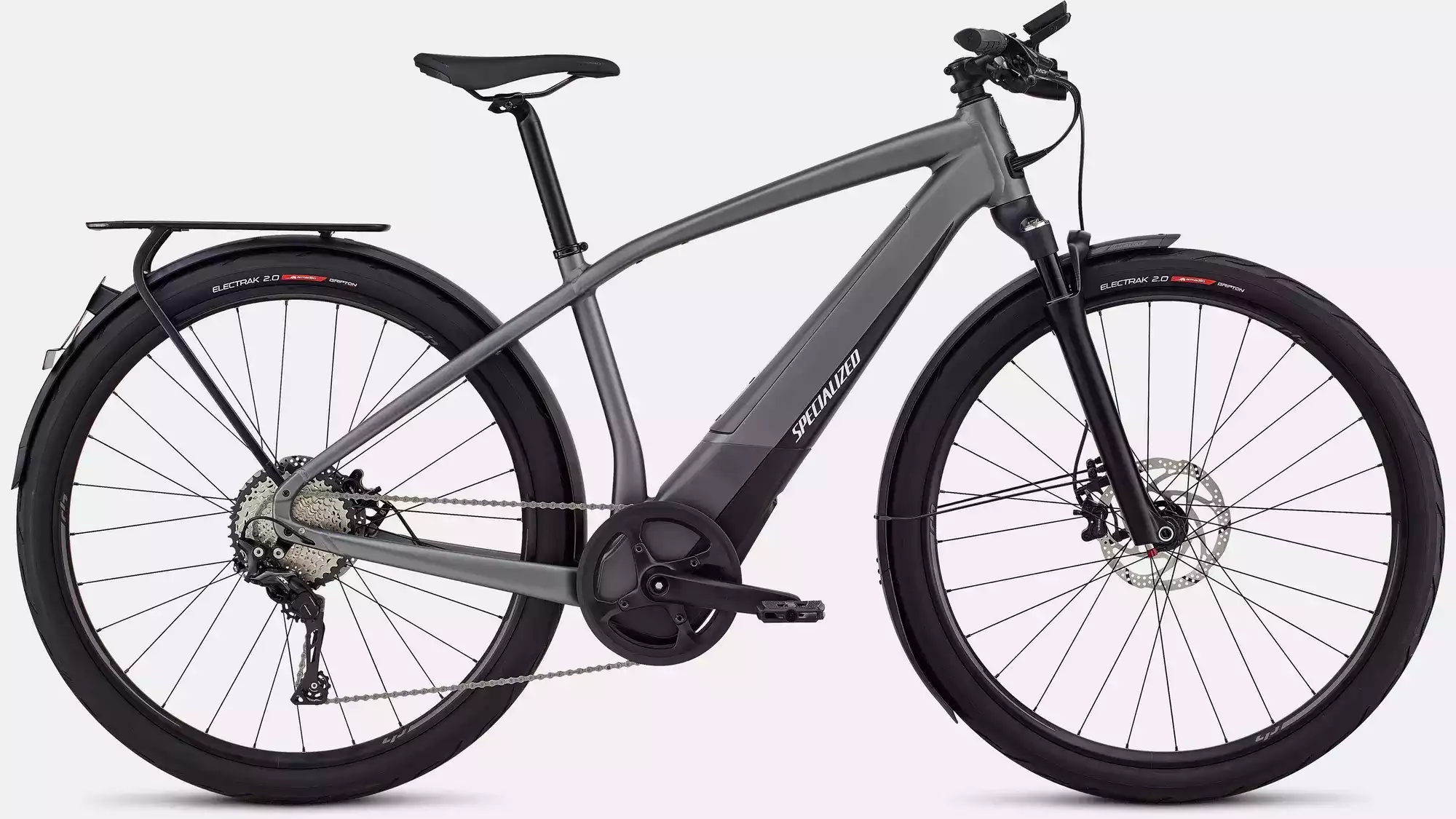
🚴 Best Overall: Specialized Turbo Vado 6.0 IGH
- Real-World Range: 100–120 miles
- Battery: 710Wh with optional range extender
- Why It Rocks: Smooth mid-drive motor, automatic shifting, premium comfort for any distance
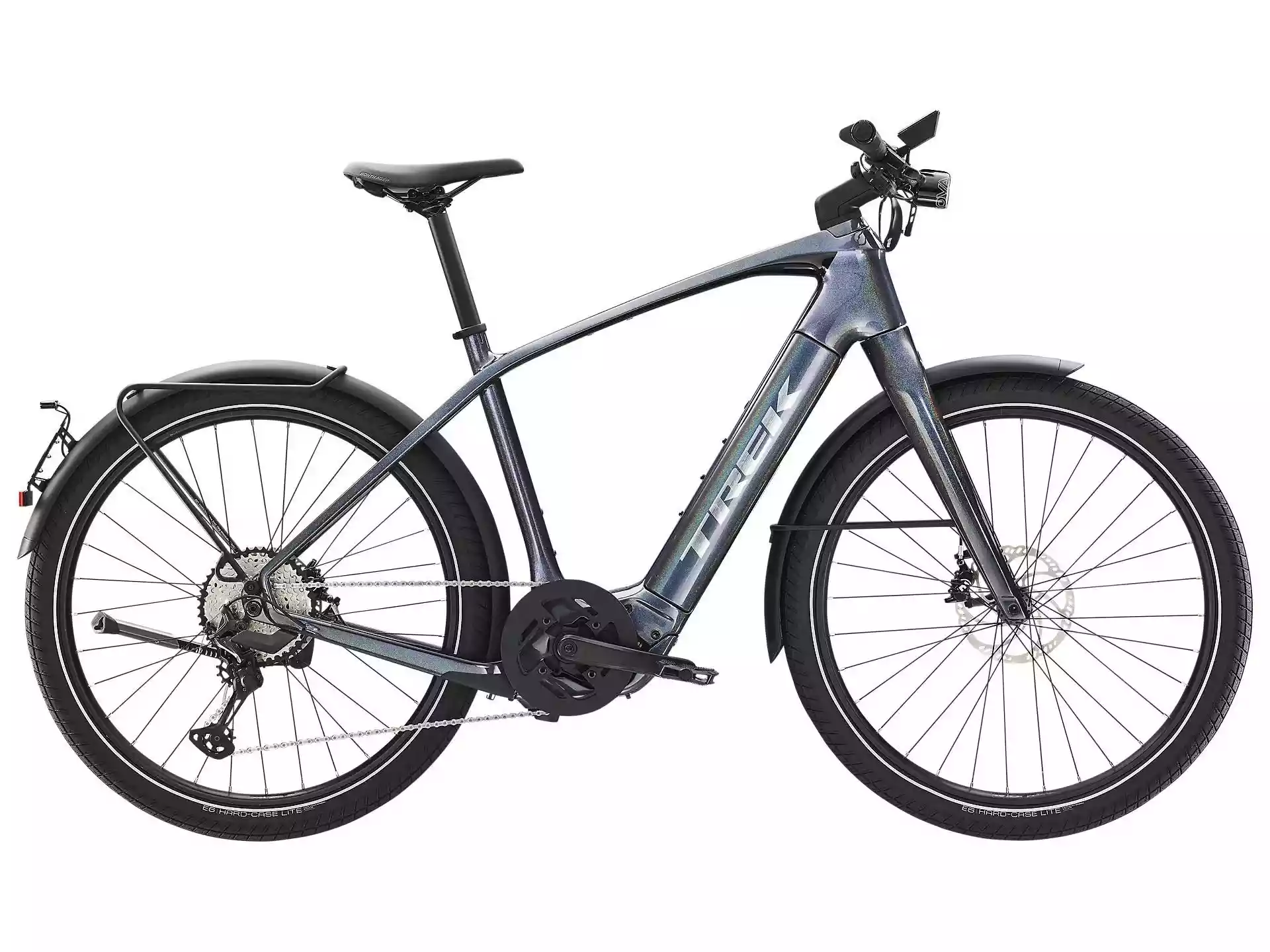
🏙️ Best for Commuting: Trek Allant+ 9.9S
- Real-World Range: Up to 100 miles
- Battery: Bosch 625Wh + dual battery support
- Why It’s Smart: Sleek look, integrated lights, and enough range for a full week of rides
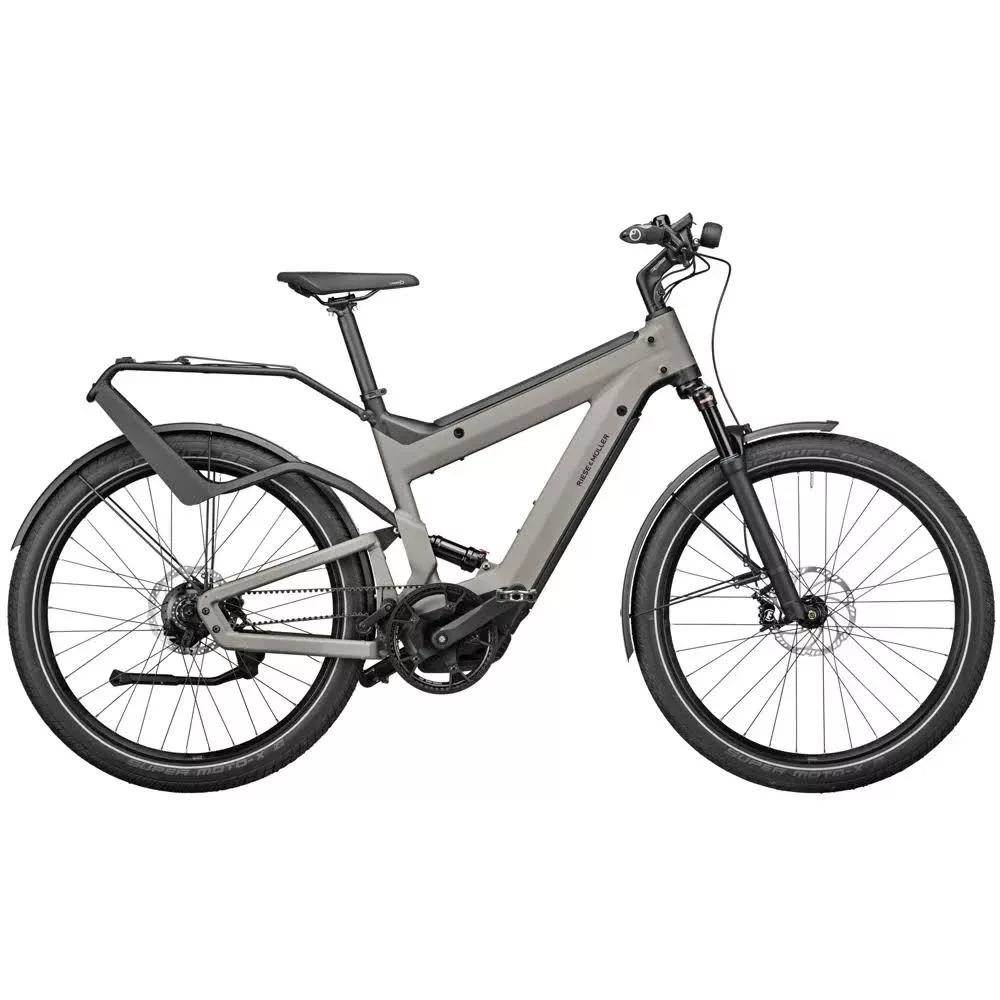
🌄 Best for Touring & Adventure: Riese & Müller Superdelite GT Rohloff
- Real-World Range: 120+ miles
- Battery: Dual 1125Wh
- Adventure-Ready Features: Full suspension, rugged frame, and built-in GPS display
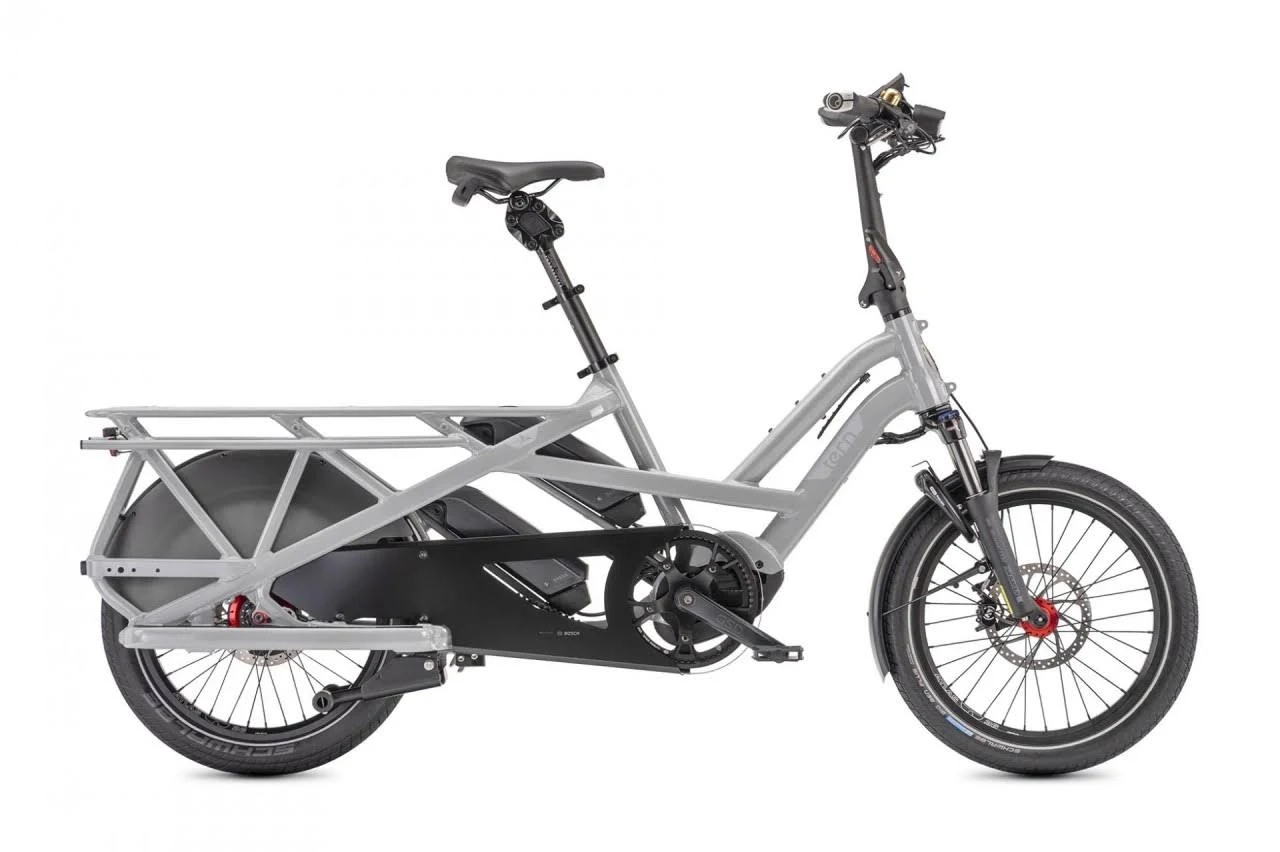
🛒 Best Long-Range Cargo E-Bike: Tern GSD R14
- Real-World Range: 75–100 miles
- Battery: Dual Bosch 1000Wh
- Why Families Love It: Hauls kids, groceries, or gear without breaking a sweat
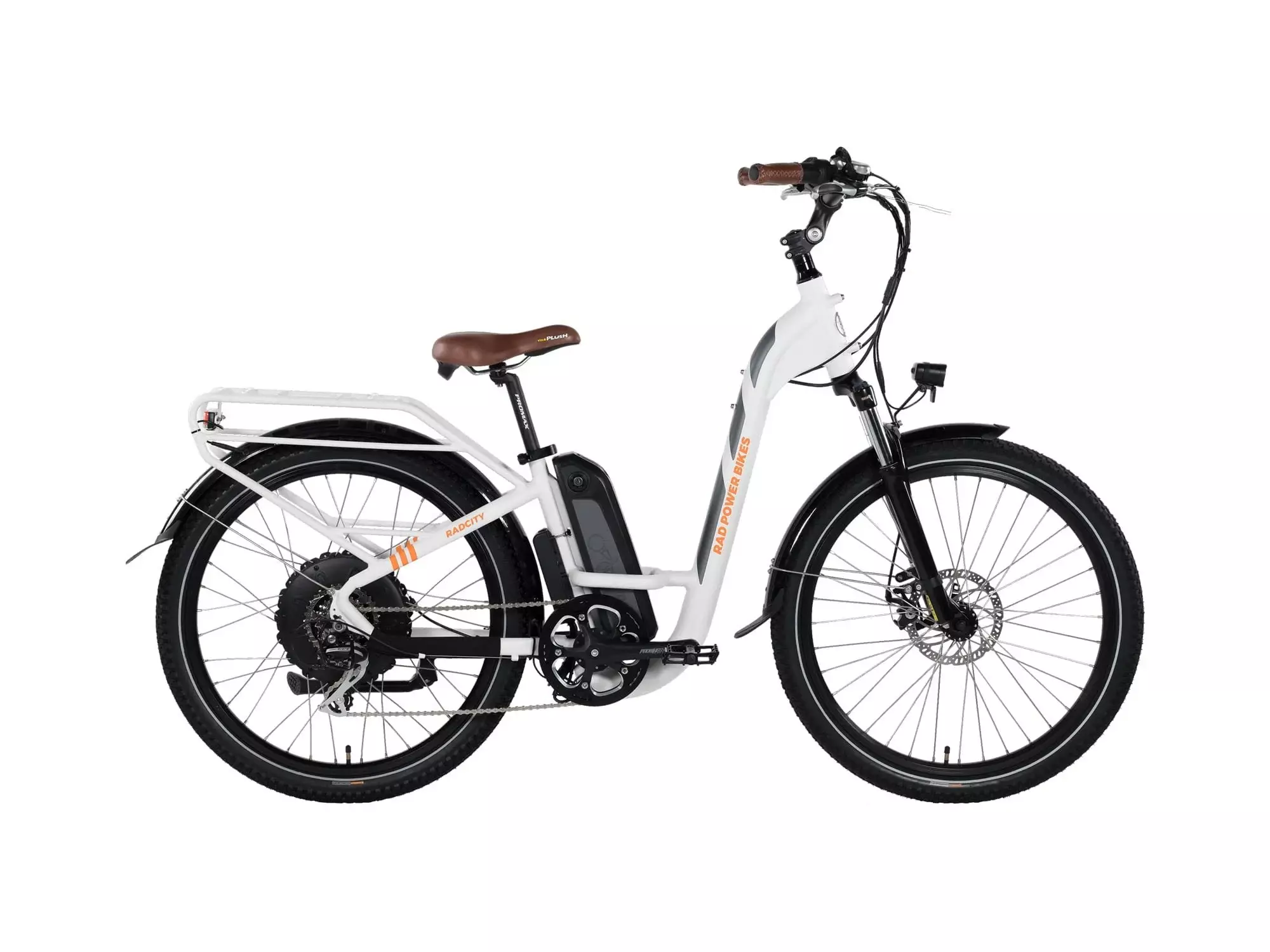
💰 Best Budget Long-Range Pick: Rad Power RadCity 5 Plus
- Real-World Range: 50–65 miles
- Battery: 672Wh
- Solid Value: Under $2,000, step-through frame, and a super comfy upright ride
Battery Specs & Comparison Table
| Model | Range (mi) | Battery (Wh) | Drive Type | Price | Ideal For |
|---|---|---|---|---|---|
| Specialized Turbo Vado 6.0 | 100–120 | 710+extender | Mid-drive | $5,500+ | Daily & distance |
| Riese & Müller Superdelite GT | 120+ | Dual 1125Wh | Mid-drive | $8,000+ | Adventure touring |
| Trek Allant+ 9.9S | ~100 | 625Wh | Mid-drive | $5,000+ | Commuting |
| Tern GSD R14 | 75–100 | Dual 1000Wh | Mid-drive | $6,500+ | Cargo/family use |
| RadCity 5 Plus | 50–65 | 672Wh | Hub-drive | ~$1,999 | Budget commuting |
Want More Miles Per Charge? Try These Tips
- Keep tires inflated to reduce drag
- Use Eco or low-assist mode on flat roads
- Avoid full-throttle starts—ease into your ride
- Lighten your load where you can
- Charge before you hit 0% to extend battery lifespan
Pro Tip: Cold weather can reduce range. If you're riding year-round, store your battery indoors when possible.
Why Choose a Long-Range E-Bike?
Long-range e-bikes are ideal for:
- Commuters traveling 15–30+ miles daily
- Bikepackers & explorers riding off the grid
- Delivery riders who need full-shift endurance
- Anyone who hates charging every day
Yes, they cost more—but the convenience, flexibility, and peace of mind are worth every dollar.
Final Thoughts: Go Far, Ride Easy
Electric bikes are already changing the way we move—but long-range models unlock true freedom. No more charging every night. No more worrying about the last few miles. Just ride farther, faster, and smarter.
Ready to ditch range anxiety?
Explore the best long-range e-bikes of 2025 and find your perfect match today.
What Counts as “Long Range” in 2025?
Wondering what "long range" really means in today’s electric bike world? Here’s how 2025 is redefining distance on two wheels.
Just a few years ago, getting 40 miles from a single e-bike charge felt impressive. Now, thanks to battery breakthroughs and smarter motors, many of the best e-bikes in 2025 can easily double—or even triple—that.
So what’s considered long range today? Let’s break it down.
Today’s Long-Range Benchmark: 60+ Real-World Miles
In 2025, a true long-range e-bike isn’t just about the spec sheet—it’s about what you actually get on the road. Here’s the new gold standard:
- 60+ miles per charge in real-world conditions (think hills, cargo, and wind)
- 100+ miles advertised under ideal settings (flat roads, eco mode, light rider)
- Some models even push 120+ miles with dual-battery setups
That’s enough to ride to work and back all week—or go on a weekend bikepacking trip without reaching for a charger.
Pro Tip: Advertised range is often based on low-assist, flat-terrain testing. Look for real-world range tests in rider reviews before you buy.
Battery Terms Made Simple
Not sure what battery numbers really mean? Here’s a quick guide to the specs that matter most in any 2025 e-bike buying guide:
- Watt-Hours (Wh): This is your fuel tank. A 750Wh battery stores more energy (and offers more miles) than a 500Wh one.
- Dual-Battery Systems: Some e-bikes let you connect two batteries for double the range—great for touring or delivery riders.
- Regenerative Braking or Solar Assist: While still emerging, these tech add-ons can help slightly extend range by recharging the battery as you ride.
Bigger Batteries, Smarter Systems
What’s fueling the leap in range isn’t just more capacity—it’s smarter energy use. In 2025, you’ll see:
- Mid-drive motors that deliver more torque using less power
- Auto-adjust assist levels that optimize energy on the fly
- Built-in range estimators that update in real time as you ride
These features make it easier than ever to plan longer rides with confidence—and fewer surprises.
Long story short?
If you’re shopping for the best long-range e-bike in 2025, start with bikes offering at least 700Wh of battery power or dual-battery capability. Then look at how efficiently that energy is used—not just how much of it there is.
Ready to cover more ground?
Up next, we’ll look at the top long-range e-bikes by category so you can find one that fits your ride.
Key Features of High-Range E-Bikes
Want to ride farther without the worry of running out of battery? These are the must-have features behind the best long-range e-bikes of 2025.
If you're shopping for a long-range electric bike, it’s not just about slapping on a big battery. The best models in 2025 combine power, efficiency, and smart design to stretch every charge as far as possible.
Below are the top features to look for when comparing bikes in any e-bike buying guide.
Big Battery Capacity (700Wh–1500Wh+)
The most obvious feature? A big battery.
- Wh (Watt-hours) tells you how much energy your battery holds.
- Most long-range e-bikes in 2025 start around 700Wh.
- Premium models now go up to 1500Wh or higher, especially with dual-battery options.
Pro Tip: Think of watt-hours like a gas tank—the more Wh, the farther you can go.
Dual-Battery Compatibility
Need to ride for hours (or days) at a time? Look for dual-battery support. This setup:
- Doubles your range without stopping to charge
- Keeps weight balanced with smart frame integration
- Often includes automatic switching between batteries mid-ride
Great for adventure riders, commuters, and delivery cyclists.
Efficient Motors (Mid-Drive Preferred)
Motor type plays a big role in range. In general:
- Mid-drive motors are more energy-efficient and better for climbing hills
- Hub motors are simpler and cheaper but drain the battery faster on inclines
- Look for torque sensors—they adjust power based on how hard you're pedaling, saving energy
Bikes with efficient motors often deliver better real-world mileage—even with smaller batteries.
Smart Assist Systems
Long-range e-bikes in 2025 are smarter than ever. Many now include:
- Auto-adjusting assist modes that adapt to terrain
- Eco modes for maximizing battery life
- Phone-connected apps that track battery usage and performance
These tools let you ride longer without thinking too much about settings.
Aerodynamic, Lightweight Frames
Battery life isn’t just about electronics—it’s about design. The best long-range models feature:
- Lightweight frames that reduce drag
- Internal cabling to improve airflow and style
- Rigid or full-suspension frames built for distance and comfort
Less resistance = less power needed = more miles.
Integrated Displays + Range Estimators
Finally, don’t overlook the display unit. A quality one shows:
- Battery level and real-time range estimates
- Current assist mode and trip stats
- Navigation or GPS (on high-end models)
This info helps you ride smarter, adjust as needed, and avoid running out of power mid-trip.
Bottom Line:
When you're comparing the best long-range electric bikes of 2025, look beyond battery size. Pay attention to how the motor, frame, and onboard tech all work together to get the most out of every charge.
Up next? Let’s break down the top-performing long-range e-bikes by category so you can find one that fits your ride style.
Best Long-Range E-Bikes by Category (2025)
Looking for an electric bike that can go the distance? These top picks deliver serious range, performance, and value—tailored to how you ride.
Whether you're commuting 20 miles a day, hauling cargo, or riding off-grid for days, there's a long-range e-bike built for your lifestyle. Below, we’ve rounded up the best long-range electric bikes of 2025, broken down by category to help you compare real-world range, features, and price points.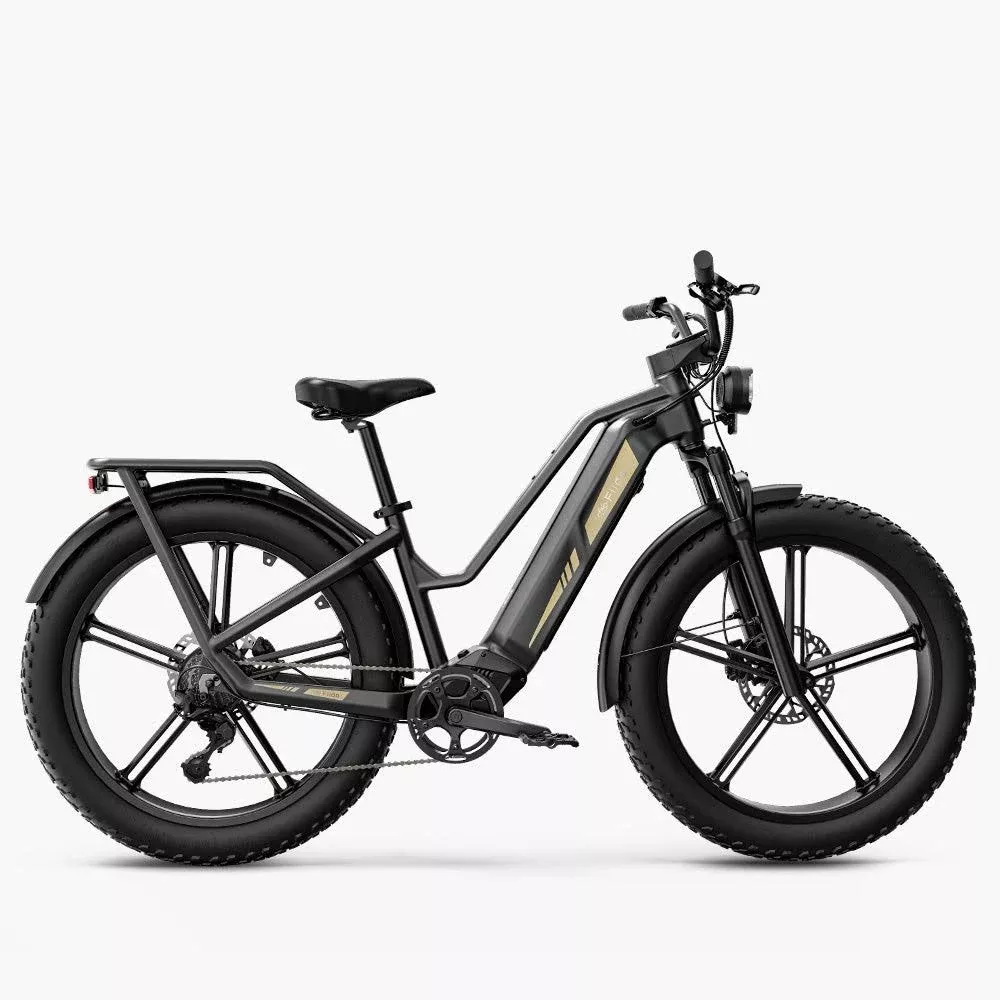
Best Overall Long-Range E-Bike: Fiido Titan
- Max Range: Up to 250 miles (with 3 batteries; ~85–100 miles per battery)
- Battery Setup: Modular 960Wh batteries; supports up to 3 at once
- Highlights:
- Massive payload support (200kg+)
- Excellent for long-haul or off-grid riding
- Rugged design with fat tires and solid suspension
- Downside: Heavy when fully loaded; cost increases with extra batteries
- Best For: Riders who prioritize range above all—cross-country tours, bikepacking, heavy cargo trips
Pro Tip: You don’t have to run all 3 batteries. Start with one and upgrade later as needed.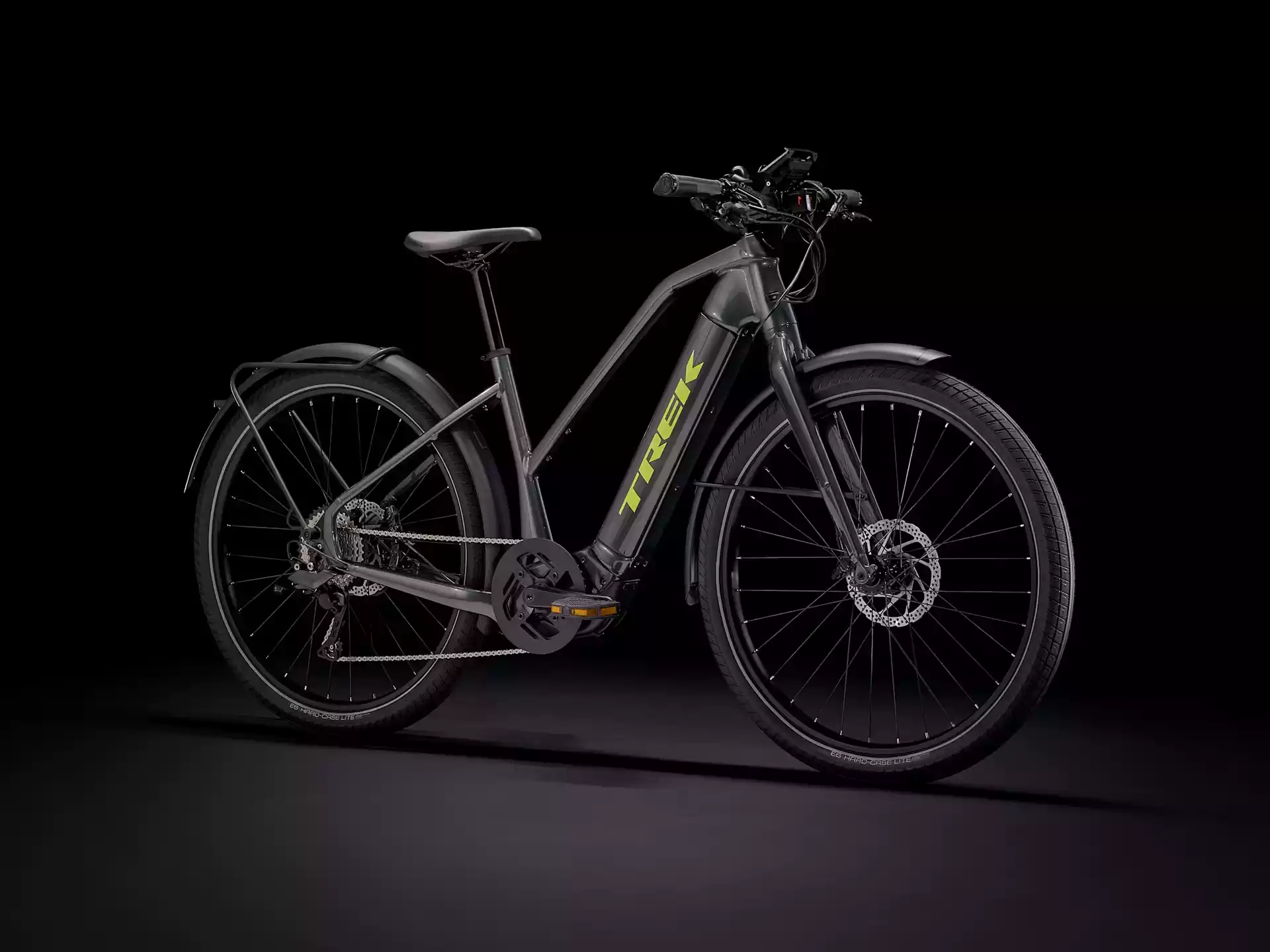
Best Commuting E-Bike: Trek Allant+ 8S / 9S
- Real-World Range: 80–100 miles (with dual battery)
- Battery Setup: Bosch PowerTube system; dual up to 1125Wh
- Highlights:
- Bosch Performance Line Speed mid-drive
- Integrated commuter features: lights, fenders, rear rack
- Sleek, low-profile urban design
- Downside: High price point with upgrades; dual-battery adds weight
- Best For: Urban professionals, daily commuters, tech-savvy riders who value style and speed
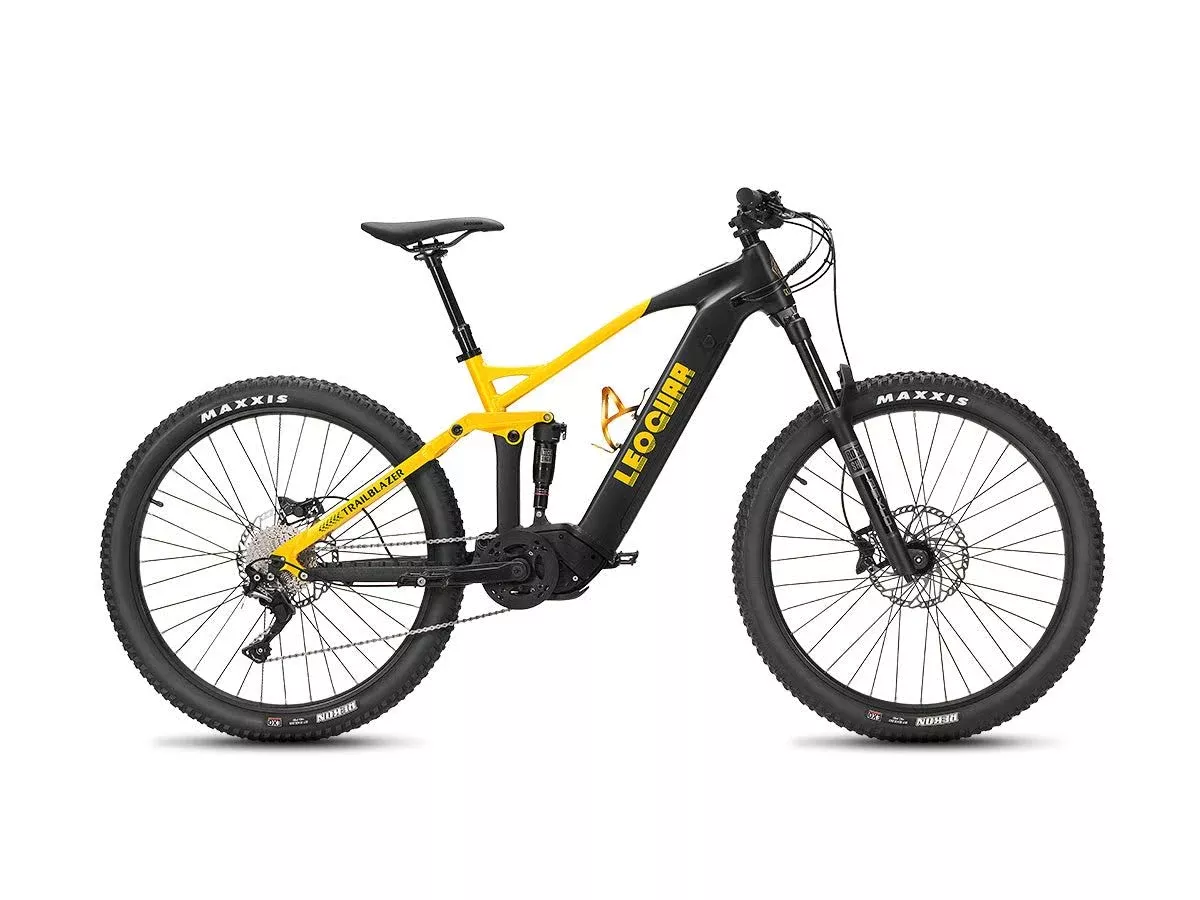
Best for Touring & Adventure: Leoguar Trailblazer EMTB
- Real-World Range: 95–105 miles
- Battery Setup: Dual 720Wh batteries
- Highlights:
- Full suspension, powerful mid-drive motor
- Power management system handles varied terrain
- Built tough for off-road and long-distance trips
- Downside: Bulkier than urban models; trail-focused design isn’t for everyone
- Best For: Bikepackers, mountain adventurers, and riders planning multi-day excursions
Alternative: Riese & Müller Superdelite GT Rohloff – German luxury build, 120+ mile range, premium components (at a premium price)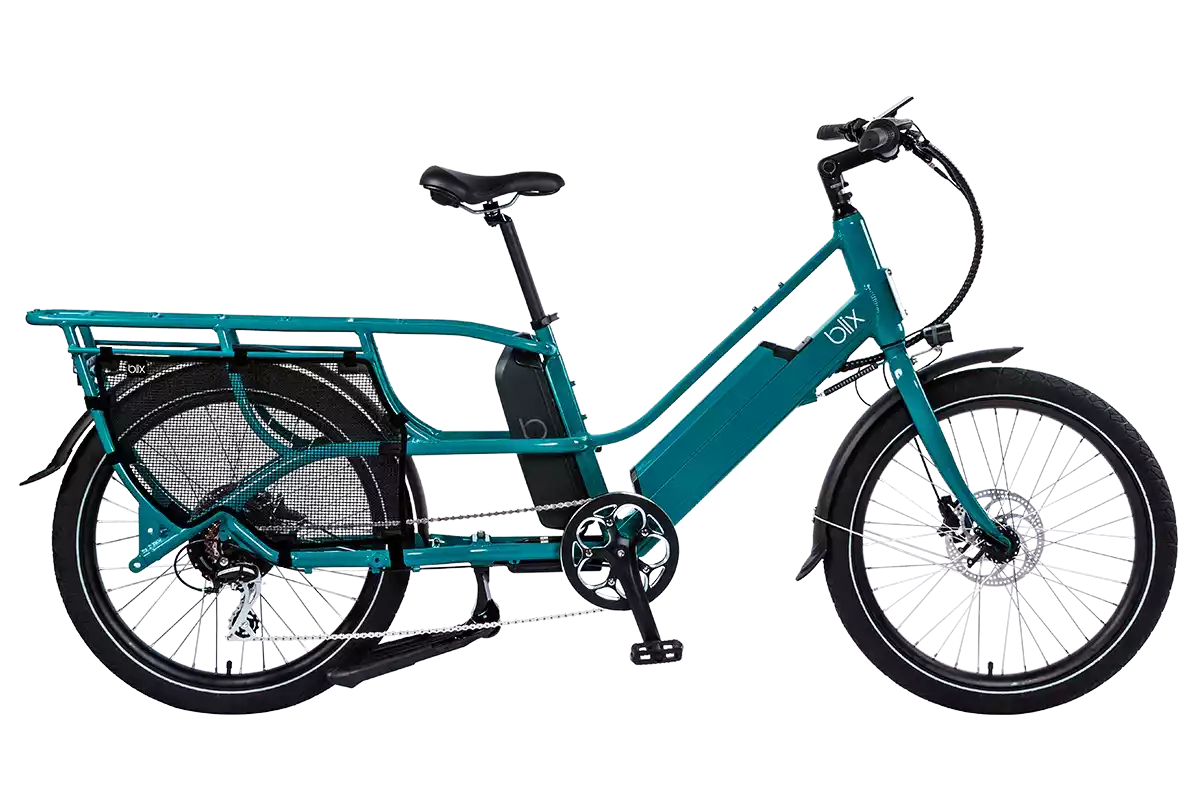
Best Cargo E-Bike: Blix Packa Genie (Dual Battery)
- Max Range: Up to 80 miles with dual 28Ah batteries
- Highlights:
- 24” wheels for stability when loaded
- Rear rack holds up to 242 lbs
- Modular accessories and safety features included
- Downside: No suspension; standard single-battery version has average range
- Best For: Families, delivery riders, or anyone hauling groceries, gear, or passengers over longer distances
Alternative: Tern GSD R14 – High-end Bosch Cargo Line motor, up to 100-mile range, best-in-class cargo features
💰 Best Budget Long-Range E-Bike: Qiolor Tiger RL
- Real-World Range: Up to 60 miles (more with upgraded battery)
- Battery Setup: 48V 13Ah standard
- Highlights:
- 750W motor with 85Nm torque
- Retro styling with modern performance
- Hydraulic brakes, fat tires, great value for the price
- Downside: Heavier than average; limited range on full power
- Best For: Budget-conscious commuters, students, or anyone seeking value and decent distance
Other Solid Budget Pick: Aventon Aventure 2 – 65–75 mile range, torque sensor, rugged feel, very competitive price
🔍 At-a-Glance Comparison Chart
| Category | Best Pick | Max Range | Battery Setup | Key Features | Price Range |
|---|---|---|---|---|---|
| Overall | Fiido Titan | Up to 250 | 3 × 960Wh modular | Max range, heavy-duty build | $1,499+ |
| Commuting | Trek Allant+ 8S / 9S | 80–100 | Dual Bosch PowerTube | Sleek, commuter-ready, fast | $5,000+ |
| Touring | Leoguar Trailblazer EMTB | 95–105 | Dual 720Wh | Off-road capable, full suspension | $3,000+ |
| Cargo | Blix Packa Genie | Up to 80 | Dual 28Ah | Affordable cargo hauler | $2,199 |
| Budget | Qiolor Tiger RL | Up to 60 | 48V 13Ah (upgradeable) | Stylish, strong torque, great value | $1,399 |
Choosing the Right Long-Range E-Bike for You
Not all long-range e-bikes are built the same—and that’s a good thing. Whether you want maximum distance, cargo space, or just a smarter way to commute, the right model will make every mile easier.
Still deciding?
Compare range, motor type, and use case. Prioritize what you need most—speed, comfort, hauling power, or simply the longest ride possible.
Ready to go the distance?
Explore these 2025 electric bike reviews, take a test ride, and get ready to redefine how far you can go on two wheels.
Top Long-Range E-Bike Models: Side-by-Side Comparison
Trying to choose the best long-range e-bike for your needs? This chart makes it easy to compare range, price, and features at a glance.
Not all electric bikes are built the same—and when it comes to long-distance performance, the details matter. Whether you're prioritizing value, premium power, or all-out adventure range, this comparison table will help you quickly spot the best fit for your ride.
Use this as your go-to 2025 e-bike buying guide when narrowing down your top picks.
| Model | Real-World Range | Battery (Wh) | Drive Type | Price | Best For |
|---|---|---|---|---|---|
| Model A | ~100 miles | 750Wh + optional extender | Mid-drive | $5,999 | Long-distance touring |
| Model B | ~80 miles | 625Wh | Hub motor | $1,999 | Urban commuting on a budget |
| Model C | 120+ miles | Dual 1000Wh | Mid-drive | $8,500 | Backcountry & expedition |
What These Specs Really Mean
- Real-World Range tells you how far you’ll go under normal riding conditions—hills, wind, moderate assist mode—not idealized lab tests.
- Battery Size (Wh) shows your energy storage. Bigger means longer range, but it also adds cost and weight.
- Drive Type: Mid-drive motors offer better hill climbing and range. Hub motors are cheaper but less efficient on tough terrain.
- Best For helps match each bike to your riding goals—whether it’s daily use or weekend getaways.
Pro Tip: Going with a mid-drive motor and dual battery setup can often double your range without doubling your effort.
Still Deciding? Here’s How to Choose:
- For budget-conscious riders: Look at mid-range hub-drive bikes with 600–700Wh batteries.
- For serious commuters: Go for dual battery options and built-in lights, racks, and fenders.
- For long-range adventurers: Prioritize full suspension, rugged tires, and 1000Wh+ battery setups.
Your Next Ride Is Closer Than You Think
From city streets to mountain trails, the best electric bikes of 2025 offer more range and flexibility than ever. Use this comparison as your launchpad, then dive deeper into reviews or test rides.
Ready to ride farther? Find your perfect long-range e-bike today.
Tips to Maximize Your E-Bike Range
Want to squeeze more miles out of every charge? These practical habits can stretch your e-bike’s range—no upgrades required.
You don’t need a 1,000Wh battery to go the distance. With a few smart riding and maintenance habits, you can boost your e-bike’s real-world range and get more out of every ride. Here’s how to ride smarter and farther.
1. Keep Your Tires Properly Inflated
Low tire pressure creates more rolling resistance, which drains your battery faster. Check your pressure weekly and inflate according to the recommended PSI on the sidewall.
- Use e-bike-rated tires for better efficiency and durability
- Consider smooth or semi-slick tread if you ride mostly on pavement
Pro Tip: A floor pump with a pressure gauge makes tire checks quick and accurate.
2. Ride Smoothly and Use the Right Assist Level
Maxing out your pedal assist or constantly using throttle might feel fun—but it burns through your battery fast.
- Use lower assist modes (Eco or Tour) whenever possible
- Try steady, consistent pedaling instead of stop-and-go bursts
- Use gears wisely to keep your cadence efficient on hills
3. Minimize Throttle Use
If your e-bike has a throttle, use it sparingly. Throttles pull more power because the motor does all the work, especially when starting from a stop or climbing hills.
- Pedal to start moving, then engage throttle if needed
- Limit full-throttle bursts unless absolutely necessary
4. Reduce Extra Weight
The heavier your load, the harder your motor has to work.
- Remove unnecessary accessories (like unused racks or bags) when not needed
- Pack light for daily rides or commutes
- For cargo bikes, distribute weight evenly to avoid drag
Even a few pounds can make a difference over longer distances.
5. Take Care of Your Battery
Your battery is your fuel tank—treat it well and it’ll last longer, both per charge and overall.
- Avoid letting the battery fully deplete before charging
- Store indoors when not in use—extreme heat or cold can reduce performance
- Charge to 80–90% for daily rides to extend long-term battery health
Pro Tip: If you won’t ride for a while, store your battery at around 50% charge.
Max Range = Smart Riding + Simple Maintenance
The best long-range e-bikes of 2025 are designed to go far, but how you ride and care for them matters just as much. Keeping your tires dialed in, riding smart, and babying your battery can easily add 10–20% more range—no upgrades needed.
Looking to ride farther with confidence?
Pair these habits with the right long-range e-bike, and you’ll be amazed how far you can go.
Pros and Cons of Long-Range E-Bikes
Thinking of going the distance? Here’s what to love—and what to consider—before buying a long-range electric bike.
Long-range e-bikes are built to travel farther and handle more demanding rides, whether you’re commuting across town or adventuring into the wilderness. But with extra range comes a few trade-offs. Let’s break down the benefits and drawbacks so you can make the smartest choice for your ride style.
✅ Pros of Long-Range E-Bikes
1. No More Range Anxiety
You won’t constantly worry about running out of juice mid-ride. Long-range models offer 60 to 100+ miles of real-world riding—enough for full-day commutes, weekend trips, or delivery shifts.
2. Ideal for Daily Use or Off-Grid Exploration
Whether you're biking to work five days a week or heading off the beaten path, these e-bikes are made for reliable, extended performance. They’re especially great for:
- Touring cyclists
- Delivery riders
- Off-grid campers or bikepackers
3. Higher Resale Value
Because battery size and motor quality are top selling points, long-range models often hold value better over time. A large battery with low charge cycles? That’s a win for secondhand buyers.
Pro Tip: Keep your battery maintained and include its health stats when reselling to boost buyer confidence.
⚠️ Cons of Long-Range E-Bikes
1. Heavier Frames
More battery means more weight. Long-range e-bikes can feel bulky, especially with dual-battery setups. That affects:
- Hill climbs (if pedaling unassisted)
- Lifting and transporting the bike
- Maneuverability in tight spaces
2. Higher Upfront Cost
Expect to pay more for bigger batteries and better motors. Long-range models often start around $2,000 and can exceed $6,000+ with top-tier features.
3. Longer Charge Times
A 1000Wh battery can take 6–10 hours to fully recharge. You can mitigate this with:
- Fast chargers
- Dual-battery rotation (charge one while using the other)
- Smart planning between rides
Should You Go Long-Range?
If you’re a casual weekend rider who only logs a few miles, a long-range e-bike might be overkill. But if you want freedom from frequent charging, flexibility for longer trips, and a bike that can grow with your needs—long-range is worth it.
Next up: We’ll link you to helpful tools to estimate range, explore more models, and book a test ride. Ready to ride smarter and farther? Let’s roll.
Who Should Buy a Long-Range E-Bike?
Wondering if a long-range e-bike is right for you? If your rides are long, frequent, or unpredictable—read on.
Not every rider needs 80+ miles of range, but for many, a long-range electric bike makes daily life easier, cheaper, and more fun. Here’s who benefits most from the added capacity, and why it might be worth the upgrade.
🚲 1. Daily Commuters (15+ miles per day)
If your round-trip commute covers more than 10–15 miles, a long-range model will let you go multiple days without charging—a big win for convenience.
- Skip charging every night
- Ride in higher assist modes without worry
- Extra range for detours or errands
Pro Tip: Look for models with integrated lights, racks, and weather protection to make commuting seamless.
🌄 2. Rural or Suburban Riders
When destinations are spread out and bike lanes are rare, having 70–100+ miles of range means less stress about finding charging stops.
- Ideal for riders in hilly or open countryside
- Great for weekend trips into town or nature
- Range buffers against terrain changes and elevation
🏕️ 3. Bikepackers and Tour Cyclists
Long-range e-bikes open up true off-grid exploration. You can carry camping gear, explore national parks, or ride trails without worrying about the next outlet.
- Dual batteries = more freedom
- Pair with solar charging or dynamo hubs for multi-day rides
- Best when paired with rugged builds and mid-drive motors
🛵 4. Delivery Riders and Gig Workers
If your income depends on covering miles, more range equals more orders, less downtime, and fewer mid-shift recharges.
- Look for models with swappable or hot-swappable battery setups
- Range helps when GPS takes you on longer routes
- Save time and earn more without worrying about range limits
💡 5. Anyone Who Hates Charging
Maybe you're not a daily commuter—but you'd rather ride all week and charge once. Long-range bikes let you ride on your schedule, not your charger’s.
- Perfect for students, city dwellers, or multi-purpose riders
- Less battery stress = better ride enjoyment
- Works great with solar or garage charging setups
Bottom Line:
If you ride far, ride often, or simply want to ride worry-free, a long-range e-bike is a smart, future-proof investment. The extra mileage pays for itself in time, flexibility, and peace of mind.
Final Thoughts: Why Long-Range E-Bikes Are Worth It
Still on the fence? Here’s why going the distance could be the smartest move you make this year.
If you’re serious about riding—whether that means commuting daily, hauling gear, or exploring the unknown—a long-range e-bike is a total game changer. These bikes aren’t just about numbers on a spec sheet—they’re about the freedom to ride farther, stress less, and do more.
Freedom That Fits Your Lifestyle
When you don’t have to think about charging every night or cutting your trip short, you can focus on the joy of the ride. Whether you're zipping through the city or planning a weekend escape, range equals flexibility.
- Test ride before you buy—range feels different for everyone
- Think long-term: dual-battery systems give you room to grow
- Choose models that match your terrain and use case
Pro Tip: Bring a backpack or gear bag to your test ride—you’ll want to feel what real use looks like.
Range Is More Than Miles—It’s Possibility
The best long-range e-bikes of 2025 let you reimagine what’s possible on two wheels. With smart features, powerful batteries, and comfortable builds, these bikes make practical riding exciting—not a chore.
So whether you're aiming to reduce car trips, ride farther without limits, or simply want the best gear for your lifestyle, a long-range e-bike is a smart, future-ready investment.
Ready to ride without limits?
Explore top models, compare features, and find the best long-range e-bike for your 2025 adventures.
Additional Resources for Long-Range E-Bike Buyers
Want to dive deeper? These tools and guides will help you make the most informed choice—and get more out of every mile.
Choosing the best long-range e-bike isn’t just about specs—it’s about how it performs in your real-world rides. Whether you’re comparing models, planning a cross-state tour, or just curious about how far you can go on a single charge, these resources will help you ride smarter and farther.
🔋 Battery Comparison Charts
Understand how different batteries stack up by capacity, size, weight, and charge times. These visual guides make it easy to compare:
- Watt-hour (Wh) ratings
- Estimated real-world range by bike type
- Charging speeds with standard vs. fast chargers
Resource: E-Bike Battery Comparison Tools →
📏 Real-World Range Calculators
Don’t rely only on manufacturer estimates. Input your own weight, assist level, terrain, and weather to get a personalized range estimate.
- Adjust for cargo loads or dual-battery setups
- Great for planning long commutes or tours
- Helps match your needs to the right motor and battery combo
Resource: Bosch Range Assistant →
Pro Tip: Use a range calculator before you buy to avoid surprises on your first ride.
🗺️ Long-Distance E-Bike Route Maps (U.S.)
Explore scenic, bike-friendly routes across the country optimized for e-bike riders.
- National and state-level trails
- Charging stations, campgrounds, rest stops
- Elevation profiles and traffic conditions
Resource: Adventure Cycling Route Network →
🧭 Reviews from Long-Distance Riders
Get firsthand insights from riders who have logged 500+ miles on their e-bikes.
- Honest pros and cons after extended use
- Tips on battery life, comfort, and maintenance
- Ideal for choosing between similar models
Resource: r/ebikes Long-Range Reviews Thread →
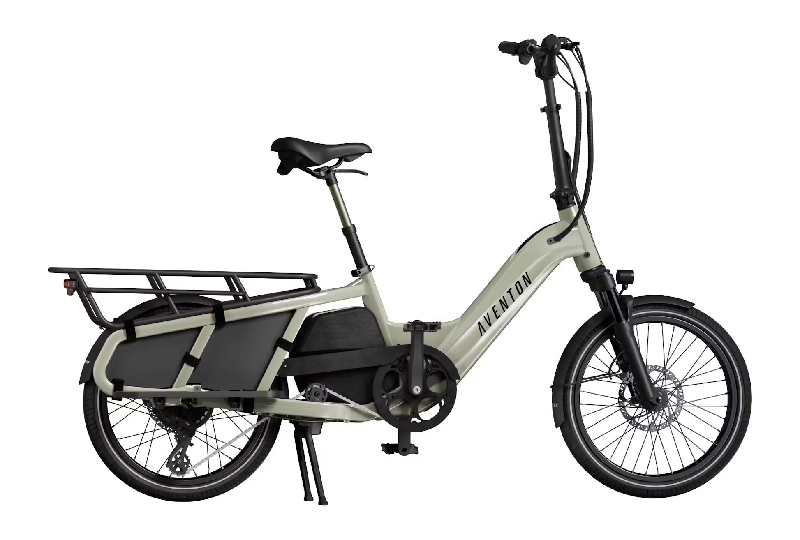
Have you noticed more families cruising by on e-bikes lately? The rise of electric bikes designed for family outings and hauling cargo is changing how we think about getting around. These bikes offer a practical, eco-friendly, and fun way to transport kids, groceries, and even bulky loads — all without breaking a sweat.
A key feature that sets these e-bikes apart is long-range capability. Whether you’re planning a day trip with the kids or need to haul heavy cargo across town, having an e-bike that can go the distance makes all the difference.
What Makes a Great Family or Cargo E-Bike?
When shopping for the best e-bikes for families or cargo, keep an eye out for these essentials:
- Power: Look for motors with enough torque to handle heavy loads and hills without strain.
- Range: A strong battery that can cover 40+ miles on a single charge keeps adventures going longer.
- Comfort: Adjustable seats, stable frames, and ergonomic handlebars mean everyone rides happy.
- Durability: Heavy-duty frames and reliable components ensure your bike can handle the extra weight day after day.
Pro Tip: Think About Your Typical Ride
Estimate how far and how often you’ll ride fully loaded. This helps you pick the right battery size and motor power without overspending.
What You’ll Learn in This Guide
This article will walk you through everything you need to know about family and cargo e-bikes in 2025. From key features to watch for, top models worth considering, and tips to help you make the smartest purchase — it’s all here.
Whether you’re new to e-bikes or upgrading to a more powerful ride, you’ll gain the confidence to choose the right bike that fits your lifestyle and budget.
Ready to Ride?
E-bikes aren’t just a cool gadget — they’re a game-changer for families and anyone who needs reliable cargo transport. Find the perfect family or cargo e-bike today and experience the freedom and fun that comes with electric power.
Why Choose a Long-Range Family and Cargo E-Bike?
Learn why long-range family and cargo e-bikes are a smart choice in 2025. Explore their benefits, key differences from standard e-bikes, and practical uses for everyday life.
Go Farther with Less Hassle
Tired of stopping to recharge your e-bike battery mid-ride? Long-range family and cargo e-bikes give you the freedom to take longer trips and rely less on frequent charging. This means more time enjoying the ride and less time plugged in.
What Sets Family and Cargo E-Bikes Apart?
Not all e-bikes are created equal. Family and cargo models are built to handle heavier loads and tougher conditions. Here’s how they differ:
- Stronger Motors: Designed to deliver extra torque for carrying kids, groceries, or bulky items up hills with ease.
- Reinforced Frames: Built tough to support more weight without compromising stability or comfort.
- Bigger Batteries: Larger capacity batteries provide longer range, so you can cover more miles in a single charge.
Practical Uses for Long-Range Family and Cargo E-Bikes
These bikes aren’t just for fun—they’re practical tools that can replace cars for many everyday tasks, like:
- Grocery Runs: Haul all your shopping without worrying about storage space.
- School Trips: Safely transport kids with built-in child seats or cargo boxes.
- Hauling Bulky Items: Move larger packages, tools, or picnic gear easily.
- Weekend Adventures: Enjoy family outings or errands without range anxiety.
Pro Tip: Match Battery Size to Your Routine
If you typically ride 20 miles a day fully loaded, choose a battery with at least double that range for peace of mind and unexpected detours.
Ready to Upgrade Your Ride?
Choosing a long-range family or cargo e-bike means less stress, more freedom, and practical solutions for your daily needs. Explore your options and find the best e-bike for your family today.
Key Features to Look For in Long-Range Family and Cargo E-Bikes
Discover the essential features of long-range family and cargo e-bikes in 2025, including battery capacity, motor power, frame design, comfort, cargo options, and safety.
Battery Capacity & Range: Power Your Adventures
When it comes to long-range e-bikes, the battery is the heart of your ride. Battery capacity is measured in watt-hours (Wh), which tells you how much energy the battery stores. The higher the Wh, the longer the bike can go before needing a recharge.
Voltage also plays a role in performance, with higher voltage often meaning better power delivery. In real-world terms, expect a well-equipped family or cargo e-bike to cover 40 miles or more on a single charge, depending on load and terrain.
Motor Power & Torque: Handling Heavy Loads with Ease
For family and cargo e-bikes, motor torque is just as important as raw power. Torque measures the twisting force the motor can apply—critical for climbing hills and accelerating smoothly when carrying kids or bulky cargo.
Look for motors with high torque ratings (usually measured in Newton-meters or Nm) to ensure your bike handles steep inclines and heavy weight without strain.
Frame Design & Build Quality: Stability Meets Strength
A sturdy frame is a must for safely carrying passengers or cargo. Family and cargo e-bikes feature reinforced frames that provide extra durability and stability. Many models use step-through frames to make mounting and dismounting easier, especially when loaded.
Safety features like strong welds and secure attachment points for seats or racks add peace of mind on every ride.
Comfort & Ergonomics: Keep Everyone Happy
Long rides and heavy loads demand comfort. Look for e-bikes with:
- Adjustable seats to fit different riders
- Suspension systems that soften bumps and rough terrain
- Ergonomic handlebars designed for relaxed posture
These features reduce fatigue, making your trips more enjoyable for both adults and kids.
Cargo Capacity & Accessories: Ready for Anything
A great family or cargo e-bike comes equipped to carry what you need. Key features include:
- Integrated racks strong enough for heavy loads
- Child seats or cargo boxes designed for safety and convenience
- Panniers and baskets to organize groceries or gear
Modular accessories let you customize your bike for your unique lifestyle.
Safety Features: Ride with Confidence
Carrying heavier loads means stopping safely is critical. Look for:
- Powerful brakes, often hydraulic disc brakes, that perform well under weight
- Bright integrated lights and reflectors for visibility in low light
- Sturdy tires with good grip for stable handling
These features keep you safe on busy streets and quiet trails alike.
Pro Tip: Test Ride with Your Typical Load
Bring some cargo or have your child on board during test rides to feel how the bike handles real-world weight and comfort.
Ready to Find Your Perfect E-Bike?
Knowing what to look for in battery, motor, frame, comfort, cargo options, and safety will help you pick the best e-bike for your family’s needs. Explore models with confidence and enjoy the ride!
Top Long-Range Family and Cargo E-Bikes (2025)
Explore the best long-range family and cargo e-bikes of 2025. Detailed reviews by category help you find the perfect electric bike for urban use, heavy hauling, kids transport, and more.
Best for Urban Use
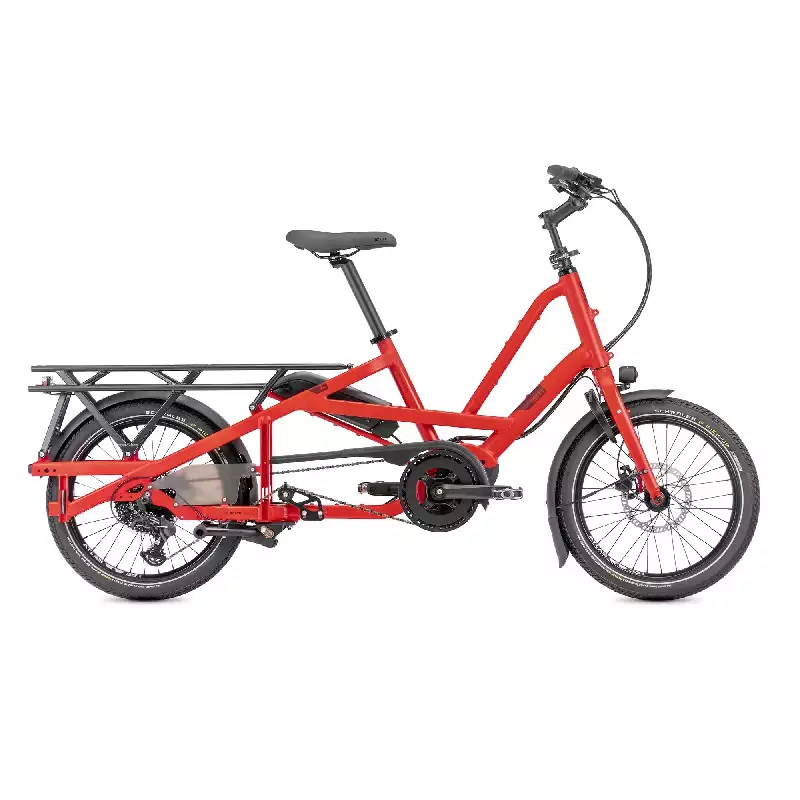
Tern Quick Haul Long D9
- Range & Specs: Up to 60 miles, Bosch Cargo Line motor with 85Nm torque, 500Wh battery.
- Cargo & Family Features: Supports up to 419 lbs total weight, fits two kids, compact design for city spaces, versatile accessory options for school runs or groceries.
- Pros: High weight capacity, customizable, quality construction.
- Cons: No suspension, pricier than basic models.
- Ideal Use: Daily commuting, quick errands, urban families wanting to ditch the car.
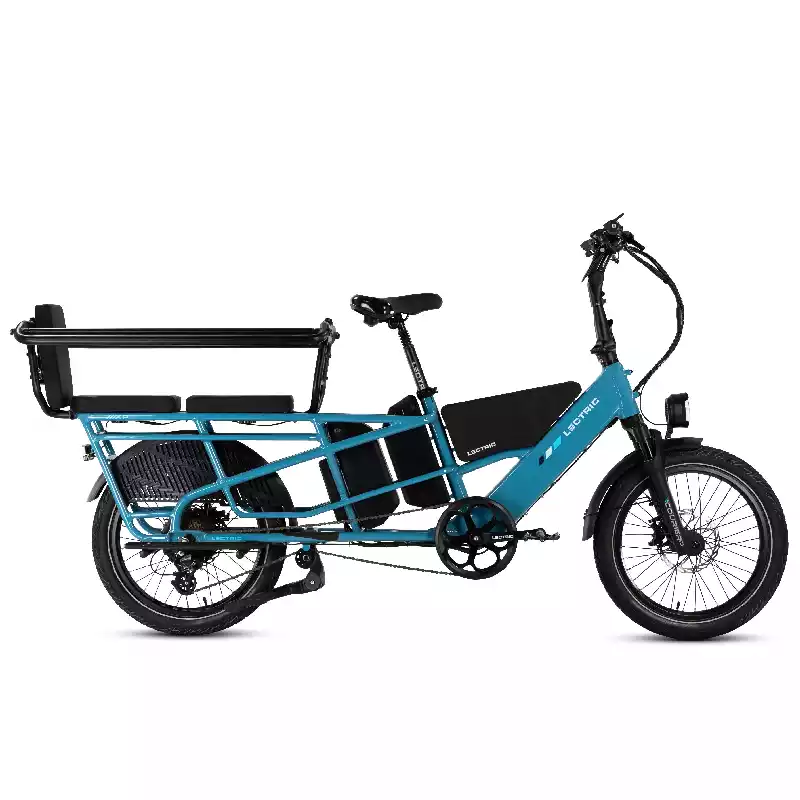
Best for Heavy Cargo
Lectric XPedition 2.0
- Range & Specs: Up to 75 miles with optional dual batteries (48V, 14Ah each), 750W rear hub motor, top speed 28 mph.
- Cargo & Family Features: 450 lbs payload capacity, spacious enough for multiple kids or large cargo, budget-friendly at $1,399.
- Pros: Excellent value, heavy load capability, optional dual battery for extended range.
- Cons: Heavier bike, fewer premium touches.
- Ideal Use: Large grocery hauls, delivery runs, families needing long daily trips.
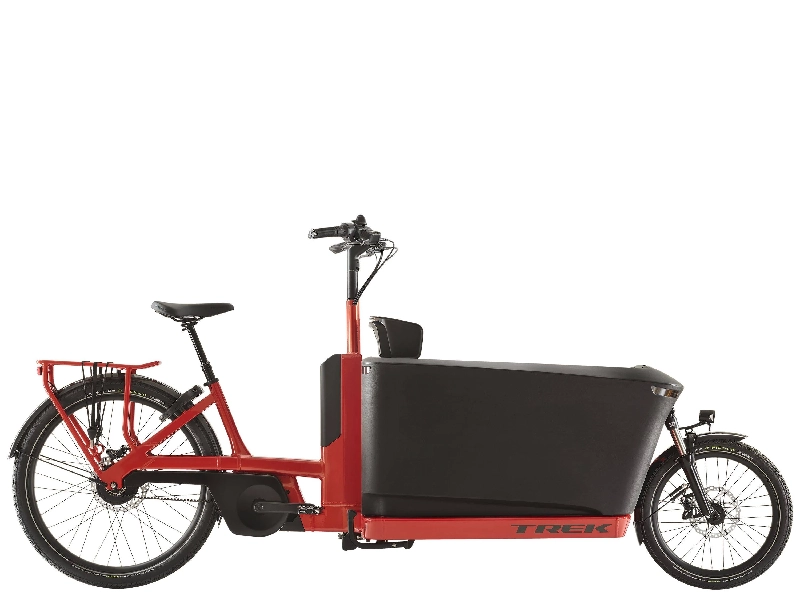
Best for Kids Transport
Trek Fetch+ 4
- Range & Specs: Bosch BES3 Cargo Drive motor, belt drive system, Class 1 e-bike.
- Cargo & Family Features: Seats up to 4 kids with included child seats and front cargo box; weather protection accessories available.
- Pros: Superb safety features, smooth ride, designed for multiple passengers.
- Cons: Heavy at 165 lbs, large footprint requiring storage space, higher price point.
- Ideal Use: Family carpools, replacing a minivan for kid transport.

Best Budget Long-Range Family Cargo Bike
Aventon Abound LR
- Range & Specs: 30+ miles real-world range, 750W hub motor, 720Wh battery.
- Cargo & Family Features: 440 lbs weight limit, rear rack for child seat or cargo, front and rear lights, suspension for comfort.
- Pros: Good value, comfortable ride, accessible price.
- Cons: Small display, controls might feel cramped for larger hands.
- Ideal Use: Suburban errands, family outings, first-time cargo e-bike buyers.
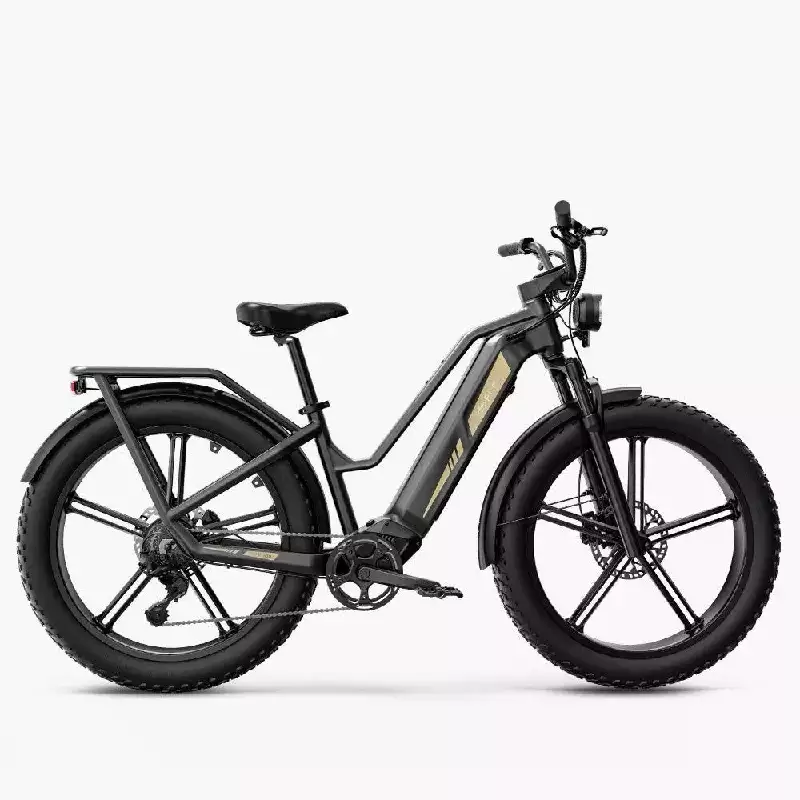
Best Ultra-Long Range Cargo E-Bike
Fiido Titan
- Range & Specs: Up to 250 miles with three batteries, 750W motor, 440 lbs cargo capacity.
- Cargo & Family Features: Heavy-duty frame, fat tires for varied terrain, rugged design.
- Pros: Exceptional range, very durable, great for heavy loads.
- Cons: Very heavy (83 lbs), more than needed for city rides, additional cost for extra batteries.
- Ideal Use: Long-distance trips, camping, rural or farm use.
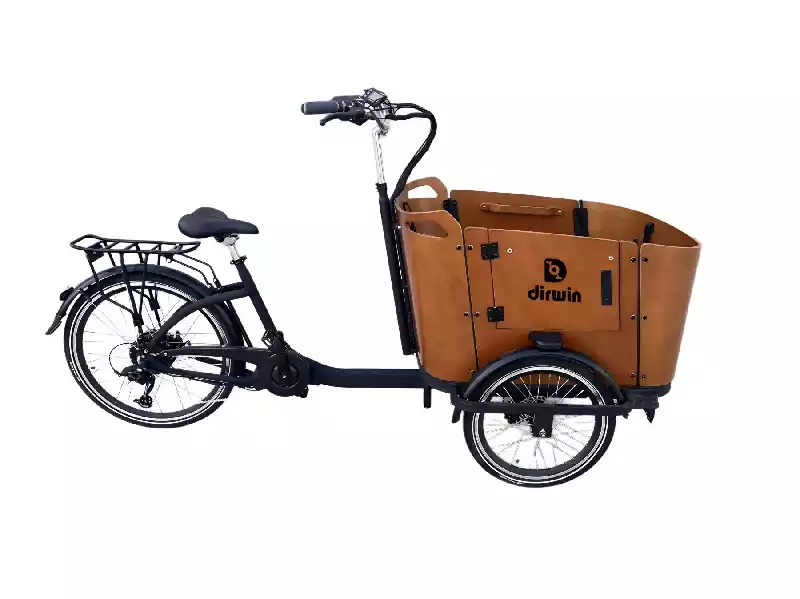
Best Trike for Maximum Safety
Dirwin Caravan Cargo E-Bike
- Range & Specs: Up to 60 miles, 350W motor, 16Ah lithium battery.
- Cargo & Family Features: Three-wheel stability, rear compartment with seatbelts for 2-4 passengers, waterproof cover included.
- Pros: Maximum safety and stability, roomy cargo and passenger space.
- Cons: Bulkier, lower top speed.
- Ideal Use: Families with young kids or elderly, short city trips prioritizing safety.
Pro Tip: Choose Based on Your Priorities
If you need maximum range and heavy hauling, the Lectric XPedition 2.0 or Fiido Titan stand out. For kid-focused transport, Trek Fetch+ 4 leads the pack. Newcomers or budget shoppers will appreciate the Aventon Abound LR. Safety-first families should consider the Dirwin Caravan trike.
Ready to Find Your Perfect Family or Cargo E-Bike?
With options designed for every lifestyle and budget, there’s never been a better time to upgrade to a long-range family or cargo e-bike. Explore these top picks and get ready to enjoy effortless rides with your loved ones.
Tips for Maximizing Range on Family and Cargo E-Bikes
Learn how to get the most range from your family or cargo e-bike with simple riding habits, maintenance tips, load management, and smart use of assist modes.
How Can You Extend Your E-Bike’s Battery Life on Every Ride?
Maximizing your e-bike’s range means more fun, longer trips, and less time charging. Whether you’re hauling kids or groceries, smart riding and good upkeep can stretch your battery life and keep your adventures going strong.
Efficient Riding Habits: Smart Speed and Assist Use
- Control your speed: Riding at a steady, moderate pace saves energy. High speeds drain the battery faster.
- Use pedal assist wisely: Choose eco or low assist modes whenever possible to reduce power draw while still getting help on hills or tough sections.
- Avoid sudden acceleration: Smooth starts use less battery than quick bursts of speed.
Regular Maintenance: Keep Your Bike Running Smoothly
- Check tire pressure: Properly inflated tires reduce rolling resistance, helping your bike move easier and save energy.
- Battery care: Charge regularly but avoid letting the battery drain completely. Store batteries in cool, dry places.
- Brake and drivetrain checks: Well-maintained brakes and clean chains reduce drag and improve efficiency.
Load Management and Distribution: Balance Matters
- Pack smart: Distribute cargo evenly to avoid extra effort from imbalance.
- Avoid overloading: Stick to your bike’s weight limits to prevent unnecessary strain on the motor and battery.
- Remove unnecessary weight: Carry only what you need to keep rides lighter and more efficient.
Pro Tip: Plan Your Route for Efficiency
Choose flatter routes or paths with fewer stops to conserve battery power and enjoy a smoother ride.
Ready to Ride Further and Smarter?
With these simple tips, you can boost your family or cargo e-bike’s range and enjoy more hassle-free trips. Start practicing today and experience how far your e-bike can really take you!
Accessories to Enhance Your Family and Cargo E-Bike Experience
Discover must-have accessories for family and cargo e-bikes in 2025, including child seats, weather covers, cargo bags, and smart security tools to upgrade your ride.
Make Every Ride Safer and More Comfortable
Want to get the most out of your family or cargo e-bike? The right accessories can transform your rides—making them safer, more convenient, and enjoyable for everyone on board.
Child Seats and Safety Harnesses: Secure Your Little Passengers
- Child seats: Designed specifically for e-bikes, these offer sturdy support and comfort for your kids.
- Safety harnesses: Keep young riders secure and confident, especially on busy streets or bumpy rides.
- Easy to install and remove, these accessories make family trips worry-free.
Weather Protection Covers: Ride Rain or Shine
- Waterproof covers: Shield your cargo or kids from rain and wind.
- Canopies and rain guards: Provide extra protection for little ones during unpredictable weather.
- Lightweight and durable, these covers keep your rides comfortable whatever the forecast.
Cargo Bags and Panniers: Organize Your Essentials
- Cargo bags: Spacious and designed to fit on racks or baskets for groceries, school supplies, or work gear.
- Panniers: Side-mounted bags that balance your load and free up space.
- Easy to attach and remove, these make packing simple and efficient.
GPS Tracking and Smart Locks: Protect Your Investment
- GPS trackers: Keep tabs on your e-bike’s location, helping prevent theft or loss.
- Smart locks: Use Bluetooth or app-based locking systems for quick, keyless security.
- These tech-savvy accessories add peace of mind, especially in busy urban areas.
Pro Tip: Customize Based on Your Lifestyle
Choose accessories that fit your daily needs—whether it’s extra cargo space for groceries or weather protection for kids on rainy days.
Ready to Upgrade Your Ride?
Adding the right accessories can make your family and cargo e-bike even more practical and fun. Explore options today and enjoy every ride to the fullest!
Frequently Asked Questions (FAQs)
Get clear answers to common questions about long-range family and cargo e-bikes, including range, safety, maintenance, and customization options.
How Far Can a Long-Range Cargo E-Bike Typically Go on a Single Charge?
Most long-range cargo e-bikes can travel 40 to 75 miles on a single charge, depending on factors like battery size, terrain, rider weight, and cargo load. Some models with dual batteries can even push beyond 100 miles. Real-world range varies, but choosing a bike with a larger battery and efficient motor helps maximize your trip length.
Are These E-Bikes Safe for Carrying Kids?
Yes! Family and cargo e-bikes designed for kids come with built-in safety features like sturdy child seats, secure harnesses, and stable frames. Many models also include protective weather covers and reliable brakes made to handle extra weight. Always follow the manufacturer’s weight and age guidelines for passengers and ensure proper helmet use.
What Maintenance Is Required for Long-Term Durability?
Regular maintenance keeps your e-bike running smoothly and extends its life. Key tasks include:
- Checking tire pressure and inflating as needed
- Charging the battery properly and storing it in a cool, dry place
- Cleaning and lubricating the chain and drivetrain
- Inspecting brakes and cables for wear
- Scheduling professional tune-ups annually or as recommended
Can I Customize My Cargo E-Bike for Specific Needs?
Absolutely! Many cargo e-bikes offer modular accessories like child seats, cargo racks, panniers, and weather protection. Some brands let you swap batteries or upgrade motors. Customizing your bike lets you tailor it perfectly for family outings, grocery runs, or work errands.
Pro Tip: Always Check Compatibility Before Adding Accessories
Make sure any add-ons match your e-bike’s frame and weight limits for safety and performance.
Ready to Ride with Confidence?
Understanding how long-range family and cargo e-bikes work helps you choose the best model and keep it in top shape. With the right info and gear, you’re set for many happy miles ahead!
Final Thoughts
The Right E-Bike Can Transform the Way You Travel
Long-range family and cargo e-bikes offer more than just eco-friendly transportation—they bring flexibility, fun, and freedom to your everyday life. With powerful motors, smart accessories, and enough range to keep up with your busy schedule, these bikes are a true game changer for families, commuters, and adventurers alike.
Match Your Bike to Your Life
Whether you're hauling kids to school, loading up with groceries, or exploring weekend trails, there's an electric cargo bike that fits your needs. Think about your daily routes, storage space, rider height, and preferred features. And if you’re unsure, a few test rides can go a long way in helping you feel confident.
Pro Tip: Don’t Forget the Accessories
Upgrading with child seats, rain covers, and cargo bags can make your e-bike even more useful and comfortable year-round.
Ready to Ride?
Now that you’ve seen the best long-range options and learned what features to look for, it’s time to explore your favorites and take the next step. Check out the models we reviewed, compare specs, and start planning your next adventure—your perfect e-bike is waiting.
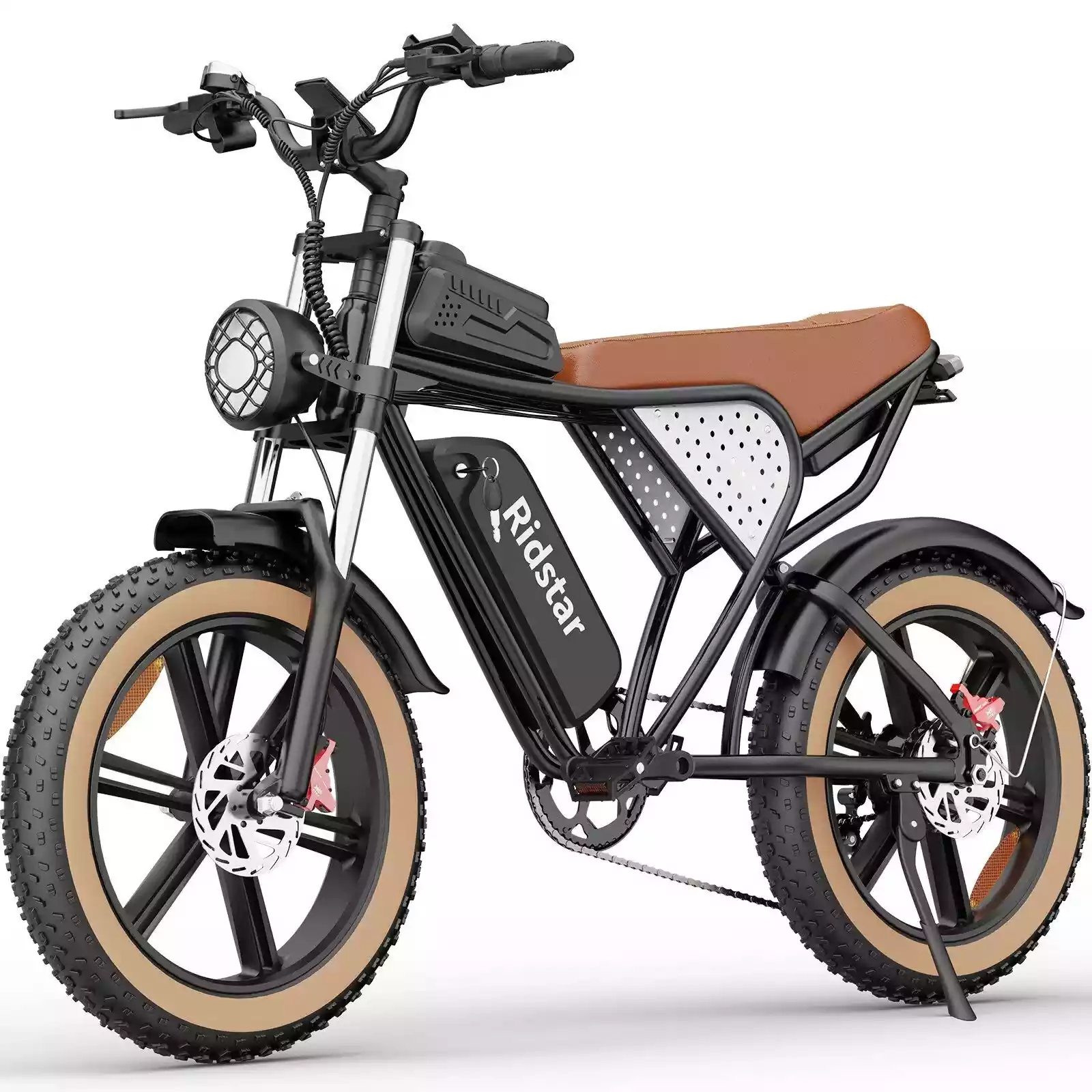
Thinking about buying an electric bike but confused by all the “Class 1, Class 2, Class 3” talk? You’re not alone. Understanding how e-bikes are categorized is a key part of choosing the right one—especially if you want to stay within the law and ride where you want.
In this guide, we’ll break down the three main e-bike classes in plain English. You'll learn how they differ in speed, throttle features, and legal access—plus which class might be best for your lifestyle. Whether you're commuting, cruising, or just getting started, this quick breakdown will point you in the right direction.
Why E-Bike Classes Matter
E-bikes are more popular than ever. They're fast, fun, eco-friendly, and perfect for beating traffic or exploring your city. But not all e-bikes are created equal—and understanding the class system is essential before you buy.
Here’s why the class matters:
- Legal Access: Some bike paths, parks, and public trails only allow certain classes.
- Top Speeds: Each class comes with its own speed limits, which affect how and where you can ride.
- Throttle vs. Pedal Assist: The type of motor control changes the entire riding experience.
Pro Tip: Many cities and states follow the same 3-class system, but local laws can vary. Always double-check your area's regulations before hitting the road.
Up next: Let’s dive into exactly what makes a Class 1, Class 2, or Class 3 e-bike unique—so you can ride smarter and buy with confidence.
What Are E-Bike Classes?
If you're diving into the world of e-bikes, one of the first things you'll notice is that not all electric bikes are the same. In fact, they’re grouped into three official “classes”—and knowing the difference can make or break your riding experience.
The e-bike class system was first introduced in California and has since been adopted in many other states. It’s designed to give structure to how electric bikes are regulated and where they’re allowed to go.
How E-Bikes Are Classified
The class of an e-bike is based on three main things:
- How the motor activates (pedal-assist only or throttle-enabled)
- Top speed while using motor assistance
- Whether or not it includes a throttle
These factors don’t just affect how your ride feels—they determine where you can legally ride. For example, some bike trails or city paths allow only Class 1 e-bikes because they behave more like traditional bicycles.
Pro Tip: If you plan to ride on multi-use trails or through parks, check what classes are permitted before you invest in a bike.
Understanding e-bike classes helps you match your ride to your lifestyle, avoid fines, and get the most from your purchase. Keep reading to explore each class and find the best e-bike for your needs.
Class 1 E-Bikes: Pedal Assist Only
Want an e-bike that feels like a traditional bike, just with an extra push when you need it? A Class 1 e-bike might be your perfect match. It’s the most widely accepted and beginner-friendly option on the market.
What Makes a Class 1 E-Bike?
Class 1 e-bikes offer pedal assist only—meaning the motor kicks in only when you’re pedaling. There’s no throttle, so you won’t be able to cruise without putting in some effort.
Here’s what defines a Class 1:
- Motor Activation: Pedal-assist only (no throttle)
- Top Speed: 20 mph with assistance
- Motor Limit: Up to 750 watts
- Legal Use: Allowed on most city bike lanes, greenways, and off-road trails
Best For:
- Commuters who want reliable, sweat-free rides without relying on a car
- Fitness riders looking for a boost on hills or long-distance routes
- Cyclists who still want a natural pedaling experience with added support
Pro Tip: Class 1 e-bikes are your best bet if you want access to the most bike-friendly areas, including shared-use trails and park paths.
Pros of Class 1 E-Bikes
- Widely accepted on bike paths, trails, and in most cities
- Lightweight and simple—no throttle means fewer controls to manage
- Encourages physical activity while still giving you a boost
Cons to Consider
- No throttle, so you can’t coast or get started without pedaling
- May not be ideal for riders with mobility issues or those who want full motor control
If you're looking for the best e-bike for commuting, fitness, or casual riding, Class 1 models are a solid choice—especially if you're just getting started. Keep reading to see how they compare to Class 2 and Class 3 bikes.
Class 2 E-Bikes: Throttle + Pedal Assist
Want the freedom to ride without pedaling at all? Class 2 e-bikes give you the best of both worlds: full pedal assist and a throttle that lets you cruise with zero effort.
This class is perfect for riders who want control, comfort, and convenience—especially when starting from a stop or navigating hills.
What Makes a Class 2 E-Bike?
Class 2 e-bikes are equipped with both pedal assist and a throttle, meaning you can ride with motor power even if you’re not pedaling. Just twist or press the throttle, and the bike moves—easy as that.
Here’s what defines a Class 2:
- Motor Activation: Pedal-assist and throttle
- Top Speed: 20 mph (on both throttle and assist)
- Motor Limit: Up to 750 watts
- Legal Use: Allowed in many areas, but sometimes restricted on bike-only trails or nature paths
Best For:
- Riders with mobility or joint issues who need a more accessible ride
- Casual riders and cruisers who value comfort and ease
- City commuters who want quick starts at traffic lights or uphill boosts
Pro Tip: Throttle control is great for stop-and-go traffic or tight turns where balancing while pedaling is tough.
Pros of Class 2 E-Bikes
- No need to pedal—just use the throttle to get moving
- Great for beginners, seniors, or riders recovering from injury
- Versatile: switch between throttle-only and pedal assist as needed
Cons to Consider
- May face more restrictions on trails and multi-use paths
- Slightly heavier and more complex due to added throttle system
If you're looking for one of the best e-bikes for comfort, casual rides, or urban commuting, Class 2 could be the perfect fit. Just be sure to check your local trail rules if you're planning to go off-road. Up next: Class 3, the fastest option of them all.
Class 3 E-Bikes: Fastest Pedal Assist
Need to keep up with city traffic or cover serious ground on your commute? Class 3 e-bikes are built for speed, making them a top choice for experienced riders and long-distance commuters.
Unlike Class 2, Class 3 bikes don’t include a throttle—but what they lack in throttle control, they make up for in top-end speed and power.
What Makes a Class 3 E-Bike?
Class 3 e-bikes offer pedal assist only, with no throttle, but they can reach up to 28 mph while you're pedaling. This class is designed for fast, efficient travel—especially on streets and bike lanes alongside cars.
Here’s what defines a Class 3:
- Motor Activation: Pedal-assist only (no throttle)
- Top Speed: 28 mph with assistance
- Motor Limit: Up to 750 watts
- Legal Use: Often restricted from bike paths and off-road trails; usually limited to roadways and dedicated bike lanes
Best For:
- Speed-focused commuters who ride in busy urban environments
- Experienced cyclists who want more power for longer, faster rides
- Riders with long commutes or who need to arrive quickly and sweat-free
Pro Tip: Many states require helmets for all Class 3 riders, regardless of age. Some also restrict Class 3 use to adults only.
Pros of Class 3 E-Bikes
- Fast and efficient—ideal for keeping pace with cars in city traffic
- Great for long-distance rides or high-speed commutes
- Can reduce car dependency for serious daily travel
Cons to Consider
- Not allowed on most bike paths, nature trails, or multi-use lanes
- Helmet use is often required by law, even for adults
- No throttle, so you must keep pedaling for motor support
If you're looking for one of the best e-bikes for fast commuting or road riding, Class 3 models deliver serious performance. Just be sure you’re okay sticking to streets and bike lanes—and always check your local laws before you ride.
Side-by-Side Comparison: Class 1 vs Class 2 vs Class 3 E-Bikes
Still deciding which e-bike class is right for you? This quick side-by-side comparison makes it easy to see how each class stacks up in terms of speed, features, and legal access.
Whether you're browsing the best e-bikes for commuting or looking for a simple pedal-assist model, this chart can help guide your decision.
| Feature | Class 1 | Class 2 | Class 3 |
|---|---|---|---|
| Pedal Assist | ✅ Yes | ✅ Yes | ✅ Yes |
| Throttle | ❌ No | ✅ Yes | ❌ No |
| Max Assisted Speed | 20 mph | 20 mph | 28 mph |
| Motor Power Limit | Up to 750W | Up to 750W | Up to 750W |
| Legal Trail Access | Allowed on most bike paths | Limited in some areas | Restricted from most trails |
| Ideal Use Case | Fitness, commuting, casual | Mobility, relaxed rides, urban | Fast commuting, road riding |
Pro Tip: If you’re planning to ride on public trails or in parks, Class 1 e-bikes are usually your safest bet when it comes to access.
This side-by-side view is especially useful if you're building a short list of options for your next ride. Keep it handy as you explore different models, compare features, and read electric bike reviews. Ready to pick your perfect ride? Keep reading for legal tips and real-world riding advice.
Legal and Safety Considerations for E-Bike Riders
Before you hit the road, there’s one more thing to think about—laws and safety rules. Each e-bike class comes with its own set of legal guidelines, and they can vary depending on where you live. Knowing the rules keeps you safe, and keeps your ride street-legal.
What to Know About E-Bike Laws
While the 3-class system is widely adopted across the U.S., state and local rules may still differ. Some areas are stricter than others, especially when it comes to speed, trail access, or throttle use.
Here are some key things to check in your area:
- Helmet Requirements:
- Most states recommend helmets for all riders
- Class 3 e-bikes often require helmets by law, even for adults
- Age Restrictions:
- Many places restrict Class 3 e-bikes to riders 16+
- Class 1 and 2 are more relaxed but may still have age minimums
- License or Insurance Needs:
- Not usually required, but a few localities may ask for registration or insurance for Class 3 bikes
- Always worth confirming with your local DMV or city website
Pro Tip: Call your local bike shop or transportation department if you’re unsure. They’ll know your city’s current e-bike rules better than anyone.
Why It Matters
Knowing the law helps you choose the right bike and ride it legally. It also helps you avoid tickets or conflicts on trails and streets.
For anyone using an e-bike for commuting, fitness, or fun, a quick legal checkup is a smart step before you buy. Better to be informed now than surprised later.
Next, we’ll help you figure out which class is the best fit for your lifestyle.
Which Class Is Right for You?
Now that you know how each e-bike class works, it’s time to choose the one that fits your lifestyle. Whether you're commuting, cruising, or getting back into riding, there's an electric bike class that matches your goals.
Quick Decision Guide
Here’s a fast way to narrow it down:
- Want to ride almost anywhere and get exercise? → Go with a Class 1
- Prefer a throttle and an easier ride? → Try a Class 2
- Need top speed for daily commutes? → Consider a Class 3
Each class serves a different type of rider, so think about how you plan to use your e-bike day to day.
Ask Yourself These Questions
Choosing the right class starts with understanding your own needs. Here are a few smart questions to ask:
- Where will I ride most?
If your favorite trails or parks restrict certain classes, Class 1 is your safest bet. - Do I want throttle control?
If starting from a stop is tough or you want a break from pedaling, a Class 2 might be your best option. - Is top speed important to me?
If you’re riding in traffic or commuting long distances, Class 3 offers the performance you need.
Pro Tip: Try test riding different classes before making a decision. Many local e-bike shops offer demos, and nothing beats feeling the difference yourself.
Choosing the right class will make your ride smoother, safer, and more enjoyable. Keep reading for some final thoughts and tips to make your first e-bike purchase a success.
Future Trends & Technology in E-Bikes
The e-bike world is evolving fast—and the future is looking smarter, faster, and more connected. As more riders hit the road, technology and laws are racing to keep up. Here's a look at what’s coming next in electric biking.
Evolving Laws and Class Definitions
As e-bike popularity grows, regulations are constantly being updated. Cities and states are refining where and how different classes can be used. We may see new sub-classes, new helmet rules, and more clarity around shared path access.
- Expect more local laws tailored to e-bike traffic and safety
- Some areas may introduce speed-sensitive zones using GPS tech
- Class standards could shift as new motor types hit the market
Pro Tip: Keep an eye on local transportation news—new rules can impact where you’re allowed to ride and what gear you need.
Tech That’s Changing the Ride
Modern e-bikes are quickly becoming more than just bikes with motors. Here's what’s shaking up the industry:
- Programmable speed limits: Some e-bikes can be adjusted for different ride zones or user types
- Smart displays and apps: Track battery life, navigation, ride stats, and even theft protection from your phone
- Integrated GPS: Great for route planning, commuting, or keeping tabs on your bike’s location
- Ride customization: Apps that let you control motor responsiveness, assist levels, and eco/sport modes
These upgrades not only improve performance but also make e-bikes feel more personal and connected—just like a modern electric car.
From high-tech gadgets to shifting policies, the future of e-biking is full of possibilities. Thinking long term? Choose a model with firmware updates or app support so your ride keeps getting better with time.
Find the Right E-Bike Class for Your Ride
Now that you know how Class 1, Class 2, and Class 3 e-bikes differ, choosing the right one should feel a lot easier. Each class offers a unique riding experience, and the best fit depends on your goals, habits, and where you’ll be riding.
Here’s a quick recap:
- Class 1: Pedal assist only, up to 20 mph — great for trails, fitness, and casual commuting
- Class 2: Pedal assist + throttle, up to 20 mph — ideal for comfort, mobility, and urban riding
- Class 3: Pedal assist only, up to 28 mph — best for fast commutes and road riders
Pro Tip: Laws vary widely by city and state, so always double-check local rules before buying or riding.
No matter which class you choose, the most important thing is to match your e-bike to your lifestyle, needs, and riding environment. If you’re still unsure, visit a local e-bike shop, take a few test rides, and ask questions. E-bike communities and online reviews are also great resources.
Ready to ride? Explore your options, stay informed, and choose a bike that makes every trip exciting. The right class can turn your daily commute or weekend adventure into the best part of your day.
Additional Resources for E-Bike Riders
Whether you're a new rider or upgrading to a faster class, having the right tools and knowledge makes every ride smoother and safer. Below are some helpful resources to explore as you continue your e-bike journey.
Stay Legal and Informed
- State-by-State E-Bike Law Guide – Check regulations for e-bike classes, helmet rules, and trail access in your area
- [Local Department of Transportation] – Great for updates on bike lanes, local rules, and commuting policies
Gear Up for Safety
- Recommended Safety Gear:
- Helmet with MIPS protection
- Rearview mirror for urban and high-speed riding
- Front and rear lights for visibility day or night
- Reflective clothing or decals for added safety
Pro Tip: Many Class 3 riders add mirrors and upgraded brakes for extra control at higher speeds.
Buying and Riding Guides
- [Beginner’s E-Bike Buying Guide] – Learn what to look for when choosing your first electric bike
- [E-Bike Fit & Comfort Tips] – Adjust your seat, bars, and pedal assist levels for the smoothest ride
- [Electric Bike Reviews (20XX)] – Find top-rated e-bikes by class, budget, and riding style
Find Places to Ride
- TrailLink – Discover paved bike trails, greenways, and commuter paths across the U.S.
- AllTrails – Great for finding multi-use paths and rating trails by surface type and terrain
- Local bike coalitions or clubs often publish community maps with e-bike-friendly routes
From legal know-how to gear and local trails, these resources help you make smart, confident choices—whether you’re riding for fun, fitness, or the daily commute.
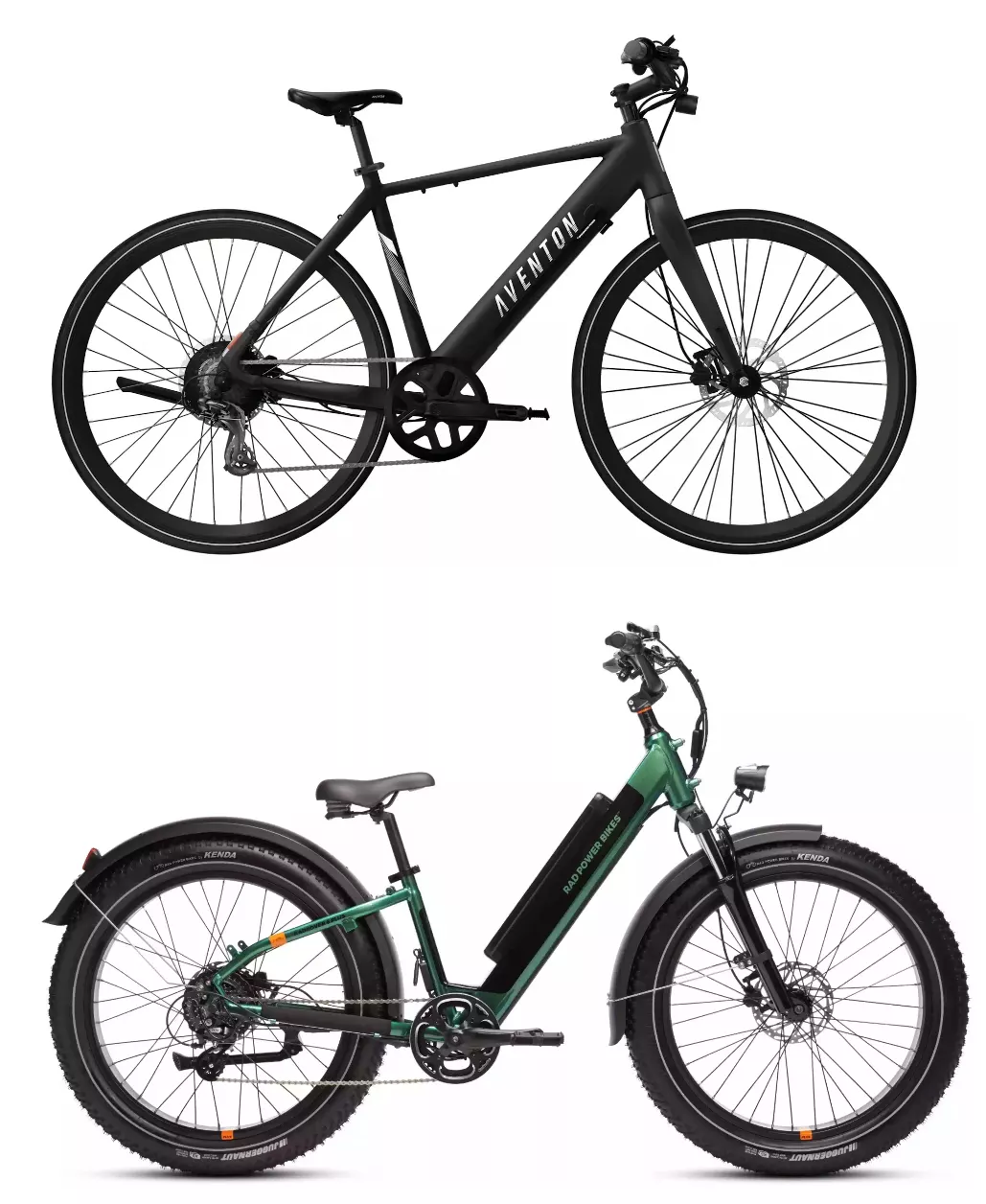
Thinking about buying an electric bike but not sure which brand to trust? You’re not alone. With so many options out there, narrowing it down to the right model can feel overwhelming—especially when two names keep popping up: Rad Power Bikes and Aventon.
These two brands are leading the charge in the e-bike world. Whether you're commuting to work, cruising the boardwalk, or replacing your car for errands, both offer solid choices. But how do they stack up against each other?
In this comparison guide, we’ll break down everything that matters—from ride quality and tech to pricing and support. By the end, you'll know exactly which brand suits your lifestyle and budget best.
Pro Tip: E-bikes qualify as green transportation in many cities—check if your area offers rebates or incentives for buying one!
Why Rad Power and Aventon Are Worth Comparing
Rad Power and Aventon are often mentioned in the same breath for a reason—they're both well-established, offer reliable bikes, and pack plenty of value. Here’s a quick snapshot of what makes each brand stand out:
Rad Power Bikes:
- Known for utility-first designs and rugged versatility
- Great for hauling, delivery, or all-weather commuting
- DIY-friendly with wide aftermarket support
Aventon:
- Sleek, modern frames built for comfort and performance
- App-connected tech and digital customization
- Strong lineup for commuters and urban riders
Both offer pedal assist and throttle modes, long-lasting batteries, and competitive warranties. But there are key differences in design philosophy, ride feel, and feature sets.
Pro Tip: When choosing an e-bike, always factor in where you’ll ride most—city streets, bike trails, or mixed terrain. It affects everything from tire size to battery life.
Brand Backgrounds
Rad Power Bikes
Rad Power Bikes was founded in 2015 with a clear mission: to make electric bikes accessible, practical, and fun for everyone. What started as a garage-built DIY project quickly grew into one of the most recognizable e-bike companies in North America.
Why riders love Rad:
- Utility-first design with models built for cargo, commuting, and even off-road use
- Affordable pricing that opens the door for first-time e-bike buyers
- Large community and support network, including replacement parts and how-to guides
They’re especially known for their tough, functional builds—think fat tires, rear racks, and a throttle for easy cruising. If you're looking for one of the best e-bikes for delivery work, family errands, or just getting around with gear, Rad Power is a top contender.
Pro Tip: Rad’s flagship models like the RadRunner and RadWagon offer impressive hauling capacity without needing a car replacement budget.
Aventon
Aventon launched in 2013 and originally made a name for itself in the fixed-gear bike scene before shifting focus to electric bikes. That design-first mindset is still obvious in their current e-bike lineup—sleek frames, smooth welds, and a premium feel without the premium price tag.
What sets Aventon apart:
- Modern styling with integrated batteries and hidden cabling
- Sporty, responsive ride quality that feels fast and agile
- App integration for tracking rides, adjusting settings, and checking battery life
Aventon’s models are some of the best electric bikes for urban commuting and recreational riding. They strike a balance between comfort and performance, which makes them a favorite for riders who want both function and flair.
Pro Tip: Many Aventon bikes come with torque sensors instead of cadence sensors, giving you a more natural-feeling pedal assist. It's a subtle upgrade, but one that experienced riders often appreciate.
Model Lineup Overview
Not all e-bikes are built the same—and that’s a good thing. Whether you want something for city commuting, hauling groceries, weekend trail rides, or folding up for apartment living, both Rad Power and Aventon offer solid options. Knowing which models match your lifestyle is key to finding the best electric bike for your needs.
Here’s a side-by-side look at how their top models compare:
| Type | Rad Power Bikes | Aventon |
| Commuter | RadCity 5 Plus | Level.2 |
| Cargo | RadWagon 4 | Abound |
| Folding | RadExpand 5 | Sinch.2 |
| Fat Tire | RadRover 6 Plus | Aventure.2 |
| Step-Thru | RadRunner Plus Step-Thru | Pace 500.3 Step-Through |
Both brands offer something for every kind of rider, but their designs serve different styles:
- Rad Power Bikes lean toward rugged practicality, with wide tires, integrated racks, and built-in utility.
- Aventon focuses on a more refined feel—sleek frames, stylish colors, and app-connected features.
If you’re unsure what type of e-bike is best for you, start by thinking about where you’ll ride most often and how much you plan to carry.
Pro Tip: Cargo and fat tire models are great if you need stability and extra power for heavier loads or bumpy terrain. For daily commuting, a lightweight city cruiser with a step-through frame makes hopping on and off easy.
Motor & Battery Performance
Power and range are two of the most important factors when choosing an electric bike. Whether you're tackling steep hills or trying to make it through your daily commute without a recharge, the motor and battery setup can make or break your ride. Rad Power and Aventon take slightly different approaches, and that affects both how their bikes feel and how far they’ll take you.
Motor Types & Power
Most Rad Power and Aventon models use rear hub motors, which are reliable, low-maintenance, and offer solid torque for everyday riding. Mid-drive motors, which provide a more balanced and efficient feel, aren’t offered by either brand at this time—though both brands still deliver strong performance with their hub setups.
Motor specs at a glance:
- Rad Power Bikes: 750W geared rear hub motors on most models
- Aventon: 500W or 750W hub motors depending on the model, with torque sensors for smoother power delivery
When it comes to acceleration and hill climbing, Rad’s motors tend to feel stronger right out of the gate, thanks to higher peak torque. Aventon, however, offers a more refined pedal assist experience, especially on newer models like the Aventure.2 and Level.2.
Throttle and pedal assist modes come standard on most models from both brands, letting you choose between effortless cruising or more interactive pedaling.
Pro Tip: If you ride in a hilly area or carry a lot of gear, Rad’s torquey motors may give you the edge. For riders who want a more natural cycling feel, Aventon’s pedal assist tuning is hard to beat.
Battery Range & Charging
Aventon and Rad Power both use lithium-ion batteries that balance power with reliability. But how far can they go on a single charge? That depends on a few things: motor power, rider weight, terrain, and how much you rely on throttle.
Battery details:
- Rad Power Bikes: 672Wh to 750Wh batteries, offering up to 45 miles on a single charge
- Aventon: 614Wh to 720Wh batteries, with ranges up to 60 miles depending on the model and assist level
Aventon often pulls ahead on range, especially with its efficient torque sensors that conserve battery power. Many of their batteries are also fully integrated into the frame, giving the bikes a clean, streamlined look.
Both brands offer removable batteries, which is a huge plus for apartment dwellers or anyone who wants to charge indoors. Charging typically takes 4–6 hours, and both companies offer replacement batteries if you need a backup or upgrade.
Pro Tip: Use lower pedal assist levels for longer rides. Level 1 or 2 can nearly double your range compared to full throttle or max assist.
In short: Rad Power gives you punchy power and utility-focused batteries. Aventon goes for range, smooth efficiency, and stylish integration. Choose based on how—and how far—you plan to ride.
Ride Quality & Comfort
A good e-bike isn’t just about speed and specs—it’s about how it feels on the road. Ride quality can make or break your daily commute or weekend cruise. Let’s see how Rad Power and Aventon stack up when it comes to comfort, stability, and overall riding experience.
Frame Geometry and Ergonomics
Both brands offer upright riding positions designed to reduce strain on your back, shoulders, and wrists. That said, Rad Power’s bikes tend to feel more like cruisers—wide handlebars, relaxed frames, and step-through options for easy mounting.
Aventon, on the other hand, leans toward a sportier feel, especially on models like the Aventure.2 and Level.2. These bikes place you in a slightly more forward-leaning posture that boosts aerodynamics and control, which is great for city riding.
What to expect:
- Rad Power: Comfortable, casual, and easy to handle
- Aventon: Agile, responsive, and designed for active pedaling
Pro Tip: If you have back or joint issues, Rad’s upright geometry and fat tires may provide a more forgiving ride.
Suspension, Tires & Seat Comfort
Most Rad and Aventon bikes come with front suspension forks to smooth out cracks, curbs, and light trails. You’ll feel a noticeable difference in comfort on bumpy roads, though neither brand offers full-suspension models (yet).
Key comfort features:
- Rad Power: Wider tires and plush saddles for cushy rides
- Aventon: Slightly firmer feel, with narrower tires on some commuter models
Rad’s fat tire bikes—like the RadRover—offer extra shock absorption and are ideal for mixed terrain. Aventon’s tires are more commuter-focused, providing efficient rolling and nimble handling on paved roads.
Stability, Noise & Handling
In terms of stability, Rad bikes feel grounded and sturdy, especially at slower speeds or with added cargo. Their heavier frames and fat tires provide a planted feel, perfect for new riders or anyone prioritizing control.
Aventon’s bikes feel lighter and quicker, making them more fun for weaving through traffic or zipping along bike lanes. Their motors are also noticeably quieter, giving Aventon the edge in the low-noise department.
Pro Tip: Planning to ride in busy city traffic? Aventon’s responsive handling and lightweight frame may give you more confidence when making quick turns or lane changes.
Best For: Commutes or Cruising?
If you're looking for the best e-bike for long commutes, Aventon’s efficient design, torque-sensing pedal assist, and lighter frame make it a strong choice. But for casual cruising, weekend rides, or utility hauling, Rad Power delivers comfort and stability that’s hard to beat.
Choosing the right ride really depends on what matters more: smooth power and nimble control, or comfort and all-terrain confidence.
Features & Tech
A great e-bike isn’t just about speed and range—it’s also about smart features that make every ride smoother, safer, and more enjoyable. Rad Power and Aventon both offer a solid lineup of built-in accessories and tech, but they take slightly different paths when it comes to connectivity and customization.
Built-In Accessories: Lights, Fenders & Racks
Both brands understand that e-bikes are often car replacements, so they include a lot of must-have gear right out of the box.
Standard features you’ll find on most models:
- Integrated front and rear lights for visibility and safety
- Full-coverage fenders to protect against rain and road spray
- Rear racks for cargo, bags, or child seats
Rad Power leans hard into utility. Their racks are beefy, modular, and ready for add-ons like baskets or panniers. Aventon’s setups are sleeker, blending into the frame design while still offering decent load capacity.
Pro Tip: If you plan to carry groceries, a backpack, or even a passenger, check weight limits for each bike’s rear rack—Rad usually has the upper hand.
Display & App Integration
Here’s where the two brands start to diverge. Aventon shines when it comes to connected tech, while Rad keeps things simple and straightforward.
Rad Power:
- LCD displays with basic info like speed, battery level, trip distance, and assist level
- No official app, though the display is easy to read and durable
Aventon:
- Color LCD displays with more detailed metrics
- Aventon app lets you track rides, share stats, and even customize your assist levels via Bluetooth
The Aventon app adds real value if you like data, navigation, or tweaking performance settings. It’s especially useful for riders who want to monitor their fitness or keep tabs on long-term battery performance.
Customization & Smart Features
Rad bikes are known for being DIY-friendly—it’s easy to add accessories, swap parts, or even do basic repairs yourself. The brand supports a huge ecosystem of compatible upgrades.
Aventon’s newer models focus on refined experiences over raw customization. With integrated electronics and frame design, they look cleaner but offer fewer options for heavy modification.
Highlights:
- Rad Power: Highly customizable, great for utility riders
- Aventon: App-connected and sleek, great for tech-forward commuters
Pro Tip: Want to personalize your ride? Rad’s open design gives you more flexibility. Prefer plug-and-play convenience? Aventon’s built-in tech wins for simplicity.
Whether you value smartphone integration or hands-on upgrades, both brands give you the tools to make your ride feel like yours.
Build Quality & Design
Looks matter—but so does durability. When investing in an e-bike, you want a ride that not only turns heads but also holds up over time. In this section, we’re comparing Rad Power and Aventon on materials, craftsmanship, and overall design philosophy.
Frame Material and Build Quality
Both brands use aluminum alloy frames, which strike a great balance between strength and weight. Rad Power Bikes are built with rugged durability in mind. You’ll find oversized tubing, reinforced welds, and extra attachment points for racks or baskets.
Aventon’s bikes feel more refined and precision-crafted. Their frames feature smooth welds (almost invisible on some models), and you can see the attention to detail in things like internal cable routing and tight panel gaps.
In short:
- Rad Power: Tough, utility-built frames built to handle real-world abuse
- Aventon: Polished, high-quality finishes that look and feel premium
Pro Tip: If you're planning to ride in all seasons or carry loads regularly, Rad’s build quality is hard to beat. For riders who prioritize form as much as function, Aventon’s clean frame work stands out.
Aesthetic Design and Finish
Aventon takes a clear lead when it comes to modern styling. Their bikes have a sleek, minimalist look, with color-matched components and low-profile battery integration. They’re often mistaken for high-end analog bikes, which is a big win if you want something stylish.
Rad Power’s designs are more function-first—chunky tires, built-in racks, and bolt-on batteries give off a more rugged, tool-like vibe. It’s not a bad thing, but it’s definitely a different look.
Style breakdown:
- Rad Power: Utility aesthetic, often industrial or bold
- Aventon: Streamlined, commuter-friendly, and polished
Weight and Portability
Electric bikes aren’t featherlight, but some are easier to manage than others. Most Rad Power models weigh between 65–75 lbs, due to their larger frames and utility features. That can make them tough to lift or carry upstairs.
Aventon bikes usually fall in the 50–60 lb range, depending on the model. Their sleeker design and integrated batteries shave off extra pounds, which makes a difference for urban riders or apartment dwellers.
Key takeaway:
- Rad Power: Heavier, but solid and balanced for stable riding
- Aventon: Lighter, easier to carry, and better for tight urban spaces
Pro Tip: If portability matters—like getting your bike into a car, up stairs, or onto public transit—Aventon’s lighter frames may save you daily frustration.
Whether you want a bike that’s built like a tank or one that blends in with urban traffic, both brands offer quality builds—it just comes down to your priorities.
Pricing & Value
Electric bikes come in a wide range of prices, but finding the sweet spot between cost and quality is key. Whether you're on a tight budget or willing to invest in premium features, both Rad Power and Aventon offer strong value—but in slightly different ways.
General Price Ranges
Rad Power Bikes typically range from $1,299 to $2,099, depending on the model and accessories included. Their pricing reflects a utility-focused build, with standard features like racks, lights, and wide tires baked in.
Aventon’s lineup falls between $1,199 and $1,999, with more variation based on tech features and design. They’re known for competitive pricing, especially considering the quality of their finishes and app-connected capabilities.
Quick comparison:
- Rad Power: Slightly higher average prices, more cargo-ready builds
- Aventon: Slightly lower base prices, tech-forward features included
Pro Tip: Always factor in what’s included—like racks, fenders, or integrated lights. A bike that looks cheaper may cost more once you add the extras.
Feature-to-Price Breakdown
Rad Power gives you a lot of practical features at every price point. You're getting a high-torque 750W motor, a rugged frame, and real-world accessories that make everyday use simple. These bikes are built to do more—especially if you’re replacing car trips.
Aventon balances performance and polish. Their torque sensors, color displays, and app integration feel high-end, even on mid-range models. You’re paying for ride quality and smart design, not just raw specs.
What each brand delivers per dollar:
- Rad Power: Best value for utility riders or anyone needing hauling power
- Aventon: Best value for urban riders and tech-savvy commuters
Best Value Picks from Each Brand
If you're trying to get the most bang for your buck, here are two standout models:
- RadRunner Plus (Rad Power): A versatile utility e-bike with passenger seating, integrated rear rack, and fat tires. Great for hauling kids, groceries, or gear—no upgrades needed.
- Aventon Level.2: A sleek commuter with a torque sensor, integrated lights, and hydraulic disc brakes. Perfect for daily rides, errands, and getting around town efficiently.
Pro Tip: Subscribe to each brand’s newsletter or check for seasonal sales—they often offer discounts, free shipping, or bonus accessories during peak times.
At the end of the day, both brands offer strong value—it just depends on how you ride and what features matter most to you.
Warranty & Customer Support
Buying an e-bike is a big investment, so it's important to know what kind of support you can expect after the sale. Rad Power and Aventon both offer warranty coverage and customer service, but their policies and reputations vary in a few key areas.
Warranty Coverage
Both brands provide standard one-year warranties on key components like the motor, battery, and electronics. However, some differences exist in how coverage is applied.
Rad Power Bikes:
- 1-year warranty on frame, battery, and electrical parts
- Optional RadCare extended warranty with accident protection
- Strong focus on DIY support for out-of-warranty repairs
Aventon:
- 1-year warranty on electronics and mechanical components
- 2-year warranty on the frame
- Some exclusions apply, especially for wear-and-tear items
Both brands cover manufacturing defects, but not damage from crashes or misuse.
Pro Tip: Keep your receipt and register your bike right after purchase to activate full warranty protection.
Return Policies and Trial Periods
Aventon and Rad Power both allow returns—but with conditions.
- Rad Power Bikes: 14-day return window from delivery; must be in like-new condition; $150 return shipping fee may apply
- Aventon: 14-day return window; bike must have under 10 miles and be in original packaging; return shipping not covered
Neither brand offers a long-term trial period like some premium bike companies, so make sure to take a few test rides early on if possible.
Customer Service & Reputation
Rad Power has built a large customer base and offers extensive documentation, including setup videos and repair guides. However, with their rapid growth, some users report slow email replies during peak seasons.
Aventon is known for quick response times and solid pre- and post-sale support. They also have a live chat feature on their site, which can be helpful for fast answers.
Community support matters too:
- Rad Power: Larger user community, active forums, and Facebook groups
- Aventon: Smaller but growing user base, active app and social media presence
Pro Tip: If you're the DIY type, Rad’s extensive how-to resources and online community may give you a more self-reliant experience.
Both brands stand behind their bikes, but Aventon has a slight edge in direct support and longer frame warranty, while Rad makes up for it with better community resources and repair tutorials.
Assembly & Maintenance
An e-bike should make life easier—not more complicated. From unboxing to long-term upkeep, Rad Power and Aventon take different approaches to assembly, parts support, and ease of maintenance. Here’s what to expect from each brand when it comes to keeping your ride rolling.
Ease of Out-of-Box Setup
Both Rad Power and Aventon ship their bikes partially assembled, so you’ll need to attach things like the handlebars, pedals, front wheel, and sometimes the front fender.
Rad Power:
- Offers step-by-step video guides and detailed written instructions
- Many users can complete setup in about 45–60 minutes with basic tools
- Optional Rad Mobile Service (in select areas) for professional delivery and assembly
Aventon:
- Provides clear setup instructions and tools
- Slightly faster to assemble due to lighter frames and more integrated components
- No in-home service, but most shops familiar with Aventon bikes
Pro Tip: Even if you’re handy, consider a local bike shop for your first tune-up. Assembly errors can lead to early wear or safety issues.
Maintenance Accessibility
Rad Power is known for its DIY-friendly design. Their bikes use standard components and are easy to work on with basic tools, which is a big plus if you like doing your own maintenance.
Aventon uses more integrated components, especially on newer models. While this gives a cleaner look and fewer exposed cables, it can make certain repairs—like replacing a display or internal cable—more involved.
Maintenance overview:
- Rad Power: Easier for DIY repairs, wide compatibility with standard parts
- Aventon: Lower day-to-day maintenance but might require shop visits for tech-related issues
Parts Availability & Compatibility
Both companies sell replacement parts directly from their websites. Rad Power also has a broader aftermarket ecosystem, with many third-party parts and accessories compatible across its lineup.
Aventon has improved parts availability in recent years, but because of their sleek, proprietary frame designs, some components must be brand-specific—like display units, batteries, and frame-integrated lights.
Support breakdown:
- Rad Power: More modular and open, easy to upgrade or replace parts
- Aventon: Tighter integration, fewer third-party options but growing support
Pro Tip: For long-term ownership, Rad’s DIY approach may save you time and money. If you prefer a “set it and forget it” style, Aventon’s integrated design keeps things tidy and efficient.
Whether you’re a home mechanic or just want a reliable ride with minimal fuss, both brands have solid support systems—you just need to match the bike to your maintenance style.
User Reviews & Reputation
When it comes to choosing the best e-bike brand, real-world feedback is one of the most valuable resources you can tap into. What are other riders saying about their Aventon or Rad Power experience? Let’s take a look at overall sentiment, praise, and common complaints across review platforms and online communities.
Customer Sentiment & Community Buzz
Both Rad Power and Aventon have strong, passionate followings—and for good reason. Their e-bikes consistently earn praise for performance, design, and value. But there are also a few recurring themes that show up in forums and reviews.
Rad Power Bikes:
- Widely praised for practical design and ease of use
- Positive feedback on powerful motors and cargo-hauling ability
- Some complaints about shipping delays, especially during peak seasons
- Known issues: battery replacement costs and customer service response times
Aventon:
- Loved for sleek styling and smooth ride feel (especially newer torque-sensor models)
- High marks for the Aventon app and build quality
- A few users report app glitches or limited phone compatibility
- Some mention stiffer ride on models with narrow tires
Pro Tip: Searching Reddit threads or Facebook e-bike groups can give you honest, unfiltered opinions from current owners. Look for reviews that span 6–12 months of ownership to see how bikes hold up long-term.
Review Platforms & Influencer Opinions
Trustpilot Ratings (as of latest public data):
- Rad Power Bikes: ~4.1 stars
- Aventon: ~4.3 stars
On YouTube, influencers regularly test and review both brands, with Rad bikes often praised for raw utility and Aventon for their refined experience and tech-forward features.
Top creators like Electrek, The Inja, and Freshly Charged have favorably reviewed both brands, with Aventon standing out for ride quality and Rad for value per watt.
Common influencer verdicts:
- Rad Power: Great for first-time buyers and those who need cargo-ready performance
- Aventon: Excellent choice for commuters who want style, range, and app-based tuning
Final Reputation Takeaways
Both Aventon and Rad Power have earned their place at the top of the e-bike market. The biggest differences come down to user priorities: Rad’s loyal fan base loves its rugged, do-it-all practicality, while Aventon appeals to riders who value modern design, smoother rides, and integrated tech.
Whichever brand you choose, you’ll be joining a large, vocal community that can help you get the most from your e-bike.
Best For… (Quick Match Guide)
Still unsure which e-bike brand is right for you? Here’s a quick match guide to help you decide based on your lifestyle, riding habits, and personal preferences. Whether you’re hauling groceries or zipping through downtown traffic, one of these brands likely fits you better.
Rad Power is Better For:
Rad Power Bikes are built for versatility and practicality. If you're looking for maximum utility and comfort at a competitive price, Rad is hard to beat.
Choose Rad Power if you:
- Need a bike for cargo hauling, errands, or carrying passengers
- Want a budget-friendly e-bike that includes useful accessories out of the box
- Prefer DIY-friendly maintenance and easy customization
- Ride casually or commute shorter distances at a relaxed pace
- Live in areas with wider bike lanes or mixed terrain
Pro Tip: Rad’s models like the RadRunner and RadWagon are perfect for replacing short car trips or running daily errands.
Aventon is Better For:
Aventon brings modern styling and smooth performance to the table. Their bikes are ideal for riders who value design, ride feel, and connectivity.
Choose Aventon if you:
- Want a sleek commuter e-bike with integrated tech
- Ride in urban environments with lots of stop-and-go traffic
- Care about aesthetics and seamless design
- Appreciate smart features like app control and torque sensors
- Prefer a lighter, more nimble frame for easy handling
Pro Tip: If you're buying your first e-bike and want something stylish and intuitive, Aventon’s Level.2 or Soltera.2 are great starter picks.
Both brands deliver strong performance, but their strengths serve slightly different riders. Focus on how and where you'll ride most often—and let that guide your final choice.
Final Verdict
Rad Power and Aventon are two of the most trusted names in the electric bike world—but which one is right for you? The answer depends on what you value most: power and utility, or style and smart tech?
Key Differences Recap
Here’s how these two brands stack up across core categories:
- Rad Power leads in cargo capability, value, and DIY maintenance
- Aventon wins on ride quality, design, and tech features
- Both offer reliable motors, good warranties, and a wide model selection
- Rad bikes tend to be heavier and more rugged, while Aventon bikes are lighter and sleeker
Pro Tip: Use your daily needs as the deciding factor. Do you haul gear or commute daily? Do you value comfort or app integration more?
Which Brand Stands Out?
- If you’re looking for the best e-bike for hauling, family rides, or running errands, Rad Power is your go-to.
- If you want the best electric bike for urban commuting, with a smoother feel and smarter tech, Aventon is likely the better match.
Final Recommendations
Choose Rad Power if you:
- Want a workhorse bike for hauling, long rides, or weekend adventures
- Like the idea of customizing and upgrading your ride over time
- Prioritize rugged performance and out-of-the-box utility
Choose Aventon if you:
- Prefer sleek design, smooth power delivery, and smart features
- Plan to ride mostly in cities or on paved bike paths
- Want a refined experience with minimal maintenance
Both brands offer excellent value and quality. The right choice just comes down to how you ride and what features matter most to you. Ready to roll? Find the perfect e-bike and hit the road in style.
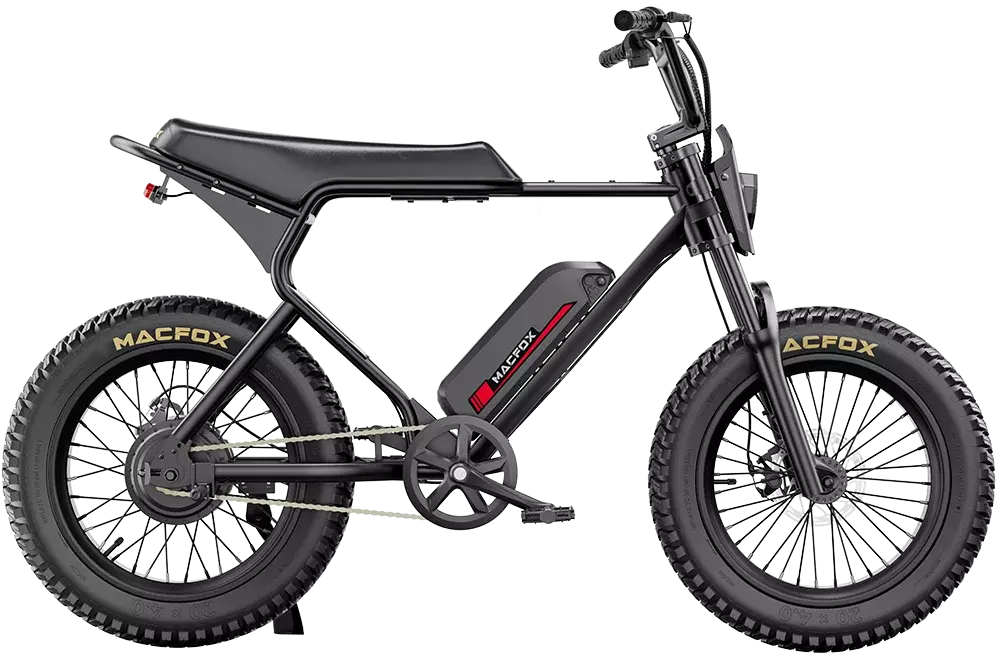
Are you thinking about getting an e-bike for your teen? Electric bikes are rapidly becoming the go-to choice for young riders thanks to their ease, speed, and fun factor. But with so many options on the market, picking the right e-bike can feel overwhelming.
Choosing the best e-bike for teens isn’t just about cool looks or speed—it’s about safety, comfort, and affordability. After all, teens need bikes that are easy to handle, reliable, and built with features designed just for them.
In this guide, you’ll discover the top 5 e-bikes for teen riders in 2025, handpicked for their safety features, budget-friendly prices, and teen-friendly design. Whether your teen is a beginner or ready for more serious rides, this review will help you find the perfect fit.
Pro Tip: Look for e-bikes with adjustable seats and handlebars—this helps the bike grow with your teen and ensures a comfortable ride every time.
Ready to find the perfect e-bike that balances fun, safety, and value? Let’s dive in!
Key Factors to Consider When Choosing an E-Bike for Teens
Picking the right e-bike for a teen is more than just finding a cool-looking ride. It’s about balancing safety, affordability, and features that make riding fun and easy. Here’s what to keep in mind:
Safety Features
Safety should always be the top priority. Look for bikes with:
- Speed limit controls to prevent teens from going too fast
- Reliable brakes, like disc brakes or regenerative braking, for smooth and quick stops
- A sturdy frame and durable design that can handle daily use and occasional bumps
- Lights and reflectors to keep riders visible during low-light conditions
Affordability
E-bikes come in a wide price range. For families on a budget, consider:
- Models priced reasonably without sacrificing essential features
- Bikes offering great value—durability and good warranty can save money in the long run
Teen-Friendly Features
Teens have unique needs, so check for:
- Adjustable seat height and handlebars so the bike fits growing riders comfortably
- A lightweight frame that’s easy to handle and maneuver
- Battery range that suits short trips, school commutes, or weekend adventures
- Simple, user-friendly controls and displays that teens can quickly learn
Legal and Age Restrictions
Before buying, be aware of:
- Local e-bike laws and age limits—some places require teens to be a certain age to ride specific types of e-bikes
- Helmet laws and safety gear recommendations to keep young riders protected on every ride
Pro Tip: Check your state or city’s regulations for e-bikes before making a purchase. Knowing the rules helps keep your teen safe and legal on the road.
Choosing an e-bike that combines these key factors will ensure your teen enjoys riding safely, comfortably, and confidently. Ready to explore the best options for 2025? Keep reading to find the top picks designed just for teen riders!
Top 5 E-Bikes for Teen Riders in 2025
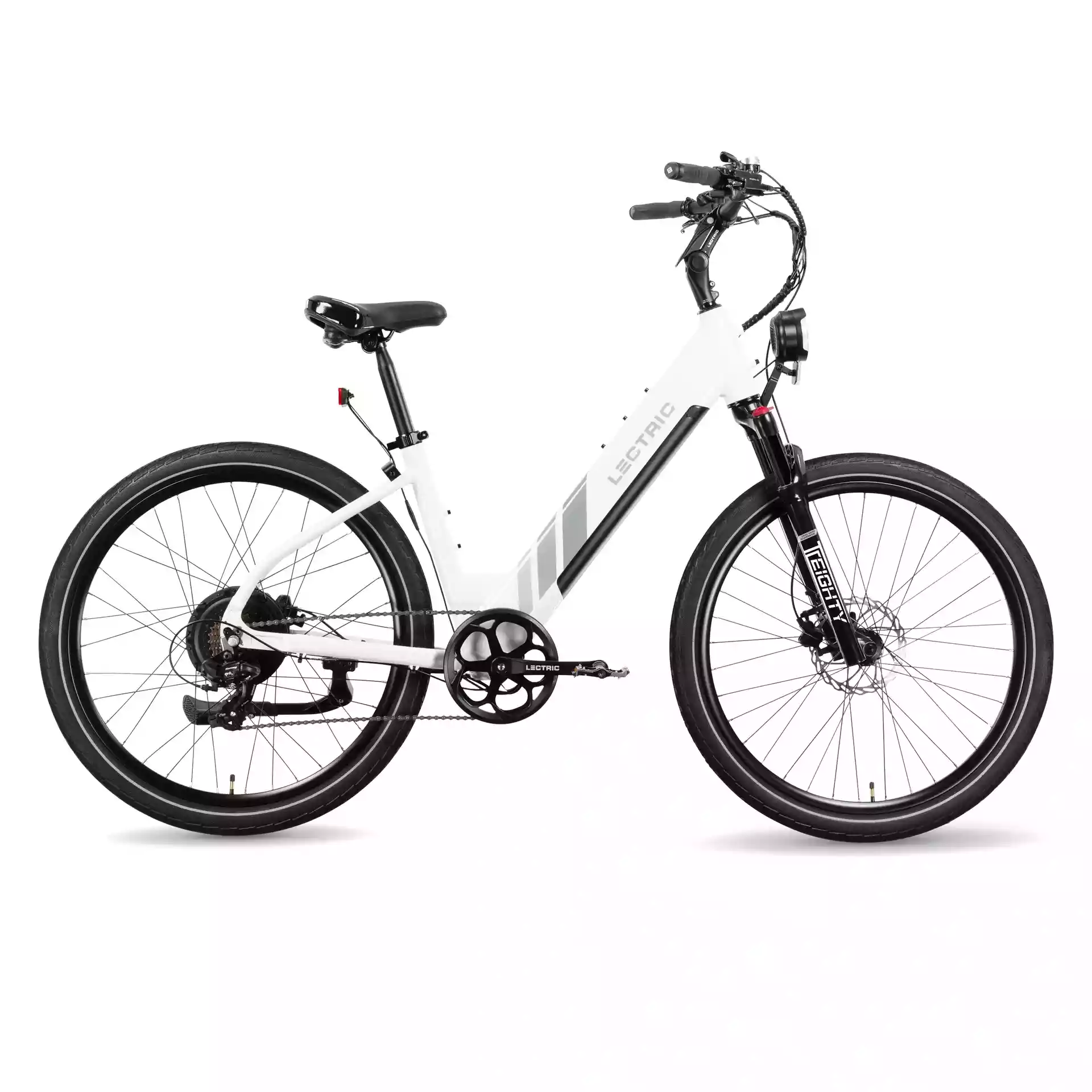
Lectric XPress 500W Step-Thru Electric Road eBike
The Lectric XPress offers a great balance of affordability and practical features, making it a perfect entry-level e-bike for teens. Priced around $1,000, it features a lightweight step-thru frame that’s easy to mount and handle.
Safety features include reliable disc brakes, multiple pedal-assist levels, and built-in speed limits to keep rides safe and controlled. The 500W motor provides enough power for daily commutes, with a typical range of 20–40 miles.
Comfort and convenience come from its slim, compact design, ideal for school runs and neighborhood cruising.
Pros: Affordable, easy handling, teen-friendly design
Cons: Range and ride smoothness are basic compared to premium models
Ride1Up Portola
Perfect for teens needing portability, the Ride1Up Portola is a folding e-bike starting at about $1,095. Its compact design folds quickly for easy storage in tight spaces.
It features hydraulic disc brakes for strong stopping power and a 750W motor with battery options providing 20–45 miles of range. A 20 mph top speed balances fun and safety.
The bike includes a rear rack, great for carrying backpacks or groceries.
Pros: Portable, solid brakes, good carrying capacity
Cons: Slightly heavy for a folding bike (around 62 lbs)
Engwe X20
For teens who love adventure, the Engwe X20 is a compact but powerful choice priced near $999. Its fat tires and triple shock absorbers provide stability and comfort on rough terrain.
Powered by a 750W motor, it can reach speeds up to 31 mph (check local laws) and offers an impressive 62-mile range per charge.
It folds down for storage and features grippy tires perfect for wet or gravel roads.
Pros: Stable, long range, fun off-road capability
Cons: Speed might require adjustment for younger riders
Macfox X1S
The Macfox X1S is a stylish and versatile e-bike around $999, designed for city riding and commuting. It includes mechanical disc brakes and integrated front and rear LED lights for enhanced visibility.
Its 500W motor (750W peak) offers a 38–76 mile range and a 25 mph top speed. Comfort features include a PU memory foam seat and fat tires suited to multiple surfaces.
The easy-to-read LCD display helps teens keep track of speed and battery.
Pros: Comfortable, long range, strong safety features
Cons: Heavier weight (65 lbs) may be cumbersome for some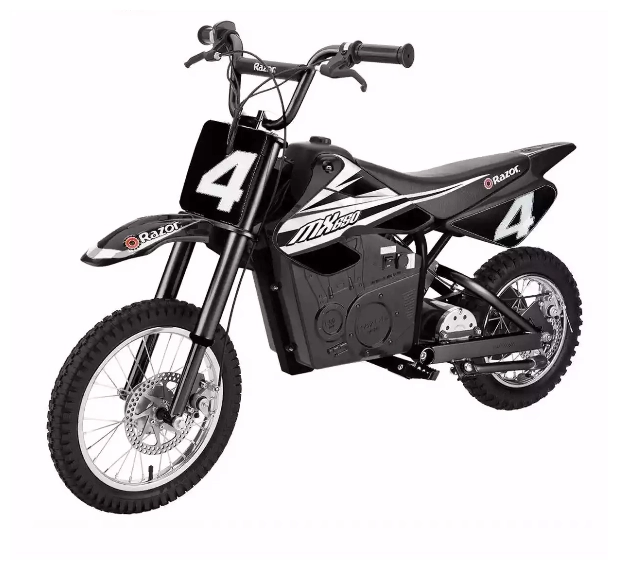
Razor MX650 Dirt Rocket
Ideal for teens looking for light off-road thrills, the Razor MX650 Dirt Rocket is priced under $900. It has dual-disc brakes, off-road tires, and a sturdy steel frame.
Its high-torque motor reaches speeds up to 17 mph with about 40 minutes of continuous use, making it a fun but manageable option.
Dual suspension adds comfort on bumpy trails, and the size fits younger or preteen riders well.
Pros: Durable, manageable speed, good for off-road fun
Cons: Shorter battery life and heavier frame
Pro Tip: Always check local laws about e-bike classes and speed limits for teens. Many areas restrict motor power and max speeds for young riders to keep them safe.
Finding the right e-bike means balancing safety, performance, and comfort—these top 5 models offer great options for teen riders in 2025. Ready to find the perfect e-bike and get your teen riding confidently?
How to Maintain an E-Bike for Teens
Taking good care of an e-bike keeps it running smoothly, safe, and ready for every ride. Teaching teens basic maintenance is not only smart—it builds responsibility and helps them enjoy their bike longer.
Basic Maintenance Tips for Longevity and Safety
- Keep the battery charged but avoid overcharging; unplug once full to protect battery health
- Check tire pressure regularly—properly inflated tires improve performance and reduce flats
- Clean the bike after rides, especially if it’s been wet or muddy, to prevent rust and wear
- Inspect brakes and cables often to make sure everything stops smoothly and safely
- Lubricate the chain occasionally to avoid squeaks and keep pedaling easy
Teaching Teens Responsible E-Bike Care
Encourage teens to:
- Do a quick safety check before each ride—tires, brakes, lights, and battery level
- Store the bike indoors or under cover to protect it from weather damage
- Report any strange noises or issues right away so small problems don’t become big ones
Recommended Maintenance Schedule
- Weekly: Tire pressure, brake function, and battery charge
- Monthly: Clean the bike thoroughly, inspect the drivetrain, and lubricate the chain
- Every 6 months: Take the bike for a professional tune-up to check motor and electrical components
Pro Tip: Make maintenance a fun routine by setting reminders or turning it into a quick weekend check-up with your teen. It keeps their e-bike in top shape and teaches great habits.
A well-maintained e-bike is safer, lasts longer, and delivers a better riding experience—perfect for teens who want to keep exploring. Ready to help your teen get the most out of their e-bike?
Safety Tips for Teen E-Bike Riders
Getting on an e-bike is exciting, but safety should always come first. Teaching teens good safety habits helps them enjoy every ride with confidence and peace of mind.
Wear Helmets and Protective Gear
The simplest way to stay safe is wearing a helmet every time you ride. It protects against head injuries and is often required by law for teen riders. Adding gloves, knee pads, and elbow pads can boost protection, especially on rougher terrain or busy streets.
Follow Riding Etiquette and Rules
Good habits keep everyone safe on the road and trails. Remind teens to:
- Always ride on the right side of the road or bike lane
- Use hand signals when turning or stopping
- Obey traffic lights and signs—e-bikes are vehicles too!
- Keep a safe distance from pedestrians and other cyclists
- Avoid distractions like headphones or phones while riding
Choose Safe Routes and Environments
Beginners should stick to quiet streets, bike paths, or parks with low traffic. This lets teens practice handling their e-bike without the stress of busy roads. Over time, they can build confidence and move on to more challenging routes safely.
Pro Tip: Practice riding with your teen in a safe, open area before heading out on public roads. It’s a fun way to build skills and discuss safety together.
Keeping safety front and center ensures teens have more fun and fewer worries. Ready to help your teen ride smart and safe? Find the perfect e-bike now!
Final Thoughts
Choosing the right e-bike for your teen means finding a balance between safety, affordability, and features that make riding fun and comfortable. A teen-friendly e-bike encourages confidence and independence while keeping safety front and center.
Involve your teen in the decision process—letting them test ride different models helps ensure the bike fits their style and needs. This way, they’re more excited to ride and more likely to care for their bike responsibly.
Pro Tip: Prioritize safety features like speed limits and reliable brakes, and always make sure your teen wears a helmet.
Ready to help your teen find the perfect e-bike? Explore the options, test a few models, and get them geared up for a safe, exciting ride!
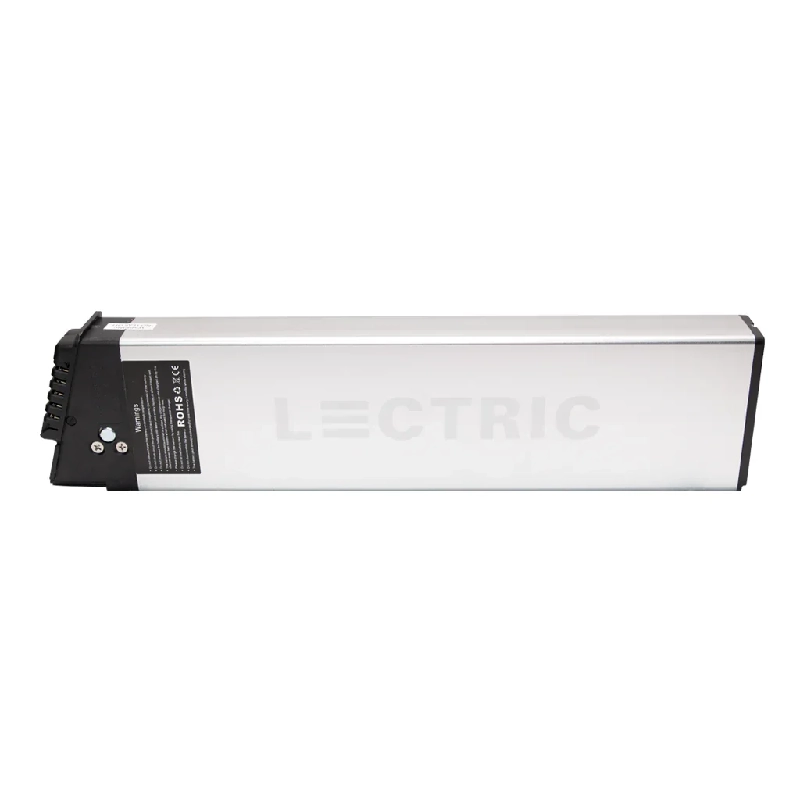
If there’s one thing every serious e-bike rider craves, it’s range. Whether you're commuting across town, tackling long scenic routes, or just want peace of mind on the trails, how far your battery takes you makes a huge difference.
In this guide, we’ll break down the key factors that determine real-world battery performance—like watt-hours, voltage, and battery chemistry—plus highlight some of the best long-range e-bikes available today. You’ll also get simple, practical tips to make your battery last longer and perform better.
Let’s clear up the confusion around range numbers and help you ride farther, smarter, and with confidence.
What Really Impacts E-Bike Battery Range
Battery Capacity: Watt-Hours (Wh) Matter Most
Think of watt-hours (Wh) as your battery’s fuel tank. The higher the number, the longer your ride—in theory.
- A 500Wh battery typically gives 25–45 miles, depending on terrain and assist level.
- A 750Wh battery can go 45–70 miles, great for longer commutes or hilly rides.
- A 1000Wh battery? You're looking at up to 100+ miles with conservative riding.
Pro Tip: To estimate real range, divide Wh by 20 for throttle-heavy rides or by 15 for moderate pedal assist.
Voltage and Motor Efficiency
Voltage is like horsepower—it impacts how hard your motor can push.
- 36V systems are common in casual commuter e-bikes.
- 48V gives a stronger boost, especially uphill or with cargo.
- 52V is found in high-performance and off-road models.
A high-voltage battery paired with an efficient motor can extend range by reducing the strain on each ride.
Battery Chemistry: It’s Not All the Same
Most e-bikes today use lithium-ion batteries, which offer solid performance, but there are variations:
- Li-ion (Lithium-ion): Lightweight, high capacity, decent lifespan.
- LiFePO4 (Lithium iron phosphate): More stable and longer-lasting, but heavier.
- NiMH and lead-acid: Outdated and rarely used in quality e-bikes.
Look for cells from trusted names like Samsung, LG, or Panasonic for reliability.
Other Things That Affect Your Range
Even with a top-tier battery, range depends on how and where you ride. Here’s what can shrink (or boost) your mileage:
- Rider weight and cargo load
- Tire pressure and tread
- Assist level (eco vs turbo)
- Headwinds and hills
- Start-stop city riding vs steady cruising
Pro Tip: Keep your tires inflated and ride in lower assist modes to maximize range without sacrificing comfort.
Top Long-Range E-Bikes Worth Checking Out
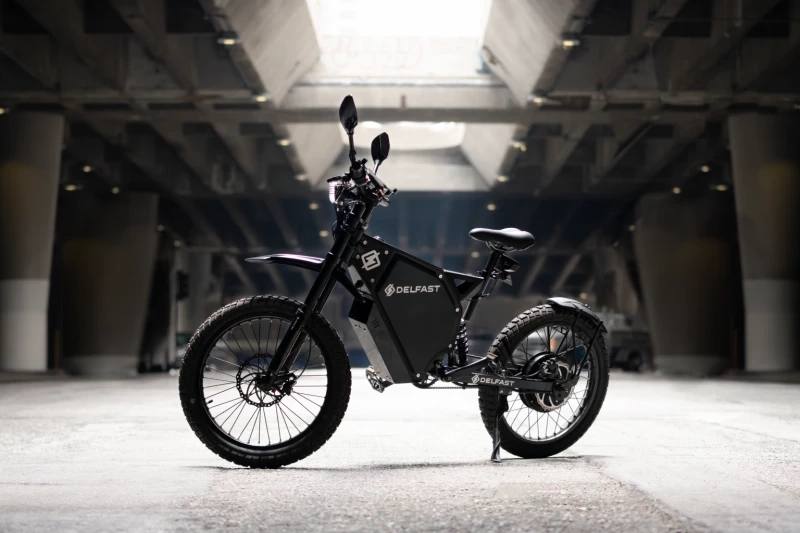
Delfast Top 3.0 – Up to 200 Miles
An industry leader for extreme distance. Equipped with a 3000Wh battery and 72V system, it’s practically a motorcycle with pedals.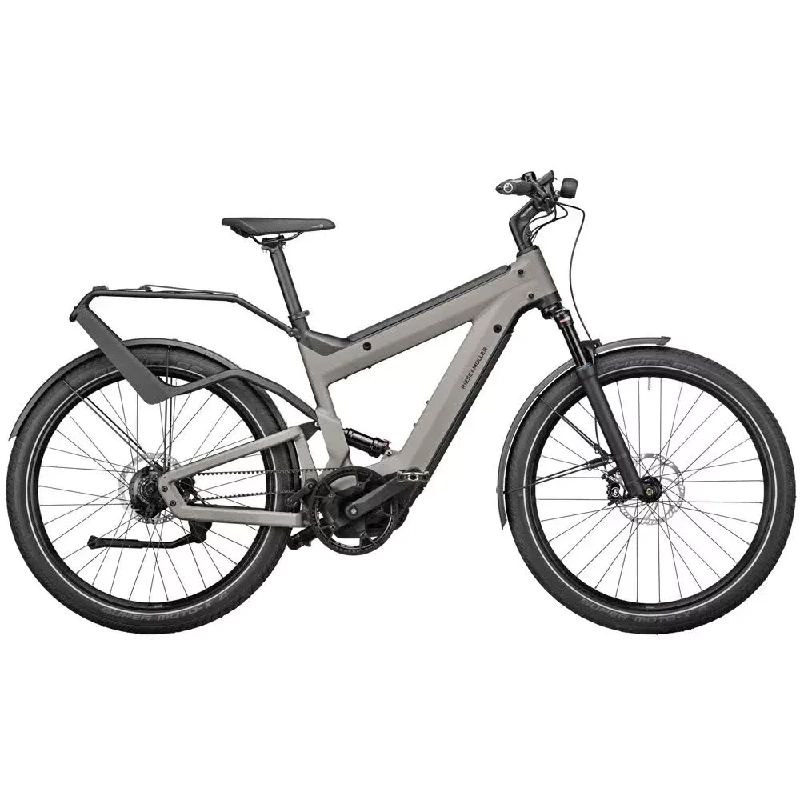
Riese & Müller Superdelite GT – Dual Battery System
Dual 625Wh Bosch PowerTube batteries offer up to 100 miles. Ideal for riders who want premium tech and full-suspension comfort.
Himiway Zebra – Budget-Friendly Long Range
With a 960Wh battery and fat tires, this model can hit up to 80 miles per charge—at a surprisingly affordable price point.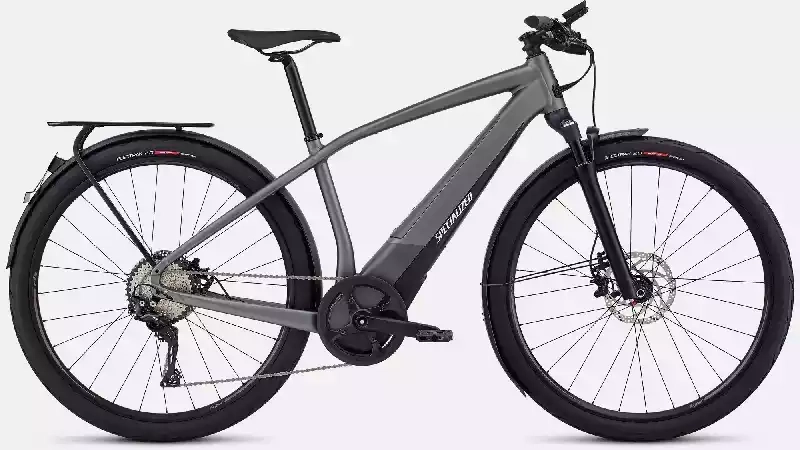
Specialized Turbo Vado 5.0 – Premium Commuter
A sleek 710Wh battery paired with smart range management gives 70–90 miles of urban and suburban freedom.
Dual Battery Systems: Are They Worth It?
Some high-end bikes now come with dual battery setups, letting you double your range without swapping packs mid-ride.
Benefits:
- Ride farther without range anxiety
- Balanced weight distribution on premium frames
- Less frequent charging
Consider this if you tour, ride hilly terrain, or just love long rides with zero interruptions.
Can You Upgrade Your Battery?
Yes—but do it carefully. Many e-bike brands sell aftermarket or extended-range batteries, but compatibility is key.
Look for:
- Matching voltage and connector type
- Same brand or approved third-party seller
- Whether the controller and motor can handle more juice
Skipping these steps could void your warranty or even damage your bike.
Battery Care Tips to Extend Lifespan
A long-range battery isn’t just about size—it’s about how you treat it.
Charging Do’s and Don’ts
- Don’t charge to 100% daily—stop at 80–90% when possible.
- Avoid full discharges—try not to drop below 10%.
- Use the original charger to prevent overheating or short-circuiting.
Storage and Handling
- Store at 40–70% charge if not riding for a few weeks.
- Keep in a cool, dry place—extreme heat kills battery cells.
- Never leave it in a hot car or freezing garage.
Basic Maintenance
- Clean contacts gently with a dry cloth
- Inspect regularly for swelling or damage
- Don’t hose it down—use a damp rag and be careful near ports
What to Look for in a Long-Range Battery Setup
When choosing your next e-bike or upgrade, keep these points in mind:
- Minimum 600Wh for moderate-range needs, 750Wh+ for long rides
- Look for trusted cells (Samsung, LG, Panasonic)
- Prefer removable batteries for easy charging
- Consider total weight—bigger battery = heavier ride
- Check the warranty—some batteries come with 1–2 year guarantees
Battery range can make or break your e-bike experience. The good news? With the right knowledge, setup, and care, you can ride farther and worry less.
Whether you’re shopping for a powerful commuter, an all-day adventurer, or just want to get the most out of your current setup—battery matters most.
Ready to ride longer? Start by checking your current battery’s specs or exploring long-range e-bikes that fit your style and budget.
What Determines E-Bike Battery Range?
Not all e-bike batteries are created equal—and just looking at the advertised “miles per charge” won’t give you the full picture. Real-world range depends on several technical factors, from battery size to motor voltage, plus how you actually ride.
Let’s break it all down in plain English so you can confidently choose the best long-range e-bike or upgrade your current setup.
Battery Capacity (Watt-hours or Wh)
Watt-hours (Wh) are the #1 number to look for when comparing e-bike batteries. It tells you how much energy the battery stores—and more Wh generally means more miles.
- Formula: Voltage × Amp-hours = Watt-hours
- 500Wh: Common on mid-range commuter bikes. Expect 25–45 miles with mixed usage.
- 750Wh: A solid upgrade for longer range. You’ll get up to 60 miles on pedal assist.
- 1000Wh+: Great for touring or hilly terrain—often 70–100+ miles per charge.
Pro Tip: Divide the battery’s Wh rating by 20 for throttle-heavy rides or by 15 for mixed pedal assist to estimate real-world range.
Voltage and Motor Compatibility
Voltage plays a big role in how much power your e-bike delivers—especially when climbing hills or accelerating with cargo.
- 36V systems: Ideal for flat terrain and casual riding
- 48V systems: More torque and better suited for hills or heavier riders
- 52V systems: High-performance setups often used in mountain or fat-tire e-bikes
Pairing your voltage correctly with the motor and controller ensures smoother performance and helps preserve battery life. Too much voltage for the motor can cause overheating, while too little can make your ride feel underpowered.
Pro Tip: Look for e-bikes that match a 48V or 52V battery with a 500W+ motor for the best balance of speed, efficiency, and hill-climbing ability.
Battery Chemistry
You might see fancy terms like “Li-ion” or “LiFePO4” when shopping around. Here's what that really means:
- Lithium-ion (Li-ion): The most common and well-balanced choice. Lightweight, decent lifespan, and good range.
- Lithium Iron Phosphate (LiFePO4): Safer and longer-lasting (1,500–2,000 charge cycles), but usually heavier and more expensive.
- Nickel or Lead-acid: Outdated—avoid these in modern e-bikes unless you’re buying used on a budget.
Why it matters: Some chemistries handle heat better, charge faster, and last longer. That can affect how far you go—not just today, but two years from now.
Other Factors That Affect Range
Even with the best battery on the market, range can still vary wildly depending on your riding conditions. Here’s what else plays a role:
- Rider weight and cargo: Heavier loads = faster drain
- Terrain: Flat city streets preserve power; hills eat it up
- Wind resistance: Headwinds can reduce range significantly
- Assist level: Riding in turbo mode will cut your range in half
- Tire pressure and type: Under-inflated tires add rolling resistance
Pro Tip: Ride in eco or tour mode and keep tires inflated to the recommended PSI to get the most out of every charge.
Understanding how these elements work together helps you choose a bike that fits your lifestyle—and avoid the disappointment of buying a “long-range” e-bike that falls short in real life.
Coming up next: We’ll explore the top long-range e-bikes on the market and what makes them stand out.
Top Long-Range E-Bike Batteries on the Market
Looking for an e-bike that can go the distance? Some models are built with ultra-efficient systems and massive batteries that make range anxiety a thing of the past. Whether you're planning cross-city commutes or long adventure rides, these are the models worth checking out.
Models With Exceptional Range
Here are four of the best long-range e-bikes available right now—each packed with powerful battery systems and smart engineering.
- Delfast Top 3.0
This beast offers up to 200 miles per charge, making it one of the longest-range electric bikes on the market. With a 72V 48Ah battery (3456Wh), it's basically a light electric motorcycle with pedals. - Riese & Müller Superdelite GT
A premium dual-battery touring bike that delivers up to 100 miles on eco mode. Its integrated Bosch system uses two 625Wh PowerTube batteries for long-distance riding with full suspension comfort. - Himiway Zebra
A budget-friendly fat tire e-bike with a 960Wh battery that can deliver up to 80 miles on a single charge. Perfect for city cruising and light off-road adventures. - Specialized Turbo Vado 5.0
A sleek commuter bike powered by a 710Wh battery, offering 70–90 miles of range depending on rider settings and terrain. Ideal for urban riders who want power with style.
Real-world note: Manufacturer range claims are usually based on ideal conditions. Expect real-world mileage to be about 10–20% lower, depending on your ride style and environment.
Pro Tip: If you're riding in hilly areas or using high pedal assist levels often, prioritize bikes with 750Wh or larger batteries to avoid daily charging.
Dual Battery Systems
Want to ride even farther without swapping batteries mid-ride? Dual battery systems might be your answer.
How it works: Two batteries are connected in parallel, either built into the frame or mounted externally. The system draws power from one or both batteries, depending on design.
Benefits:
- Double the range without compromising performance
- Automatic switching between batteries (in most modern systems)
- Ideal for touring, delivery, or long commutes
Top bikes with dual battery options:
- Riese & Müller Superdelite
- Gazelle Ultimate C380+ Dual Battery
- BULLS Lacuba EVO E8
Who needs dual batteries?
- Riders commuting 50+ miles daily
- Adventure cyclists who ride remote trails
- People who don’t want to charge every day
Pro Tip: Check how the bike balances the battery weight—some dual battery setups can feel top-heavy if not well-designed.
Aftermarket Battery Upgrades
Already have an e-bike but want more range without buying a new one? An aftermarket battery upgrade could be your solution—but there are a few things to know before diving in.
When to upgrade:
- Your current battery no longer holds a charge
- You want longer rides without recharging
- You’ve added accessories (like a trailer or extra lights) that draw more power
Top aftermarket battery brands:
- Luna Cycle
- Grin Technologies
- Unit Pack Power (UPP) – widely compatible with budget e-bikes
- Bosch and Shimano – for OEM upgrades (brand-specific)
What to watch out for:
- Voltage and connector compatibility
- Whether your motor/controller supports larger capacity
- Battery mount and frame space
- Warranty concerns—aftermarket changes may void your e-bike’s original warranty
Pro Tip: Never upgrade to a higher voltage without checking with the manufacturer. Doing so could damage your controller or motor.
With so many high-capacity and efficient options available, it’s easier than ever to find (or build) an e-bike that meets your real-world range needs. Next, we’ll show you how to keep that battery in top shape—because the best battery is one that lasts.
Battery Care Tips to Maximize Lifespan
A high-quality e-bike battery is a big investment—so why not make it last as long as possible? With a few simple habits, you can extend your battery’s lifespan by years and avoid losing range over time.
Here’s how to charge, store, and maintain your e-bike battery the smart way.
Charging Best Practices
How (and how often) you charge your battery makes a huge difference. Most e-bike batteries are lithium-ion, which prefer partial charging rather than full cycles.
- Don’t charge to 100% every time – Stop at 80–90% if you’re not doing a long ride
- Avoid deep discharges – Try not to let the battery drop below 10%
- Use the original charger – Other chargers might overheat or damage the battery cells
Pro Tip: If your e-bike app allows it, set a charge limiter to stop at 80%. This helps preserve battery health over the long haul.
Storage Tips
Not riding for a few weeks? How you store your battery during downtime directly affects its performance later.
- Store between 40–70% charge – Fully charged or empty batteries degrade faster
- Avoid extreme heat or cold – Don’t leave your battery in a hot car or freezing shed
- Use a battery cover or case – Especially if you ride or store your e-bike outdoors
If you’re putting your bike away for the season, check the charge once a month and top it off if needed.
Pro Tip: Room temperature (around 60–70°F) is ideal for battery storage. Avoid places like attics, garages, or backseats that swing hot and cold.
Cleaning and Maintenance
Keeping your battery clean and damage-free helps prevent issues that could shorten its life—or worse, create safety risks.
- Wipe battery contacts with a dry or slightly damp cloth – Avoid moisture in ports
- Never hose down your e-bike – Water pressure can force liquid into battery seals
- Inspect regularly – Look for cracks, swelling, or discoloration around the casing
If you notice odd smells, sudden drops in range, or visible bulging, it’s time to stop riding and consult the manufacturer or your local bike shop.
Taking good care of your battery doesn’t have to be complicated—it just takes a little attention to detail. Next up, we’ll help you choose the best long-range battery setup for your riding style and goals.
Buying Tips: What to Look for in a Long-Range E-Bike Battery
Choosing the right battery can make all the difference in your e-bike experience. Whether you’re a daily commuter or weekend adventurer, knowing what to look for helps you pick a battery that matches your riding goals—and lasts for years.
Minimum Capacity to Aim For
Your battery’s capacity, measured in watt-hours (Wh), directly impacts how far you can go.
- For casual city riding or short commutes, aim for at least 400–500Wh.
- If you want longer rides or tackle hills, look for 750Wh or more.
- Touring riders or those needing maximum range should consider 1000Wh+ batteries.
Trusted Battery Cell Brands
Not all batteries are built equal. Look for batteries using cells from well-known manufacturers like:
- Samsung
- LG
- Panasonic
These brands are known for consistent quality, safety, and longevity. Batteries from unknown brands may be cheaper but often come with trade-offs in reliability.
Removable vs Integrated Designs
- Removable batteries let you charge off the bike, making it easier to top up at work or home.
- Integrated batteries offer a sleeker look and better weight distribution but usually require charging the entire bike.
If you expect to charge frequently in different locations, a removable battery is usually more practical.
Weight vs Range Trade-Offs
Bigger batteries mean more range—but also more weight.
- Heavier batteries can make your bike harder to handle, especially off-road or when lifting it.
- Consider how much range you really need versus how much extra weight you’re comfortable with.
Warranty and Brand Support
Finally, check the battery’s warranty—at least 1 year is standard, but some brands offer 2 years or more. Good customer support can save you headaches if anything goes wrong.
Pro Tip: Always register your battery with the manufacturer after purchase to activate warranty and get updates.
Picking the right battery is key to getting the most from your e-bike. With these tips, you’re ready to find a battery that powers your rides for years to come.
Ready to ride farther? Explore the best e-bikes for your needs and enjoy the freedom of extended range!
Final Thoughts
Choosing the right e-bike battery is essential to enjoy longer rides without worrying about running out of power. We’ve covered the key factors that matter most: battery size, chemistry, voltage, and proper battery care.
Remember, the best battery setup depends on your riding style and goals. Whether you’re commuting daily, exploring trails, or just cruising on weekends, selecting the right battery will make your rides smoother and more enjoyable.
Pro Tip: Don’t hesitate to research and test different models to find what suits you best. Upgrading your existing battery is also a smart way to get more freedom without buying a whole new bike.
Ready to ride farther and smarter? Dive into the world of long-range e-bikes and take your cycling adventures to the next level!

E-bikes have gone from niche to mainstream—and along the way, they’ve gained a passionate community of creators who do more than just ride. These influencers test limits, share tips, and show how electric bikes fit into every kind of lifestyle.
This article highlights the standout personalities shaping the e-bike space. Whether you’re a casual rider, a speed junkie, or somewhere in between, these creators will fuel your passion for electric riding.
Why E-Bike Influencers Matter
E-bike influencers don’t just create content—they build trust. Their videos, photos, and posts shape opinions on what to ride, how to ride, and which upgrades are worth your time and money.
You’ll find them on:
- YouTube for in-depth reviews, stunts, and long rides
- TikTok for quick tips, POVs, and relatable moments
- Instagram for visual inspiration, gear setups, and commuter aesthetics
- Blogs and forums for detailed reviews, tech breakdowns, and buyer guides
What they bring to the table:
- Hands-on testing
- Real-world range and terrain insights
- Honest opinions (good and bad)
- Creative builds and customization ideas
YouTube Stars in the E-Bike World

Sur Ronster
One of the most recognizable names in the high-performance electric bike space, Sur Ronster creates bold, cinematic content packed with stunts, DIY builds, and over-the-top rides. He’s known for transforming e-bikes into off-road monsters, racing scooters, and even mobility devices that go 60 mph.
Why riders follow him:
- Entertaining, adrenaline-heavy content
- POV rides through cities, hills, and trails
- Original e-bike transformations you won’t see anywhere else
If you're curious about what electric bikes can really do when pushed to the edge, Sur Ronster is a must-watch.
Micah Toll
An e-bike educator at heart, Micah is trusted by both beginners and pros for his clear, technical breakdowns. He covers everything from budget city bikes to high-end fat tires—and explains the "why" behind the specs in plain language.
He’s also known for creating DIY e-bike tutorials and helping people get the most out of their gear through practical advice and repair guides.
Area 13 / Bolton Ebikes
This channel is all about affordable performance. Focused on real-world testing and side-by-side comparisons, they cover a range of e-bikes—from basic commuters to high-powered fat tire models. Great for riders who want reliable reviews without the hype.
TikTok Creators Making E-Bikes Relatable
@BikeManDan
This creator blends humor and helpful tips for urban riding. His skits poke fun at daily commuter life while still teaching new riders how to navigate traffic, boost range, and stay safe in the city.
@EbikeAdventures
Focused on POV rides, daily logs, and behind-the-scenes clips of commuting with an e-bike, this account gives a more grounded look at electric riding. The focus is on consistency, practical tips, and real rider experiences.
Why TikTok works:
It’s fast, real, and built for discovery. One great video can make a new e-bike trend take off overnight.
Instagram Creators With a Visual Edge
@ElectricBikeJournal
Known for curated, clean photos and aesthetic gear shots, this account blends lifestyle and product in a way that inspires. It’s ideal for discovering new accessories, commuter setups, and brand launches.
Style-Centric Creators
There’s a growing group of e-bike creators who focus on style, often posting streetwear, architecture, and sleek city scenes with their e-bike in the mix. Perfect for riders who want their gear to look as good as it performs.
Pro Tip: Follow accounts that match your riding goals—cargo setups, city commutes, or weekend trail rides—for more relevant ideas.
Long-Form Creators and Educators
Electric Bike Blogs
While social media thrives on speed, blogs are where many buyers go for deep dives. Some of the most trusted e-bike blogs focus on reviews, range testing, and buying guides. They often test dozens of models each year and break down the specs in ways that help people make smarter choices.
DIY and Repair Educators
Creators with a focus on tech and DIY (like Micah Toll) provide value beyond riding. Their tutorials help riders fix their own bikes, swap out motors or batteries, and get more life out of each component.
How Brands Collaborate with Influencers
As e-bikes grow in popularity, brands increasingly rely on influencers to launch new products, build trust, and reach targeted audiences.
Common collaborations include:
- Sponsored reviews with honest feedback
- Discount codes and affiliate deals
- Product giveaways
- Behind-the-scenes looks at upcoming models
Sur Ronster, for example, is often seen riding pre-release or customized bikes that spark huge interest—and give brands a high-energy, viral showcase.
How to Find E-Bike Influencers Without the Noise
Skip the search engine overwhelm by using these discovery tools:
Check out:
- Hashtags like #ebike, #ebikelife, #rideelectric, and #surron
- Reddit communities for electric bike riders
- Facebook and Discord groups focused on specific models or riding styles
- YouTube’s suggested videos based on your favorite creators
From casual commuters to electric motocross fans, you’ll find someone who rides like you—and can help you ride better.
Why E-Bike Influencers Matter
What makes someone buy an electric bike for the first time? It’s often a video, post, or story that shows how fun, practical, and game-changing it can be.
That’s the power of e-bike influencers. They don’t just show off specs—they tell stories, build trust, and make riding electric feel approachable and exciting.
Whether it’s a fast-paced YouTube review or a slick TikTok reel of someone zipping through traffic, this content sparks curiosity and builds confidence for first-time buyers and experienced riders alike.
They Help People Discover What’s Possible
E-bike influencers are often the first touchpoint for someone exploring electric mobility. They show the range of options—from budget-friendly city cruisers to all-terrain beasts—and how they fit into real lives.
Common types of content include:
- Reviews and buying guides that break down the best e-bikes for different riders
- Stunt riding and challenges that push bikes to their limits (and show what not to do)
- DIY upgrades and custom builds that highlight the modding side of the hobby
- Scenic rides and urban commuting, giving a realistic view of daily use
- Maintenance and repair tutorials to help owners stay self-sufficient
Pro Tip: If you’re unsure what kind of e-bike fits your lifestyle, follow creators who ride in similar conditions—commuters, parents, off-roaders, or weekend cruisers.
They Dominate Key Platforms
E-bike creators thrive across multiple platforms, each offering a different experience:
- YouTube is best for long-form reviews, in-depth comparisons, and cinematic rides
- TikTok delivers quick, punchy content that goes viral fast—great for tips and trends
- Instagram highlights clean setups, beautiful scenery, and gear inspiration
- Twitter/X brings the latest e-bike news, thoughts, and hot takes
- Personal blogs offer long-term value with well-researched reviews and guides
This multi-platform presence allows influencers to meet potential riders where they already are—and build trust over time.
They Inspire, Teach, and Entertain
The most successful e-bike influencers aren’t just riders—they’re educators and entertainers. They take complex things like motor wattage, battery capacity, or frame geometry and explain them in plain English, often with a sense of humor and personal style.
They also build community, turning a solo ride into something bigger—whether through comments, livestream Q&As, or group ride invitations.
Pro Tip: Influencers who engage with their audience directly (answering questions, testing bikes viewers request, etc.) are a great source of honest feedback.
Instagram Influencers Bringing the Aesthetic
E-bikes don’t just ride well—they can look amazing, too.
Instagram is the platform where visuals take center stage. It's where e-bike influencers showcase clean setups, scenic routes, and gear that turns heads. These creators blend function with form, offering a stylish take on electric biking that goes beyond performance specs.
@ElectricBikeJournal
If you're into sleek bike shots, premium gear, and minimalist design, @ElectricBikeJournal nails the aesthetic. The content is polished and professional, with a strong focus on lifestyle photography and high-end accessories.
Why it’s worth a follow:
- Premium e-bike setups and clean branding
- Stylish gear recommendations (helmets, lights, bags)
- Scenic backdrops that make you want to ride
This account is a go-to for riders who want their bikes to be both functional and fashionable—especially if you’re exploring commuter builds or cargo-style setups.
@CycleChic (or similar style-focused creators)
This category of influencer brings a fashionable lens to the e-bike world, often blending urban design, streetwear, and clean cityscapes with their daily ride. Think European bike culture meets modern Instagram storytelling.
What you’ll find:
- Fashion-forward commuting
- Cozy, bike-friendly outfits for every season
- Scenes from stylish cities like Copenhagen, Paris, or Amsterdam
Pro Tip: Looking for inspiration on how to match your ride to your wardrobe—or want to see how others integrate e-bikes into their daily routine? These creators offer endless ideas for practical but elevated style.
The Instagram Angle
Instagram is all about selling the look of electric biking. It’s less about top speed and more about the lifestyle: how a bike fits your space, complements your gear, or upgrades your weekend plans.
That’s why many riders use Instagram as a visual e-bike buying guide—not just to compare models, but to imagine how each one fits into their everyday life.
What makes IG different:
- Reels that showcase riding in motion
- Grid layouts for comparing bikes and accessories
- Behind-the-scenes peeks at rider routines and setup tips
Bloggers and Long-Form Creators
Need a deeper dive before you buy? Long-form e-bike blogs are where serious research begins.
While social media is great for quick inspiration, blogs offer evergreen, searchable content packed with detailed specs, test data, and expert opinions. These creators take the time to break down bikes, parts, and accessories so that readers can make confident decisions—whether they’re new to e-bikes or upgrading their current setup.
ElectricBikeReport.com
This site is a trusted destination for riders who want in-depth testing, clear comparisons, and structured buying advice. The reviews cover everything from budget commuters to premium cargo bikes—and always with a rider-first mindset.
Why riders value it:
- Clear formatting and honest pros/cons
- Real-world testing of speed, range, and comfort
- Yearly updates with new models and trends
It’s a helpful stop if you’re looking for the best e-bikes for commuting, hills, or family hauling, with side-by-side reviews and ratings that cut through the clutter.
EbikeSchool.com (Micah Toll)
Micah Toll, also known from YouTube, brings a more technical perspective with this long-running educational site. It’s ideal for DIY riders and anyone curious about how motors, batteries, and controllers work together.
What you’ll find:
- How-to guides for building or upgrading e-bikes
- Clear explanations of motor wattage, battery voltage, and range estimates
- Tips for diagnosing common issues and improving performance
Pro Tip: If you’re planning to buy an e-bike and eventually customize it—or you just want to understand what makes one model better than another—this type of blog content is a game changer.
Why Long-Form Content Matters
E-bike blogs offer value long after a video or post disappears from a feed. Their content:
- Is searchable and easy to reference later
- Often includes charts, specs, and test results
- Gives you confidence during the buying process
These creators build trust through transparency and consistency—and their reviews often stay relevant for years.
Creators Carving Out Their Own Lanes
As the e-bike market grows, so do the communities around specific lifestyles and use cases. These new creators aren’t chasing trends—they’re documenting what works in real time.
Here are a few common types of up-and-comers:
- Delivery-focused TikTok riders: Creators who log 40+ miles a day using high-range commuter e-bikes for food delivery, sharing battery hacks, gear tips, and route planning tricks.
- Camping and long-distance explorers on YouTube: Riders using solar setups, fat tire bikes, and cargo frames to travel off-grid and document every step.
- DIY e-bike tinkerers: Passionate builders who modify thrifted bikes, add custom motors, or build frames from scratch and show the process start to finish.
- Lifestyle vloggers with e-bike commutes: College students, small business owners, and city dwellers documenting how e-bikes replace cars in their everyday lives.
What Makes Them Stand Out
These creators bring something fresh and valuable to the space:
- Authenticity: They’re not trying to be polished—they’re trying to be real.
- Niche content: Whether it’s delivery riding, camping, or city commuting, their content has a clear focus.
- Growing engagement: Smaller accounts often reply to comments, take content suggestions, and build loyal followings faster.
Pro Tip: Following newer creators gives you a front-row seat to their journey—and often early insights into gear, routes, and strategies most big influencers haven’t touched yet.
How Brands Work with E-Bike Influencers
Ever wonder how your favorite e-bike brands get in front of thousands—or even millions—of riders? Influencers play a big role in that story.
Brands team up with content creators to showcase new models, highlight features, and bring the e-bike lifestyle to life in fresh, exciting ways. These partnerships help riders discover the latest gear through trusted voices they already follow.
Popular Brand Partnerships
Many leading e-bike brands collaborate with influencers to reach wider audiences and build buzz around new launches. Some of the big names include:
- Lectric
- Aventon
- Super73
- Sur-Ron
- Ride1Up
These brands often work with creators who align with their style—whether that’s urban commuters, off-road enthusiasts, or adventure seekers.
Types of Collaborations
Brands and influencers team up in various ways, each designed to engage potential buyers and provide authentic insights:
- Sponsored reviews and shout-outs: Influencers test bikes and share honest opinions, helping viewers make informed choices.
- Affiliate links and coupon codes: Fans get special deals while creators earn commissions, making it a win-win.
- Product demos and launch previews: Creators get early access to new models and show them off with exclusive content.
- Giveaways and social contests: Engaging followers with chances to win gear or bikes, boosting community excitement.
Sur Ronster: A Visual Collaboration Powerhouse
Sur Ronster’s collaborations stand out thanks to his visually stunning, stunt-heavy videos. His dynamic riding style and custom builds create viral content that feels more like entertainment than a simple review.
This kind of partnership not only drives awareness but also showcases the extreme potential of certain e-bikes, inspiring viewers to push their own limits.
Pro Tip
When watching influencer content tied to brands, look for genuine opinions and clear disclosures about sponsorships. Authenticity helps you trust the review and make smarter buying decisions.
How to Follow and Find E-Bike Influencers
Looking to stay in the loop with the latest e-bike trends and tips? Knowing where and how to find the right influencers is key.
E-bike content is everywhere—but some platforms and strategies stand out for discovering fresh voices, expert reviews, and lifestyle inspiration. Here’s how to connect with the e-bike community and follow creators who match your riding style.
Hashtags to Track
Start with popular hashtags to explore posts and discover new creators:
- #ebike — The broadest tag, covering everything from tech to lifestyle
- #surron — Perfect if you’re into high-performance off-road electric bikes
- #ebikelife — Focused on everyday riders sharing their adventures
- #rideelectric — Showcases electric mobility in all its forms
Searching these tags on Instagram, TikTok, or Twitter can quickly lead you to active accounts and viral content.
Best Platforms for Following
Different platforms serve different types of content—choose what fits your interests:
- YouTube: Ideal for detailed reviews, long test rides, and in-depth tutorials. Perfect if you want to dive deep into specs and performance.
- TikTok: Great for short, engaging videos, quick tips, and trending challenges. Ideal for fast discovery and daily e-bike inspiration.
- Instagram: The place for stylish shots, lifestyle posts, and community engagement. If you love aesthetics and behind-the-scenes glimpses, this is your platform.
Join E-Bike Communities
To connect with other riders and influencers in a more interactive way, consider joining online groups:
- Reddit: Subreddits dedicated to e-bikes offer discussions, buyer advice, and user reviews.
- Discord: Real-time chat groups let you ask questions and share tips instantly.
- Facebook Groups: Large, active communities focused on specific brands, regions, or riding styles.
Pro Tip
Don’t just follow—engage! Comment, ask questions, and share your own experiences. Influencers and community members often appreciate interaction, and you’ll learn faster by joining the conversation.
Final Thoughts
E-bike influencers are reshaping how we view transportation—not just as a way to get around, but as a source of freedom, fun, and community. Whether you’re drawn to thrilling stunts, practical daily commuting tips, or inspiring adventures, there’s an e-bike creator out there who speaks your language.
Following these voices can help you learn, discover new models, and stay motivated on your own riding journey.
Pro Tip: Why not take it a step further? Try sharing your own e-bike experiences online. You might inspire others while building your own part of this growing community.
Ready to ride? Follow a few influencers today and start exploring the exciting world of electric biking!
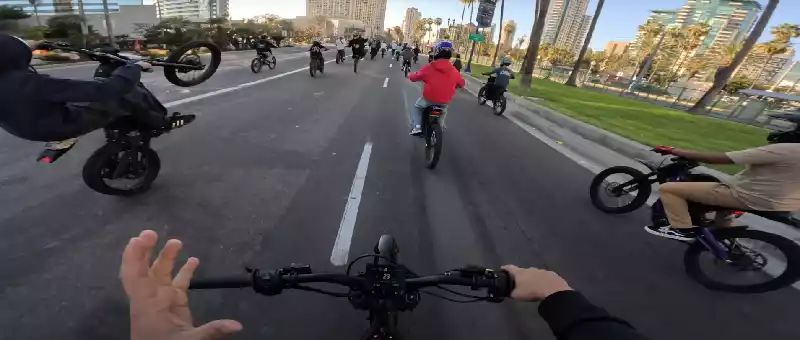
Whether you're a commuter, a weekend adventurer, or someone who just loves the freedom of the ride, connecting with others makes the experience even better. You’ll learn faster, discover new trails, and make real friends who share your passion.
In this guide, we’ll cover simple, actionable ways to find your crew—both online and in the real world.
Why the E-Bike Community Is Unique
The e-bike world isn’t just about the bikes—it’s about the people. This community stands out for a few big reasons:
- Shared values: Most e-bike riders care about sustainability, smart tech, and healthier living. That creates instant common ground.
- Open to all: Whether you're 14 or 74, there's space for you—no need to be ultra-fit or tech-savvy.
- Fast-growing and supportive: Online forums, YouTube channels, and local meetups are thriving. You’ll find everything from how-to advice to ride invites.
E-bike riders tend to welcome newcomers with open arms, especially if you're curious, respectful, and ready to roll.
Start Local: Find Riders in Your Area
The easiest way to build e-bike friendships? Start with people near you. Local groups are a great way to meet riders who share your terrain, pace, and riding style.
Here’s how to find them:
- Facebook: Search “[Your City] e-bike group” or look for local bike clubs with e-bike-friendly events
- Meetup: Many communities host beginner-friendly or themed rides like night rides or cafe crawls
- Strava: Join local cycling clubs or check the map for public group rides
- Bike shops: Ask about rides, bulletin boards, or meetups they sponsor or recommend
Bonus tip: Community co-ops and trail centers sometimes host DIY workshops or safety checks. These events bring in passionate riders you’ll want to know.
Pro Tip: Show up with a positive attitude and introduce yourself. You don’t need to impress anyone—just be ready to ride and chat.
Be Active Online
If you're not finding groups nearby, go online. Digital communities make it easy to connect with e-bike lovers across the world—and often lead to real-world meetups.
Top platforms to explore:
- Facebook Groups: Ask questions, share ride photos, and join local or niche interest groups
- Reddit (r/ebikes): A helpful space for advice, troubleshooting, and honest reviews
- ElectricBikeReview Forum: Packed with discussions on gear, rides, and community experiences
- YouTube and Instagram: Comment on creators' content, ask questions, and share your own journey
- Discord servers: Look for niche e-bike or micromobility servers—some even host weekly voice chats or ride planning
Want more engagement?
Post your rides, ask for route suggestions, or review your bike. Authentic posts get noticed and often lead to great conversations.
Pro Tip: Use consistent hashtags and location tags. People in your area might find you just by browsing those keywords.
Attend Events and E-Bike Meetups
In-person events are one of the fastest ways to turn fellow e-bike fans into real friends. Whether you're there to test gear, ask questions, or just soak up the energy, these gatherings bring riders of all levels together.
Types of events to check out:
- E-bike expos and festivals: Great for testing the newest models and connecting with enthusiasts
- Demo days: Hosted by bike brands or shops—chat with others while trying out the latest electric rides
- Local bike shows and green tech fairs: Even if they’re broader than e-bikes, they often attract like-minded people
Tips for making connections:
- Ask people about their setup—riders love to talk about their bikes
- Compliment someone’s gear or ask about their favorite routes
- Offer to grab coffee after a group ride or hang around post-event to keep the conversation going
Pro Tip: Don’t let going alone hold you back. Many riders show up solo and are just as eager to meet others. A simple “Hey, mind if I join you?” goes a long way.
Use Apps to Connect While Riding
Riding apps aren’t just for logging miles—they’re great for discovering new friends, planning group rides, and staying connected.
Start with these favorites:
- Strava: Join e-bike clubs, give kudos on other riders’ routes, and leave comments on local rides
- Komoot: Perfect for planning scenic routes and seeing who else rides in your area
- Ride with GPS: Find community routes, follow riders, or organize your own public rides
Once you’re active on these platforms, it’s easier to recognize names and profiles during in-person meetups or rides.
Pro Tip: When you upload a ride, write a short caption and ask a question—something like, “Any tips for smoother climbs on this trail?” It opens the door for others to chime in.
Volunteer or Join Local Advocacy Groups
Want to meet passionate riders while making a real difference? Get involved in your local e-bike or cycling advocacy scene. These groups are often run by friendly, mission-driven people who are excited to welcome new faces.
Ways to get involved:
- Community outreach: Help with e-bike demos, public education events, or group rides
- Trail maintenance: Join volunteer crews to repair paths, clean up routes, or improve signage
- Youth and safety programs: Many bike coalitions run helmet giveaways, school visits, or rider safety classes
Giving back is a great way to bond with others. You’ll build friendships around shared goals—not just miles ridden.
Pro Tip: Look for groups like your city’s bike coalition or local chapters of national orgs like the League of American Bicyclists. They often post events or volunteer calls on social media.
Create Your Own Group or Ride
If you don’t see the kind of ride you want—start it. You don’t need a huge crowd or formal club to build a community. Just a consistent time, a route you enjoy, and a little initiative.
Tips to get started:
- Keep it simple: Start with one weekly ride—like a Saturday trail cruise or a short evening loop
- Pick a theme: Coffee rides, no-drop beginner rides, or hill climbs attract different kinds of riders
- Use organizing tools: Free platforms like Meetup, Facebook Events, or Google Calendar help people find you
- Be inclusive: Make sure your description invites beginners, e-bike riders, and people of all fitness levels
Pro Tip: Stay consistent even if turnout is low at first. Many groups start with 2 or 3 people and grow through word of mouth and social sharing. Friendly vibes go a long way.
Building Real Friendships, Not Just Riding Buddies
Riding together is the spark—but lasting friendships come from small efforts off the bike. A quick message, a shared tip, or a casual hangout can turn a riding partner into a real friend.
Simple ways to stay connected:
- Follow up after a ride with a message or invite to the next group ride
- Swap tips and tools—talk maintenance tricks, favorite gear, or recent upgrades
- Plan social rides that aren’t just about speed: think coffee stops, sunset cruises, or even picnic meetups
These moments build trust and keep things fun. You don’t need a packed calendar—just genuine interest in getting to know people beyond the handlebars.
Pro Tip: Host a low-key gear swap or maintenance day. It’s an easy, pressure-free way to meet up, share knowledge, and support each other.
Final Thoughts
The best part of the e-bike lifestyle isn’t just the bike—it’s the community around it. Real connections happen when you show up, stay curious, and stay consistent.
It might take a few rides or online posts to find your crew, but the e-bike world is full of people who are just as eager to connect as you are.
Join one group or ride this week and start building your e-bike circle. The ride is better with good company.

What if your ride to school felt more like freedom than a chore? For today’s teens, e-bikes are more than a trend—they’re a lifestyle shift.
E-bikes, or electric bikes, are bicycles equipped with a motor that gives you a boost while pedaling. That boost makes it easier to climb hills, ride longer distances, and show up to school without being totally exhausted. They're quiet, quick, and cool—and Gen Z is all in.
So why are teens ditching cars, buses, and even skateboards for e-bikes? The answer goes deeper than convenience. In this article, we’ll dive into how e-bikes are changing teen life—from commuting to class and meeting up with friends, to unlocking new levels of independence.
Pro Tip:
Looking for a way to avoid the packed morning bus or save on gas? An e-bike could be your perfect in-between solution.
Ready to see how the e-bike movement is rolling through Gen Z? Let’s ride.
Why E-Bikes Appeal to Gen Z
What makes e-bikes such a hit with teens? It’s more than just having a cool set of wheels—it’s about values, style, and smart choices.
Today’s teens care about the planet, their budget, and expressing who they are. E-bikes check all those boxes, giving them a way to get around that’s efficient, fun, and future-friendly. Let’s break down why so many in Gen Z are hopping on board.
A Greener Way to Ride
Teens today are more environmentally aware than ever. Choosing an e-bike means fewer car rides, less gas, and a smaller carbon footprint. It’s an easy way to make a positive impact—without sacrificing freedom or fun.
Pro Tip:
Some e-bikes even come with regenerative braking, which recharges the battery while you ride. Eco-friendly and efficient.
Tech Meets Transportation
E-bikes are a perfect fit for a tech-savvy generation. Many models connect to apps, offer GPS tracking, or include digital displays for speed and battery life. It’s a modern solution for a generation that grew up on smartphones.
Affordable Alternative to Cars
Owning a car comes with major expenses—insurance, gas, maintenance, parking. E-bikes offer serious savings:
- No gas costs
- Low maintenance compared to cars
- No license required for most models
- Recharge at home with a standard outlet
That makes them one of the best e-bikes for teens looking to gain mobility without draining their wallets.
All About the Aesthetic
E-bikes also let teens show off their personal style. Custom paint, stickers, LED lights, and cool add-ons make each ride feel unique. Whether it’s a sleek matte black cruiser or a neon trail bike, there’s a look for every vibe.
Teens aren’t just buying a ride—they’re buying self-expression.
Summary:
Gen Z loves e-bikes because they’re sustainable, affordable, tech-friendly, and customizable. They’re not just a ride—they’re a lifestyle upgrade.
Thinking about getting one? Start with our e-bike buyers guide, or check out the best electric bikes for teens this year.
School Commutes Made Easy
Tired of waiting on crowded buses or relying on last-minute rides to class? E-bikes are giving students a better way to get to school—on their own terms.
Electric bikes make school commutes faster, more flexible, and way more enjoyable. For teens, it’s not just about getting there—it’s about gaining independence and saving time in the process.
A Smarter Way to Get to Class
E-bikes help students skip the stress of:
- Overcrowded buses and unpredictable schedules
- Long walks in bad weather
- Parents juggling drop-offs before work
Instead, they can hop on their e-bike, zip past traffic, and arrive with time to spare. Many of the best e-bikes for students offer pedal assist for hills and enough battery life to get to school and back without recharging.
Pro Tip:
Look for models with integrated lights and fenders if you’re riding early in the morning or during rainy seasons.
Storage and Security on Campus
Worried about where to park? Most schools now have:
- Bike racks near entrances
- Designated parking zones for electric bikes
- Lockable cages at some campuses for extra security
- Foldable e-bike options for easy storage in lockers or classrooms
If your school doesn’t have these yet, it’s worth asking the office or student council to advocate for e-bike-friendly infrastructure.
Know the Rules Before You Ride
Each school district is different, so it’s important to check local policies. Common rules include:
- Helmet requirements for students under 18
- Age minimums (some areas require riders to be 14+)
- Speed limits on campus pathways
- Parking zones to avoid blocking walkways or exits
Some schools even require e-bike registration or a parent permission form—so it’s a good idea to check ahead.
Summary:
E-bikes are making school mornings smoother and more empowering for teens. With the right gear and a little planning, students can turn a daily chore into something they look forward to.
Ready to upgrade your commute? Check out an e-bike buying guide for students and find your perfect ride.
Social Life on Two Wheels
Who needs a car when you’ve got an e-bike and the open road? For teens, e-bikes aren’t just for commuting—they’re a key part of their social lives.
Whether it’s riding to meet friends, filming a new TikTok trend, or organizing a local ride-out, e-bikes are helping Gen Z connect in exciting new ways. They’re giving teens freedom, mobility, and a way to turn everyday hangouts into mini adventures.
More Freedom, Less Waiting Around
E-bikes let teens say goodbye to asking for rides or waiting on a carpool. With an electric bike, they can take control of their plans and explore on their own schedule.
- Visit friends across town without needing a driver’s license
- Pop over to the skatepark or smoothie shop after school
- Cruise to the beach or downtown on weekends with ease
It’s a big boost in independence—without the cost and complexity of a car.
Group Rides and Meetups
E-bikes are sparking a new kind of social scene. Teens are organizing:
- Local group rides in parks, neighborhoods, and trails
- Weekend e-bike meetups to show off their setups
- Community events like glow rides or themed cruises
These casual rides are more than just fun—they’re helping build friendships and encourage outdoor activity.
Pro Tip:
Want to organize your own e-bike ride? Pick a safe route, post it in a group chat or local teen forum, and remind everyone to bring helmets and lights.
Riding to the Hot Spots
Some of the most popular teen destinations are now just a quick e-bike ride away:
- Skateparks
- Cafés and frozen yogurt shops
- Outdoor malls
- Bike-friendly trails and scenic routes
Since e-bikes make it easier to cover longer distances, teens can explore beyond their usual neighborhood without feeling worn out or sweaty when they get there.
E-Bikes and Social Media Culture
Riding isn’t just functional—it’s aesthetic. E-bikes have taken off on platforms like TikTok and Instagram thanks to:
- “Bike check” videos showing off cool customizations
- POV ride content with scenic backdrops and music
- Glow-up builds with neon lights, new seats, and accessories
It’s no surprise that teens are proud to show off their rides online. For many, their e-bike is part transportation, part personal brand.
Summary:
E-bikes are more than just a way to get around—they’re changing how teens connect, explore, and express themselves.
Looking for a ride that fits your lifestyle? Explore the best e-bikes for teens or check out our teen-friendly electric bike reviews for this year.
Gaining Independence Without a Driver’s License
Can’t drive yet? No problem. E-bikes are giving teens a new way to feel independent—without needing a learner’s permit or a car.
More and more young riders are turning to electric bikes as their first real taste of freedom. Whether it’s getting to school, grabbing lunch with friends, or just exploring the neighborhood, e-bikes help teens move through their world on their own terms.
A License-Free Lifestyle
Most states allow teens as young as 14–16 to ride e-bikes, depending on the class and local laws. That means even before they’re eligible to drive, teens can:
- Commute on their own
- Run errands independently
- Explore safely and legally
Compared to public transportation, e-bikes are quicker, more convenient, and don’t require waiting on a schedule.
Pro Tip:
Always check your local regulations. Some areas have specific age limits or helmet laws for electric bike riders under 18.
What Parents Are Saying
For parents, e-bikes are often seen as the perfect middle ground between walking and driving. They're:
- Safe: E-bikes top out at manageable speeds (usually 20–28 mph depending on class)
- Trackable: Many models come with GPS or can sync with a phone app
- Empowering: Teens build responsibility and confidence while staying active
Plus, riding an e-bike means fewer requests for rides, less carpool stress, and more independence for everyone.
Better Than the Bus (or the Long Walk)
Public transportation and walking have their place, but e-bikes offer major upgrades:
- Faster than walking and far less tiring
- No waiting or worrying about missing the bus
- More flexible: ride to a friend’s house, not just a bus stop
For teens living in suburban neighborhoods or spread-out cities, an e-bike can make all the difference in day-to-day freedom.
Learning to Navigate Like a Pro
E-bike apps and smart features make it easier than ever to build real-world navigation skills. Some models offer:
- Turn-by-turn GPS directions
- Battery level monitoring
- Speed and distance tracking
These tools help teens become confident, independent riders who know where they’re going—and how to get back.
Summary:
E-bikes are opening up a new chapter of freedom for teens, long before they ever get behind the wheel. They’re practical, empowering, and a great step toward independence.
Want to explore your options? Check out our e-bike buying guide for teens and find the perfect first ride.
Safety First: Gear, Rules, and Boundaries
E-bikes bring freedom, but that freedom comes with responsibility—especially for teens. Whether you're new to riding or a seasoned cyclist, safety should always come first.
From helmet laws to reflective gear, knowing the rules helps teens ride smarter and gives parents peace of mind. Here's how to stay safe and make every ride a good one.
Know Your Helmet Laws
In many states, helmet use is mandatory for minors riding e-bikes. Even where it's not legally required, wearing one is still a smart move—especially at the higher speeds e-bikes can reach.
- Most states require helmets for riders under 16 or 18
- Class 3 e-bikes (those that go up to 28 mph) may require helmets for all ages
- School policies may have their own rules
Pro Tip:
Look for helmets labeled “CPSC certified” for safety and consider models with built-in lights for extra visibility.
Gear That Keeps You Seen and Safe
E-bikes move fast, which makes visibility crucial—especially at night or in bad weather. Essential gear includes:
- Front and rear lights (required by law in many states)
- Reflectors on pedals, wheels, and backpacks
- Rear-view mirrors for better traffic awareness
- Bright or reflective clothing
Riding prepared doesn’t just reduce risk—it also makes you feel more confident and in control.
Learn the Rules of the Road
Even if you’re not driving a car, you’re still part of traffic. That means following basic road etiquette and staying alert. Every teen should know:
- How to use bike lanes (and when to share the road)
- Hand signals for turning and stopping
- Traffic signs that apply to cyclists
- How to pass pedestrians and slower riders respectfully
Understanding these basics helps prevent accidents—and builds good habits for the future.
Set Smart Boundaries
Parents and guardians can set clear guidelines that keep e-bike use fun and safe:
- Curfews to avoid late-night rides
- Ride zones or geo-fenced areas
- Top speed limits on adjustable e-bike models
- Battery check-ins so riders don’t get stranded
Many e-bike apps also offer location tracking and usage stats, which makes it easier to keep everyone on the same page.
Summary:
E-bike safety is all about preparation, visibility, and knowing the rules. With the right gear and guidance, teens can ride confidently—and parents can breathe easier.
Ready to ride smart? Explore our e-bike safety gear checklist and get tips on choosing the safest models for teens.
Challenges Teens Face with E-Bikes
E-bikes can be a game-changer for teens—but they’re not without a few bumps in the road. From cost to storage to school rules, there are real-world challenges young riders and their families should know about before jumping in.
Understanding these roadblocks helps teens make smarter choices and enjoy the e-bike lifestyle with fewer surprises.
Budgeting for the Right Ride
One of the biggest hurdles for teens is the cost of a good e-bike. While prices vary, even entry-level models can run from $700–$1,200, with premium brands pushing $2,000 or more.
Here’s what to consider:
- Entry-level e-bikes: Affordable and lightweight but may lack power or range
- Mid-range models: Great balance of features and value for everyday teen riders
- High-end e-bikes: More durable, tech-packed, and long-lasting—but pricey
Pro Tip:
Look for student discounts, refurbished options, or buy-now-pay-later plans from top brands to make e-bikes more accessible.
Keeping It Safe from Theft
Because e-bikes are valuable and portable, they’re also a target for thieves. Teens need to take security seriously—especially when parking at school, the park, or in public.
Smart ways to protect your ride:
- Invest in a heavy-duty U-lock or folding lock
- Use a GPS tracker hidden on the frame or inside the seat tube
- Register the e-bike with local police or on Bike Index
- Remove the battery when parked for extra deterrence
Charging Isn’t Always Easy
Unlike a phone, an e-bike battery needs space, a grounded outlet, and time to recharge—especially important for apartment dwellers or shared living situations.
Common challenges include:
- Limited indoor outlets for safe charging
- No secure outdoor plug access
- Charging time (typically 3–6 hours depending on model)
- Storage restrictions in some buildings or school lockers
Some teens solve this by choosing foldable e-bikes they can bring indoors or swapping in a second battery for backup.
School and Community Pushback
As e-bike popularity grows, not all schools or cities are caught up yet. Some challenges include:
- Bans or restrictions on campus e-bike use
- Lack of secure parking areas or designated bike zones
- Neighborhood concerns about teens speeding or riding unsafely
The best approach? Know the rules, ride respectfully, and advocate for better infrastructure when needed.
Summary:
E-bikes are an exciting option for teens, but they come with a learning curve. From managing costs to staying secure and charge-ready, a little prep goes a long way.
Need help choosing the right model? Check out our e-bike buying guide for teens and see which options fit your budget and lifestyle.
Teen Voices: Stories from Real Riders
What’s it really like to ride an e-bike as a teen? Sometimes the best way to understand the lifestyle is to hear straight from the source.
We talked to a few real riders about how electric bikes have impacted their daily lives—from getting to school faster to finding new adventures on the weekends. Here’s what they had to say.
Why I Ride
“I started riding because my parents work early and couldn’t drive me to school. Now I get there quicker than the bus and I actually enjoy the ride.”
— Leo, 15, California
“I like how it makes me feel more grown-up. I don’t have a license yet, but I don’t feel stuck at home anymore.”
— Sasha, 14, Oregon
“My friends and I all got e-bikes over the summer. Now we meet up at the skatepark or go on long rides around the lake. Way more fun than just texting all day.”
— Miles, 16, Colorado
These teens aren’t just using e-bikes for transportation—they’re building routines, friendships, and freedom around them.
How It Changed Their Day-to-Day
Riders consistently mention how much easier and more enjoyable their schedules have become:
- Faster school commutes
- No need to rely on parents or buses
- More after-school options without worrying about a ride
- Better connection with nature and community through biking routes
Pro Tip:
A lot of teens discover unexpected benefits—like better mental health and focus—just from spending more time outside on their e-bike.
Favorite Features and Moments
E-bikes come with cool features that teens love showing off:
- Throttle control for quick starts
- Built-in speakers on some models for music
- Custom lighting setups that glow at night
- Long-range batteries for weekend adventures
And the memories? They stick.
“The best ride I ever had was during golden hour—just cruising with my music on and no traffic around. It felt like something out of a movie.”
— Zara, 15, Arizona
Summary:
Real teens are embracing e-bikes for freedom, fun, and flexibility. Their stories show just how impactful the right ride can be.
Inspired by their rides? Explore the best e-bikes for teens this year and find the one that fits your life.
The Future of Gen Z Mobility
Could Gen Z be the first generation to skip car ownership altogether? As electric bikes become more advanced and accessible, the answer might just be yes.
For teens today, e-bikes aren’t just a trend—they’re shaping how they view transportation, freedom, and the environment. This shift is changing the future of mobility one ride at a time.
Will E-Bikes Replace Cars?
Driving a car is no longer the milestone it once was. With e-bikes offering speed, independence, and affordability, more teens are choosing to ride electric instead of rushing to get their driver’s license.
Why it’s happening:
- Lower cost of ownership
- Easier access for teens under 16
- No gas or insurance hassles
- Urban-friendly for short-to-mid distance travel
As cities become more bike-friendly and traffic continues to get worse, e-bikes may very well replace cars for millions of young people—especially for local travel.
Pro Tip:
Some teens still get a license for flexibility but use their e-bike for most daily trips. It’s a smart hybrid approach.
Rise of Teen-Focused E-Bike Brands
Manufacturers have taken notice. A growing number of brands now design e-bikes specifically for young riders, with:
- Lower step-through frames for easier mounting
- Adjustable seat heights and handlebars for smaller riders
- Throttle limiters or speed caps for added safety
- Built-in lights, fenders, and phone holders for modern convenience
These features aren’t just smart—they show that brands are listening to what teens (and parents) actually want in an e-bike.
More Than a Ride—It’s a Lifestyle Shift
E-bikes don’t just replace cars—they open doors to bigger life changes. Many teens find that riding regularly sparks new interests like:
- Exploring outdoor trails and nature
- Getting into cycling culture
- Adopting more eco-friendly habits
- Staying active without hitting the gym
It’s more than just getting from Point A to Point B. It’s about building a lifestyle that’s healthier, more sustainable, and way more fun.
Summary:
Gen Z isn’t just changing how they move—they’re redefining mobility itself. With smarter, safer, and cooler e-bikes coming out every year, the future of transportation looks electric.
Curious about what’s out there? Browse the best e-bikes for teens in this year’s electric bike review and find your future ride today.
Final Thoughts
E-bikes are doing more than just giving teens a new way to get around—they’re changing what independence looks like for an entire generation.
From easier school commutes to weekend adventures with friends, electric bikes are helping Gen Z explore their world with confidence, freedom, and purpose. And with more teen-friendly options hitting the market every year, now is the perfect time to give one a try.
A Smart Choice for Families
If you're a parent weighing the pros and cons, here’s the takeaway: e-bikes are safe, practical, and surprisingly empowering for teens. With the right safety gear and some ground rules, they can offer a taste of freedom without the high cost or responsibility of a car.
Teens love the flexibility, parents love the safety features—it’s a win-win.
Pro Tip:
Not ready to buy? Look for local demo days or teen ride-share programs to try one out first.
Ready to Join the Movement?
Whether you're looking for your first ride or just curious about what’s out there, now’s the time to explore. E-bikes are more accessible than ever, and the benefits go way beyond the bike lane.
- Visit a local bike shop for a test ride
- Browse an e-bike buying guide for teens
- Check out the best electric bikes this year
Your freedom starts with one ride. Let it be electric.
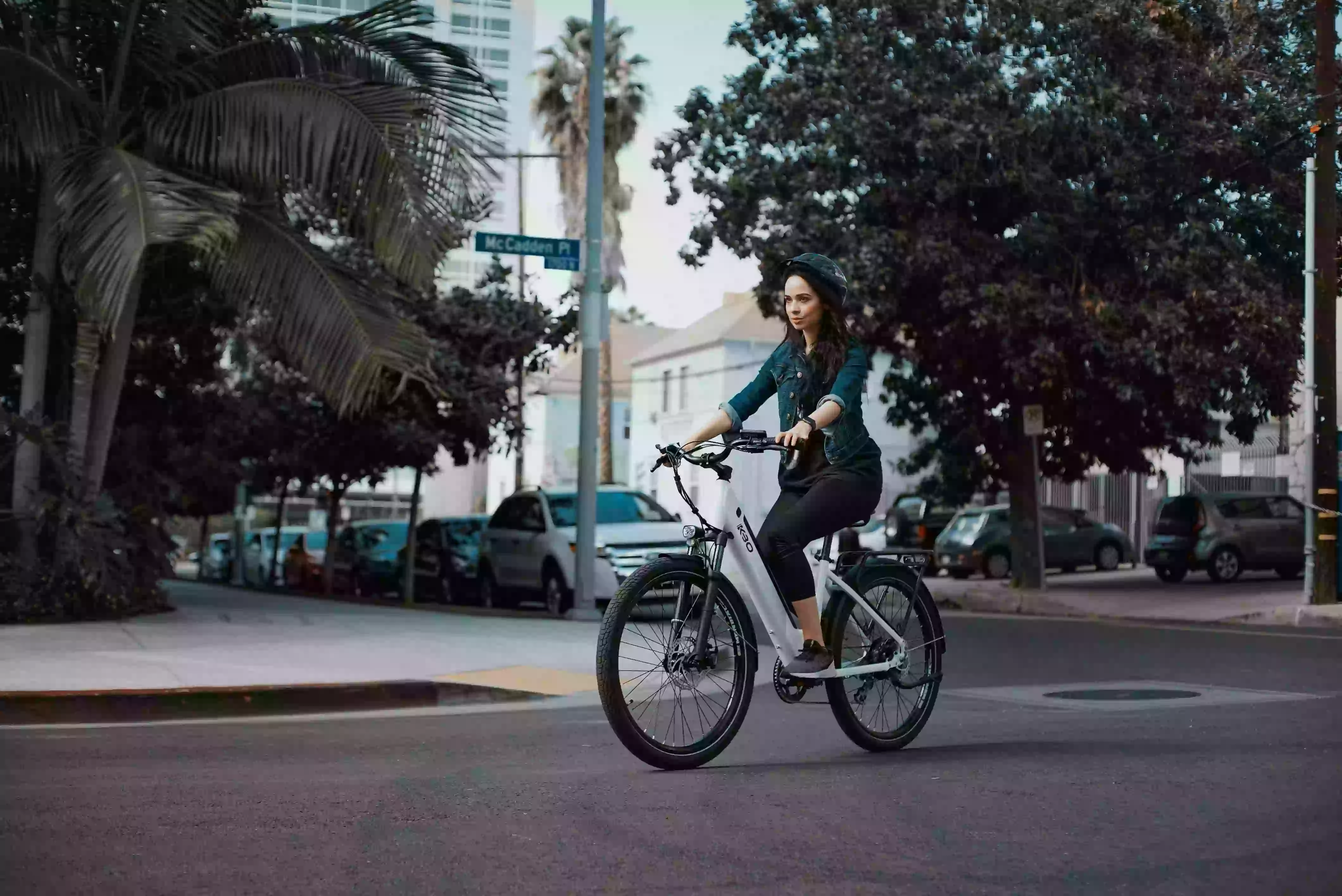
Picture this: you're stuck in bumper-to-bumper traffic, again. Or maybe you're wedged into a packed subway, running late, and wishing there was another way. For millions of urban commuters, this frustrating routine is just part of life. But it doesn’t have to be.
More and more city dwellers are ditching crowded buses and high gas bills in favor of a smarter, more enjoyable way to get around—electric bikes. Whether you’re commuting to work, running errands, or just trying to make your morning routine a little smoother, e-bikes are changing the way people move through cities.
This article breaks down how e-bikes are reshaping urban commuting and why they might be the perfect solution for your daily travels. We’ll look at how they stack up against cars and transit, what makes them so efficient, and how they fit into the future of city life.
Why Cities Are Turning to E-Bikes
E-bikes have exploded in popularity in recent years—and it’s easy to see why. Cities are becoming more bike-friendly, commuters are fed up with gridlock, and the cost of car ownership keeps rising.
Key reasons e-bikes are taking over urban commutes:
- Speed & Convenience: E-bikes let you glide past traffic and skip the hunt for parking.
- Lower Costs: No fuel, no insurance, and minimal maintenance.
- Zero Emissions: A cleaner, greener commute that’s better for the planet.
- More Control: Say goodbye to late buses or train delays—you’re on your schedule.
Pro Tip: Look for cities with strong bike infrastructure—dedicated bike lanes and e-bike parking can make your ride even smoother.
In the next sections, we’ll dive into how e-bikes compare to other commuting options, what benefits they offer, and how they’re shaping the way cities work. Ready to rethink your commute? Let’s ride.
The Rise of E-Bikes in Cities
E-bikes aren’t just a trend—they’re a full-blown movement. Urban areas around the world are seeing a dramatic shift in how people get from point A to point B, and electric bikes are leading the charge.
Sales of e-bikes have surged over the past few years, with millions sold annually in the U.S. alone. In fact, electric bike sales have outpaced electric car sales in several countries, and many experts predict this momentum will only grow as city living continues to evolve.
What’s Fueling the E-Bike Boom?
There’s no single reason e-bikes are booming—it’s a perfect storm of urban pressures and practical solutions. Here’s what’s driving the growth:
- Climate Consciousness: More people are choosing electric bikes to lower their carbon footprint and cut down on emissions.
- Rising Fuel Prices: As gas gets more expensive, e-bikes offer a budget-friendly way to travel without sacrificing speed or convenience.
- Improved City Infrastructure: Cities are investing in bike lanes, protected paths, and shared mobility programs that make riding easier and safer than ever.
Pro Tip: Some cities offer rebates or incentives for buying an electric bike—check your local transportation department or energy authority.
E-Bikes Are for Everyone
Think e-bikes are just for young commuters or hardcore cyclists? Think again. One of the most exciting parts of this movement is how diverse the rider base has become.
- Commuters looking to escape traffic and arrive sweat-free.
- Parents using cargo e-bikes to drop off kids and grab groceries.
- Older adults rediscovering the joy of cycling thanks to pedal-assist.
- Delivery riders and gig workers relying on e-bikes for efficiency and income.
The e-bike revolution isn’t just changing how people ride—it’s changing who rides.
E-bikes are meeting people where they are, offering flexibility, independence, and a new kind of freedom in crowded urban environments. Curious if they’re right for your lifestyle? Stick around—we’re just getting started.
E-Bikes vs. Traditional Commuting Options
If you’re thinking about ditching your daily drive or cutting down on public transit, an electric bike might be the upgrade you didn’t know you needed. Let’s break down how e-bikes compare to the usual ways people get around the city—and why more commuters are making the switch.
E-Bikes vs. Cars
Owning a car in the city can be expensive, frustrating, and time-consuming. E-bikes offer a simpler, smarter alternative.
Here’s what makes e-bikes stand out:
- Massive cost savings: No gas, no insurance, no pricey maintenance. Just charge and ride.
- Skip the traffic: Glide through gridlocked roads using bike lanes and shortcuts.
- Easy parking: Most e-bikes can be locked up just about anywhere, and many fold for storage in tight apartments.
Pro Tip: Want to calculate your savings? Compare your monthly fuel and parking costs to the one-time price of an e-bike—plus a few cents in electricity.
E-bikes give you the freedom of a car without the headaches. For city trips under 10 miles, they’re often faster than driving, too.
E-Bikes vs. Public Transit
Public transportation works well for many, but it comes with delays, detours, and crowded rides. E-bikes put you in control of your commute.
Why more people are choosing e-bikes over the bus or train:
- Reliable travel times: No waiting, no transfers, no surprise cancellations.
- Comfort and personal space: Say goodbye to standing-room-only trains.
- True door-to-door travel: No need to walk to or from stations—just hop on and go.
E-bikes are especially useful for commuters who live just outside transit zones or need to get across town without multiple transfers. They combine freedom, speed, and comfort—all in one ride.
Thinking about upgrading your commute? An e-bike could be the most practical and empowering investment you make this year.
Benefits of E-Bikes for Urban Commuters
When it comes to getting around the city, e-bikes hit the sweet spot between speed, comfort, and sustainability. They’re built for busy streets, tight schedules, and anyone who’s tired of wasting time and money on traditional commutes.
Let’s take a look at why electric bikes are quickly becoming the top choice for urban commuters.
Speed and Efficiency
One of the biggest perks of riding an e-bike is how fast you can get around. With pedal-assist motors helping you cruise at speeds up to 20 mph (or more, depending on the class), commuting becomes a breeze—even over longer distances.
- Beat the traffic without breaking a sweat
- Zoom through bike lanes and shortcuts cars can’t use
- Cover more ground than walking or regular biking in less time
Pro Tip: E-bikes shine on routes with hills, bridges, or long stretches—especially if your commute is over 3 miles.
Sweat-Free Riding
Traditional bikes are great, but showing up to work drenched in sweat? Not ideal. With an electric bike, the motor kicks in when you need it, helping you climb hills or cruise to your destination without pushing yourself too hard.
- Stay fresh for work or school
- Adjust the level of pedal assist based on your energy or outfit
- No need for a post-ride shower or change of clothes
Eco-Friendliness
E-bikes are an easy way to reduce your environmental impact without giving up convenience. They’re powered by electricity, not fossil fuels, making them a cleaner option for everyday transportation.
- Zero emissions during use
- Lower carbon footprint than cars or scooters
- Support a greener, more bike-friendly city
Low Maintenance and Operational Cost
Compared to owning a car—or even relying on monthly transit passes—e-bikes are remarkably affordable over time.
- No gas, insurance, or registration fees
- Minimal maintenance costs (especially with hub motors and sealed components)
- Long battery life, especially with proper care and charging habits
If you’re looking for a cost-effective, sustainable, and efficient way to get around town, an e-bike might be your perfect match.
Ready to skip the stress and start enjoying your commute? Keep reading to see how cities are making it easier than ever to ride.
Infrastructure Changes Supporting E-Bike Growth
One big reason electric bikes are thriving in cities? The streets themselves are changing. Urban planners and local governments are rethinking transportation—and e-bikes are at the center of it.
From new bike lanes to charging hubs and city-led programs, urban infrastructure is evolving to make e-bike commuting easier, safer, and more practical than ever before.
More Bike Lanes, Better Networks
Cities across the U.S. and beyond are investing heavily in dedicated bike lanes and protected cycling routes. These networks aren’t just for traditional bikes—they’re built with e-bikes and speed variation in mind.
- Protected lanes reduce conflict with cars and make commuting safer
- Connected networks make long-distance commuting more efficient
- Greenways and “slow streets” prioritize bikes and pedestrians
Pro Tip: Before buying your first e-bike, explore your city’s bike map—routes with dedicated lanes can completely change your commute.
E-Bike Charging Stations and Parking Hubs
As electric bike adoption grows, cities are responding with charging-friendly infrastructure. These aren’t just for commercial use—commuters and casual riders benefit, too.
- Public charging stations in transit hubs, parks, and downtown areas
- Designated e-bike parking zones to reduce theft and clutter
- Smart bike lockers with power outlets for secure charging
Look for neighborhoods with bike corrals, covered parking, or e-mobility stations—they’re becoming more common in forward-thinking cities.
City-Led E-Bike Initiatives
Many local governments are actively supporting e-bike adoption through fleet programs, incentives, and pilot projects.
Here are a few standout examples:
- NYC’s Citi Bike now includes a large electric fleet with thousands of pedal-assist options
- San Francisco’s “Slow Streets” program made residential roads safer for bikes and cut through traffic
- Denver and Oregon have offered rebates for residents purchasing e-bikes
- Portland and Austin have built entire neighborhoods around low-speed mobility
Cities are beginning to treat e-bikes as essential urban tools, not just recreational rides. That shift is making it easier—and more appealing—for everyday people to join the movement.
As infrastructure continues to improve, riding an e-bike will only get safer, more convenient, and more fun. Want to see if your city is ready for your next commute? A quick local search could show just how bike-friendly your streets have become.
E-Bikes and Last-Mile Connectivity
Ever find yourself just a little too far from the bus stop—or dreading the long walk home after getting off the train? That frustrating “last mile” is where e-bikes shine.
Electric bikes are helping commuters bridge the gap between public transit and their final destination, making multimodal travel smoother, faster, and way more convenient.
Solving the Last-Mile Problem
Many people live or work just outside the reach of transit systems. Walking takes too long, and driving defeats the purpose of using public transportation. E-bikes offer a perfect middle ground.
- Zip to or from the station in minutes
- Skip waiting for a second bus or shuttle
- Pair with trains or subways for flexible, door-to-door commutes
This is one of the biggest reasons e-bikes are gaining popularity among urban professionals, students, and hybrid workers alike.
Pro Tip: If you’re mixing your ride with transit, look for foldable e-bikes or models labeled “transit-friendly” in any good e-bike buying guide.
A Commuter Favorite for Mixed Travel
Many of the best e-bikes for city commuting are built with multi-modal riders in mind. Lightweight frames, easy portability, and quick locking systems make it simple to switch from train to bike without hassle.
E-bikes are especially useful for:
- Suburban riders commuting into the city
- People who bike part-way to avoid crowded buses
- Students navigating between campuses and transit stops
Cities Supporting Multimodal E-Bike Use
Forward-thinking cities are stepping up to support this hybrid approach:
- Chicago and Boston offer large-capacity bike racks on trains and buses
- Los Angeles Metro allows e-bikes on light rail and has bike lockers at stations
- DC’s Capital Bikeshare and other shared fleets let you easily combine bike and transit trips
Multimodal commuting isn’t just a trend—it’s the future. And e-bikes are making it easier than ever to connect all the pieces of your daily journey.
Thinking about cutting down your travel time and making commuting feel less like a chore? Try combining transit with an electric bike—and turn that last mile into the best part of your ride.
Challenges and Considerations
E-bikes offer tons of freedom and convenience—but like any mode of transport, they come with a few things to watch out for. Understanding the potential challenges can help you ride smarter and avoid surprises.
From safety tips to legal gray areas, here’s what every urban e-bike commuter should know.
Safety on Busy Streets
Riding in city traffic means sharing the road with cars, buses, pedestrians, and other cyclists. While e-bikes are safer than many assume, their increased speed means extra caution is key—especially at intersections and in bike-lane-lacking areas.
- Always wear a helmet—even if your state doesn’t require it
- Be visible with lights, reflectors, and bright gear
- Follow the rules of the road, especially traffic signals and signage
Pro Tip: If you're new to urban riding, stick to low-traffic bike paths at first or try commuting during off-peak hours to build confidence.
Confusing E-Bike Regulations
Not all e-bikes are treated the same. Different states and cities have different rules about where and how you can ride, based on speed limits, motor classes, and bike type.
- Class 1 and 2 e-bikes are usually allowed on bike paths
- Class 3 e-bikes (those that go up to 28 mph) may be restricted to roads or shared lanes
- Some cities require minimum age limits or helmet laws, while others don’t
Before you ride, check local laws or refer to an e-bike regulation map or guide for your region. It can save you a ticket—or just make sure you’re riding where it’s safe and legal.
Battery Theft and Security Tips
Battery theft is one of the few downsides to owning an electric bike, especially in dense urban areas. E-bike batteries are valuable, removable, and often targeted by thieves.
- Use a high-quality U-lock or chain lock through the frame and wheel
- Remove the battery when parking in public for long periods
- Store your bike indoors or in secure parking hubs when possible
Some modern e-bikes offer built-in alarms or GPS tracking—a great bonus for city riders looking for peace of mind.
Thinking ahead and staying alert can help you enjoy all the benefits of an e-bike with fewer hiccups. And with just a few smart habits, the risks become easy to manage. Want to learn how to choose a theft-resistant model? Stay tuned for our upcoming e-bike security guide.
How E-Bikes Are Influencing City Planning
E-bikes aren’t just changing the way people commute—they’re reshaping how cities are designed. Urban planners are beginning to shift focus from car-centered infrastructure to micro-mobility solutions that prioritize space, sustainability, and efficiency.
Here’s how the rise of electric bikes is influencing the future of city planning.
Less Need for Parking Lots
As more people swap cars for electric bikes, the demand for traditional parking lots is shrinking. This opens up major opportunities for cities to reclaim valuable real estate and put it to better use.
- Smaller e-bike parking zones take up a fraction of the space
- Vacant parking lots can be turned into parks, housing, or business hubs
- Underground or rooftop bike parking options are becoming more common in urban developments
Some cities have already begun replacing on-street car spaces with bike corrals, boosting accessibility and foot traffic for local businesses.
Boosting Micro-Mobility Over Cars
City planners are rethinking how people move—not just how fast. With the rise of e-bikes, scooters, and other personal electric vehicles, the focus is shifting toward short-distance, low-impact transportation.
- More investment in protected bike lanes and slow zones
- Designated corridors for non-car travel
- Integration with public transit to create seamless multimodal journeys
Pro Tip: Watch for “Complete Streets” initiatives in your area—these projects redesign roads to serve all users, not just drivers.
Changes in Zoning and Transportation Budgets
With fewer cars on the road and more people choosing e-bikes, cities are beginning to redirect transportation funds toward active mobility infrastructure.
- Increased funding for bike paths, bike-share systems, and e-bike subsidies
- Mixed-use zoning that encourages walkability and bike access
- Redesigning intersections and traffic signals to better serve cyclists
In short, e-bikes are doing more than changing how we commute—they’re changing where and how we live. Cities built for bikes tend to be greener, healthier, and more vibrant.
Wondering if your city is making moves toward e-bike-friendly planning? Take a look at your local bike network, development projects, or planning documents. You might be surprised how much is already shifting.
Future Trends in E-Bike Commuting
The e-bike revolution is just getting started. As technology advances and urban lifestyles evolve, electric bikes are set to become even more powerful, connected, and accessible.
If you're thinking about buying an e-bike or just curious about where the trend is headed, here’s a look at the exciting innovations shaping the future of e-bike commuting.
Smarter Rides with Smart City Tech
E-bikes are increasingly being integrated into the digital systems that power modern cities. This means more convenience, safety, and efficiency for riders.
- GPS-enabled apps that suggest safer or faster bike routes
- Real-time traffic and weather updates to guide your commute
- Integration with smart traffic lights that prioritize cyclists at intersections
Many of the best e-bikes for commuters in [year] now come with built-in screens, mobile app pairing, or even theft tracking features. It’s a smoother ride—and a smarter one.
Pro Tip: Look for e-bike models that pair with ride-tracking apps or fitness platforms. You can track your commutes, measure savings, and even share routes with friends.
Lighter Frames, Longer Range
Battery and motor technology is improving fast. Newer models are not only more compact and lightweight—they’re also more powerful and energy-efficient.
- Longer range per charge, often 50–100 miles depending on usage
- Faster charging times with newer battery designs
- Sleeker, integrated batteries that reduce bulk and boost aesthetics
This is great news for city dwellers who want to commute farther or carry more without worrying about running out of power.
Subscription and Sharing Services on the Rise
Not ready to buy? No problem. Many cities and companies are rolling out e-bike subscriptions and share programs to make commuting more flexible.
- Monthly or on-demand rentals with maintenance included
- Corporate e-bike fleets for employee commutes
- Public e-bike share systems (like Lime, Spin, or Citi Bike)
These models lower the barrier to entry, especially for students, renters, or anyone testing the waters before buying their own.
As cities and technology continue to evolve, e-bikes are becoming more than just a transportation option—they're becoming a key piece of the modern commuter lifestyle. Want to stay ahead of the curve? Watch for these features when researching your next ride.
Real-Life Commuter Stories
There’s no better way to understand the power of e-bikes than to hear from the people who ride them every day. Across cities big and small, commuters are transforming their daily routines—and their lives—by swapping cars and buses for electric bikes.
Here are a few real-world stories that show what e-bike commuting really looks like.
From 90-Minute Traffic to 25-Minute Rides
Sara, a graphic designer in Los Angeles, used to spend over an hour and a half sitting in rush hour traffic every day. Now, she rides her e-bike from Silver Lake to downtown in just 25 minutes.
“I used to dread my commute. Now, it’s my favorite part of the day. I save time, money, and I’m not constantly stressed out behind the wheel.”
Sara charges her battery overnight, parks right next to her office, and says she’s cut her monthly expenses by almost $300.
Blending Transit and E-Bike for Flexibility
Darren, a college student in Chicago, pairs his folding e-bike with the city’s train system. He bikes 2 miles to the station, hops on the L, then rides the final stretch to class.
“I never have to wait for a second bus or miss class because of a delay. My e-bike gives me full control of my time.”
Darren also uses his e-bike to run errands around campus—no car needed.
Family Life Made Simpler with a Cargo E-Bike
Maria and Jon, parents of two in Portland, use a longtail cargo e-bike to drop their kids at school and head to work. With built-in seats, panniers, and a powerful motor, their e-bike has replaced most of their short car trips.
“We used to take two cars to get everyone where they needed to be. Now, one e-bike does it all. The kids love it, and we actually get to spend more time outside together.”
Real riders are proving every day that e-bikes aren’t just for fitness or fun—they’re practical, reliable, and surprisingly life-changing.
Inspired? You don’t have to overhaul your routine overnight. Try a test ride, rent an e-bike for a week, or explore what models would fit your lifestyle best. Your new commute might just be a ride away.
Tips for New Urban E-Bike Commuters
Thinking about making the leap to e-bike commuting? Great choice. Electric bikes can totally transform your daily routine—saving time, money, and stress along the way. But before you hit the streets, it helps to know what to look for and how to prepare.
Here’s a quick-start guide to help new urban e-bike commuters get rolling with confidence.
Choose the Right E-Bike for City Riding
Not all electric bikes are created equal. For city commuting, you’ll want a model that balances comfort, power, and practicality.
Look for features like:
- Step-through frames for easy mounting
- Integrated lights and fenders for riding in all weather
- Mid-drive or rear-hub motors for smooth acceleration in stop-and-go traffic
- Built-in racks or pannier mounts to carry bags or groceries
Check out an e-bike buying guide to find models that fit your commute distance, terrain, and storage needs. The best e-bikes for city commuters are efficient, maneuverable, and designed for daily use.
Gear Up for Safety and Comfort
Staying safe (and comfortable) is just as important as picking the right bike. A few smart gear choices can make all the difference on crowded streets.
Must-have accessories for new commuters:
- Helmet: Always wear one—period.
- Front and rear lights: Even during the day, visibility is key.
- Lock: A sturdy U-lock or chain is non-negotiable in the city.
- Mirror and bell: Stay aware and signal your presence.
- Rain gear and gloves: Ride comfortably in all conditions.
Pro Tip: Want a smoother ride? Consider a suspension seat post or ergonomic grips—small upgrades that make long rides more enjoyable.
Learn the Basics of Maintenance and Security
E-bikes don’t require much upkeep, but a few simple habits will keep yours running smoothly.
- Charge your battery after each ride (don’t let it fully drain)
- Check tire pressure weekly for efficiency and safety
- Keep your chain clean and lubricated
- Inspect brakes regularly—especially for city stop-and-go use
And when parking, always lock the frame and rear wheel to a solid object. If your battery is removable, take it with you when leaving the bike for long periods.Starting strong with the right setup makes a huge difference in how enjoyable and hassle-free your e-bike commute will be. Ready to roll? Your city adventure is just one pedal-assist away
Final Thoughts.
Electric bikes are redefining what it means to commute in the city. They’re faster than walking, more flexible than public transit, and far more affordable than owning a car. As cities invest in better infrastructure and technology evolves, riding an e-bike is becoming one of the smartest and most enjoyable ways to get around.
From cutting your commute time and saving money to reducing your carbon footprint, the benefits of e-bike commuting are real—and growing fast. Whether you’re a student, a professional, or just tired of sitting in traffic, there’s likely an e-bike that fits your lifestyle.
Pro Tip: Not ready to buy? Try a local e-bike share program or rental service first to test different models and routes.
Curious about your options? Dive into our e bike buyers guide, check out the best e-bikes for urban commuters, or visit a local bike shop for a test ride. Your next great commute might just be electric. Ready to ride?
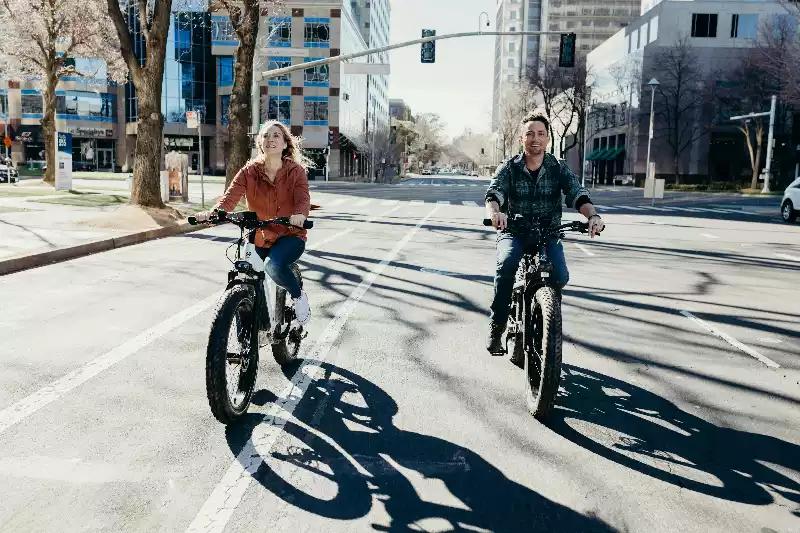
Feeling stressed or overwhelmed? You’re not alone. In today’s fast-paced world, mental health challenges affect many of us. Fortunately, there’s a simple, fun way to boost your mood and ease stress: riding an e-bike.
E-bikes combine the joy of cycling with a little electric boost, making it easier for anyone to enjoy outdoor rides. In this article, you’ll learn how e-biking can reduce stress, improve your mood, and get you moving outside more often — all great for your mental well-being.
What Is an E-Bike?
An electric bike, or e-bike, is a bicycle with a small motor that helps you pedal. This motor makes it easier to tackle hills or ride longer distances without feeling exhausted.
Unlike traditional bikes, e-bikes offer adjustable assistance levels, so you can choose how much help you want. That means beginners, older adults, or anyone with lower fitness levels can still enjoy the ride.
Why choose an e-bike?
- Makes cycling accessible for all ages and abilities
- Provides low-impact exercise that’s easier on joints
- Encourages consistent activity by reducing fatigue
Stress Reduction Through E-Biking
Feeling stressed? E-biking can be a powerful way to ease tension and calm your mind. Physical exercise like cycling naturally lowers stress hormones such as cortisol and adrenaline, helping your body relax.
The steady, rhythmic pedaling creates a flow state—an almost meditative experience that lets you focus on the ride and forget daily worries. Because e-bikes provide motor assistance, you can enjoy these benefits without overexerting yourself. This makes stress relief accessible even if you’re new to exercise or have physical limitations.
Studies show that cycling regularly can reduce anxiety and promote relaxation. Plus, anecdotal stories from riders often mention feeling calmer and more centered after a ride.
Pro Tip: Start with short rides on your e-bike, focusing on smooth, steady pedaling to tap into that calming flow state.
Mood Improvement and Mental Clarity
Want to feel happier and clearer-headed? Riding an e-bike can help with that too. Exercise triggers the release of feel-good brain chemicals like endorphins and serotonin, naturally lifting your mood.
Combine that with the fresh air and time spent outdoors, and you’ve got a recipe for mental clarity. Nature exposure boosts your mood and helps reduce symptoms of depression and anxiety.
E-bikes make it easier to stick with regular rides, even if you’re not an experienced cyclist. This consistent activity helps you enjoy ongoing mental health benefits without feeling overwhelmed or intimidated.
Why e-bikes?
- Less physical strain means you’re more likely to ride often
- You can explore new outdoor routes that refresh your mind
- Group rides add social connection, which also boosts mood
Pro Tip: Try to pick routes with plenty of greenery or parks for the best mood-boosting effects.
Ready to ride your way to better mental health? Find the perfect e-bike and start enjoying stress relief, improved mood, and more outdoor fun today.
Social Benefits: Group Rides and Community Connection Enhancing Well-Being
Riding an e-bike isn’t just good for you physically and mentally—it can also boost your social life. Group rides and e-bike communities create opportunities to connect with others who share your interests.
Being part of a group helps reduce feelings of isolation and loneliness, which are common stress and anxiety triggers. Sharing rides, tips, and experiences builds friendships and a sense of belonging.
Plus, social connection itself is a proven way to improve mental health by increasing feelings of happiness and support.
Pro Tip: Look for local e-bike clubs or social rides in your area. Joining a group can make riding more fun and motivate you to ride more regularly.
Encouragement of Outdoor Activity
Spending time outside is a natural mood booster, and riding an e-bike makes it easier than ever. Exposure to sunlight helps your body produce vitamin D, which supports brain health and regulates your sleep-wake cycle, known as the circadian rhythm.
E-bikes allow you to take longer trips and explore areas that might be too challenging on a regular bike. This helps overcome physical or geographic limits that might have kept you indoors before.
Exploring new routes and changing environments sparks your brain with fresh stimulation, which can increase happiness and creativity. Whether it’s a scenic park trail or a quiet neighborhood street, these new sights and experiences refresh your mind.
Examples of routes enhanced by e-bikes:
- Riverside or waterfront trails
- Forest and nature park loops
- Urban greenways and bike paths
- Scenic countryside rides
Pro Tip: Try mixing up your routes regularly to keep your rides exciting and mentally engaging.
Additional Mental Health Benefits
Riding an e-bike also supports mental health in other important ways:
- Improved sleep quality: Regular outdoor activity and exercise help regulate sleep patterns, so you feel more rested.
- Boosted self-esteem: Mastering new riding skills or conquering longer rides builds confidence.
- Reduced anxiety and depression: Physical activity combined with time in nature can ease symptoms of these conditions.
- Meditative experience: The rhythm of pedaling and the fresh air offer a chance to disconnect from screens and daily stressors, helping clear your mind.
Pro Tip: Use your e-bike rides as a break from technology—a moving meditation that refreshes both body and mind.
Ready to ride into better mental health? Explore the best e-bikes for your needs and start enjoying the outdoors like never before.
Who Can Benefit the Most?
Wondering if e-biking is right for you? Many people can gain mental health benefits from hopping on an e-bike.
- Older adults or those with mobility challenges find e-bikes make exercise easier and more enjoyable without overexertion.
- Individuals experiencing mild to moderate depression or anxiety can use e-biking as a gentle way to boost mood and reduce stress.
- Urban dwellers benefit from e-bikes by accessing green spaces and nature outside the city hustle.
- Anyone looking for a low-impact but effective form of exercise will appreciate how e-bikes offer a smooth, joint-friendly ride.
Pro Tip: If you fit one of these groups, check out the best e-bikes designed for your needs in current e-bike buying guides and [year] electric bike reviews.
Tips to Maximize Mental Health Benefits While Riding an E-Bike
To get the most out of your e-bike rides for mental well-being, try these simple tips:
- Choose scenic or green routes whenever possible to soak in nature’s mood-boosting effects.
- Ride regularly, even short rides add up to big mental benefits over time.
- Join e-bike groups or social rides to connect with others and boost your sense of community.
- Practice mindfulness while riding—focus on your breath and surroundings to clear your mind.
- Prioritize safety and comfort with a well-fitted helmet and bike setup to reduce anxiety on the road.
Pro Tip: Use your rides as a chance to unplug—leave your phone in your pocket and enjoy the moment.
Ready to enjoy all the mental health perks of e-biking? Find the perfect e-bike today and start your journey toward better well-being.
Final Thoughts
E-biking offers a fun and accessible way to improve your mental health. From reducing stress and boosting your mood to encouraging more time outdoors, the benefits are clear and achievable for many people.
Whether you’re new to cycling or looking for a low-impact way to stay active, an e-bike can open the door to better well-being.
Ready to experience these mental health perks for yourself? Get outside, start riding, and enjoy the positive changes an e-bike can bring to your life.

